
Traditional production of animal glue

View of the dam of the Assad reservoir of the Euphrates with its park

Euphrates dam and Assad lake, Nahiyat at-Tabqa

Temporary title for Image 44445
Aside of the Ruins

Tall Mumbaqa, Women prepare food for the banquet of the excavation

Al-Madrasa al-Hallawiyya, entrance of the prayer hall

View from south to the church of Kharab Shams
[Original: Säulenbasilika, 4. Jh. von weitem, von W]

At-Takiyya al-Mawlawiyya, entrance and courtyard of the kitchen

A village in the Syrian coastal mountains (al-Jibal as-Sahiliyya)

Funerary sculpture of a Palmyrene couple
[Original: Museum: Grabrelief für ein Ehepaar]

Krak des Chevaliers, the loggia

Raqqa, Qasr al-Banat, clay decorations
![The eastern part of the building. This photos is of two ones, one of them is dated to 2011 and the other is taken from the net but not clear from where or when, therefore was put as no year. [Original photo name: as-i-محمع قصر الحسيني3_SYRHER]](https://syrian-heritage.org/wp-content/plugins/justified-image-grid/timthumb.php?src=https%3A%2F%2Fsyrian-heritage.org%2Fwp-content%2Fuploads%2F2020%2F04%2Fshap_import_75457-1024x386.png&h=230&q=90&f=.png)
The eastern part of the building. This photos is of two ones, one of them is dated to 2011 and the other is taken from the net but not clear from where or when, therefore was put as no year. [Original photo name: as-i-محمع قصر الحسيني3_SYRHER]

A view shows monasteries and residential buildings, Saydnaya

Remains of Zengid bridge in ʿAyn Diwar

Jamiʿ al-Khayr, western facade
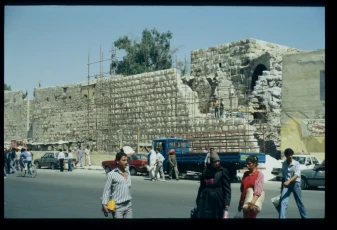
The citadel of Damascus during the restoration in 1985
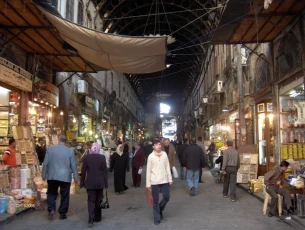
A view in Suq al-Buzuriyya, Old City of Damascus

The wooden sarcophagus of Salah ad-Din al-Ayyubi
[ Description by author: Der ältere (alte ?) Holz-Sarkophag Salâhu d-Dîns. Ich glaube, es ist ebenfalls ein Kenotaph, somit bliebe unklar, wo der Leichnam heute ist. (The year of the photo is not sure according to Peter Heiske ) ]

Inside the city wall, excavation work, Qatna
. [Original: Al-Mishrifa / Qatnâ']

Afamiya Theater, remains of Cavea

Remains of the Halabiyya fortifications, 8th-9th century BC

A decorated inscription in Masayaf Castle

Khan Qurdbak, detail of a window in the iwan

ar-Rusafa, remains of the arches of the so called building with two apses
[Original: k.K6/=HQ k.K6]

Qasr al-Hayr al-Sharqi, Remains of the mosque of the western enclosure

Busra - Masjid Yaqut (mosque) - plan

Jamiʿ at-Tawashi, interior view of the prayer hall
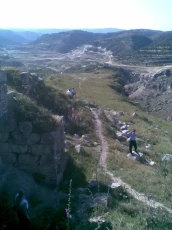
Jisr ash-Shughur, Qalʿat ash-Shugr wa-Bakas, the trail around the two castles

View of the Orontes valley at low water

General view of Baalshamin Temple from the east

Umayyad Mosque, the facade of the prayer hall is covered with golden and colored mosaic
Originally, the entire courtyard façade was covered with mosaics. They show fantastic landscapes, which are interpreted as a representation of paradise.

Jamiʿ at-Tawashi, minaret
[Original:'Jâmi' at-Tawâshi, Halab / Aleppo. Oberer Teil des Minaretts.'].

Raqqa - the excavations of the site "East of Raqqa" - Eastern Palace - stucco decorations
Floral frieze decoration, Raqqa II; Eastern East-Palace

Khan as-Sabun, window and decoration above the entrance

Jamiʿ Sharaf, the old mihrab

View on the Euphrates river from Dura Europos
Blick von der Zitadelle Euphrat-aufwärts nach ~ Nordwesten.

Waqf of Ibshir Mustafa Pasha, Mosque, main entrance

(Dome) Qubbat as-Sayyar on Qasyun mountain

Shaykh Anas shrine - al-Tar mountain south-east of al-Mayadeen
Near Qa'alt ar-Rahaba, grave Shikh Anis. [Original:'bei Qal'at ar-Rahba, Grabbau = Saih Anis']

Raqqa/Rafiqa, An old photo of the remains of al-Banat palace before restoration
[Original: Palast. Aufnahme von Westen/ 1945 Geschenk Prof. Friedrich Sarre]

View from south-west, Basilica of Kharab Shams
[Original. Säulenbasilika, 4. Jh. von weitem, von SW. Nach dem Einsturz der Seitenschiffe bei einem Erdbeben ist nur noch das Mittelschiff erhalten. Fensterhochwand mit Rechteckfenstern stammt aus dem 4. Jh., die mit Rundbogenfenstern aus dem 6. Jh.]

A warping machine in the textile factory of the Mezannar family in Damascus

Ruins of the wall of Qalʿat Shumaymis (castle)

Afqa spring, sulfuric water of the historic bath
[Original: Efqa-Quelle]

A photo of villagers at the entrance of traditional building under construction, Raqqa

Raqqa - "East of Raqqa" site - Tall Aswad - finds
[1985/24/393] = [photo's name as: year/ film no./ photo no.] . ["s.a. Dias"]

Bayt Ghazala, the iwan
[Original: B86 /Film XV]

Jamiʿ (mosque) al-Hanabila - plan

A side from the courtyard of Bayt Shaykh Qatana before demolition
Tür zum Hof

Exterior view of ad-Daydariyya cave
shap_import_44193

Agriculture in ar-Ruj plain

In the Syrian desert: the separation of the living and the storage compartment in a bedouin tent with the help of a stick mat (arab. zarb)
Large patchwork curtains cover the stacks of bedding and - as here - the partition wall separating the two tent sections. The girls of the family sew these huge patchwork curtains. The living compartment of the tent is visible on #2852 and #2853.

A side of Salah ad-Din Castle

Remains of a courtyard at Ibn Mʿan Castle

Monastery of St Simeon, Corinthian capitals decorated with wavy acanthus leaves
Capitals of the Simeon monastery are often decorated with waving acanthus leaves as a northern Syrian peculiarity.

Khan Qurdbak, main entrance

Eating breakfast in the shop

Bayt Ghazala, main entrance gate

Al-Madrasa al-Kamiliyya, courtyard and iwan

Al-Madrasa al-Ahmadiyya, southern portico

Wakil House, decorated windows
Decorations of window openings of Wakil house, which are stone panels carved with geometric and vegetal forms that crown the window on top.

Jabla, Pond in the courtyard of as-Sultan Ibrahim Mosque

A grove in the Ghouta of Damascus

A view of traditional houses in Jabʿadin village

Raqqa - remains of the southern arcade of the Jamiʿ al-ʿAtiq

Jamiʿ Aslan Dada, a marble column with a Corinthian capital decorating the prayer niche

View from Qalʿat Ibn Maʿn towards the Valley of the Tombs
[ Description by author: Blick nach ~ Südwesten. Der hohe Turm rechts der Bildmitte ist der des Elahbel. ]

Part of golden and colored mosaic, Umayyad Mosque
[ Description by author: Mittelgang, Südwand, Mittelteil.- Die Bilder 0179 - 0192 wurden mit einem High-Speed-Film gemacht, daher die mäßige Qualität ! ]

North-East Syria, the Upper Euphrates

Al-Madrasa as-Sharafiyya, main entrance facade, Inscription

Remains of the entrance of al-Walid palace, Qasr Says in Jabal Says

Jamiʿ Aslan Dada, inscription above the hall entrance

A side from the courtyard of Bayt Jubran Afandi Shamiyya, Bab Tuma
Hof gegen Tarma

A small noria (water wheel) on the Orontes river
One of the small norias in Hama which appears to be very similar to the large norias with its wheel of trunks and stone base.

Busra, Hammam Manjak, exterior view

Bucket wheel (noria) and aqueduct in 1930
Note: these photos were taken between the year 1924 - 1939. The chosen date is to be average. (photographer unkown)

Qasr al-ʿAzm, view of the ground floor courtyard

Tent made of jute sacks of a semi-nomadic family from the Maskana region

Tall Brak, general view of the main mound
shap_import_44764

Jamiʿ al-ʿAdiliyya, a niche on the right side of the prayer hall's entrance

Aleppo in the 1930s, aerial view in northwest direction with the citadel and the old town in the background
On the left side of this picture you can see the areas of the bazaar with the big mosque. On the gate of the citadel you can still see the remains of the domes of the throne hall. On the back of the photos: [1988/144]. On the back of the photos: ['1988/203']. [Objekt: Reproduktion SW-Fotos, 24.Juni 1988, Peter Grunwald, Film 1 (2), Ende Film 2]

Bayt Wakil, the iwan's canopy

Remains of the Byzantine church at Qarqbiza
[Original: einschiffige Kirche, Südseite]

Great Mosque, people in the courtyard

Tall Dahab, Guesthouse of a village with sculptural decoration of the facade

Khan al-Hibal, the upper part of the entrance with foundation inscription

Jaʿbar Castle in at-Tabqa, General view

Khan Qurdbak, portico, section north-south
Size of plan 70 x 35. with ruler (no scale).

General view of the small palace of Qasr al-Hayr al-Sharqi
[Original: 1. Anlage]

A view of the Mediterranean coast, in the back is the industrial sector, Baniyas

Part of colored and golden mosaic on the courtyard facade, Umayyad Mosque
[ Description by author: Von Norden: Mosaiken am großen Bogen, linker Teil. ]

Roman Gate (Peribolos) at the Straight Street, Old City of Damsacus
[ Description by author: Gesehen von ~ Südwesten, mittlerer Durchgang. Die "Bürgersteige" der Geraden Straße wurden im Mittelalter zu Straßen, der alte Fahrdamm überbaut. Aber ab diesem Bogen für einige hundert Meter nach Osten besteht noch die alte Struktur: der Fahrdamm wurde ein offener Sûq, die "Bürgersteige" auch hier Straßen. Vgl. Bild 0322 ! ]

An arch topped a niche in the mausoleum of az-Zahir Baybars
[Original: Zahiriya, Mausoleum des az-Zahir Baibars, 1277. Mihrab-Nische mit Marmorinkrustationen]

Takiyyat ash-Shaykh Abu Bakr, the prayer niche (mihrab)
shap_import_65912

Al-Matbakh al-ʿAjami, facade of the east section of the great hall

2 pounds, 23 mm, 1996

The suspension bridge over the Euphrates, Dayr az-Zawr
Note: these photos were taken between the year 1924 - 1939. The chosen date is to be average. (photographer unkown)

Al-Jisriyya norias (water wheel), Hama
This set of norias is called aj-Jisriyya, and is considered the largest and one of the most famous and beautiful norias of Hama city.

The statue of Harun al-Rashid in Raqqa

General view of Maʿlula town in 1930s
Note: these photos were taken between the year 1924 - 1939. The chosen date is to be average. (photographer unkown)

Al-Madrasa al-Hallawiyya, entrance - Zengid inscription in Naskhi script

Salkhad - The Ayyubid minaret

Prayer hall "sanctuary", Jamiʿ Manjak (mosque)

One of the square towers of Masyaf Castle

Destruction of the illegal shops in the outside part of the northern part to show the wall and a tower.

50 piastres (F.A.O. coin: increasing of world food production), 23,5 mm, 1976

Jamiʿ Aslan Dada, dome of the prayer hall (qibliyya)

A general view of the remnants of the ancient city of Palmyra towards the south eastern palm groves

Ghab plain: thatched mud houses, 1963

Remains of the gateway of the Umayyad complex at Qasr al-Hayr al-Gharbi

Corner pilaster topped by Corinthian capital, Ithriya Temple
und sein Kapitell, vermutlich an der ~ Nordwest-Ecke (?). [Original:'Ithriya (Seriana),']

Krak des Chevaliers in West Syria, 12th C.

Bayt Ghazala, courtyard - northern facade

A mechanical loom in the textile factory of the Mezannar family

Habuba Kabira, the stacked bricks under the relieving arch are removed by the master bilder

al-Hayr al-Sharqi Palace, Inside of the early Umayyad desert castle with remains of vaulted rooms of the Western comlplex

Bayt Ghazala, courtyard, southern facade - iwan

Yabrud: Outer wall of the Greek Orthodox church "Konstantin and Helena", which once belonged to a temple

View, from south, at northern overbuilt part of Suq (bazaar) of Khan al-Harir (Picciotto house)
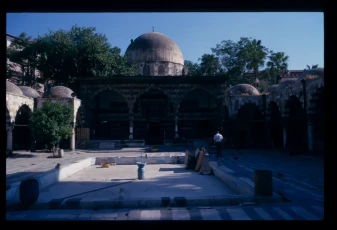
The courtyard of the Madrasa as-Sulaymaniyya

Raqqa, hypothetic reconstruction of the prayer hall of Grand Abbasid Mosque (al-Jamiʿ al-ʿAtiq)
Isometric view drawing. Scale ruler

Stairs lead to the Ishtar Temple D? Ebla (Tall Mardikh)
Im Vordergrund die Treppe von Bild 1185 hinten. Nach dem Gesamtplan Bild 1162 müsste sie zum Roten Tempel / Ishtar-Tempel D führen. Gesehen nach ~ Nordosten. [Original:Tall Mardîkh (Ebla)']

At-Takiyya al-Mawlawiyya, western facade, al-Midan

Busra - Jamiʿ (mosque) Fatima - the prayer hall

Al-Madrasa as-Sultaniyya, view from the courtyard to entrance and minaret

Al-Matbakh al-ʿAjami: eastern Qaʿa (mamluke), section north-south, view to west
Size of plan 22 x 32, with ruler (no scale).

Bayt Ajiqbash, traditional furniture in the guest room (qaʿa)
shap_import_63521

Machicolations on the wall of Damascus Citadel

Hama, general view of the "Four Norias", the two Bischriyyat and two Uthmaniyyat
View from southwest the Orontes/ al-ʿAsi up to the four water wheels. On the right side the terrace of an restaurant

Dome from the outside, Jamiʿ al-Imam Ismaʿil

Part of golden and coloured mosaic, Umayyad Mosque
[ Description by author: Mittelgang, Südwand, Westende.- Die Bilder 0179 - 0192 wurden mit einem High-Speed-Film gemacht, daher die mäßige Qualität ! (The date of this photo was not sure as Peter Heiske did [(wohl) 18/04/2004] ]

A boy is presenting a woven Kilim tapestry made by his mother

Ghuta of Damascus, artificial irrigation canal system

The courtyard of al-Jami‘ al-ʿUmari in Busra

View on the Euphrates river from Dura Europos
und Euphrat-Auen, gesehen von nördlich der Zitadelle nach ~ Osten.

Jurn Kabir, a swift that was found on the ground

Bayt Ghazala, courtyard - northern facade
View of courtyard facade [Original: Privathaus, Innenhof] Pl. Nr. Aufnahme Enderlein, Foto-Verz. Nr. 11028 A 18

Qalb Lawza, Basilica of 5th c., central view at nave and apse

Maintenance work in the course of the Barada River, Damascus

Ecological and botanical garden near Damascus citadel
Ecological and botanical garden

Al-Madrasa al-ʿUmariyya al-Kubra - southern arcade

Al-Matbakh al-ʿAjami, facade of the east section of the great hall

The minaret of Great Mosque of Raqqa-Rafiqa, 8th/12th C.

Bayt Ghazala, eastern facade - plant ornament above the main entrance from the inside

Abdelraouf Baydoun working with the craft of ‘Ajami: Preparation of a wooden dome

Sheep grazing on the ruins of Halabiyya-Zalabiyya

Jamiʿ al-Utrush, prayer hall

Bayt Ghazala, ʿajami panels decorating the southern wing ceiling in the main reception hall (qaʿa)

Wall of the colonnaded enclosure, Temple of Bel
[ Description by author: Die Propyläen - die arabische Bastion - von der Hofseite, also von ~ Osten. ]

Khan Qurdbak, main entrance

Al-Madrasa al-Hallawiyya, entrance - Zengid inscription in Naskhi script

South-west Syria: Qalamun Mountains, the village of Maʿlula with its light blue or white house paintings

Al-Matbakh al-ʿAjami, muqarnas squinches of the iwan dome
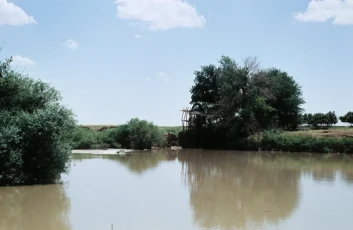
View of the Khabur River with a small noria

The wheel hub of a water scoop wheel (arab. noria)

Citadel of Aleppo, general view of the Throne Hall

Ash-Shaykh mountain, distant view of 'Arna village

A side of Salah ad-Din castle
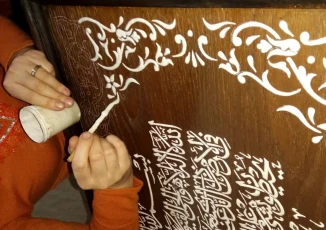
Aliya Alnuami is applying the relief paste on her ‘Ajami-work

Raqqa, City Wall
Nicephorium; City Wall

Busra Citadel - Stone decorations at the entrance

Spools in the textile factory of the Mezannar family

Bimaristan an-Nuri, courtyard

A woman putting mud in molds to form bricks in a village in Raqqa

Kharab Shams, central nave of the basilica
[Orignal: Säulenbasilika, 4. Jh. von weitem, Mittelschiffarkaden nach Osten]

House in Bahsita, , bevelled wall corner with a Muqarnas console

Khan Qurdbak, courtyard - southern and eastern porticos

Hand printed table cloth from Hama at Hassan's Shop, Old Damascus

General view of Qalʿat Ibn Maʿn
[ Description by author: Stimmt die Standortangabe ? Dazu passt, dass der Standort etwas erhöht ist: das Zenobia Hotel liegt auf einem Hügel. Dagegen spricht das Gebäude unten links: wenn es das Tempel-Grab ist, müsste man links die Säulenfassade und keine Wand sehen. Jedenfalls: von ~ Südosten die Burg auf ihrem Bergkegel. ['Zenobia Hotel (?),'] ]

Fortification tower north of the Bab Antakiya, view during the removal of historical annexes

Propylaea of Jupiter Temple, Damascus

Remains of two-storey building, Sirjilla
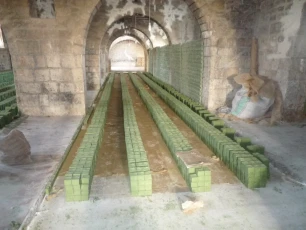
Masbanat al-Jubayli, soap preparation before the stage of arranging

Hammam al-Bayyada, the cold section (barrani)

Qanawat, Ruins of the Temple of Rabbos

Jamiʿ al-Utrush, general view of western facade and minaret
The most decorated facade of the mosque which can be seen from afar.

25 pounds (Commemorative coins: twenty-fifth anniversary of Corrective Movement), 25 mm, 1995

Bayt Junblat, courtyard and southern iwan (the great iwan)

The door of the qaʿa (guest room), Dada House
Tür v. Liwan zur Qa'a

View to the west.

Izraʿ - Kanisat (church) Mar Jirjis from the inside

Aerial photograph of the Bel Temple and old village houses in front of the temple

General view of the Barada spring close to the eastern Mountains of Lebanon

Bayt Ghazala, ʿajami panels decorating the southern wing ceiling in the main hall (qaʿa)

Ruins of Qalʿat ash-Shugr wa-Bakas on the edge of a mountain slope

One of the towers of Shayzar Castle

Raqqa, the archway of Baghdad Gate

Baalshamin Temple - cella, 2nd c. AD
[ Description by author: Oberer Teil des Thalamos in der Cella, gesehen durch das Portal. ]

Izraʿ, al-Jamiʿ (Mosque) al-ʿUmari - exterior view

Tall Dahab, Back of the guest house with surrounding scultural ornamentation

The damage of the western part of the facade and the minaret.

Temple of Bel, ceiling decorations
[ Description by author: des Peristyls oder des Naos. Die alte Karteikarte sagt Naos, ich denke jetzt aber eher Peristyl: am "Bacchus"-Tempel in Ba'labak gibt es ganz ähnliche Peristyl-Platten.- Es gibt hier zwei Typen von Rosetten: eine "normale" und eine "rotierende". Letztere lässt an die "windzerzausten" Kapitelle ind Qal'at Sem'ân und in Halab denken. ]

A traditionally crafted tapestry weave of four panels, that are ornamented with embroidery

A side of archaeological remains in Khirbat as-Sarayij

Western facade of the Saraya complex (Maʿbad Zeus), Qanawat

Aleppo: Khan al-Wazir, 17th C., interior facade

Masbanat (soap factory) az-Zanabili, Aerial views of the courtyard and the domed first

Bayt Dallal, decorated stone above a gate

Al-Madrasa al-Ahmadiyya, entrance of the tomb
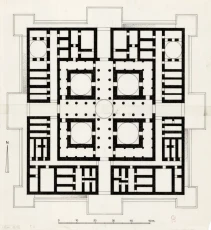
Hiraqla victory monument - plan of ground level
Reconstruction drawing of gound level. Plan showing walls. (with ruler)

View from southeast, Ithriya Temple
Auf der linken Seite ist gut das Podium zu erkennen. Gesehen von ~ Südosten. [Original:'Ithriya (Seriana),']

Salah ad-Din statue situated in front of the western facade of Damascus citadel

A herd of sheep is drinking from a pool of water in al-Hawl area near Iraqian border

Signboard of Afqa bath in Palmyra
[Original: Straßenschild, Schwefelquelle]

Application of the relief paste of a contemporary ‘Ajami decoration
Abdelraouf Baydoun in his workshop on Malaysia

Great Mosque of Aleppo, prayer hall interior
Aleppo Great Mosque, prayer hall interior

Great Mosque, prayer hall, wooden pulpit (minbar)
The unique wooden minbar, or pulpit, belongs to the Mamluk era as indicated by the inscribed name of the Sultan al-Nasir Muhammad, son of Qalawun (d. 741 AH / 1341 AD). The carpenter’s name is Muhammad ibn ʿAli al-Mawsili.

A sculpture of a woman, showing clothes and jewelry details

Aghabani table cloth

Khusrawiyya, northern arcade, 2018
The northern arcade is the only survived part of Khusrawiyya complex.

Near Safira, upper opening in a dome , used to fill in straw or chaff

View to the south from the battlements of the citadel to the city in 1916
In the foreground the Khusrawiyya complex is partly visible, as is the mosque as-Saffahiyya and parts of the districts al-Jallum and Sahat Bizza.

Bayt Wakil, iwan - decoration above a room's door

Jamiʿ al-ʿAdiliyya, decoration details in the double arcade
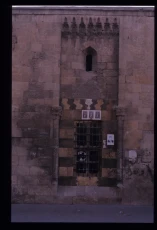
Jamiʿ at-Tawashi, eastern facade - window within a rectangular niche decorated with muqarnas

Wakil house, courtyard with water basin

Ar-Raqqa, part of city wall

Arch of Triumph (Qaws Hadrian) behind palm trees
[ Description by author: am Knick der Säulenstraße, und ein Stück der Kolonnade Richtung Tetrapylon. Morgendlicher Fernblick von einem der beiden Hotels, also von ~ Nordosten. ['Hotel Villa Palmyra (Heliopolis ?)'] ]

Nature in Barada valley

A side of Qalʿat Ibn Maʿn

Khan Dannun - Courtyard

Mediterranean Sea in Tartus

In al-Hayat/Balikh valley, procedure of calcination of gypsum (2nd step): the fuel was lit
(See also 1st and third step of calcination of gypsum)

View of as-Sajur river

Jamiʿ ash-Shuʿaybiyya, the upper part of the entrance - a cornice with floral motifs and a Qur'anic text in Kufic script
{Original: Maulbeerbaum }. on the photo was mentioned: date of creation between 1985-86

Noria (water wheel) axis
The wooden axis of the noria is called the heart. It stands on wooden bases that are placed on steady stable stone foundations at the bottom of the river.

A niche with muqarnas on the main entrance of al-Bimaristan an-Nuri

Raqqa, Qasr al-Banat, mudbrick decoration

Al-Matbakh al-ʿAjami: Qaʿa, section north-south, view to west
Qaʿa of Matbakh al-ʿAjami, size of plan 55 x 45, with ruler (no scale).

Al-Madrasa az-Zahiriyya, capital of a column of a portico

Excavations at Tall Sabi Abyad

Temple of 'Ayn Dara, Giant footprints carved into the stone floor

Waqf of Ibshir Mustafa Pasha, siteplan of the building parts (Arabic)
The waqf (endowment) complex of Ibshir Mustafa Pasha has suffered serious damage in several areas. This includes the khan on the north side and the eastern and western qaysariyya. Without removing the rubble, no final statement can be made about the extent of damage. Most likely, there was a total loss in the areas affected by the April 2015 tunnel bomb explosion. The western portion of the waqf complex, including its front facade, is still standing but is noticeably damaged. Two of the most important buildings of the waqf complex of Ibshir Mustafa Pasha survived: the mosque and the coffeehouse at the south. The uniquely decorated facade of the hall of the coffeehouse, as well as its first row of vaults, were destroyed. The core of the hall was only partially damaged, while the section of the central dome with its high lantern was, for the most part, destroyed.

Bayt Wakil, courtyard (restaurant)

The city of Raqqa - remains of the southern arcade of al-Jamiʿ al-ʿAtiq
[ G 88/ 07/ 075] =[ photo's name as: year/ film no./ photo no,].. On the back of the photos:[everything is Raqqa without 073] ['Alles Raqqa, ausser 073']
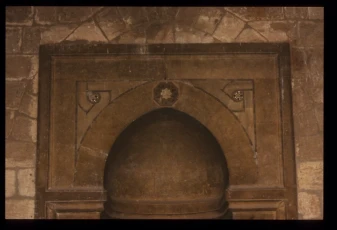
Al-Madrasa al-Kamiliyya, niche (mihrab) in the prayer hall

A gathering of men in a reception room with wall textile cover

Khan Qurdbak, iwan, section east-west
Size of plan 70 x 50 . with ruler (no scale).

Fountain in al-ʿAzm Palace

Kafr Halab village, clay dome houses

Remains of the Praetorium from east, Balis (Barbalassos)

Citadel of Aleppo, a view from the main entrance showing the Gate Tower

Jamiʿ al-Utrush, general view of the minaret
The only minaret in Aleppo with two galleries.

Woman in the outskirts of Raqqa presenting an embroidered cushion sitting on the houses terrace

A mechanical loom in the textile factory of the Mezannar family in Damascus

Tall Dahab, Cement-fixed area where rinsing or washing is carried out, body washing may take place there too

Khusrawiyya Complex, damage mapping (Arabic)
The Khusrawiyya is severely destroyed. The northern arcade and parts of the western wing of the complex are damaged. There are parts which are still under rubble. The degree of damage is around 80%. The center of the explosion crater, produced in 2014, is located beneath the prayer room, i.e. in the domed hall of the Friday mosque, which doesn’t stand anymore. Most likely, the foundations are lost inside the inner area of the crater, while the rest of the area may contain remains of the building, perhaps sufficient for possible reconstruction. No action regarding the protection or management of the rubble has been done yet.

Jamiʿ al-ʿAdiliyya, capital with muqarnas of a column in the double arcade

Habuba Kabira, the new dome house has received its first plaster layer

A general view of az-Zabadani city, which lies on the foothills of the the Anti-Lebanon Mountains

Damascus, Khan Asʿad Basha al-ʿAzm, general view of the vaults and pendentive
Cross vaults carrying domes, Khan Asʿad Basha al-ʿAzm

Aerial photograph of Barada valley in Jibal Lubnan ash-Sharqiyya (Anti Lebanon mountains)

Qalʿat al-Mudiq seen from the ruins of Afamiya

Salah ad-Din statue situated in front of the western facade of Damascus citadel

Afamiya, Ruined building

Waqf Ibshir Mustafa Basha, south western corner with former sabil

Closed arched entrance, Qasr al-Hayr al-Gharbi

Bayt Junblat, southern iwan (the great iwan)

The Cave Monastery, northwest of Palmyra, Jazil
[ Description by author: Trotz der völlig anderen Landschaft musste ich an das Höhlenkloster Dair Mâr Marûn am 'Assi in der Nähe von Hirmil im Libanon denken (Bilder dort !). ]

Hiraqla victory monument - Decorative stone panel

On the western shore of Jabbul-Salt Lake, dome houses with ventilation openings of the living room

Bayt Junblat, courtyard and northern iwan

Madrasat al-Firdaws, the marble prayer niche (mihrab) decorated with floral and geometric motifs

Al-Madrasa al-Kamiliyya, gate portal

Zayzun waterfalls of a tributary to Yarmuk river, which is there the border between Syria and Jordan

View on the Euphrates river from Dura Europos

Busra - al-Jami‘ (mosque) al-ʿUmari from the south

Qalʿat al-Marqab (Castle), Central courtyard and chapel

A self-manufactured fulling machine at work producing a felt carpet
Photographs of a manufacturing facility for felt carpets in Al Bab as part of the "Aleppo Stadtarchivprojekt" of GIZ (German Corporation for International Cooperation) in 2008

Entrance towers on the west side, Harim Castle

Jamiʿ ar-Rumi, general view from the minaret

Hama, general overview at the Jisriyya/Bridge Noria (waterwheel)
Here, in the picture from the thirties of the twentieth century, you can see the waterwheel, together with the name giving bridge, a separate building, as well as the terraces of two excursion locales or cafes. [Original description: Oronte eclairci NB] Note: these photos were taken between the year 1924 - 1939. The chosen date is to be average. (photographer unkown)

View of the Euphrates river with very shallow banks

Bad al-Hadid, detail of a rank decorating the gate's entrance from outside

At-Takiyya al-Mawlawiyya, sabil (fountain)

Busra - al-Jami‘ (mosque) al-ʿUmari - Islamic inscriptions

Tall Aswad near Raqqa, view to an outbuilding of a farmstead

View of Dahiyat as-Salihiyya at-Tarikhiyya from al-ʿAfif area

Simple muqarnas in the Castle of Harim

Tetrapylon and Colonnaded Street, 3rd century AD
The Tetrapylon marks a slight change of direction and an intersection in the course of the colonnaded street. It completely lies in ruins after the explosion.

General view of Shumaymis castle (Qalʿat Shumaymis)

Decorated wooden door of the Damascus Room in the Dresden Museum for Ethnology

Details of decoration on the Qaws Hadrian (Arch of Triumph)
[ Description by author: - wo genau ? ['Monumentalbogen, ??/??/2002'] ]

ar-Rusafa, Basilika A, view from west of the bema and the apse

Jamiʿ al-Mihmandar, lower part of the minaret
The minaret has a square base, octagonal drum, and cylindrical shaft ornamented with zig-zag friezes and blind arches. It dates to late 14th cent. AD (8th H) and was not constructed as part of the original mosque. The minaret was reconstruncted in 1946. (see also: archnet.org) The minaret had suffered severe damage during the conflict in Aleppo (2012-2016) and eventually collapsed.

Part of the Mihrab decorations, Umayyad Mosque
[ Description by author: Mihrâb: "Borte" über dem unteren Teil der Nische. ]

Raqqa, Tall Aswad, section drawing of a pottery kiln
Ceramic stove, section drawing with scale ruler

An inscription on the wall of Damascus Citadel
[ Description by author: auf der Ostseite des Nordost-Turms (vgl. Bild 0143 !). Mit der Inschrift habe ich Probleme: nach dem Rahmen scheint sie mir aus späterer türkischer Zeit, ca. 19.Jh., zu stammen - aber der Text scheint mir Arabisch und nicht Osmanli zu sein. Auf jeden Fall steht sie unter einem älteren - mamlukischen ? - Relief(band). Zu erkennen sind zwei - gegenständige ? - Löwen, unter dem rechten ein junger Löwe. Darunter eine Art Muqarnas. ]

Raqqa - "East of Raqqa" site - Tall Aswad, excavation in 1985
[1985/24/401] = [photo's name as: year/ film no./ photo no.]. ["s.a. Dias"]

A woman in a rural area with traditional clothes

Traditional houses near as-Sajur river
Doppelraumgrundriss

Tomb carved into the rock, ʿAyn as-Sahib
[ Description by author: Ädikula-Typ. Eigenartig der unsymmetrische Bogen: war der Platz links für eine Statue vorgesehen ? Vgl. Bild 0412, 0413 ! ]

A view from Jabal ʿAruda toward the plain of Manbij

al-Burayj, General view of the Monastery of Saint Daniel, 6th c. AD
[Description/Comment by the author:] Gesehen von ~ Südosten. Links Reste eines Turmes, der von manchen für der einer Kirche (die Steine links davon) gehalten wird. Das Gebäude rechts daneben enthält u.a. eine Kapelle, zum Türsturz vgl.Bild 2685 ! Dahinter die Pfeiler der dreistöckigen Galerie der Pilgerherberge. Das rechte Gebäude besteht aus zwei Teilen: links ein Turm, vermutlich der eines Einsiedlers, um den sich das Kloster entwickelte (der "Erker" wäre dann die Toilette), rechts ein angefügtes Gebäude, in dem sich Arcosol-Gräber befinden. Die Anlage stammt aus dem späten 6. Jh.. Vgl. Bild 2706 !

Jurn Kabir, a woman offering her dowry (carpets and sacks for storage)

Nahiyat Tall Tamir, Entrance corridor in front of the collapsed cupola house
The Assyrian villages on the Khabur with their domed houses were built by the French Mandate Government for Christian refugees from Turkey and Iraq.

Monastery of St Simeon Stylites, the baptistery

Hiraqla victory monument: reliefed fragments

Khusrawiyya Complex, damage mapping (English)
The Khusrawiyya is severely destroyed. The northern arcade and parts of the western wing of the complex are damaged. There are parts which are still under rubble. The degree of damage is around 80%. The center of the explosion crater, produced in 2014, is located beneath the prayer room, i.e. in the domed hall of the Friday mosque, which doesn’t stand anymore. Most likely, the foundations are lost inside the inner area of the crater, while the rest of the area may contain remains of the building, perhaps sufficient for possible reconstruction. No action regarding the protection or management of the rubble has been done yet.

Part of Qalʿat al-Qadmus

General view of the Great Mosque of Hama
Note: these photos were taken between the year 1924 - 1939. The chosen date is to be average. (photographer unkown)

Suq al-ʿAttarin, view to east showing the destruction

The minaret of Great Mosque of ar-Raqqa/ar-Rafiqa, 8th/12th c.

Jamiʿ ash-Shuʿaybiyya, view of the rectangular minarett above the main entrance

View into the courtyard of the Great Mosque of Hama

An aerial view of a water canal in the village of Shaykh Hilal
This image shows clearly the path of an old waterway. The residents make holes to clean the canals and they are visible on the surface. Olive trees spread near the canal.

Al-Bara, Pyramid Tomb A, 6th century
[Original: Größeres Grabmal (im Grundriß quadratischer Raumkubus mit pyramidalem Dach), sp. 6. Jh.]

Raʾs al-ʿAyn, streetview of a late ottoman residential house and a warehouse beside, situated on a slope
Behind the stone building in the front of the photo is situated the garden of the late Ottoman house.

Restoration of a part of a decorated wooden panel with ‘Ajami decoration of the Damascus Room in the Dresden Museum for Ethnology

Making falafel sandwiches

Burj as-Saʿa, the entrance

Near Habuba Kabira, a family trip by boat to their former village, that was flooded in 1973 by the Tabqa-Dam

Remains of the western basilica, Burj Haydar
[Original: Westliche Basilika, Säulenarkaden mit dorischen Kapitellen, 4. Jh.]

The upper part of the entrance, as-Sinaniyya Mosque
[ Description by author: Oberer Teil mit Stalaktiten-Halb"kuppel" und Bilder-Kacheln. ]

Monastery of St Simeon Stylites, external south wall of the east basilica

Madrasat al-Firdaws, mausoleum - inscription above wall cabinet

Hammam Bahram Basha, the cold section (barrani) after the destruction

Shahba, View to the historic center of the town

The northern-eastern tower of Damascus Citadel
One of the most beautiful towers of Damascus Citadel with its carefully carved stone rows. This upper part of the tower contains a machicolation, and the tower ends with parapets interspersed with arrow slits.

Inside the Hummus shop of Ra’oof al-Tatari

25 piastres (silver), 20 mm, 1958 (union with Egypt)

Traditional houses of the town of Darkush, located on the Orontes river

Restoration works at the Citadel of Damascus

Khusrawiyya, Friday Mosque, view of an window with ablaq and ceramic tiles

Hammam Bahram Basha, the entrance facade

ʿAyn al-Khadra, Baby in a traditional wooden cradle

Qasr al-Hayr al-Sharqi, decorations at the top of tower gate
[Original: Turm links]

Jamiʿ al-Utrush, general view of the western facade and the entrance

Citadel od Aleppo, Temple of the Storm God Hadad - Detail on platform wall
[Original: Grabung Kohlmeyer]

General view of the fertile Zabadani plains

Bayt Wakil, fountain of the reception hall (qaʿa)

Jamiʿ ash-Shuʿaybiyya, arcade and the prayer hall entrance
shap_import_66113

Maqam Ughulbak, general view from the outside

Al-Bab, the upper part of al-Jamiʿ al-Kabir (the Great Mosque) minaret

Great Mosque of Aleppo, courtyard floor with geometrical designs

A mechanical loom in the textile factory of the Mezannar family

Bayt Junblat, southern iwan (the great iwan)

Jamiʿ Aslan Dada, hall dome - squinch and muqarnas

Al-Matbakh al-ʿAjami: Qaʿa, section east-west, view to north
Qaʿa of Matbakh al-ʿAjami, size of plan 55 x 45, ruler.

Aramaic inscription on the western altar, al-Karasi
[ Description by author: Detail aus Bild 0571: die aramäische Inschrift. ]

Balcony above main portal of Khan al-Harir

A row of Byzantine columns, Qasr al-Hayr al-Sharqi

Ruins of Qalʿat ash-Shugr wa-Bakas on the edge of a mountain slope

Safita, The Donjon of the Templars with a chapel in the ground floor

Wedding party in a street in Mukhayyam al-Yarmuk in Damascus

ar-Raqqa, Qasr al-Banat, the northern iwan
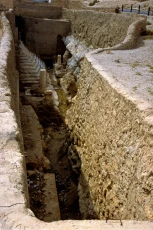
The historical sulfur Afqa Spring
[ Description by author: Wieder die Quelle, aber diesmal von ~ Nordosten. Links und hinten rechts sind zwei Altäre zu erkennen. Wenn das Gestufte hinter der Säule die alte Zugangstreppe zur Quelle ist, war sie verdammt steil ....... ]

Al-Madrasa as-Sultaniyya, view from the courtyard to entrance and minaret

A little boy from a resettlement village is drawing water from a tap embedded in the ground
The village was resettled in the 70s to Northeast Syria due to the construction of the Al-Furat dam of the Euphrates. Typically, these houses were covered with a corrugated iron roof and had their water source in the court instead of inside the house.

At-Tabqa , Minaret of the Mosque at Jaʿbar Castle.
Note: these photos were taken between the year 1924 - 1939. The chosen date is to be average. (photographer unkown)

Jamiʿ al-Utrush, western facade - decorated window
The window has rectangular shape and decorated by ablaq style (black and yellow masonry) on the sides and joggled voussoir. All combined inside a large flat niche with two spiral columns on the lower section and topped by a cornice of muqarnas. The niche top part framed by double muqarnas plates and carved serrated border. Also, there is upper small niche above the big windows.

Bimaristan Arghun, southern courtyard - view of open dome
shap_import_60897

Bayt Junblat, courtyard and northern iwan

New buildings still empty for agricultural purposes in the Ghab-plain

The cella of Bel Temple, 1st c. AD

Tall al-Mishrifa (Qatna) within its geographic area

shap_import_3226

Old Damasccus, an artisan engraves on copper vessel

Mosaic of Orpheus, Shahba Museum


Traditional patchwork wall hangings, in which small things might be stored

Columns with Corinthian capitals, remnants of the Jupiter Temple

People near the historical city Wall of Raqqa

Jisr ash-Shughur, Qalʿat ash-Shugr wa-Bakas, a twin crusader castle, caves

Jamiʿ al-Khayr, main entrance details from the inside

The suspension bridge over the Euphrates in Dayr az-Zawr

Northeast Tower, Khan al-Hallabat
[ Description by author: (der rechte von Bild 0944) und Eingang, gesehen von Südosten. ]

Burj as-Saʿa, mechanical clock

Remains of the Byzantine tower incorporated into the Umayyad complex at Qasr al-Hayr al-Gharbi (Palace)
[ Description by author: Gesehen von ~ Südwesten. ]

Excavation of Abbasid ruins in Kharab Sayyar

A general view of a part of monumental buildings
[ Description by author: dahinter das Areal des Bel-Tempels. Vorn links die Säulenstraße, 3. Abschnitt, dann der Tetrapylon, dahinter die Säulen der Diokletians-Thermen und dann der Monumentalbogen. Man sieht deutlich, dass die Säulentraße auch im Tetrapylon einen Knick aufweist. Rechts vom Tetrapylon das Theater, ganz rechts die Agora mit Annex und Bankettsaal. Gesehen nach ~ Südosten. ]

Bayt Ajiqbash, carved stone at the courtyard

Khan Dannun - Courtyard

Archaeological finds from Raqqa, exhibited in the Damascus National Museum
From Balis and now in Damascus Museum. [Original:'DAMASKUS, Mus. <---
Balis']

Jamiʿ Aslan Dada, facade and entrance of the additional prayer hall (al-Hijaziyya)

Zayzun waterfalls of a tributary into Yarmuk river (border Syria/Jordan)

Habuba Kabira, Interior of the last existing deepened house (debabe), which was later used only as storage space

View into an arcade with ablaq masonry, Khan Asʿad Basha al-ʿAzm

Interior view of Basilika A, ar-Rusafa
[Original: 1945 Geschenk Prof. Friedrich Sarre]

Raqqa countryside, a traditional wedding ceremony in Suwaydiyya Kabira village

Waqf of Ibshir Mustafa Pasha, Coffeehouse, interior, dome and muqarnas squinches

Muzayrib - Ruins of an historical bridge
Pilgerstraße, Brücke

Izraʿ, al-Jamiʿ (Mosque) al-ʿUmari - the courtyard

Jabla, Mosque of Sultan Ibrahim, Arched entrance built according to the ablaq system

Palmyra, Remains of Allat Temple- Camp of Diocletian
[ Description by author: Gesehen von ~ Nord-Nord-Ost: rechte Seite und Rückwand. Ganz links das Temenos-Tor. ]

One of the inner part of Ibn Maʿn Castle

Near Tall Tamir, an Assyrian village, courtyard of a house with two later flattened domes of the original building
The Assyrian villages on the Khabur with their domed houses were built by the French Mandate Government for Christian refugees from Turkey and Iraq.

Burj al-Ghanam, general view of the tower's southern facade

Qasr al-Hayr al-Sharqi, Upper part of the gate tower,

Raqqa - "East of Raqqa" site - Tall Aswad – sherds
Raqqa IV; Tall Aswad; Pottery garden probl. near excavation house in Tall Bi'a

Madrasat al-Firdaws, a grave on the west of prayer hall

Hiraqla victory monument - plan of ground level
Reconstruction drawing of gound level. Plan showing construction system. (with ruler)

A photo taken from the southern side towards Ibn Mʿan's castle

Bayt Junblat, southern iwan - marble decoration

Monolith ceiling of the south thalamos in the cella, Temple of Bel
[ Description by author: Cella, Süd-Thalamos: Decke. Sie besteht aus einem einzigen Monolithen. ]

Sahl Hawran (Hawran Plain), agricultral area
[Original: Südsyr. Ackerebene im Hauran mit Hermon]

Bayt Ghazala, ʿajami panels decorating the southern wing ceiling in the main reception hall (qaʿa)

Public street life in Raqqa

The facade of prayer hall overlooking the courtyard, Umayyad Mosque
[Original:'Damaskus, Omajjaden-Moschee, vom Friedhof aus gesehen']. The Bavarian air force division 304b was based in Palestine from 25. October 1917 and was involved in the First World War until the division left the region, over Aleppo, in mid September 1918. During that period, over 3000 glas photographs, mostly aerial, have been made. Those early photographs were important for the archaeological research in the Middle East.

An aerial view of Ibn Maʿn's castle located on one of the highest mountains of Palmyra

A coffee house and waiting service taxi in the center of the small frontier town

Tall Bdiri, A simple opening in a clay brick wall with clay plaster - probably in a stable

Busra, Hammam Manjak, Restoration works

Habuba Kabira, upper part of a cantilever dome construction
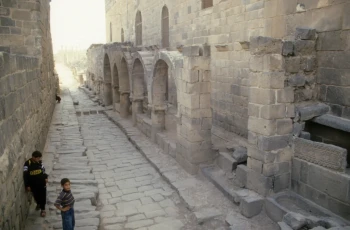
Busra, Vaulted arcade, eastern facade of al-ʿUmari Mosque

Burj al-Ghanam, partial view of the tower's south eastern facade
shap_import_63420

Busra, The East Gate "Nabataean Gate"
Nabatäisches Tor, Hauptstraße, am östlichen Ende der Hauptstraße, von Westen. Es soll im frühen 1. Jh. erbaut worden sein Westlich davon lag das römische, nach Osten das nabatäische Viertel der Stadt. Der Name ist weniger auf seine Erbauer, als auf die typisch nabatäischen Hörnerkapitelle der Säulen und Pilaster zurückzuführen. Vgl. Bild 3776 - 3779 !

Jamiʿ as-Saffahiyya, minaret and entrance
shap_import_64338

Raqqa - "East of Raqqa" site - Tall Aswad – sherds
Raqqa IV; Tall Aswad; Pottery garden probl. near excavation house in Tall Bi'a


Bayt Junblat, southern Iwan - decoration detail of marble and ceramic tiles

On the western shore of Jabbul salt lake, triangle door of a kitchen as a domed room

Madrasat al-Firdaws, view to south - courtyard and arcades

Salt production in extraction, possibly in as-Sabkha in the Euphrates Valley
[Original: Salzgewinnung im Euphrattal]

Tomb of Elahbel in the Valley of the Tombs, interior view
[ Description by author: Bei den Bildern 0838 - 0840 gibt es ein Problem: gehören sie zum Turm des Elahbel oder zu dem des Jambliqu ? Da aber auf allen meinen Bildern der Eingang zum Turm des Jambliqu mit einer Gittertür verschlossen ist, auf der anderen Seite alle meine Führer schreiben, dass man den Turm des Elahbel besteigen könne und wegen der Aussicht auch solle, dürfte es sich um diesen handeln. Jedenfalls befinden wir uns hier in einer höheren Etage mit Blick auf den Eingang ins Treppenhaus. Das Relief unten rechts zeigt einen typischen Palmyrener auf eine Kline - wie er an der Außenseite bzw. an der Rückwand im Erdgeschoss "fehlt" ....... ]

Damascus, Sinâniya-mosque, fassade, built 1518
[ Description by author: Erbaut 1590. Eingangs-"Iwan", Minarett und Kuppel. ]

View to the excavation in Tall Shaykh Hamad in 1984
[Original:'TALL SAIH HAMAD']

Aleppo Citadel, entrance gateways and bridge

General view of the ruins of Palmyra
[ Description by author: vom Bel-Tempel, also von ~ Südosten, her. Rechts der Monumentalbogen, von ihm ausgehend nach hinten links der 2. Abschnitt der Säulenstraße bis zum Tetrapylon. Von dort zweigt eine weitere Säulenstraße nach links ab. Im Hintergrund die Burg des Fakhru d-Dîn al-Ma'ni. Die hohen Säulen vorn gehören zur Exedra des 1. Abschnitts der Säulenstraße (vgl. Bild 0657 - 0660 !). ]

Raqqa, "East of Raqqa" site - Western Palace, vegetable stucco ornaments
Raqqa IV; Eastern West-Palace, s.SW-Neg.85/412

Busra, Hammam Manjak

The Great Colonnade: southeastern passage
[ Description by author: zur Rundstraße um das Theater im 2. Abschnitt der Säulenstraße, gesehen von ~ Norden. Der vordere Bogen ist der linke (> Tetrapylon) der Kolonnade, der hintere enspricht der Linie der Häuserfronten.. ]

Exterior view of Seljuk watermill ''Bab as-Salam watermill'', Damascus

Khusrawiyya, interiour view at sudda (tribune) in Friday Mosque in 2008

Al-Matbakh al-ʿAjami, facade of the west section of the great hall

Raqqa, Qasr (Palace) al-Banat

General view of al-Qadmus Castle on a natural rocky hill

Al-Madrasa al-Hallawiyya, main entrance

A couple a day after their wedding
The woman is wearing a Habari (screen-printed head-scarf) over which she has laid an Abaya (coat)

Bimaristan Arghun, muqarnas vault behind entrance portal

Tartus, ash-Shaykh Badr, Entrance gate to al-Kahf castle

Waqf of Ibshir Mustafa Pasha, Coffeehouse, Ibshir Mustafa Pasha and bathhouse of Bahram Pasha facades
The facades of the coffeehouse of the Waqf Ibshir Mustafa Pasha (left part) and the earlier bathhouse of Bahram Pasha (right side) have an extensively decorated exterior, facing one another on the street that runs east-to-west at the south of the waqf complex, which became the most decorated public street space in Aleppo.

Busra - Hammam Manjak - Restoration works

Dar'a, al-Jamiʿ (mosque) al-ʿUmari- main door from the inside

Modern interpretations of the traditional craft of ‘Ajami (workshop of Aliya Alnuami)

Jamiʿ al-Mihmandar, prayer hall - minbar (pulpit)

Baghdad Gate of Raqqa-Rafiqa, 10th c. onwards
The gate built from fired brick was located in front of the southeast corner of the city wall of Raqqa-Rafiqa.

Busra - Masjid Yaqut (mosque) - founding inscription

Maronite Cathedral, one of the catherdral pointed towers

Traditional house in neighborhood "al-Almaji"
Traditional two-storey house from the late Ottoman period (19th century?): the main stonework façade on the upper floor is symmetrically accentuated by a leap forward wooden oriel, the "Kishk".

A shepherd-boy with his herd, on the edge of al-Ghab Plain
[Original: Junge mit Schafe am Rand des Ghab]

Maronite Cathedral, main entrance

The Citadel of Damascus from the inside, 2003

Entrance gate to the city of Ugarit
[Original: Ausfalltor in Ugarit]

Paintings in Hananiya church in Bab Tuma quarter
Paintings on the walls of a room in the church, that tell the story of Paul's missionary journeys between 46 and 62 AD.

Palmyra, arch of Triumph (Qaws Hadrian), entrance to the Great Colonnade
View towards north west

Yabrud: Streetlife with shops and residential houses, townspeople and peasants
Street view with houses and a village scene of a farmer with cart and draught animal. The buildings along the road show a local architecture (of the Qalamun Mountains): one to two-storey stone facades with triple openings in the upper floors. Middle door and side windows, all with round arches and a balcony in front. A symmetrical stone façade made of cleanly carved limestone and slender arched windows. These houses will probably be built in the first quarter of the twentieth century.

Al-Madrasa al-Hallawiyya, wooden prayer niche in the iwan

Takiyyat ash-Shaykh Abu Bakr, interior view: courtyard, rooms from outside, arcade and the inner entrance

Minaret of the great mosque, (al-Jamiʿ al-Kabir), Maʿarrat an-Nuʿman
und Bauten aus Spolien im Innenhof. [Original: Ma'arat an-Nu'mân (Arra)']

A metal workshop in the city of Raqqa

Busra, a view into the Roman theater (3rd c), which was in Islamic times converted into a fortress

Bayt Ghazala, ʿajami wall panels decorating the main reception hall (qaʿa)

A staircase in Ibn Maʿn Castle

Inside the city wall, excavation work, Qatna
. [Original: Al-Mishrifa / Qatnâ']

Informal (unplanned) settlements spread in the Ghouta, 1980s
Since the second half of the 20th century, more and more modern cement buildings have displaced the gardens and fields of the Ghuta - their orchards had to give way to urban expansion.

Raqqa, The ruins of Qasr al-Banat

Decoration detail on the Arch of Triumph (Qaws Hadrian)

Traditional house with reed hut ("sibat", arab.) in Euphrates valley at the national road 4/junction to ar-Raqqa

Damascus, Hammam al-Qaramani
Arch with tympanum of a gate? Hammam al-Qaramani

Door and windows of a room in the ground floor, Khan Sulayman Basha al-ʿAzm
[ Description by author: Türen und Fenster im Erdgeschoss. Vgl. Bild 0314 ! ]

Al-Muhammadiyya waterwheel (noria)

Salah ad-Din statue at the western facade of Damascus citadel

Sulphurous karst spring of the Khabur at Raʾs al-ʿAyn

Qunaya: in the Museum of the Monastery of St Simeon
The museum shows everyday objects as they are often found in the earth still today: pearls, bracelets, spindles, etc.
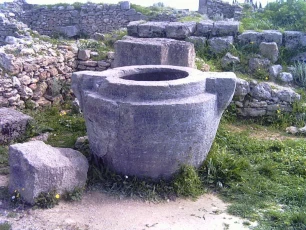
Big stone trough, Ugarit
shap_import_74031

General view of Tall Afis

Remains of Harim Castle

Khan as-Sabun, window and decoration above the entrance

Turbat Khaʾirbak (mausoleum), western facade - tomb chamber

Khan al-Wazir, general view

A side from Shumaymis Castle, as-Salamiyya

View inside the courtyard of Manjak Mosque

Suq az-Zarb, view towards west of the suq after the destruction

A general scene showing some of the ruins of Palmyra and the Castle Ibn Maʿn

Corinthian capital in the great mosque (al-Jamiʿ al-Kabir), Maʿarrat an-Nuʿman
Spolie am größeren Bau im Hof der Moschee. [Original: Ma'arat an-Nu'mân (Arra)']

Summerrestaurant in Bludan

Dome houses in a village in Aleppo countryside

Khan al-ʿArus before the restoration, view from south-west

Jamiʿ al-Utrush, general view of western facade and minaret

A general view of the Krak de Chevaliers at the sunset

Jurn Kabir, whitewashing with chalk milk

Cows in a field in the Ghouta of Damascus
The Ghouta of Damascus was characterized by the raising of cattle (known as the Damascene cows) of pure race, which is unique compared with the rest of the Levant. The rich pastures of the Ghouta provided good feed, and hence the cows provided the best milk.

In the living compartment of the semi-nomadic family's tent (from Maskana region)

al-Malikiyya - ʿAyn al-Khadra, Basalt Tomb with arabic inscription

View over the roof of the south-western Madrasat Ismaʿil Basha al-ʿAzm to the Umayyad Mosque with its high transept of the prayer hall with a central dome and its three minarets

General view of as-Sabuniyya Mosque
[ Description by author: mit Minarett und Eingangs-"Iwân". Die Madrasa stammt aus dem Jahre 1458 (1464 ?). Gesehen (wohl) von ~ Osten. ]

West Syria, access to the Salah ad-Din Castle carved through two artificial crevices, 12th c.

The entrance of al-Madrasa az-Zahiriyya is richly decorated with ablaq masonry, a muqarnas vault and inscriptions

Hammam Bahram Basha, the hot section (juwwani)

Busra, al-Jami‘ al-ʿUmari and Hammam Manjak, exterior facades

At-Takiyya al-Ikhlasiyya (az-Zawiya ar-Rifaʿiyya), general view of the northern facade

General view of al-Jibal as-Sahiliyya (the coastal mountains) covered by forests

Tartus, ash-Shaykh Badr, Inscription in al-Kahf Castle

A side of al-Mudiq castle shows some of its towers

Al-Madrasa az-Zahiriyya, angle niches below the dome in the mausoleum
shap_import_66076

ar-Rusafa, view into a conche of the Tetraconch-Church
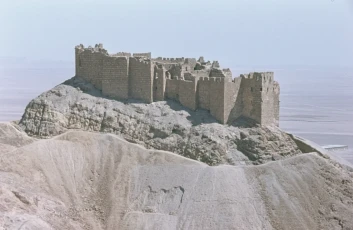
Aerial view of Qalʿat Ibn Maʿn (castle) from the west

Exterior view of ʿArbin watermill in Rif Dimashq

Busra, al-Jami‘ (mosque) al-ʿUmari - minaret, northern-eastern corner

Loopholes in the fortifications of Halabiyya


Marble cenotaph next to the tomb of Salah ad-Din, was presented by German Emperor Wilhelm II during his visit to Damascus in 1898
[ Description by author: Der Kenotaph Salâhu d-Dîns. Das Grabmal war völlig vernachlässigt, bis es Wilhelm II auf seiner Orientreise 1898 restaurieren ließ und diesen Steinsarkophag stiftete. Davon berichtet die Inschrift oben links, vgl. Bild 0230 ! Zu dem weitgehend verdeckten älteren Holzsarkophag s. Bild 0229 ! (The year of the photo is not sure according to Peter Heiske ) ]

Mari (Tall Hariri), a side of the architectural remains
[Original: Große Orientreise Nr.63 mit Rotel-Tours: Amman-Bagdad-Uruk-Babylon-Arbil-Mosul-Hatra-Samara-Mari-Dura Europos-Aleppo-Dayr Saman-Ugarit-Palmyra-Jarash]

Al-Madrasa as-Sultaniyya, entrance - stone carved Arabic inscriptions

In the outer courtyard of the ʿAzm-Palace, now the museum of the arts and popular traditions of Damascus

Bayt Junblat, southern iwan - decoration of marble and faience tiles

Citadel of Aleppo, entrance of the Palace of al-Malik al-ʿAziz Muhammad

Jamiʿ at-Tawashi, east facade - one of the two columns which frame a window

Remains of the main entrance of Nabu Temple, Palmyra
[ Description by author: Gesehen von ~ Süd-Süd-Ost. Im Tor sieht man hinten die Säulen der Diokletians-Thermen, hinter der rechten Türrahmung den Altar und dahinter die Treppe zum Podium des Tempels. Der Altar hat die Form eines Naiskos (vgl. Bild 0680 !), wie z.B. in Qal'at Faqra im Libanon. ]

Women and children (of a family of former nomads) in one of the Upper Euphrates Valley villages

The upper part and keystones of the apse, Basilica of Qalb Lawza

Aleppo Great Mosque, courtyard general view towards north west
View of courtyard (Sahn) showing its two-coloured pavements and the two ablution fountains with cupolas, the octogonal is Hamdanid, and the famous minaret in the north western corner, before its destruction in 2013!

Al-Madrasa as-Sultaniyya, general view from Saray

Southwest wall of the Agora
[ Description by author: Südwestwand der Anlage, gesehen von ~ Südosten, von der Außenseite. Im Hintergrund die Säulenstraße. Vgl. Bild 0709 ! ]
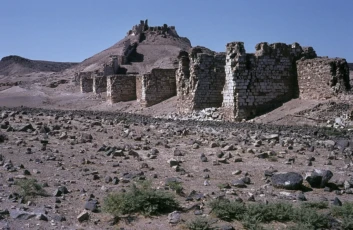
Outside of the surrounding wall of Halabiyya fortress

Jamiʿ al-Utrush, western facade - decorated window
The lower window is decorated with black and yellow masonry (ablaq) and joggled voussoirs. Two slim spiral columns flank the ablaq-masonry to each side. The window niche above has a rectangular shape and is surrounded bycarved palmette leaves and a zig-zag frieze. The small upper window is topped by a double row of muqarnas.

Inside the city wall, excavation work, Qatna
. [Original: Al-Mishrifa / Qatnâ']

Raqqa, Qasr al-Banat, clay decoration

Staircase and old wooden door in a traditional House in Maʿlula

al-Malikiyya - ʿAyn al-Khadra, Basalt Tomb with arabic inscription
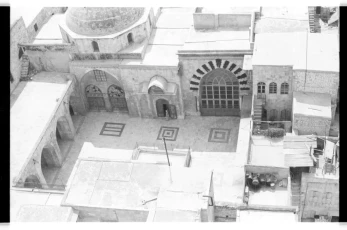
Al-Madrasa al-Hallawiyya, general view of the madrasa from the Great Mosque minaret

The northern entrance of the historical city of Dura Europos (Qalʿat as-Salihiyya), end of 4th century BC
Gate of south-western side/ view from outside [Original: "Salihiyyah, Tor der Südwestseite / von Außen"]

Jamiʿ ash-Shuʿaybiyya, prayer hall
shap_import_66115

Northwest corner of Nabu Temple
[ Description by author: ~ Nordwest-Ecke. In der Mitte das Podium des Tempels, vorn zwei Säulen und viele Basen der ~ West-Kolonnade des Tempelhofes. Hinten rechts die Propyläen, ganz hinten links die arabische Bastion des Bel-Tempels. ]

Part of the walls, Qalʿat Harim
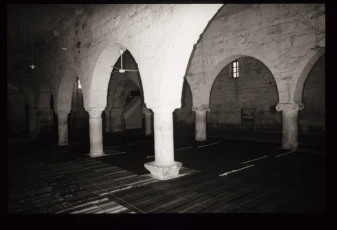
Dar'a, al-Jamiʿ (mosque) al-ʿUmari - The prayer hall

Jamiʿ al-Mihmandar, marble prayer niche

shap_import_11878

Al-Madrasa al-Ahmadiyya, general view into the turba

at-Tabqa , a view to the Euphrates from Jaʿbar Castle

The suspension bridge over the Euphrates in Dayr az-Zawr

A capital decorated with acanthus leaves, Monastery of Saint Simeon
[Original: -k.K6/=HQ k.K24]

Bayt Wakil, detail of windows and courtyard decoration

Jamiʿ al-ʿAdiliyya, muqarnas decorationg a niche on the right side of the prayer hall's entrance

Upper Barada valley in Jibal Lubnan ash-Sharqiyya (Anti-Lebanon Mountains)

A side from the courtyard of Bayt Jubran Afandi Shamiyya, Bab Tuma
Hof mit Liwan und Seitenliwan

A flock of pigeons in the old city of Damascus
A scene of a flock of pigeons gathering over the rooftops

Khan al-Wazir, internal facade of the khan's entrance
[Original:'Khân al-Wazîr,Halab / Aleppo. Innenseite des Tores von Bild 1248.'].

An entrance, Qasr al-Hayr al-Gharbi

Sculpture on sacrophagus
[ Description by author: Bei Bild 0873 - 0877 handelt es sich um den selben Sarkophag, vielleicht gehört auch Bild 0872 dazu.- Diese Sarkophage bestehen aus zwei Teilen: dem Kasten, der in der Form einer Kline mit Polster gearbeitet ist, und dem Deckel, der den liegenden Toten darstellt. Bei der Kline sind bis in feinste Details Holzschnitzereien nachgeahmt, bei dem Polster und insbesondere bei den Gewändern die feinsten bestickten Stoffe. Unter der Kline sind Szenen dargestellt, hier wohl Diener, die für ein (Toten)Mahl oder (Toten)Opfer rüsten. Auch die Szene von Bild 0872 "spielt" unter einer Kline: aus dem Alltag des Toten, wohl eines Handelherrn. ]

Bayt Dallal, iwan with a wooden canopy

Feast of the excavation with musicians playing the local music with mizmar (local oboe) and big drum

Jamiʿ at-Tawashi, entrance - decoration details

Remains of the city wall of Halabiyya fortress on the bank of the Euphrates

The southern-western tower of Damascus Citadel

Sancturies graved into the rocks, Roman period, Mnin
[ Description by author: Blick auf die Anlage von (wohl) ~ Südwesten. Ganz rechts das Tor, links daneben die große Halle mit monumentaler Freitreppe zu einer Plattform davor. Links hinter ihrer Balustrade die kleine Halle mit reich dekoriertem Eingang: danach (vgl. Bild 0401 !) wird die Anlage ins 3. Jh. n. Chr. datiert. Irgendwie macht das Ganze einen "nabatäischen" Eindruck, der durch weitere Details auf den folgenden Bildern (insbesondere Bild 0401) verstärkt wird. ]

A stairway leading to the upper floor, Najm Castle (Qalʿat Najm)

Pre-drawn patterns of a contemporary ‘Ajami decoration

View to the east. The northern riwaq to the left, and the northern facade to the right. The burned eastern part is in the background. The space is 07 in general, according to the ground plan. Here in general F, Ft. Wc. Wd, and Wa. are seen.

Bayt Wakil, iwan

Jamiʿ Aslan Dada, the dome of prayer hall (qibliyya)

Top view of a group of traditional houses in Saydnaya

Bayt Dallal, iwan - wooden decorated canopy

The Roman Theatre and the Ayyubid Citadel, Busra
[Original: Theater, Bühnengebäude (wahrsch. spätes 2. Jh.)]

Ar-Rusafa, Decoration details on the inner facade of the North Gate

A popular market in Raqqa

Raqqa, "East of Raqqa" site - Western Palace, vegetable stucco ornaments
1985/49/743 = [photo's name as: year/ film no./ photo no.] Frieze P ["s.a. Farbdias"]

Hammam Bahram Basha, the main northern facade

Archaeological finds from Raqqa, exhibited in the Damascus National Museum
Luster ceramic bowl from ar-Raqqa; National Museum Damascus; Mus.Nr.13076

Baalshamin Temple, general view from southeast, Qalat Ibn Maan in background

Qal‘at Shayzar (castle), The stairs leading to the entrance

Al-Bara, Pyramid Tomb A, 6th century
"Größeres Grabmal (im Grundriß quadratischer Raumkubus mit pyramidalem Dach), sp. 6. Jh."

Tall al-Mishrifa (ancient Qatna), view of the historic citywall, within which the village is located
City wall and village houses

Two workshops for the manufacture and sale of iron tools in Raqqa

Tomb tower of Elahbel in the Valley of the Tombs

View of an orchard in the Eastern Ghouta

View at al-Hariqa district showing the south-western tower of Damascus Citadel

The Great Colonnade at Afamiya

Busra, The hot section (juwwani) of Hammam Manjak
Hamam Manjak
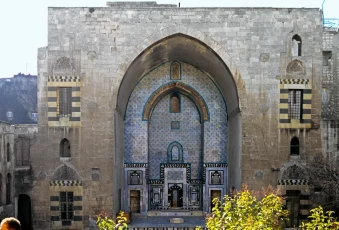
Bayt Junblat, southern iwan (the great iwan)
[Original:'Qasr Jumblât, Halab / Aleppo. Der Süd(?)flügel mit dem großen Iwân, gesehen von ~ Norden, wohl aus dem Iwân des Nordflügels. Das Gebäude stammt aus der 2. Hälfte des 16. Jhs.. Vgl. Bild 1302 - 1306 !].

South part of the east side, Hammam al-Qaramani
[ Description by author: Südteil der Ostseite. Der obere Teil "modern" mit Beton ausgebaut. ]

General view of the Great Colonnade (Shariʿ al-Aʿmida)
[ Description by author: 3. Abschnitt. Ganz links das Tempelgrab, ganz rechts der Tetrapylon und dahinter der Monumentalbogen. Unterhalb des Tempelgrabes ein Stück der Stadtmauer. Gesehen nach ~ Südosten. ]

A small pathway in the Ghuta of Damascus
The Ghuta consisted of a large number of groves separated from each other by walls or mud fences. There was often a small road between a grove and another, where it was accessed through a gate. The walls were built of rammed earth, an old tradition of rural architecture in the region.

Jamiʿ al-ʿAdiliyya, general view of the prayer hall showing the minbar

Northwest corner of Mushannaf Temple with the artificial pool in the foreground

Tall Abyad, House decoration to welcome the house owner after the pilgrimage to Mekka

Ecological and botanical garden near Damascus citadel

Remains of tower tomb
[ Description by author: Blick in die Cella von ~ Südwesten. ]

Jamiʿ Sharaf, inscription above ad-Darih

Al-Bara, oil mill, 5th-6th c.

The historical sulfur spring of Afqa
[ Description by author: Wie Bild 0581, leicht geänderter Blick: Altar, Säule, "Treppe", Altar. ]

Wakil house, interior façade of the upper floor
A carried balcony is open to the courtyard with two adjacent arches, and on the right, there are several windows upstairs.
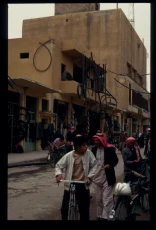
Daily life scene in the city of Raqqa

Qasr Ibn Wardan, the church

On the Genocide Memorial Day: at a stop on the pilgrimage, Armenian priests throw wreaths into the Euphrates to commemorate the victims of the genocide of 1915-17 who died in this very river

ar-Rusafa, North Gate of the city wall, interior
[Original: 7-Syr98/17-14]

Khan al-Jumruk, exterior facade of the Khan's entrance

An apse in Hananiya church in Bab Tuma quarter
The stone vaulted niche contains three paintings that tell part of the stories of Paul the Apostle

Az-Zawiya al-Hilaliyya, northern facade (library)

Lintel of the main entrance of the Church, Ibn Wardan Palace
[Original: Kirche (Kuppelbasilika mit Emporen), Tympanon der südlichen Tür]

Spring pasture of sheep grazing in Badiyyat ash-Sham at Sabʿ Biyar

View over the floodplain of the Euphrates valley to the village on the eastern steep bank

The southern end of the Great Colonnade at Afamiya

Natural view near the village of ʿArna on Jabal ash-Shaykh

Busra - Jamiʿ (mosque) al-Mabrak from the outside

Ash-Shaykh Hasan Mausoleum
Photo of Mausoleum des Gouverneur Ahmad Pasha, in Maidan

Citadel of Aleppo, Temple of the Weather God, early 1st millennium BC
The remains of the Hittite temple on the citadel hill, discovered during excavations in the 1990s, show mixed creatures and gods on basalt relief stones.
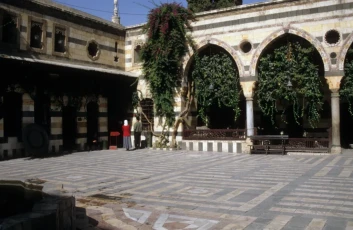
Qasr (palace) Asʿad Basha al-ʿAzm, inner courtyard

In the vicinity of a small town/village on the slope of a natural rock, possibly in the Afrin region
Question: Does anyone know where the place shown in the photo is located? The photo was taken in 1984 somewhere in West or North Syria. On the photo one can see a small river, a wide plain with fields and trees, and a rock rising from the plain with a small building on top. On the slope of this rock is situated a small town. Since there are low mountains in the background, the photo may have been taken in the Afrin region.

A colorful marble niche in the mausoleum of az-Zahir Baybars
[Original: Zahiriya, Mausoleum des az-Zahir Baibars, 1277. Mihrab-Nische mit Marmorinkrustationen]

Manufacture of local handmade carpets, Qanawat

Parking spaces infront of the textile factory of the Mezannar family in Damascus

Raqqa, Palace D, stucco decorations
Palace D; Inst.Neg. 86/1426 Floral frieze decoration

Stamping machine for punch cards for the Jacquard looms in the textile factory Mezannar in Damascus

reconstruction al-Husn Church

The towers of the outer wall of Qasr al-Hayr al-Sharqi
[Original: 1. Anlage]

A Jacquard-loom in the textile factory of the Mezannar family in Damascus

At-Takiyya al-Ikhlasiyya (az-Zawiya ar-Rifaʿiyya), details of the hall facade situated on the eastern side of the courtyard
shap_import_65807

Suq az-Zarb, view of the former (destroyed) entrance arch to the west

Busra - Jamiʿ (mosque) al-Mabrak from the outside

Al-Madrasa as-Sultaniyya, exterior view of northern facade - entrance, minaret and garden

A side of the Cavea, Palmyra Theater
[ Description by author: linker Teil. Die Cavea soll ursprünglich etwa dreimal so viele Sitzreihen gehabt haben: das Theater von Palmyra war eines der größten im Nahen Osten. Es wurde allerdings niemals vollendet ....... Im Hintergrund ganz links die Burg, weiter rechts und näher der Tetrapylon. Der Bogen rechts in der Kolonnade markiert den nordwestlichen Durchgang zur Rundstraße ums Theater. Gesehen nach ~ Nordwesten. ]

Khan as-Sabun, view of eastern gallery, northern inner facade and building part inside of courtyard

Colorful ornamental motifs on ablaq wall, Jamiʿ as-Sinaniyya

Interior view of Qanawat theater

View into an excavation trench of Tall Bdiri: to stabilize the walls, pilasters were added

Jamiʿ at-Tawashi, eastern facade - window within a rectangular niche decorated with muqarnas

Damascus, Khan Asʿad Basha al-ʿAzm, an arcade topped by a cross vault

Bayt Junblat, southern iwan (the great iwan)

General view of the Mediterranean sea in Baniyas

As-Sa'a roundabout in the city of Raqqa

Busra Citadel - tower

Waterfalls of Tal Shihab (during summer time)

Narrow hidden alley in the city of Halle, Germany

Al-Madrasa as-Sultaniyya, view of southern window of al-Malik az-Zahir Ghazi tomb
The window topped by an inscription panel

Remains of the façade, South Temple in ʿAtil

Roman Theater, 2nd c. AD
The theatre had been renovated before the war. It was used by ISIS for executions.

Nahiyat Tall Tamir, Baking flat breads on the tannur wall (tannur deepened in the ground)

Interior view of the church, Qarqbiza
[Original: einschiffige Kirche, Innenansicht]

Jisr ash-Shughur, Qalʿat ash-Shugr wa-Bakas, a twin crusader castle, Arabic inscription

Citadel of Aleppo, exterior view of the domes of the Hammam

Busra, view of the Westgate of the Decumanus Maximus
Bâb al-Kandîl (Laternentor), Hauptstraße, von Süden aus der Straße zum Theater. Man erkennt gut die Sockel der ehemaligen Südfassade.

Natural diversity in the Jabal Haramun (Mount Hermon)

Husn Sulayman, Temple of Zeus Baetocaece, inner face of the North Gate
Symetrical gate composition: higher middle gate, topped with semi circular arch. View from south.

Jamiʿ al-Utrush, general view of the western facade and the entrance

A room cladded with ‘Ajami decoration in a Damascene house
shap_import_97592

Jamiʿ al-Qayqan, Main entrance

A view of the remains of Harim Castle

Fresco on the apse, Roman Orthodox St. Elian Church, Homs
[ Description by author: Rechte Seitenwand: oben in den Medaiilons zwei Evangelisten, darunter Apostel. ]

A shepherd with his herd and tourists
[Original: Große Orientreise Nr.63 mit Rotel-Tours: Amman-Bagdad-Uruk-Babylon-Arbil-Mosul-Hatra-Samara-Mari-Dura Europos-Aleppo-Dayr Saman-Ugarit-Palmyra-Jarash]

Mushabbak, Byzantine basilica, view from south

Damascus, An old wooden door

Khan al-Wazir, main entrance

Qalb Lawza, Basilica of 5th c., decorative door of reliquary room in southern facade (east)
The relics of Symeon were located in the southern apse side room. This martyrion can be recognized from the outside by the third door in the south wall and by a tiny window next to the door through which the pilgrims could be supplied with holy oil. A direct door into the sanctuary suggests that the Symeon relic was also used during the service. The windows are bordered by a particularly elaborately designed cornice band. The façade also has oblique grooves and square depressions, probably from the base of a sloping roof and its purlins.

Al-Madrasa az-Zahiriyya, general view of the courtyard and the colonnaded portico

Architectural remains of the graveyard near Najm Castle (Qalʿat Najm)

Modern painted panels with ‘Ajami decoration in Ziad Baydoun´s workshop in Malaysia

Damascus, Khan Asʿad Basha al-ʿAzm, a view of the circular aperture in the roof and the fountain in the middle courtyard

Khan Qurdbak, southern portico - Mamluk rank

Waqf of Ibshir Mustafa Pasha, Coffeehouse, view of destroyed dome
The core of the hall was only partially damaged, while the section of the central dome with its high lantern was, for the most part, destroyed.

Valley of the Tombs, Tomb of Jambliku - facade decoration
[ Description by author: Linke Seite des Fassadendekors: der bärtige Kopf als Träger der unteren und die Nike (Sirene / Harpye) als Träger der oberen Konsole. Gesehen von ~ Osten. ]

Drawings by Estibaliz Sienra Iracheta to illustrate processes of textile manufacturing
Drawings by Estibaliz Sienra Iracheta to illustrate processes of traditional textile manufacturing

Monastery of St Simeon Stylites, the monastery complex

General view of the architectural remains, Sirjilla

Jamiʿ Aslan Dada, view of the courtyard and the hall iwan
[Original: B63 Film-VI]

Raqqa, "East of Raqqa" site - Western Palace, vegetable stucco ornaments

‘Ajami decoration in Qasr al-‘Azm, Damascus
shap_import_97593


Jamiʿ Aslan Dada, Corinthian marble capital decorating the prayer niche

al-Husn Church, Remains of the basilica after its demolition and turning the site into an agricultural field

Excavation work in Tall Brak

Mushabbak, Byzantine basilica, nave looking west

Armanaz and its agricultural fields

البارة، معصرة زيتون، القرن 5-6 م
كانت عملية عصر الزيتون المنتج محلياً تتم بواسطة معاصر الزيت. يُظهر المصنع المحفوظ جيداً، أقسام العمل المختلفة.
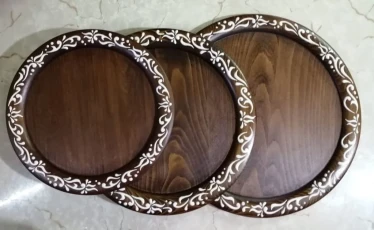
Aliya Alnuami

View of the Orontes River with forested river banks

Conservation of the Aleppo Room in the Museum for Islamic Art, Berlin (before)

Irrigation fields of ʿAyn at-Tina in Qalamun (mountainous region in southwest Syria)
The village itself lies in the middle ground above the level of the irrigated field terraces: In the background, the Eocene limestone layer of the Jebel Maaloula with up to 1913 m above sea level.

Al-Marqab Castle from the inside

Jabla, Mosque of Sultan Ibrahim, Quranic calligraphy

Tower north of Bab Antakiya. The inscription indicates a restoration by the Mamluk ruler al-Malik al-Muʾayyad Shaykh between 820/1417 and 823/1420

Part of fortifications in Ebla (Tall Mardikh)
shap_import_48482

An irrigation canal on the edge of an orchard in the Ghouta of Damascus

Khan al-Jumruk, detail of exterior facade of the khan's entrance

Al-Khusrawiyya, view at the Madrasa courtyard in 2007

A part of Zengid bridge in ʿAyn Diwar

Courtyard of Arwad citadel

Az-Zawiya al-Hilaliyya, one of the pendentives carrying the dome
![[Lanzenreiter] . [The date can be 1913 according to Oppenheim reference: Reisen 1911 – 1939, Bd. 9: Djebel Abd el Aziz 1913]](https://syrian-heritage.org/wp-content/plugins/justified-image-grid/timthumb.php?src=https%3A%2F%2Fsyrian-heritage.org%2Fwp-content%2Fuploads%2F2020%2F04%2Fshap_import_47044-1024x697.png&h=230&q=90&f=.png)
[Lanzenreiter] . [The date can be 1913 according to Oppenheim reference: Reisen 1911 – 1939, Bd. 9: Djebel Abd el Aziz 1913]
![Painting of Euphrates river at Tibne. Dated 15.02.1899 [Original: Euphrat bei Tibne]](https://syrian-heritage.org/wp-content/plugins/justified-image-grid/timthumb.php?src=https%3A%2F%2Fsyrian-heritage.org%2Fwp-content%2Fuploads%2F2020%2F04%2Fshap_import_6692-1024x649.png&h=230&q=90&f=.png)
Painting of Euphrates river at Tibne. Dated 15.02.1899 [Original: Euphrat bei Tibne]

Terraced grain fields on the western slope of the coastal mountain range (Jabal Ansariyya)

Application of the relief paste of a contemporary ‘Ajami decoration

Raqqa - finds discovered in the site "East of Raqqa", the Eastern Complex
Ra O-OK 221 Oil lamp, side-face. [original: 'Öllampe, seitenansicht']. [ 89/53/837] =[ photo's name as: year/ film no./ photo no,].

An irrigation canal in the Ghouta of Damascus

Turbat az-Zahir Baybars, mosaics covering the southern wall of the mausoleum
al-Madrasa az-Zahiriyya [ Description by author: Ecke zwischen ~ West- und Nord-Wand. ]

Bayt Ghazala, courtyard - eastern facade

Habuba Kabira, shell of a dome house made of clay bricks

General view of Qalʿat Salah ad-Din

Al-Madrasa as-Sultaniyya, marble prayer niche

Chinese cloud motifs on the top side of the panel, Aleppo Room wall frame, early 17th century

al-Lajat region, Basalt stone into agricultural area

Khan Qurdbak, courtyard and eastern portico

A side of the Cavea, Palmyra Theater
[ Description by author: rechte Seite. Im Hintergrund ganz rechts der Monumentalbogen, in etwa Bildmitte die Säulen am Eingang der Diokletians-Thermen. Der Bogen und der Bogenansatz ganz links markieren den Südost-Durchgang in die Rundstraße ums Theater. Gesehen nach ~ Ost-Süd-Ost. ]

Al-Madrasa ash-Sharafiyya, entrance with half-dome and muqarnas

General view of the Convent of Our Lady of Saydnaya

Salah ad-Din castle, the upper part of the mosque entrance, lobed arch with muqarnas

Decorated wooden door of the Damascus Room in the Dresden Museum for Ethnology

At-Turn, Double-dome house on the edge of the steppe close to Maskana

The way to the monastery, northwest of Palmyra, Jazil
[ Description by author: zum Fels-"Balkon". ]

The Seljuk watermill ''Bab as-Salam watermill'' from the inside, Damascus

Halabiyya; remains of Basilica and Eastern wall,
[Original: Blick vom Praetorium auf Basilika, Euphrat und Reste der Ostmauer]

General view of Jaʿbar castle on the left bank of the Euphrates

Maronite Cathedral, general view from the outside

Busra - Hammam Manjak - the fountain of the cold section (barrani)

Al-Madrasa ash-Sharafiyya, interior view of lobed dome carried by muqarnas

Jamiʿ al-Utrush, prayer hall

Burj as-Saʿa, spouts of the Qastal

Soap of Aleppo: fresh soap to dry
Interior view from the soap production: a stack of freshly produced soap, arranged with columns in between. So they will stay for several months to dry.

Jamiʿ al-Khayr, western facade from the inside

Naʿurat al-Muhammadiyya (waterwheel), the biggest noria in Hama

Al-Madrasa as-Sultaniyya, the main entrance

Qalʿat al-Qadmus (al-Qadmus Castle), The mosque of Hasan Jalal ad-Din

Remains of the western basilica, Burj Haydar
[Original. Westliche Basilika, Säulenarkaden mit dorischen Kapitellen, 4. Jh.]

Al-Madrasa al-Ahmadiyya, ablutions fountain

Jamiʿ al-ʿAdiliyya, western entrance gate

Jamiʿ ash-Shuʿaybiyya, upper part of the entrance - a cornice with floral motifs and a Qur'anic text in Kufic script

Aleppo Great Mosque, minaret, foundation inscriptions on the base
The minaret of the Great Mosque was commissioned by the judge (qadi) of Aleppo during the rule of the Seljuk dynasty in Syria. The beginning of its construction is indicated in the inscription at the base and the completion date is found at the top: 483 and 489 AH / 1090 and 1096 AD. It existed until 2013. The minaret is a square shape, its shaft is approximately 45 m high and made of limestone. On its upper edge, there is a cornice formed by two rows of flat arched niches lavishly adorned by floral elements. This is topped by an open wooden gallery for the muezzin (prayer caller) and a short tower with cupola. Between the base and the top, the minaret is divided into four zones of varying height. Those are, except for the second one, decorated with blind arches formed by profiled mouldings each running uninterruptedly around the minaret’s shaft. Each zone is separated by friezes with calligraphic, artistically written, Arabic inscriptions. These exquisitely carved inscriptions are written in floriated Kufi – a script style distinguished by bold letters adorned with floral motifs – and in Naskhi script. At the base of the minaret is the signature of the architect Hasan ibn Mufrih al-Sarmani written inside a cartouche. The inscription from the minaret’s base shows that the local Aleppine judge and the Seljuk governor shared power in the city, as their names are mentioned together: “The mosques of God are only to be maintained by those who believe in God and the Last Day and establish prayer and give zakat [(alm-tax); Quran 9:18]. It was started to be built by the High Judge Ibn al-Khashshab Muhammad ibn Muhammad al-Khashshab, may God have mercy on him. In the days of al-Amin al-ʿAjal al-Muzaffar Qasim al-Dawla wa-Nasir al-Mila Abi Saʿid Aqsunqur Bak, the slave of the Commander of the Faithful, may God enhance his supporters”. The upper inscriptions indicate the names of the then ruling Seljuk sultans Malikshah I and Tutush, and of Barakat ibn Faris, commander of the urban militia.

Madrasat al-Firdaws, a view of the courtyard and the southern arcade

Damascus, Khan Asʿad Basha al-ʿAzm, internal view of the portal


Ghouta of Damascus, A grove of vegetables and fruit trees

Bayt Ajiqbash, view of the courtyard interior

Conservation of the Aleppo Room in the Museum for Islamic Art, Berlin (after)

Adult son of the semi-nomadic family in their tent from the Maskana region

Entrance of Khan al-Hallabat
[ Description by author: und Eingang, gesehen von der ~ Südmauer nach ~ Nordosten über den Innenhof. ]

Jamiʿ Aslan Dada, iwan of hall entrance
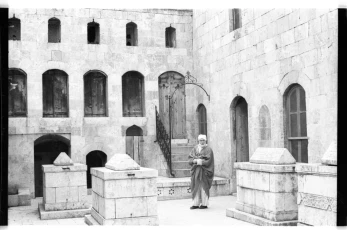
Az-Zawiya al-Hilaliyya, western facade

Bayt Junblat, southern iwan - decoration of marble and faience tiles

View over city, Jamiʿ Halab al-Kabir

At-Takiyya al-Mawlawiyya, western facade - al-Midan

Jamiʿ Sharaf, Mamluk rank

An inscription on the wall of Damascus Citadel

The northern entrance of the historical city of Dura Europos (Qalʿat as-Salihiyya), end of 4th century BC
Main Entrance, Courtyard

A woman presenting her spindle

Remains of the Praetorium, Balis (Barbalassos)

Harran al-ʿAwamid, Hayat bin Qays al-Harani mosque

Remains of the portal frame, Byzantine Cathedral in Qalʿat Burqush
[ Description by author: Sie wurde weitgehend aus Materialien des Tempels errichtet. Dieses Bruchstück hier scheint mir römisch zu sein: Einfassung eines bzw. des Portals. Interessant: sofern die Kirche den Linien der byzantinischen Substrukturen folgte - nach den Plänen ist das der Fall - ist sie nicht richtig geostet, sondern nach ~ Südosten ausgerichtet. Wollte man sparen und die Tempelmauern benutzen ? ]

Exterior view of al-Bab ash-Sharqi (Eastern citygate), the eastern entrance to Old City of Damascus
[ Description by author: [Original: Außenseite, gesehen von ~ Südosten. Vgl. Bild 0323 !] ]

View to the northeast, Monastery of Mar Musa al-Habashi
[ Description by author: in seiner Landschaft. Etwas anderer Standort als Bild 0493, Blick nach ~ Nordosten. ]

Raqqa, Qasr al-Banat, clay decorations

Al-Khabur region, a potter in the workshop, probably in al-Busayri

Afamiya, remains of the colonnaded street (Cardo Maximus)

Dar'a, al-Jamiʿ (mosque) al-ʿUmari - The minaret and the courtyard

Burj al-Ghanam, general view of the tower's west-south corner

A side from Tartus Cathedral - Tartus Museum

Minaret of the Great Mosque of Hama

Al-Matbakh al-ʿAjami, modern and re-used portal (spolia)

Waqf of Ibshir Mustafa Pasha, Coffeehouse, interior
The hall has a rectangular ground plan. Based on a square middle room, it is divided by 12 pillars, all spanned by pointed arches, into 20 compartments of two different forms: two narrow oblong ones each on three sides of the central area (see picture 5) and two smaller square ones each in the adjacent corner areas. The central area is covered by a high dome. Supported by four massive pillars, it rests on muqarnas pendentives – triangular-shaped with tiered rows of geometric cells –, and is topped by a round lantern with small columns plus pointed cupola. The other parts are covered with elongated, flattened vaults and small domes according the respective compartment form.

Jamiʿ ash-Shuʿaybiyya, Building ornaments at the entrance

View of the courtyard of Khan al-Wazir

Khan Qurtbak, eastern arcade

Monastery of St Simeon Stylites, Church of Saint Simeon Stylites

Near Tall Tamir, In a tannur deepened in the ground the flat breads are baked
The Assyrian villages on the Khabur with their domed houses were built by the French Mandate Government for Christian refugees from Turkey and Iraq.

Courtyard and mosque, at-Takiyya as-Sulaymaniyya
[ Description by author: und Innenhof mit Wasserbecken, gesehen von ~ Nodwesten. Links ein Ausstellungsstücke der Armee: irgendeine MIG ....... ]

Raqqa - "East of Raqqa" site - Tall Aswad - finds
Tall Aswad; relief decorated pottery

Archaeological finds from Raqqa, exhibited in the Damascus National Museum
Glazed pottery figure from ar-Raqqa; now in National Museum Damascus; Mus.Nr.5819; Height 46,5 cm

Al-Khusrawiyya, Friday Mosque, 1547

Busra - Jamiʿ (mosque) al-Mabrak

Citadel of Aleppo, Entrance Gateway

Tartus, Qalʿat al-Marqab, Crusader castle, general view from the Castle.

Roman sarcophagus with decorations, Qanawat
[Original: Rechteckige Grabkammer hinter der östlichen Exedra der Basilika: christlicher Sarkophag]

Excavation at Tall al-Biʿa, Ancient city of Tuttul

Bimaristan an-Nuri, view of the western Iwan

Busra, Hammam Manjak, niches in the hot section (juwwani)

Citadel of Aleppo, general view of the Theater

Coffehouse Aslan Dada (vanished)

Busra, Roman Theater

General view of Masyaf Castle

Remains of the Ummayad Palace in Jabal Says

Al-Senaniya Street: General View
[Original:'Straße in Damaskus']. The Bavarian air force division 304b was based in Palestine from 25. October 1917 and was involved in the First World War until the division left the region, over Aleppo, in mid September 1918. During that period, over 3000 glas photographs, mostly aerial, have been made. Those early photographs were important for the archaeological research in the Middle East region.

Raqqa -Qasr al-Banat, clay decorations

The dome hall in the upper floor of Qasr al-ʿAzm (Palace)
Der Kuppelsaal. ['Original: Hamâ (Epiphania),']

Remains of the Byzantine Cathedral, Qalʿat Burqush
[ Description by author: Die Substrukturen von oben. Man steht am Rand des letzten erhaltenen Gewölbes, Blick nach ~ Südosten. Links sind vier Ansätze der Gewölbe-Gurte zu erkennen. Die Kathedrale liegt links außerhalb des Bildes. ]

Great Mosque of Aleppo, courtyard, horizontal sundial

Al-Matbakh al-ʿAjami, the great iwan dome

Bab Qinnasrin (city gate), inscription beside the gate from the outside
On the photo was mentioned: date of creation between 1985-86

Jabal al-ʿArab, a view of volcanic area
[Original: Vulkanit-Aufschluß sü. d. Leja, ö.d. Straße]

Al-Madrasa al-Kamiliyya, interior view of prayer hall dome

Burj al-Ghanam, general view of the facade

A group of camels near as-Sabʿa Biyar, Syrian Desert
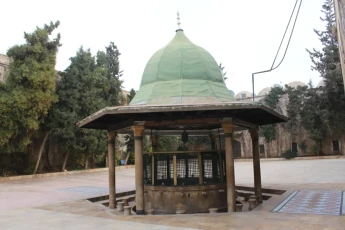
Jamiʿ al-ʿAdiliyya, view of the ablutions fountain

ʿAyn Dara, Bas-relief motif decorating some steps of the main entrance, southern façade of Ishtar Temple

View to the proscenium and scaenae frons of Palmyra Theater
[Original: Theater, 2. Jh. n.Chr.]

Jamiʿ ash-Shuʿaybiyya, west facade - entrance blocked by a wall with a door opening surmounted by an arch
On the photo was mentioned: creation date between 1985-86]

A truck transporting raw cotton bags stops at some bedouin tents in Raqqa-countryside

Al-Matbakh al-ʿAjami, eastern Qaʿa, section north-south, view to east
"Small" qaa, view to east, double window partly reconstructed in drawing. Size of plan 70 x 50, with ruler (no scale).

General view of Safita city

Spools in the textile factory of the Mezannar family

Artificial irrigation, al-Ghab Plain

Raqqa, Raqqa, Bedouin family in their tent
The Bedouin family lived in their tent next to the excavation of the German Archaeological Institute, as they were initially the official guards.

Drawings at the entrance Qasr al-Hayr ash-Sharqi
[Original: Malerei im Tor]

Ithriya Temple - Some archaeological finds

Ornament over a window, Khan Sulayman Basha al-ʿAzm
[ Description by author: Dekor über dem linken Fenster von Bild 0313. ]

Remains of fortifications in Halabiyya-Zalabiyya

Al-Matbakh al-ʿAjami: annex, ground floor plan
Annex building in the north of Matbakh al Ajami, size of plan 50 x 36. Ruler.
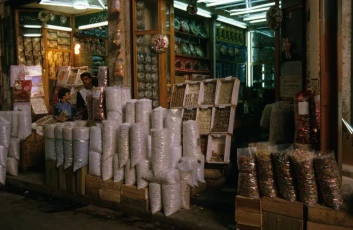
Suq al-Buzuriyya: shops with candied fruit, sugar-coated nuts and other sweets
Shop

Bayt Ghazala, the iwan

General view of Qalʿat Ibn Maʿn (castle)
[Original: mittelalterliche arabische Burg]

Al-Matbakh al-ʿAjami, muqarnas squinches of the iwan dome

Jarada, tower

Jamiʿ at-Tawashi, entrance

View from Qalʿat ash-Shugr wa-Bakas

Qalʿat (castle) al-Qadmus, inscription

Burj as-Saʿa, general view
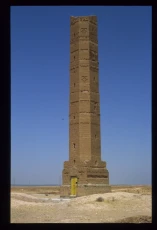
The minaret of Balis Mosque, rebuilt near Maskana

Vicinity of Tall Abyad, shell of the house with flattened domes and opening in one dome

The handles of the main door of al-Madrasa az-Zahiriyya

A view in Wadi Barada

A sculpture of a woman, showing clothes and jewelry details

Amrit, Melqart temple (Eshmoun), central shrine
![Arial view at the citadel. [S.151, Abb.168]](https://syrian-heritage.org/wp-content/plugins/justified-image-grid/timthumb.php?src=https%3A%2F%2Fsyrian-heritage.org%2Fwp-content%2Fuploads%2F2020%2F04%2Fshap_import_50305-1024x697.png&h=230&q=90&f=.png)
Arial view at the citadel. [S.151, Abb.168]
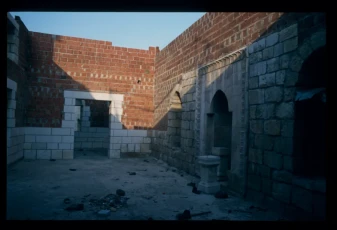
One of the inner parts of the Madrasa al-ʿUmariyya al-Kubra

Busra - Jamiʿ (mosque) Fatima, exterior view

A lateral Iwan at Bayt Jubran Afandi Shamiyya, Bab Tuma
Seitenliwan

Damascus Gate, City Wall of Palmyra
[ Description by author: Gesehen von ~ Südosten. ]

At-Taynabiyya Mosque, the upper part of the entrance is decorated with muqarnas and geometrical decorations
[ Description by author: Dekor. ]

Chinese cloud motifs on the top side of the panel, Aleppo Room wall frame, early 17th century

When milking a flock of sheep in the Syrian Jazira

A shop in al-Qaymariyya, the old city of Damascus, selling salted lupini beans 'termos'

Front view of a Hummus shop

Citadel of Aleppo, entrance of the Throne Hall
shap_import_62017

Al-Matbakh al-ʿAjami, muqarnas squinches of the iwan dome

Damascus, Glass Blowing Workshop near Bab Sharqi
Traditional mouth-blown glass workshops can still be found around the old town today. They started to decline in mid-20th century when industrialized glass manufactures spread.

Busra, Hammam Manjak, the fountain of the cold section (barrani)

Maronite Cathedral, one of the cathedral pointed towers
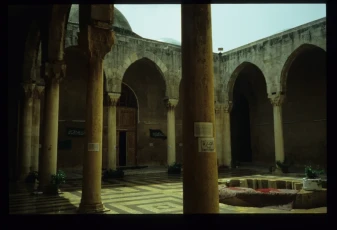
Madrasat al-Firdaws, view to south - courtyard and arcades
Courtyard, Fountain

Bayt Wakil (Aleppo-Zimmer), a scene of a peacock from Wakil house’s wooden panels
Birds occupy the bulk of the woodwork of Wakil house, headed by peacocks with their feathers under the branches of blooming trees.

Afamiya, a side of ruins
shap_import_44111

Suq az-Zarb, general view of the suq, after the destruction, near the Sabil Suq az-Zarb, view towards west

Jurn Kabir, Well on the shore terrace, overlooking the wide flood plain of the Euphrates, which was flooded in the Tishrin reservoir

A side of architectural remains in Tall Mardikh (Ebla)
shap_import_48466

Hadrian’s Arch, 3rd century AD, view from south at the entrance to colonnaded street

Irrigation fields of ʿAyn at-Tina in Qalamun (mountainous region in southwest Syria)
The village itself lies in the middle ground above the level of the irrigated field terraces: In the background, the Eocene limestone layer of the Jebel Maaloula with up to 1913 m above sea level.

Temple of ad-Dumayr from the inside
[ Description by author: Gesehen nach ~ Nordwesten. Man blickt auf die innere Schmalwand mit rechts und links den beiden "Kammern" (deren Rückwand die originale äußere ~ Westwand ist) und in der Mitte dem Durchgang, dessen "Rückwand" die islamische Zumauerung bildet. Vgl. Bild 0384 - 0386 ! ]

Lower part of Temple colomns, Harran al-ʿAwamid
[ Description by author: Wie an der linken Säule erkenntlich, wurde offensichtlich ein Basaltkern mit anderem Material (Kalkstein ?) umkleidet. Ich habe irgendwo auch etwas von nabatäischem Einfluss gelesen: diese Säulen-Umkleidung erinnert u.a. sehr stark an die im Löwen-Greifen-Tempel in Petra. Vgl. Bild 0373 ! ]

A small river in the Syrian coastal mountains (al-Jibal as-Sahiliyya)

Al-Madrasa al-Muqaddamiyya, the marble prayer niche

A Bedouin woman is weaving with a horizontal loom

Al-Madrasa az-Zahiriyya, general view of the entrance

Citadel of Aleppo, main entrance gateway
[Original: Zitadelle, v.a. vom Ayyubiden-Sultan Zahir Ghazi (reg. 1193 - 1215) umgestaltet. Haupttor mit achtbogiger Brücke]

Rumi motifs forming the border of the frame, Aleppo Room wall frame, early 17th century

Raqqa, Northeast Complex

Traditional house in neighborhood "al-Almaji"
Photograph of house's main, southern, fassade during beginning works of refurbishment and after the loss of woodden oriel "Kishk". The image is a panorama composed of several images

Forests in the Syrian Coastal mountains (al-Jibal as-Sahiliyya)
[Original: Ansariyengebirge]

Khan Qurdbak, southern portico - Mamluk rank

Jamiʿ al-Mihmandar, dome of the prayer hall

Turbat Khaʾirbak (mausoleum), western facade - inscription band

Arched window of perforated stucco, al-Bimaristan an-Nuri
[ Description by author: zum Innenhof. ]

A side of Agora
[ Description by author: Gesehen nach West-Süd-West. Ist das hier der Altar, und der Mauerdurchbruch die Nische für das Götterbild / den Betyl ? ]

Raqqa - finds discovered in the site "East of Raqqa", the Eastern Complex, clay decorations

Aliya Alnuami is applying the relief paste on her ‘Ajami-work

Citadel of Aleppo, minaret of the Great Mosque

Raqqa - finds discovered in the site "East of Raqqa", the Eastern Complex
Ra O-OK 221 Oil lamp. [original: 'Öllampe']. [ 89/53/836] =[ photo's name as: year/ film no./ photo no,].

Monastery of St Simeon Stylites, remains of the Column of Saint Simeon the Stylite
St. Simeon is said to have spent part of his life here and perched on a column. The column’s remains are located in the middle of the octogonal central building.

Busra, Hammam Manjak, Islamic Museum

Bayt Ghazala, courtyard - northern facade
View of courtyard and courtyard facade [Original: Privathaus, Innenhof] Pl. Nr. Aufnahme Enderlein, Foto-Verz. Nr. 11030 A 18

Aleppo, Khusrawiyya Complex, siteplan of the building parts (English)
The Khusrawiyya is severely destroyed. The northern arcade and parts of the western wing of the complex are damaged. There are parts which are still under rubble. The degree of damage is around 80%. The center of the explosion crater, produced in 2014, is located beneath the prayer room, i.e. in the domed hall of the Friday mosque, which doesn’t stand anymore. Most likely, the foundations are lost inside the inner area of the crater, while the rest of the area may contain remains of the building, perhaps sufficient for possible reconstruction. No action regarding the protection or management of the rubble has been done yet.

Nomad tents on the outskirts of the Ghuta of Damascus

Shaykh Shibli shrine - al-Tar mountain, south -east of al-Mayadeen

Chest of drawers in traditional inlay technique with mother of pearl in an old house in Maʿlula
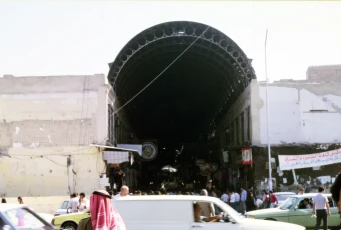
Entrance of Suq al-Hamidiyya in the eighties of the 20th century, Damascus

The courtyard with fountain and Iwan, Bayt Jubran Afandi Shamiyya, Bab Tuma
Bahra mit Liwan

General view of Palmyra city, Diocletian's Camp in foreground
View from Jabal Husainiyya, Diocletian's camp in foreground

Courtyard of al-Jamiʿ al-Kabir showing the treasure dome and the minaret

Assyrian Corner Stairway Trough, Temple of Bel
[ Description by author: "Assyrische Eck-Treppenzinne", von einem der Türme des Tempels (vgl.Bild 0629 !) . Die Struktur ist orientalisch, der Dekor römisch. ]

The Byzantine Tower in Qasr al-Hayr al-Gharbi
[Original: "Heir al-Garbi"]

Ruins of Qalʿat ash-Shugr wa-Bakas on the edge of a mountain slope

Remains of the Great Colonnade

Jamiʿ al-Qayqan, Stone engraving - hieroglyphic pictorial writing

A photo of a residential quarter in the city of Tartus

Al-Madrasa al-Hallawiyya, courtyard and basin

Computer modeling of the Mount Hermon
[Original: Hermon Computeraufn.]

Eastern facade, Jamiʿ Manjak

Khan al-Wazir, general view

Mushabbak, Byzantine basilica, general view from south-west

Jisr ash-Shughur, Qalʿat ash-Shugr wa-Bakas, the ruin of the twin crusader castle

Busra - Jamiʿ (mosque) al-Mabrak, the courtyard

Waqf of Ibshir Mustafa Pasha, siteplan of the building parts (English)
The waqf (endowment) complex of Ibshir Mustafa Pasha has suffered serious damage in several areas. This includes the khan on the north side and the eastern and western qaysariyya. Without removing the rubble, no final statement can be made about the extent of damage. Most likely, there was a total loss in the areas affected by the April 2015 tunnel bomb explosion. The western portion of the waqf complex, including its front facade, is still standing but is noticeably damaged. Two of the most important buildings of the waqf complex of Ibshir Mustafa Pasha survived: the mosque and the coffeehouse at the south. The uniquely decorated facade of the hall of the coffeehouse, as well as its first row of vaults, were destroyed. The core of the hall was only partially damaged, while the section of the central dome with its high lantern was, for the most part, destroyed.

Bridge over the Euphrates, ar-Raqqa
[Original: Euphratbrücke]

A street scene in one of the suqs of Dayr az-Zawr
[Original: Große Orientreise Nr.63 mit Rotel-Tours: Amman-Bagdad-Uruk-Babylon-Arbil-Mosul-Hatra-Samara-Mari-Dura Europos-Aleppo-Dayr Saman-Ugarit-Palmyra-Jarash]

(Bath) Hammam ʿAbd al-Basit - plan

Kitbugha mausoleum on the foot of Qasyun mountain

Cooling bread in the street before storage

A woman showing a woven saddle bag with embroidery

View from afar to al-Mudiq Citadel

At-Takiyya as-Sulaymaniyya, domed arcade and behind it larger domes covering a range of rooms

A traditional house in Jabʿadin

Propylon of Diocletian Baths
[ Description by author: der Anlage. Seine Säulen aus rosa Asuan-Granit überragen das Niveau der Kolonnade (s. rechte Halbsäule / Pfeiler !) und stehen in die Straße vor (hier rechts unten und Bild 0688 !). Den Randsäulen des Propylon entsprechen in der Kolonnade zwei ebenso hohe Pilaster, die wiederum mit je einem Bogen - nur noch die Ansätze erhalten - mit dem restlichen Gebäude verbunden sind. Die Thermen stammen bereits aus severischer Zeit (ca. 200 n. Chr.) und wurden ca. 300 n. Chr. erneuert. Gesehen von ~ Südosten aus dem 2. Abschnitt der Säulenstraße. ]

North-East Syria, Kurdish wedding celebration
[Original: Musikanten bei kurdischer Hochzeit]

Rural life in Qalamun mountains (Antilibanon): peasants returning home from grape harvest

Suq ad-Diraʿ, general view of the suq

Remains of walls in Halabiyya-Zalabiyya

Stucco panels on the walls of an Abbasid building in Kharab Sayyar

Naʿurat al-Muhammadiyya (waterwheel), the biggest noria in Hama

Dayr Zakka (monastery), floor mosaic in the sanctuary, 595 AD
Raq19920015.tif

The northern entrance of the historical city of Dura Europos (Qalʿat as-Salihiyya), end of 4th century BC
Außenseite, frontal von ~ Südwesten. Vgl. Bild 1614 !

Jamrin - The ancient bridge over Wadi az-Zaydi

Jamiʿ al-ʿAdiliyya, prayer hall's entrance - inscription documenting the date of building accomplishment

At that time the Bedouin tent was in the village ad-Duwaym in Nahyat al-Yarabiyya
The family belongs to the famous old Tayy-tribe.

ar-Rusafa, general view of Basilica B, cisterns and city wall

Archaeological finds from Raqqa, exhibited in the Damascus National Museum
Capital; National Museum Damascus; Mus.Nr.1866 from ar-Raqqa

Jamiʿ as-Saffahiyya, entrance

Bayt Wakil, entrance

In the courtyrad of the Umayyad Mosque - view to al-ʿArus minaret and northern arcade

Khan Qurdbak, entrance

ʿAyn Dara Temple, Colossal basalt lion

Great Mosque of Aleppo, courtyard with fountains, minaret, northern and western arcades

Palmyra, general view of the Tetrapylon
[ Description by author: Gesehen von ~ Süden aus dem Gelände zwischen Agora und Tetrapylon. ]

In the tent of a Bedouin family with the living area in the foreground and behind the partition the storage area of all goods

Shaykh Shibli shrine - al-Tar mountain, south -east of al-Mayadeen

Agriculture in the Coastal Mountains (al-Jibal as-Sahiliyya)
[Original: Bewässerte Zitruspflanzung im Vorland d. Ansariyengebirges]

Al-Madrasa al-Hallawiyya, entrance - a stone base (spolia) which is the cathedral baptismal font

General view of Tall Mardikh (Ebla)
shap_import_48497

Peasants returning home from work in their palm grove passing by Bel temple
View along north western corner towards the oasis

Khan al-Hibal, the stairs leading to the upper floor

Entrance of Hammam ʿAbd al-Basit
The entrance, leading to the external section (barrani), is one of the most beautiful entrances of Islamic baths. It was built according to the Ablaq masonry system, with stone rows alternating between white, gray and blue colors. This entrance is a retreat in the façade, topped by an ornate arch from the outside. The lower part of the dome of the barrani section is composed of many windows. This building is vanished nowdays!

Architectural Ummayad vestiges in Jabal Says

Raqqa, Palace D, stucco decorations
Palace D; Inst.Neg. 86/1428 Floral frieze decoration

The altar of Nabu Temple, Palmyra
[ Description by author: ~ Süd- und ~ Ostseite, dahinter die Stufen vom Aufgang des Podiums des Tempels. Die Reliefs sollen Gottheiten darstellen. ]

A view from the courtyard of Khan Murad Basha (Museum of Maʿarrat an-Nuʿman)
shap_import_74303

Production of a contemporary ‘Ajami decoration in a Syrian workshop
Mohammad Haj Qab decorates the arch of the Syrian embassy in Bonn in 1992

al-Madrasa al-Hallawiyya, northern facade - marble plaque dated 1315 AH and sealed by the Sultan ʿAbd al-Hamid Khan (Tughra)

as-Saray al-Kabir, a view of the plaza in front of Aleppo citadel’s entrance
A picture taken before the war from as-Saray al-Kabir that shows the plaza opposite the entrance of the Aleppo Citadel. This square is furnished with basalt and limestone tiles and palm trees

View of the town of Halbun in the 1960s with gardens

Ruins of Qalʿat ash-Shugr wa-Bakas on the edge of a mountain slope

Dar'a, al-Jamiʿ (mosque) al-ʿUmari - the prayer hall

Jamiʿ al-Maydani, the minaret

Madrasat al-Firdaws, details of lobed octagonal basin

Afamiya, the Ottoman Khan below Qalʿat al-Mudiq (al-Madiq castle)

Qalb Lawza, Basilica 5th c., view of main facade from south-west
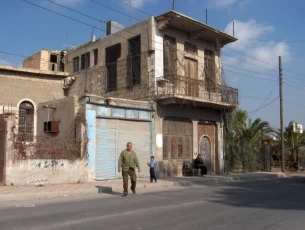
A two-story building in a village in Ghuta
It is hard to tell the exact date of this building, but it is clear from its architectural style that it dates back to the beginning of the second half of the 20th century.

Traditional production of animal glue

Damascus, Glass Blowing Workshop near Bab Sharqi
[Original: LEAD Technologies Inc. V1.01]

Busra, the Roman theater stage is surrounded by the Islamic citadel
On the photo was mentioned: date of creation between 1985-86

Monastery of St Simeon Stylites, one of the church apses

Village alley in the Balikh region with calf and goats

Raqqa, Qasr (Palace) al-Banat, an octagonal basin in the centre of the courtyard

View on the Euphrates River from the site of Dura Europos (Qalʿat as-Salihiyya)

Afamiya, a side of ruins

Great Mosque, prayer hall, main entrance in 2006
Main entrance of the prayer hall with pointed arch and ribonwork from coloured stone marquetry and a restoration inscription above the door arch

Habuba Kabira, in the courtyard clay bricks are lying out to dry

Bimaristan Arghun, general view of the southern courtyard

The entrance into the castle of al-Marqab is framed by a stepped portal

Tall Dahab, Woman carrying firewood

Mosaic of the sea goddess "Thetys", Shahba Museum

The damage of the minaret

Jamiʿ al-Mihmandar, courtyard - inscription on the northern facade

Raqqa, al-Jamiʿ al-ʿAtiq, Remains of the southern arcade from the inside

Entrance of a hall in the religion complex of Mnin.
[ Description by author: Die große Halle und ihre Freitreppe, gesehen von ~ Westen. ]

The main mihrab, which has mosaic in its dome. The space is 02 in general, according to the ground plan. Here wb.01 of the secondary space 07. is seen.

A group of domed houses in the village of Shaykh Hilal
In this scene, the workers coat the domes with mud as part of the restoration and maintenance work. These three domes seem to belong to one house.

Graves carved into the rocks, ʿAyn as-Sahib
[ Description by author (German): Links oben wohl entweder ein Felssaal ähnlich dem in ('Ain) Manîn (s. Bild 0397 und 0402) oder ein Grab mit zerstörter Fassade. In der Bildmitte ganz unten ein recht verwittertes Grab des Ädikula-Typs ähnlich dem von Bild 0411 - 0413. ]

A concrete irrigation canal in the Ghouta of Damascus
As cement became as an easy-to-use building material, farmers began building irrigation channels using that material. The concrete canal in the picture seems to be missing the aesthetic element, unlike the old canals that were corresponding to the surrounding environment.

at-Tabqa, Jaʿbar Castle, Towers of western walls

A side of al-Mudiq castle

Bayt Wakil, iwan

Exterior view of Hammam al-Qaramani, dome of frigidarium (barrani)
[ Description by author: Süd- oder West-Seite. Vgl. Bild 0139 ! ]

Bab al-Maqam in Aleppo, general view

Qanawat, women in traditional dress at a well

Damascus, Khan Asʿad Basha al-ʿAzm, upper view of the inner courtyard and its fountain in the center

South Temple in ʿAtil, remains of the main façade (partially distorted at present by the transformation of the building into a residence)

A door of room beside the Iwan of Quwatli House
Liwan. Seitentür

As-Sabuniyya Mosque, the body of the minaret is rich in decorations
[ Description by author: Fenster-Etage oberhalb des Sockels. ]

Temple of Mushannaf, southwest corner, pilaster capital

Citadel of Aleppo, Maqam Ibrahim - inscription in the courtyard

Jisr ash-Shughur, Qalʿat ash-Shugr wa-Bakas, a twin crusader castle, Arabic inscription

Khan al-Hibal, the southern facade from inside

View from the top towards the oasis and the ruins of Palmyra
[ Description by author: Ganz vorn unten ein Stück der Stadtmauer. Hinten das Areal des Bel-Tempels, vgl. Bild 0811 ! Ganz rechts, hinter der Mauer, ein Teil des Hotels Sham Palace. Blick nach ~ Osten. ]

Damascus, Propylaea of Jupiter Temple, 1st CE. AD
The west gate of the Jupiter Temple lies in the middle of the historic old town. Today it marks the transition between the bazaar area and the Umayyad Mosque.

Al-Mudiq Castle sits on a large hill

Palmyra, view from the south, valley of tombs in foreground, Qalʿat Ibn Maʿn in background

Khan Qurtbak, southern part of Khan - the inner courtyard and the iwan of the Mamluk palace

Raqqa, Baghdad Gate, geometric decorations in the niche, built with bricks

Jaʿbar Castle, Minaret of the mosque

Capital of a column- Temple, Harran al-ʿAwamid
[ Description by author: einer der drei Säulen. Zumindest auf zwei Seiten ist es sehr gut erhalten. Vgl. Bild 0373 ! ]

Madrasat al-Firdaws, lobed octagonal basin in the centre of courtyard

Al-Madrasa al-Hallawiyya, iwan

Afamiya, Remains of Great Colonnade (Cardo Maximus)
shap_import_70674

View of al-Marqab castle overlooking the Mediterranean Sea

Aliya Alnuami is experimenting with new ways of painting and decorating ‘Ajami work

Aleppo's Great Mosque, renovation of the north entrance in 2018
Destroyed and damaged parts of the north portal are scaffolded for restoration

The prayer hall, Umayyad Mosque
[ Description by author: Blick aus der Nordostecke durch die Osthalle nach ~ Südwesten. Hinter den Säulen der Pavillon mit dem Kopf Johannes' des Täufers. ]

Habuba Kabira, how three cantilever domes are connected (two cantilever domes are posed on a relieving arch)

Jamiʿ al-Qayqan, main entrance

Cathedral of Busra from the inside
[Original: HQ-k.9 Interior view, Arch]

View of Orontes valley

Hammam Yalbugha an-Nasiri, plan

Afamiya, columns in the ruins
shap_import_44106

Making pickles

Khan Qurdbak, decoration details above a window in the iwan

Aleppo countryside, Dome houses
Trulli house

Qasr Asʿad Basha al-ʿAzm, courtyard and arcade
The palace of the governor’s family al-‘Azm houses today a Museum of Arts and Popular Traditions.

Jamiʿ Aslan Dada, courtyard with a rectangular basin

Nahiyat at-Tabqa, Euphrates Dam

Jisr ash-Shughur, Qalʿat Shugr wa Bekas from the inside.

Suq ad-Diraʿ, general view of the suq

Suq az-Zarb, general view of the suq after the destruction, view towards east

Khan al-Wazir, main entrance
[Original:'Khân al-Wazîr, Halab / Aleppo. Er stammt aus dem Jahre 1682. Hier die Außenfassade. Vgl. Bild 1250 ! Ob sie wirklich auf der Westseite der Anlage ist, ist mir nicht (mehr) ganz klar, aber die Beschreibung im Guide Bleu "Middle East" (Eingang an einem kleinen Platz mit Moschee am Ende) macht es wahrscheinlich.'].

The view of a wall in Shayzar Castle shows three tipped arched niches, each with an entrances and a window.

Bridge over the Euphrates, ar-Raqqa
[Original: Euphratbrücke]

Bimaristan Arghun, main courtyard - capital decorated with muqarnas

Dar'a, al-Jamiʿ (mosque) al-ʿUmari - Inscription on the eastern arcade

A central passage in the Castle of Harim

Maronite Cathedral, the sanctuary

A view from the archaeological Tall Abyad towards the Balikh plain

Bayt Ghazala, courtyard and western facade - main hall's (qaʿa) facade
Hof mit Bahra und Qa'a-Front

Courtyard of the monastery of Mar Musa al-Habashi
[ Description by author: Innenhof, rechts die Kirche.- Das Kloster geht auf Mönchsgrotten in der Umgebung aus dem 6. Jh. zurück, die ältesten Gebäudeteile stammen aus dem 10. Jh., die Fresken (vgl. Bild 0480 - 0490 !) - in drei Lagen übereinander ! - aus der Zeit bis zum 15. Jh.. Gegen Ende des 17. Jh. wurde das Kloster verlassen. Sein Patron soll der Sohn eines äthiopischen Königs sein und das Kloster gegründet haben. ]

Ghuta of Damascus, aerial photograph of some orchards
Farmers in the Ghouta of Damascus have adopted a dense and mixed farming pattern of diverse vegetables, fruits, trees and aromatic plants. The residences are placed in the orchards.

Takiyyat ash-Shaykh Abu Bakr, muqarnas decoration on the prayer niche

Raqqa, a side of Qasr al-Banat

Manbij, Vegetable and fruit vendor in the centre

An agricultural field and poplar trees in Yabrud

View of several buildings inside al-Marqab castle

Jamiʿ (mosque) ash-Shaykh Muhyi ad-Din Ibn ʿArabi, seen from Friday's suq
Photos near al-Jami' as-Salimi, Nr.50

Mari (Tall al-Hariri), The Archive Hall in the Palace of Zimri lim

A side of the Salah ad-Din Castle

The right part of the sacred complex gate, Mnin
[ Description by author: Der Zugang: rechter Teil eines Tores zum heiligen Bezirk.- Wenn hier und bei den folgenden Bilder "Römisch" angegeben ist, soll damit nur gesagt werden, dass die Anlage in heutiger Form zu dieser Zeit entstand und die Formensprache der "Reichskunst" benutzt wird. (The date of this photo was not sure as Peter Heiske did [(wohl) 08/05/1999)] ]

Jamiʿ al-Mihmandar, minaret
The minaret is of the Anatolian style, with a square base, octagonal drum, and cylindrical shaft ornamented with zig-zags and blind arches. It dates to later in the 14th/8th century and was not constructed as part of the original mosque. the minaret reconstrued in 1946.(archnet.org) The minaret had suffered severe damage during the conflict in Aleppo (2012-2016) and eventually collapsed.

Bayt Junblat, southern iwan - marble decoration

View from afar to the Arch of Triumph (Qaws Hadrian)
[ Description by author: Exedra des 1. Abschnitts der Säulenstraße, Monumentalbogen und 2. Abschnitt, Burg, gesehen von ~ Südosten. Die sehr hohen Säulen der Exedra sind aus - vermutlich ägyptischem - Granit, nicht aus dem lokalen Kalkstein. Der Abstand der beiden Mittelsäulen ist etwas größer als der zwischen Mittel- und Außensäulen.- Im Plan in G. Degeorge "Palmyra" steht an etwa dieser Stelle "Nymphäum" - ? ]

Upper part of the western facade, Maʿbad ad-Dumayr (Temple)
[Orignal: Wasserheiligtum, Dreiecksgiebel über Schmalseite]

Bayt Ghazala, 17th c. ground floor plan
The only private house that includes a private bath (hammam) and six courtyards. It suffered structural damages and the loss of unique interior decorations (ʿajami).

Application of the relief paste of a ‘Ajami decoration
Ziad Baydoun in his workshop in Malaysia

Coffehouse Aslan Dada (vanished)

Busra, Part of the citadel wall

The tower of Qalʿat Yahmur (Yahmur Castle)

The gate of south-western side, Dura Europos (Qalʿat as-Salihiyya)
Gate of south-western side [Original: "Salihiyyah, Tor der Südwestseite"]

The apse of eastern cathedral, Afamiya

Khan Qurdbak, iwan, first floor plan
First floor with iwan [22], size of plan 60 x 40 . with ruler (no scale ).

Turbat Khaʾirbak (mausoleum), western facade - niche with trefoil arches

The Baths of Diocletian
[ Description by author: - aber was sollen dann die Säulen vorn ? Im Hintergrund der mittlere Abschnitt der Säulenstraße, die Bögen markieren den südlichen Eingang in die Rundstraße ums Theater. Die Außenseite von dessen Scaenae Frons erkennt man rechts hinter den Säulen. Gesehen von ~ Nordosten. ]

Fishing in the Euphrates, Jabal ʿAruda

A side of the city remains, Ugarit
shap_import_74034

Village on western shore of Jabbul-Lake, dome houses with stone inlay on the top

At-Takiyya al-Ikhlasiyya (az-Zawiya ar-Rifaʿiyya), details of the hall facade situated on eastern side of the courtyard

Ceiling of the prayer hall, Umayyad Mosque
[ Description by author: Ein Stück Decke, vermutlich ijm Transept. ]

Jamrin - The ancient bridge over Wadi az-Zaydi

General view of Damascus citadel from northwest
The two rectangular towers that protected the citadel from the west appear clearly in the picture. Hidden behind the bushes, is the statue of Salah al-Din riding his horse.

Muzayrib - Ancient mill
Khan

Bayt Junblat, section drawing of the northern iwan
Small iwan in the north of the courtyard. Size of plan 50 x 20, with ruler (no scale).
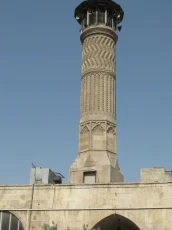
Jamiʿ al-Mihmandar, minaret

Al-Madrasa al-Hallawiyya, wooden prayer niche in the iwan

Raqqa/Rafiqa, Wall decoration in the Iwan of Qasr al-Banat
[Original: Detail vom Palast Iwan/ nach Sarre-Herzfeld]


Bayt Junblat, southern iwan - decoration of faience tiles
[Original:'Qasr Jumblât, Halab / Aleppo. Dekor in der Wand oberhalb der Tür von Bild 1303.].

Great Mosque of Aleppo, courtyard, vertical declining sundial
shap_import_60568

View to the east, courtyard of Jamiʿ an-Nuri (mosque), Homs
The courtyard of the mosque: to the left is the riwaq (arcade hall), opened to the north, and to the right the northern facade of the courtyard.

Afamiya, The Great colonnade (Cardo Maximus)
shap_import_70671

Raqqa - "East of Raqqa" site - Tall Aswad, excavation in 1985
[1985/72/977] = [photo's name as: year/ film no./ photo no.]

The courtyard of an-Nuri Mosque

People gathering near a government office, Raqqa

Wakil house, courtyard

Afamiya, a side of ruins

Maʿbad ad-Dumayr (temple), locally known as "the castle"

Artificial field irrigation and drinking water supplies, al-Ghab Plain

View from a far to the basilica in Kharab Shams
Säulenbasilika, 4. Jh. von weitem

Three burial tombs in the rocks, northwest of Palmyra, Jazil
[ Description by author: Ganz "klassiche" Anlage mit Anordnung der drei "Särge" als Triclinium. Die sorgfältige Ausführung spricht für "bessere Leute": für den Abt (die Äbte) oder gar den Gründer des Klosters ? Vgl. Bild 0907 ! ]

Al-Madrasa al-Ahmadiyya, inscription and decoration above the entrance of the prayer hall

The sanctuary (cella) of Bel Temple
[Original: Baal-Heiligtum, Cella, ca. 17 - 32 n.Chr.]

Citadel of Aleppo, Temple of the Storm God Hadad - Detail on platform wall
[Original: Ausgrabung Kai Kohlmeyer]

A room cladded with ‘Ajami decoration in a Damascene house
shap_import_97591

View from the Zayzun waterfalls into Yarmuk river, which there the border between Syria and Jordan

Citadel of Aleppo, entrance gateways and bridge

A Jacquard-loom in the textile factory of the Mezannar family in Damascus

Excavation work, Madinat al-Far

Euphrates dam and Assad Lake in at-Tabqa

Tall Bdiri near the Khabur: pilasters are stabilizing the walls of the houses

Khan al-Jumruk, general view showing the mosque's dome and the internal facade of the Khan's entrance

Remains of a house, Qarqbiza

Qalʿat al-Marqab (Castle), Central courtyard and chapel

Aleppine Soap
The picture shows a section of the cubed laurel soap bar after drying. It is green on the inside.

Maize field adjacent to the houses of Mishrifa village on top of the city wall of Qatna

Monastery of St Simeon Stylites - Jabal (mountain) Samʿan

Mud bricks, prepared for the restoration of ar-Raqqa Wall

Maronite Cathedral, the nave

Al-Madrasa al-Hallawiyya, main entrance

View to northeast, Qalʿat Ibn Maʿn
[ Description by author: Blick nach ~ Nordosten. ]

A side from the ruins of Halabiyya-Zalabiyya

al-Matbakh al-ʿAjami, ground plan drawing before the partial demolition
Reconstruction drawing of the intact palace before the partial demolition in the southern part (plot VII-3-1 2057 in today's borders), with additionally drawn in cadastral level, for its extension on different plots. Based on a partial survey of the Antiquities Administration (DGAM).

Apse of basilica, al-Bara
![[S.156 Abb.170]](https://syrian-heritage.org/wp-content/plugins/justified-image-grid/timthumb.php?src=https%3A%2F%2Fsyrian-heritage.org%2Fwp-content%2Fuploads%2F2020%2F04%2Fshap_import_48714-1024x697.png&h=230&q=90&f=.png)
[S.156 Abb.170]

A photo of villagers in front of traditional building under construction, Raqqa

Busra, Birkat (pond) al-Hajj and Abu al-FidaʾMosque
During the rainy saison the pool is filled until today with water.

Jamiʿ Sharaf, inscription on the wall of Qastal

Bayt Jubran Afandi Shamiyya, now the Riʿaya private school, Bab Tuma
Tarma. Innen

Restaurant with terrasse and fountain in Mnin

East side of the old suqs.

Jamiʿ Sharaf, Qastal

Entrance of al-Imam Ismaʿil Mosque, as-Salamiyya
zum Gebetssaal - s. die Schuhe ! Er erinnert an mittelalterliche Kirchen - für eine gotische fehlt nur ein richtiger Tympanon ... Es ist mir aber nicht bekannt, dass die Moschee auf der Stelle einer Kirche errichtet worden wäre. Dennoch scheinen mit die "Kapitelle" rechts und links nicht islamische Kunst zu sein, der Türsturz, bei dem man gleich an eine Spolie denkt, trägt eine arabische Inschrift - er könnte aber gedreht worden sein .......- Da ich nicht mehr weiß, ob dieser Eingang sich auf der West-, Süd- oder Ostseite der Moschee befindet, habe ich keinen GPS-Tag gesetzt. Es gibt noch ein weiteres Problem: ich könnte mich irren, und dieses und das nächste Bild sind nicht von der Jâmi' al-Kabîr, sondern von der Masjid al-Imâm Ismâ'îl ! Dann wäre der Eingang im Norden oder Süden. [Original: 'Salamiya (Salamias)']

Busra, Decumanus maximus looking west from the nymphaeum

Raqqa - "East of Raqqa" site - Tall Aswad, excavation in 1985
Tall Aswad

Excavation work at Tall Afis

Raqqa, Western Palace, aerial view of excavation site
The aerial picture shows how the site looked during its excavation. At the edge of the excavation site, clay bricks are laid out for drying. [Original on the back: '86']

General view showing the remains of city wall on the right
[ Description by author: In der Mitte das Tempelgrab, ganz rechts ein Turm der Mauer, dahinter Säulen vom 3. Abschnitt der Säulenstraße, links oben die Burg. Blick nach ~ Norden. ]

A boat trip in the Euphrates, near Jabal ʿAruda

Al-Madrasa ar-Rukniyya al-Barraniyya - view from the south

Al-Madrasa ash-Sharafiyya, the entrance from the interior

Colored mosaic in the western arcade of the Umayyad Mosque

Raqqa, the inner façade of Baghdad Gate (Bab Baghdad)
Raq19830039.tif

The main mihrab of the mosque with mosaic decoration. The space is 02 in general, according to the ground plan. Here the mihrab in secondary space 07 is seen.

Maʿlula, St.Tekla Convent during the Holy Cross feast on september 14th

The sanctuary (cella) of Bel Temple
[Original: Baal-Heiligtum, Cella, ca. 17 - 32 n.Chr.]

Al-Madrasa al-Hallawiyya, entrance - Zengid inscription in Naskhi script

Jamiʿ at-Tawashi, eastern facade - window within a rectangular niche decorated with muqarnas

Tall al-Biʿa - Aerial photograph

View of the Orontes River with rapids

Al-Madrasa al-Hallawiyya, entrance - a stone base (spolia) which is the cathedral baptismal font

Tomb tower of Elahbel in the Valley of the Tombs
[Original: Grabturm in Palmyra]

View from the palm groves to the south-eastern corner of Bel Temple

Al-Madrasa al Kamiliyya, Iwan of the courtyard

Traditional dish served in a village, at-Tabqa

Raqqa - "East of Raqqa" site - Western Palace
Raqqa V; West Palace, s.SW-Neg.86/1252

Qasr Ibn Wardan seen from the south

Remains of vaults in Halabiya-Zalabiya

Raqqa - Glass discovered at the site "East Raqqa" - the northern complex
Northern Complex; glass jar (fragmented)

Turbat Khaʾirbak (mausoleum), western facade - inscription band

Rastan, Urban agglomorations on ridges

Jamiʿ Aslan Dada, interior view of the prayer hall (qibliyya)

Remains of Qasr Says or the palace of al-Walid in Jabal Says

Monumental Arch and Colonnaded Street in Palmyra

General view of Jabal Haramun (Mount Hermon)

Remains of wall foundations, Kharab Sayyar
[Original: SW-Burg]

Damascus, Khan Asʿad Basha al-ʿAzm, dome on pendentives

Husn Sulayman, Cella of the temple

Ruins of Qalʿat Maʿarrat an-Nuʿman

View of the Khabur River with willow-trees in the 1960s

During a sandstorm this photo was taken from the museum to the backside of the suq in Dayr az-Zawr
View during sandstorm, photo taken from the museum to the backside of the suq

View to the Proscenium of Palmyra Theater, 2nd c. AD

A side of excavated building in Tall Mardikh (Ebla)
shap_import_48438

The southern tower of Qal‘at Shayzar

Bayt Ghazala, ʿajami wall panels decorating the main hall (qaʿa)

Jamiʿ al-Utrush, western facade- decoration on the top part of a window niche
A top part of a window niche framed by double muqarnas plates and carved serrated border
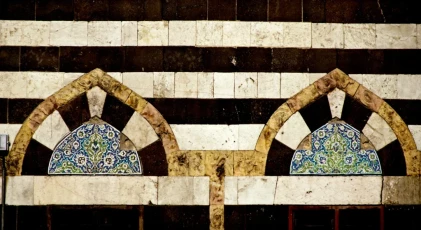
Damascene painted tiles over the windows, as-Sinaniyya Mosque
[ Description by author: Detail: Lünetten mit bemalten Kacheln über den Fenstern. ]

View of Masyaf Castle

A building under construction in the President's Square in Raqqa

Çintamani motifs, Aleppo Room wall frame, early 17th century

Al-Madrasa al-Muqaddamiyya, an inscription above the entrance gate
shap_import_65984

Jamiʿ Aslan Dada, interior view of the hall dome

Shahba, Women in traditional dresses doing the laundry

Remains of an entrance, Diocletian Baths
[ Description by author: in oder bei den Thermen. Da nur die Türrahmen in sehr verwittertem Zustand (Kalkstein !) übrigblieben, erinnert das Bild an Dolmen ....... Im Hintergrund der Monumentalbogen von innen. Der GPS-Tag ist approximativ ! Gesehen von ~ Nordwesten. ]

Irrigation canal near Baniyas
[Original: Bewäserungkanal im Küstengebiet des Raumes Banias]

Al-Madrasa al-Kamiliyya, prayer hall

Al-Madrasa al-Hallawiyya, entrance - Zengid inscription in Naskhi script

Raqqa, Qasr al-Banat, clay decorations

Watermill on ʿAyn al-ʿArus lake

The western entrance of Maʿbad (temple) ad-Dumayr
[ Description by author: ~ Westseite. Sehr schön ist der in islamischer Zeit zugemauerte und mit einer Schießscharte versehene Eingang zu erkennen. Vgl. Bild 0380 ! ]

Jurn Kabir, wall shelf on which metal plates, cups and spoons are presented

Raʾs al-ʿAyn, view from the garden to the late Ottoman house, situated on a slope
The house consists of three wings with an Iwan in the middle (now reduced to a door) and is generally oriented to the valley in the south. The house opens to a large terrace with an Iwan in the middle and is accesible from the street on the western narrow side - not visible on the photo.

A staircase was leading up to upper floor at Royal Palace G, Ebla (Tall Mardikh)
shap_import_48446

Remains of an ancient minaret in Khirbat as-Sarayij

A view from the Castle toward Harim city

The bronze Telegraph Column at al-Marja Square

A view of al-Marqab castle from the bottom of the hill

Valley of the Tombs, Tomb of Jambliku - decoration of the door lintel
[ Description by author: Linke Volute vom Türsturz, gesehen von ~ Osten. ]

Suq Aslan Dada, rebuilding of northern entrance, view towards south

A traditionally crafted tapestry weave

View from the monastery entrance, northwest of Palmyra, Jazil
[ Description by author: Blick etwa vom Klostereingang. Zu sehen ein Wasserkanal und hinten rechts davon ein Becken, vgl. Bild 0896 ! ]

The Monastery of St Sergius, Maʿlula

Afamiya, the colonnaded axis (Cardo Maximus)

Camel and its guide on sacrophagus
[ Description by author: Kamel und sein Führer. Die Darstellung befindet sich vermutlich unter einer Kline.- Ob dieses Bild ebenfalls zum Sarkophag Bild 0873 - 0877 gehört, kann ich nicht mehr sagen. ['26/03/2002 (?)'] ]

Jamiʿ as-Saffahiyya, muqarnas decorating the upper part of the entrance

ar-Rusafa, Goat hair tent erected for a funeral service

Al-Madrasa as-Sultaniyya, entrance - stone carved Arabic inscriptions

The enjoyment of sulfur water in Afqa Spring
[Original: Efqa-Quelle in Palmyra, 2002 od. früher versiegt]

Junblat house, the southern iwan decorated with marble and tiles
The summer iwan belongs to a residential large house with several courtyards and opens to one of them. It is lined with ceramic tiles. Parts of the complex were damaged during the war.

Remains of walls and pillars, Mari (Tall al-Hariri)

Umayyad mosque - Qaytbay minaret, rich in decorations

Busra - Masjid Yaqut (mosque) - founding inscription

Dayr Zakka (monastery), floor mosaic of the narthex
Mosaic from monastery Dayr Zakka, upon Tall Bi'a; 86:22, Raq19900047.tif

Bayt Ghazala, courtyard - northern facade

Suq al-Hamidiyya
Seller of traditional refreshing drinks in the city's most famous bazaar. It was built at the end of the 19th century in the European style.

The nord thalamos in the cella, Temple of Bel
[ Description by author: Cella: Nord-Thalamos für die Götter-Triade Aglibol (Mondgott) - Bel (oberster Himmelsgott) - Yarhibol (Sonnengott). ]

Damascus, copper workshop in the Straight Street, where "damascening", an old Inlay-technique is still practised

Al-Madrasa al-Ahmadiyya, dome of the prayer hall

Al-Madrasa as-Sultaniyya, marble prayer niche

al-Husn Church, Remains of the basilica after its demolition and turning the site into an agricultural field

A mechanical loom in the textile factory of the Mezannar family in Damascus

Tourists with a local resident at the Peak of Mount Hermon (Jabal Haramun)

A side from historical Qalʿat Masyaf

Suq Aslan Dada, general view of the suq damages, view towards south

Monastery of St Simeon Stylites, the baptistery
[Original: Baptisterium mit oktogonalem Zentralraum]

Aghabani table cloth

Turbat Khaʾirbak (mausoleum), Mamluk Rank

Jurn Kabir, wooden door bar lock, seen from the interior side

Dayr Zakka (monastery), porch (narthex) of the church with mosaic floor, 6th C.
This mosaic dates back to 509 AD. [von 509 n.Chr.]. [Kalla (1999) 134]: [Gabor Kalla: Christentum am oberen Euphrat. Das byzantinische Kloster von Tall Bi'a. in: Antike Welt 30/2 (1999)].

Archaeological finds from Raqqa, exhibited in the Damascus National Museum
Floral frieze decoration; Palace D, ar-Raqqa; National Museum Damascus

Habuba Kabira, construction of a relieving arch using piled bricks, which are later removed

Khan Qurdbak, dome of the entrance

at-Tabqa, Jaʿbar Castle, polygonal tower.

Stone coffins in the Southern Palace, Ebla (Tall Mardikh)
Wie Bild 1175, diesmal nach ~ Osten gesehen. Man beachte die "Becken" (Särge ?) zwischen den Orthostaten. [Original:Tall Mardîkh (Ebla)']

Tall Bdiri, Farmsteads, that have no enclosure walls

Takiyyat ash-Shaykh Abu Bakr, the inner entrance

The suspension bridge over the Euphrates in Dayr az-Zawr

A shepherd with his herd on the arch bridge which leads to Shayzar Castle

The northern entrance of the historical city of Dura Europos (Qalʿat as-Salihiyya), end of 4th century BC
in der Westmauer, gesehen von ~ Nordwesten.

Excavation of mosaic floor, ʿAyn al-ʿArus

Qanawat, Rural house

Izraʿ, al-Jamiʿ (Mosque) al-ʿUmari - the courtyard

Habuba Kabira, entrance side of a room half deepened into the grown soil (in local dialect: debabe)

Northern towers from inside the North Gate, Halabiyya-Zalabiyya

A field in a village nearSafira in Aleppo province

shap_import_61326

Tall Shaykh Hamad (Dur Katlimmu) - Excavations

Hubert Mezannar, son of Antoine Elias Mezannar. In the background is the certificate of a gold medal, the family won in 1936 on Damascus International Fair.
At the beginning of the 20th century, Antoine Mezannar brought mechanical looms from Lyon with electric motors to Damascus and became one of the first consumers of electricity in Damascus.

Jamiʿ ash-Shuʿaybiyya, public fountain (sabil) beside the main entrance

A view in Wadi Barada

View of the Madrasa al-ʿUmariyya al-Kubra from the inside

Palmyra, Palm grove, view at Bel Temple

Bimaristan Arghun, octagonal courtyard - view of dome pendentives

Inscription on the Damascus wall

A view of the fortification, Halabiyya-Zalabiyya

Tower north of Bab Antakiya, a side of the defensive tower after the removal of infringements

Al-Madrasa al-Muqaddamiyya, a groin vault in the entrance
shap_import_65982

Remains of the western gate of the temple of Jupiter

Jamiʿ al-Utrush, tomb - interior view of the dome damages
An upward view of the overall roof structure, a stone dome, elevated on a dodecagonal drum, and below, bent squinches made of muqarnas (stalactite forms) in transition to the quadrilateral form on pointed arches. Missing elements on north part of the drum; a hole of 2m dia., and loose elements/ cracks in the dome stonework construction

Khan Ujkhan، main entrance

Part of Damascus City Wall to the east of the city


Face sculpture, Zenobia Hotel
[ Description by author: Eingelassen in einer Wand des Hotels. Vermutlich handelt es sich um ein Stück der Verschlussplatte eines Loculus, vgl. Bild 0857 ! ]

Palmyra, Tetrapylon, rose granite columns from Aswan, 3rd century
[Original: Tetrapylon mit Rosengranitsäulen aus Assuan (nur noch eine original)]

Busra, Hammam Manjak, hot section (juwwani)
Rooms of the proper bath after restoration

Al-Madrasa as-Sultaniyya, marble prayer niche
The mihrab is another fine example of marble marquetry, with recessed panels bordered by a relief molding in the central half-cylinder, horizontal coursing in the niche head, and a well developed interlace occupying the spandrels. Columns, capitals, and bases are again contemporary. (Allen, Terry. "Madrasah al-Sultaniyah". In Ayyubid Architecture. Occidental, CA: Solipsist Press, 2003. http://www.sonic.net/~tallen/palmtree/ayyarch/ch8.htm#alep.msul)

Al-Madrasa as-Sultaniyya, entrance - stone carved Arabic inscriptions
The entrance contains inscriptions on three bays.

Umayyad Mosque, the facade of the prayer hall and the Qaytbay minaret

ʿAyn al-ʿArus, Interior of a village mud bricks house, armenian owners
Window niche with a built-in sink made from concrete

Jamiʿ al-Qayqan, stone engraving - hieroglyphic pictorial writing
[Original: Moschee um Bab Antakiya}, on the photo was mentioned: creation date between 1985-86]

Cross vaults in the prayer room of an-Nuri Mosque

Fort V, Ebla (Tall Mardikh)
Gesehen nach ~ Süden. [Original:Tall Mardîkh (Ebla)']

A horse-drown carriage carrying children and adults in ar-Raqqa

Remains of fortifications along the Euphrates River, Halabiyya

Capital in the Byzantine Cathedral, Qalʿat Burqush
[ Description by author: Ein anderer Typ der byzantinischen Kapitelle. Im Hintergrund Trommeln von Halbsäulen. ]

Mushabbak, Byzantine basilica, nave looking west

Habuba Kabira, construction of the base of a mud brick house

Bas-relief with geometric and floral motifs
[Original: Große Orientreise Nr.63 mit Rotel-Tours: Amman-Bagdad-Uruk-Babylon-Arbil-Mosul-Hatra-Samara-Mari-Dura Europos-Aleppo-Dayr Saman-Ugarit-Palmyra-Jarash]

Jamiʿ al-ʿAdiliyya, decoration details in the double arcade

The south-western tower of Damascus Citadel
A general view of the massive southern-western tower that protected the citadel from that angle, this tower features many machicolations and ends at the top with parapets. The tower is connected to the citadel walls, which consist of a very thick wall, also topped by parapets.

Tall Mumbaqa, View to the north: shore of Assad-Lake with pumps
Irrigation pumps on the reservoir bank

Bayt Wakil, dome of the reception hall

Al-Madrasa as-Sultaniyya, view of eastern window of al-Malik az-Zahir Ghazi tomb

Arwad, Ayyubid fort, entrance

Jamiʿ al-ʿAdiliyya, prayer hall - minbar's entrance

Jabal ʿAruda, Maqam (shrine) ash-Shaykh 'Aruda

Painting of a calligraphy work of a contemporary ‘Ajami decoration
Mohammad Haj Qab in the age of 17 working with the craft of ‘Ajami

A central passage in the Castle of Harim

Jamiʿ Aslan Dada, hall dome - squinch

Ruins of Qalʿat ash-Shugr wa-Bakas on the edge of a mountain slope

Jisr ash-Shughur, Qalʿat ash-Shugr wa-Bakas, a twin crusader castle, stone arches

Jurn Kabir, inside a traditional living room, equipped with wooden door and window, water basin and felt carpet (lubbad)

Madrasat al-Firdaws, the southern hall

Excavation of mosaic floor, ʿAyn al-ʿArus
Mosaic floor panel in hexagonal shape

Inside of Krak des Chevaliers

Application of the relief paste of a ‘Ajami decoration
Ziad Baydoun in his workshop in Malaysia

Remains of a façade of the Roman temple, Qalʿat Burqush
[ Description by author: Fassade, gesehen von ~ Südwesten. ]

Stone coffins in the southern Palace, Ebla (Tall Mardikh)
shap_import_48464

View of al-Marqab castle

Khan Qurdbak, stone ornamentaion
Detailed view of a magnificent stone ornamentation: in the window niche flanked by plaited decorative columns there is a flat relief (overlay) arch above the lintel, with joggled voussoirs in a ablaq (multicoulored) pattern. Above it, at the level of the column capitals, there is a bas-relief of geometric ribbonwork. In addition, the frame around the niche is extended by a double muqarnas band, framed by a dentil frieze


Tomb tower of Elahbel, the Valley of Tombs
[Original: Große Orientreise Nr.63 mit Rotel-Tours: Amman-Bagdad-Uruk-Babylon-Arbil-Mosul-Hatra-Samara-Mari-Dura Europos-Aleppo-Dayr Saman-Ugarit-Palmyra-Jarash]

Valley of the Tombs, Tomb of Jambliku - lintel of the entranceway door
[ Description by author: Der Türsturz, ebenfalls mit zweisprachiger Inschrift. ]

A side from the courtyard of Bayt Jubran Afandi Shamiyya, Bab Tuma

A private Aleppine house
A view of a courtyard corner in a private Aleppian house, where we can see two façades that contain several arched windows.

A Kurdish woman with a prayer rug made of wool with embroidery

Islamic coloured shard, ar-Raqqa museum
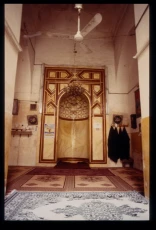
Al-Madrasa ash-Sharafiyya, prayer niche decorated with geometric patterns

Mari (Tall al-Hariri), the palace's cistern made of baked brick (beginning of 2nd millennium BC)

The Great Colonnade

Bayt Junblat, courtyard and northern iwan

Cathedral of Our Lady of Tortosa, southern side, today Tartus-Museum

Khan al-Wazir, the mosque

One of the towers of Qalʿat Salah ad-Din

Tall al-Bi'a, Excavation at Dayr Zakka (monastery)
Raq19900043.tif

Arwad, Ayyubid fort, courtyard
[Original: al-Burj al-Ayyubi]

General view of the castle and the village, Qalʿat Najm

Monolith ceiling of the south Thalamos in the cella, Temple of Bel

Raqqa, Northeast Complex
Raqqa VIII; North-East Complex, s.SW-Neg.89/551

A modern residential neighborhood in Aleppo
A view of a modern neighborhood in the city of Aleppo on a cold winter day.

A view of an-Nuri mosque and the Kilaniyya norias (water wheels), Hama
[Original: Nuri-Moschee am Orontes (unter Nur ad-Din 1162/63 errichtet) und Norias]
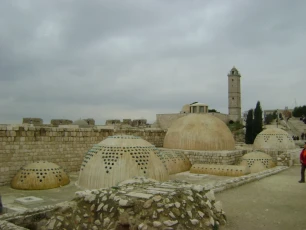
Citadel of Aleppo, exterior view of the domes of the Hammam

Husn Sulayman, Temple of Zeus Baetocaece, inner face of the North Gate

Picnic on the Euphrates bank, al-Furat al-Aʿla (the Upper Euphrates Valley)

Izraʿ - Kanisat (chrurch) Mar Jirjis - plan
St. Georg

Al-Madrasa al-Ahmadiyya, courtyard and the southern portico

A niche with ogee arch, Harim Castle

Bimaristan an-Nuri, The main entrance decorated with muqarnas

al-Matbakh al-ʿAjami, northwest corner of the large hall

Jamiʿ Aslan Dada, prayer hall (qibliyya), window above the prayer niche

Inside the city wall, excavation work, Qatna
. [Original: Al-Mishrifa / Qatnâ']

Grazing sheep on the edge of al-Ghab Plain
[Original: KLeintierherde am Rand d. Ghab]

A photo of two towers, Jaʿbar castle

Afamiya, View to the north- the Great Colonnade (Cardo Maximus)
shap_import_70676

A general view of the remains of Shayzar Castle located on a rocky cliff

Remains of a water canal in the village of Shaykh Hilal
The village inhabitants believe this type of water canals to be Roman, although the oldest of them dates back to the Byzantine era.

Hadiqat al-Umma (al-Umma Park) in Damascus

Bayt Dallal, geometrical floor design in front of the iwan
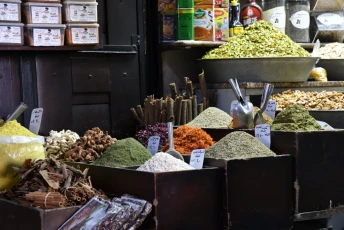
Different goods and spices on display infront of a shop in Suq al-Buzuriyya

Bayt Ajiqbash, view of the courtyard interior

A part of the city of Harim, located on the northwestern slope of a mountain

Al-Madrasa al-Muqaddamiyya, the entrance

Maʿlula, the procession to the Holy Cross celebration also passes through the narrow alleys of the old town.

Exterior northern facade and the entrance of at-Taynabiyya Mausoleum-Mosque
[ Description by author: mit dem Ersatz-"Minarett". ]

Spolia of crowns of columns for decorating a courtyard, ʿAyn al-ʿArus
Spolia in courtyard

Khan al-Wazir, interior facade of the khan's entrance

North-East Syria: Weaving in a tent

Raqqa, Qasr al-Banat, clay decoration

Dome under maintenance in the village of Shaykh Hilal
Picture of a worker standing on the stone protrusions projecting from the dome to carry out maintenance and restoration works.

Raising camels in the western part of Badiyat ash-Sham

Western shore of Jabbul-Salt Lake, abondoned village with dome houses

The historical watermill of ʿAyn al-ʿArus

Bab al-Maqam, part of the old city's wall

Jamiʿ Aslan Dada, inscription above the entrance of additional prayer hall (al-Hijaziyya)
B63 Film-VI Jamiʿ Aslan Dada, entrance of the additional prayer hall (Hijaziyya)

Izraʿ, al-Jamiʿ (Mosque) al-ʿUmari - the prayer niche

Busra, Hammam Manjak, the cold section (barrani)

Khan Qurdbak, entrance - wooden door covered with iron

Warp threads in a mill of the textile factory of the Mezannar family in Damascus

Great Mosque of Aleppo, northern arcade, former gate of the madrasa Dar al-Quran al-ʿAshaʾiriyya
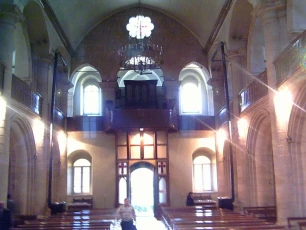
Maronite Cathedral, the nave

Jamiʿ al-Khayr, prayer hall

East and south side of the cella of Bel Temple

Tall Dahab, Central hall house , sleeping platform in the foreground

Hills around Palmyra (parts of Palmyra Chains)
[Original: Blick von der Burg auf die Wüstenlandschaft]

Remains of 'Ayn Dara temple built of basalt stones

Qalʿat (castle) Yahmur, Main entrance of the fortified tower

A photo from the beginning of 20th century in Badiyat ash-Sham

View from east to the cella of Bel Temple
Exterior view from east

Tall Shaykh Hamad (Dur Katlimmu) - Excavations

Excavation of mosaic floor, ʿAyn al-ʿArus

General view of Husn Sulayman

Inner courtyard, Jamiʿ as-Sinaniyya

Shard of colored pottery, ar-Raqqa Museum

Aleppo: Citadel, entrance 12th – 16th c.

A picture of workers doing restorations in the Umayyad Mosque
Corridor, column

Part of the ruins of Qalʿat Harim

Jurn Kabir, the only two school classrooms for children of the village

Columns with Corinthian capitals in one of Sirjilla's buildings

Suq az-Zarb, general view of the suq after the destruction, view towards east

Jamiʿ al-Utrush, courtyard and eastern riwaq (portico)
Historical photograph with a view from Courtyard/ Sahn towards southeast, showing some rubble from collapsed parts of prayer hall [Original: Dscham'a el Utrusch]

The dome house in Taanayel: building the dome
A view of two workers inserting flat stepping stones between the bricks, an old technique to help plastering the dome houses.

The altar of Nabu Temple, Palmyra

Tartus, museum in former cathedral, view at western facade
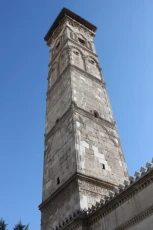
Great Mosque, Minaret
The minaret of the Great Mosque was commissioned by the judge (qadi) of Aleppo during the rule of the Seljuk dynasty in Syria. The beginning of its construction is indicated in the inscription at the base and the completion date is found at the top: 483 and 489 AH / 1090 and 1096 AD. It existed until 2013. The minaret is a square shape, its shaft is approximately 45 m high and made of limestone. On its upper edge, there is a cornice formed by two rows of flat arched niches lavishly adorned by floral elements. This is topped by an open wooden gallery for the muezzin (prayer caller) and a short tower with cupola. Between the base and the top, the minaret is divided into four zones of varying height. Those are, except for the second one, decorated with blind arches formed by profiled mouldings each running uninterruptedly around the minaret’s shaft. Each zone is separated by friezes with calligraphic, artistically written, Arabic inscriptions. These exquisitely carved inscriptions are written in floriated Kufi – a script style distinguished by bold letters adorned with floral motifs – and in Naskhi script. At the base of the minaret is the signature of the architect Hasan ibn Mufrih al-Sarmani written inside a cartouche. The inscription from the minaret’s base shows that the local Aleppine judge and the Seljuk governor shared power in the city, as their names are mentioned together: “The mosques of God are only to be maintained by those who believe in God and the Last Day and establish prayer and give zakat [(alm-tax); Quran 9:18]. It was started to be built by the High Judge Ibn al-Khashshab Muhammad ibn Muhammad al-Khashshab, may God have mercy on him. In the days of al-Amin al-ʿAjal al-Muzaffar Qasim al-Dawla wa-Nasir al-Mila Abi Saʿid Aqsunqur Bak, the slave of the Commander of the Faithful, may God enhance his supporters”. The upper inscriptions indicate the names of the then ruling Seljuk sultans Malikshah I and Tutush, and of Barakat ibn Faris, commander of the urban militia.

At-Tabqa , Jaʿbar Castle, Bastion with loopholes.

Squinch of the dome in the hall of upper floor, Qasr al-ʿAzm
Kuppelsaal: eine Trompe der Kuppel mit einer Art Muqarnas. ['Original: Hamâ (Epiphania),']

Al-Bab, The minaret of al-Jamiʿ al-Kabir (the Great Mosque)

Al-Madrasa al-Hallawiyya, courtyard and basin

Great Mosque, Minaret
The minaret of the Great Mosque was commissioned by the judge (qadi) of Aleppo during the rule of the Seljuk dynasty in Syria. The beginning of its construction is indicated in the inscription at the base and the completion date is found at the top: 483 and 489 AH / 1090 and 1096 AD. It existed until 2013. The minaret is a square shape, its shaft is approximately 45 m high and made of limestone. On its upper edge, there is a cornice formed by two rows of flat arched niches lavishly adorned by floral elements. This is topped by an open wooden gallery for the muezzin (prayer caller) and a short tower with cupola. Between the base and the top, the minaret is divided into four zones of varying height. Those are, except for the second one, decorated with blind arches formed by profiled mouldings each running uninterruptedly around the minaret’s shaft. Each zone is separated by friezes with calligraphic, artistically written, Arabic inscriptions. These exquisitely carved inscriptions are written in floriated Kufi – a script style distinguished by bold letters adorned with floral motifs – and in Naskhi script. At the base of the minaret is the signature of the architect Hasan ibn Mufrih al-Sarmani written inside a cartouche. The inscription from the minaret’s base shows that the local Aleppine judge and the Seljuk governor shared power in the city, as their names are mentioned together: “The mosques of God are only to be maintained by those who believe in God and the Last Day and establish prayer and give zakat [(alm-tax); Quran 9:18]. It was started to be built by the High Judge Ibn al-Khashshab Muhammad ibn Muhammad al-Khashshab, may God have mercy on him. In the days of al-Amin al-ʿAjal al-Muzaffar Qasim al-Dawla wa-Nasir al-Mila Abi Saʿid Aqsunqur Bak, the slave of the Commander of the Faithful, may God enhance his supporters”. The upper inscriptions indicate the names of the then ruling Seljuk sultans Malikshah I and Tutush, and of Barakat ibn Faris, commander of the urban militia.

Khan al-Jumruk, drawing of the interior facade of the Khan's entrance

Busra - Southern Roman Bath (al-Hammam ar-Rumani al-Janubi)
South-Thermae, view from the colonnade

Khusrawiyya, view of complex from the citadel, Khan ash-Shuna in foreground, in 2000
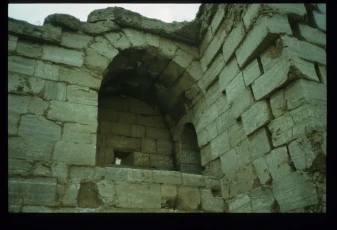
Fortification of Halabiyya

The entrance of the Tomb (Hypogeum) of the Three Brothers

Mosaic in the mausoleum of az-Zahir Baybars
[Original: Zahiriya, Mausoleum des az-Zahir Baibars, 1277, Glasmosaiken]

Burj as-Saʿa, general view

Khan al-Jumruk, general view of the mosque in the center of the khan's courtyard

Sirjilla, large press (P.01, House 09, southern annexe)
Trip of the IFEAD, the dead cities [voyage IFEAD, villes mortes]


Busra, the western wall and the apse are the remains of the Byzantine Cathedral built in the 6th century

As-Sabuniyya Mosque, the upper part of the entrance, muqarnas and rich ornaments
[ Description by author: Dekor des oberen Teiles, wohl von ~ Osten gesehen. ]

Jurn Kabir, flatbreads are rolled out with a stick, so that they can become wafer-thin and can be baked on the tray over the fire.

Remains of the Byzantine tower incorporated into the Umayyad complex at Qasr al-Hayr al-Gharbi (Palace)
[ Description by author: und rechts Eingang in den Innenhof, gesehen von ~ Südosten. Der "Balkon" am "Turm" ist eine Toilette - zumindest ist das so bei den Eremiten-Türmen des Kalksteinmassivs in Nordsyrien. Und bei den alten Dhaus in den Emiraten und 'Omân habe ich ganz ähnliches gesehen ....... ]

Arwad, Ayyubid fort

Jamiʿ al-ʿAdiliyya, the prayer niche (mihrab)
shap_import_64448

Raqqa, Bagdad Gate, Drawing of total reconstruction
Drawing of total reconstruction [on original: III, Abb. 2, S. 12]

View towards Qalʿat al-Qadmus (al-Qadmus Citadel)

Hiraqla victory monument, Western gate - decorative stone panel

Izraʿ, al-Jamiʿ (Mosque) al-ʿUmari - inscription on basalt stone

Habuba Kabira, the plastered new dome house and its garden

The stairs of the Hananiya Church in Bab Tuma quarter
The church of Hananiya can be reached by a narrow staircase with small stone steps.

Madrasat al-Firdaws, view of the southern arcade and the prayer hall entrance

Tall Tamir, Mews of a huge farmstead

Busra, Hammam Manjak, waterpipes

At-Takiyya al-Mawlawiyya, the kitchen entrance

One of the three minor mihrabs, Umayyad Mosque
[ Description by author: Einer der drei Neben-Mahârîb: jeder ist einer anderen Rechtsschule zugeteilt. Vgl. Bild 0225 ! ]
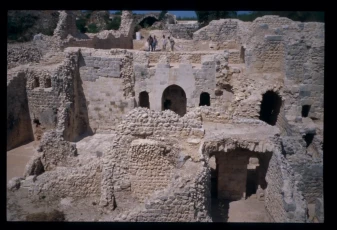
Some of inner parts, Qalʿat Salah ad-Din

Raqqa, Great Mosque; Aerial view

Remains City Wall and Ibn Maʿn Castle in the back
[ Description by author: Blick nach ~ Nordwesten: Burg und Prätorium / Fahnenheiligtum des Diokletians-Lagers. Zwischen Burg und Lager erkennt man die nördliche Stadtmauer - die Stadtmauer läuft westlich des Lager den Berg dahinter (Jabal al-Husainiya) hoch zu einer kleinen Festung und dann auf der Nordseite wieder hinunter. Dies ist eine beliebte Befestigungsform, besonders schön erhalten in Halabiya (Zenobia) am Euphrat. ]

Inside the city wall, excavation work, Qatna
. [Original: Al-Mishrifa / Qatnâ']

General view of Suq al-Buzuriyya

The Buwayda pond at the foot of the Ayyubid citadel in Salkhad
Note: these photos were taken between the year 1924 - 1939. The chosen date is to be average. (photographer unkown)
![Arial view at Tall al-Bai'a from the north. [Kalla (1999) 131]: [Gßbor Kalla: Christentum am oberen Euphrat. Das byzantinische Kloster von Tall Bi'a. in: Antike Welt 30/2 (1999).]](https://syrian-heritage.org/wp-content/plugins/justified-image-grid/timthumb.php?src=https%3A%2F%2Fsyrian-heritage.org%2Fwp-content%2Fuploads%2F2020%2F04%2Fshap_import_44697-1024x697.png&h=230&q=90&f=.png)
Arial view at Tall al-Bai'a from the north. [Kalla (1999) 131]: [Gßbor Kalla: Christentum am oberen Euphrat. Das byzantinische Kloster von Tall Bi'a. in: Antike Welt 30/2 (1999).]

Busra, al-Jami‘ (mosque) al-ʿUmari - minaret, northern-eastern corner

Khusrawiyya,detail of the ornamental paneling of the Mosque in 2008

Jamiʿ al-Maydani, the minaret

Bayt Dallal, general view of the courtyard

Western facade of the Seraya complex (Maʿbad Zeus), Qanawat
[Original: Zweigeschossige Fassade mit drei rechteckigen Portalen (prostyler Tempel aus der 2. Hälfte des 2. Jhs, im 5. Jh. christlich überarbeitet)]

Al-Madrasa al-Hallawiyya, entrance - a stone base (spolia) which is the cathedral baptismal font

Processes of the contemporary ‘Ajami handcraft: the application of metal foil
Mohammad Haj Qab in his workshop in Damascus

Raqqa - the excavations of the site "East of Raqqa" - Eastern Palace
Raqqa V; Restoration of Eastern Palace

Hammam Bahram Basha, the main facade after the destruction
1

The cold (barrani) section of as-Salamiyya historical bath
In this cold section, called the barrani”, the picture shows three iwans with vaulted ceilings, enclosing a small courtyard of which in the middle is a water fountain. The appearing iwans contain small niches and seating platforms (sing. mastaba) that also feature many niches at the bottom.

Part of a decorated wooden door with ‘Ajami decoration from the Damascus Room in the Dresden Museum for Ethnology

Bayt Ghazala, ʿajami wall panels decorating the main hall (qaʿa)
[Original: B86 /Film XV]

A group of semi-nomads sitting on a felt rug (left and in the rear) and on a woven rag rug (right side)

In the tent of a semi-nomadic family from the Maskana region, with storage bags in the background.

An arch in Qasr al-Hayr ash-Sharqi
[Original: Arch-k.K6/=HQ k.K 60,]

Raqqa, Grand Abbasid Mosque - Plan

Suq az-Zarb, general view of the suq

A niche in an exterior wall of Harim Castle

A photo of stairway with arches, Busra Citadel
HQ-k.K7 Aside from the Citadel, stairwell

Museum of Palmyra / Tadmur, Stone-relief with figural decoration
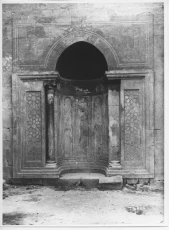
Al-Madrasa az-Zahiriyya, historic photo of the prayer niche
Mihrab

View of a side of Najm Castle (Qalʿat Najm)

Great Mosque, prayer hall, minbar and mihrab
The unique wooden minbar, or pulpit, belongs to the Mamluk era as indicated by the inscribed name of the Sultan al-Nasir Muhammad, son of Qalawun (d. 741 AH / 1341 AD). The carpenter’s name is Muhammad ibn ʿAli al-Mawsili.

Cows in a grove, the Ghouta of Damascus

The avenue "Between the Schools"

Bayt Dallal, a part of courtyard and iwan
View at Liwan and the Diwanchane

Khan Murad Basha (Museum of Maʿarrat an-Nuʿman), Mosaic
[Original: Khan Murad Pascha, Bodenmosaik (4. - 7. Jh., aus den Toten Städten)]

Busra, The cold section (Barrani) of Hammam Manjak
Interior View, Arch, Fountain,_Separaiting Sheet 86/XV
![[S.156 Abb.174]](https://syrian-heritage.org/wp-content/plugins/justified-image-grid/timthumb.php?src=https%3A%2F%2Fsyrian-heritage.org%2Fwp-content%2Fuploads%2F2020%2F04%2Fshap_import_52442-1024x699.png&h=230&q=90&f=.png)
[S.156 Abb.174]

Jurn Kabir, the fertile plain of the Euphrates with floodplain forest in the background before the flooding of the Tishrin Dam

Afamiya, The Great colonnade (Cardo Maximus)

Plastic tools shop in ar-Raqqa

Stone carved panel on the ʿAyn Diwar bridge

Suq az-Zarb, view towards west of the suq after the destruction

Column capital on the terrace of the northern riwaq.

View from the north to the middle overbuilt part of the suq (bazaar) of Khan al-Harir (right)

Bayt Wakil, iwan

Bayt Wakil, courtyard and fountain (restaurant)

Bayt Wakil, fountain of the reception hall

Al-Marja Square with the Column of Telegraph, Damascus

Coffehouse Aslan Dada (vanished)

Warp threads of silk in the textile factory of the Mezannar family in Damascus

Damascus, Khan Asʿad Basha al-ʿAzm, windows on the tambour of one of the domes

General view of Maʿlula
[ Description by author: Gesehen bei der Anfahrt von ~ Süden. Auf dem Berg hinten links Kirche und Kloster der Heiligen Sergios (Mâr Sarkîs) und Bacchos.- Ma'lûlâ und eine Nachbargemeinde sind die einzigen Orte, in denen noch bis ins 20. Jh. Aramäisch gesprochen wurde, heute ist es praktisch ausgestorben.- Der GPS-Tag ist approximativ. ]

A shell of a new house with flattened domes in a village south of Tall Abyad

View of Eastern Palace, ar-Raqqa

Hypogeum of the Three Brothers from the inside - mural paintings
Nekropole - Grab der drei Brüder - 160 nChr {Foto}

Jamiʿ ad-Darwishiyya, framed window with a decorative strip, topped by an ornamental arch
[ Description by author: mit Bordüre. ]

Madrasat al-Firdaws, courtyard, iwan and western arcade

General view of Qarqbiza remains

Protection of archaeological site of Mari (Tall al-Hariri) with temporary coverage
[Original: Große Orientreise Nr.63 mit Rotel-Tours: Amman-Bagdad-Uruk-Babylon-Arbil-Mosul-Hatra-Samara-Mari-Dura Europos-Aleppo-Dayr Saman-Ugarit-Palmyra-Jarash]

View into a vaulted room of Najm Castle (Qalʿat Najm)

Jamiʿ ash-Shuʿaybiyya, west facade - entrance and Qastal
Other names are Mosque of Shields or Mosque of Bab-Antakya,

General view of Ibn Maʿn Castle
[Original: Burg oberh. v. Palmyra]

Details of lintel decorations, Theater of Palmyra
[ Description by author: Rückseite des Tores von Bild 0721, Detail der rechten Seite. Man erkennt links eine Büste ohne Kopf, daneben ein sitzendes Huftier oder vielleicht einen Faun. Dieses/r entspricht genau der Figur ganz links auf der linken Spolie in der arabischen Bastion Bild 0598 ! Vgl. auch Bild 0754 ! ]

Main facade of Jamiʿ at-Tawashi mosque (stitched panorama)
Photograph of mosque's main, southeastern, facade during ongoing works of refurbishment and partly recovery work. Several pictures have been put together to a panorama.

Citadel of Aleppo, plant ornament

Qasr Ibn Wardan, the church
[Original: Kirche (Kuppelbasilika mit Emporen), Südseite (873-876)]

Khan Ujkhan، main entrance

Muzayrib - millstone within an ancient watermill

Jamiʿ al-ʿAdiliyya, prayer hall's entrance

Sphinx in the Temple of 'Ayn Dara

General view of Balis on the Euphrates river

Sahat (Square) al-Marja in the early 20th century
[Original:'Damaskus: Telegrafendenkmal']. The Bavarian air force division 304b was based in Palestine from 25. October 1917 and was involved in the First World War until the division left the region, over Aleppo, in mid September 1918. During that period, over 3000 glas photographs, mostly aerial, have been made. Those early photographs were important for the archaeological research in the Middle East.

Habuba Kabira, Construction of the relieving arch, on which 2 cantilever domes are to rest

A distant view of Masyaf castle and town

Afamiya, twisted and fluted columns of the central section of the Great Colonnade

Tombe carved into the rock, ʿAyn as-Sahib
[ Description by author: Tele-Konverter-Ausschnitt, eindeutig auf das rechte Grab von Bild 0406 / 0408. ]

Remains of the Jupiter temple in Damascus

One of the towers of Damascus Citadel
View of a tower of the eastern façade of Damascus Citadel. The tower looks rectangular, topped by a set of machicolations.

Door with ornaments on the lintel, Qarqbiza
[Original: Haus, Tür mit Ornamenten auf dem Türsturz]

Citadel of Aleppo, the Great Mosque - inscription

General view of Qalat Salah ad-Din

Bimaristan an-Nuri, inscription above the entrance

Guesthouse of a wealthy family in Maskana, attached is an iwan

Decorations on an arch in the Church of Qalb Lawza

Al-Madrasa al-Ahmadiyya, entrance of the tomb

Al-Madrasa al-Kamiliyya, courtyard

Vegetation with rocks in the coastal mountains
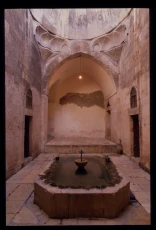
Bimaristan Arghun, general view of the southern courtyard - fountain and iwan

1 pound, 27 mm, 1968 – restrike 1971

Chickpeas

Jamiʿ al-Utrush, an original Mamluk column with its capital

Alternate ablaq rows in the courtyard of Jamiʿ Manjak

Bayt Wakil, courtyard and fountain

Damascus,Umayyad Mosque, pigeons in the courtyard
Pigeons in the courtyard of the Umayyad Mosque

The courtyard of at-Takiyya as-Sulaymaniyya with a water fountain

Tombe carved into the rock, ʿAyn as-Sahib
[ Description by author: Das Grab von Bild 0411 in Untersicht. Im Tympanon war wohl ursprünglich ein Kopf. ]

al-Hayr al-Sharqi Palace, Inside of the early Umaiyad desert castle (Western complex)

Raqqa, Qasr al-Banat
[original: Raqqa, Qasr al-Banat']. [83/156/1772] =[ photo's name as: year/ film no./ photo no,]. on the back of the photos: [1983/156]


Jamiʿ al-ʿAdiliyya, general view of central dome
View from the minaret to the lead-covered dome, which was placed on a short cylindrical wall (tambour). The eight short buttresses at the corners of the roof above the prayer room, which are supposed to compensate for the transverse forces of the dome, are clearly visible.

Jamiʿ al-Qayqan, general view from outside
[Original: Jâmi' al-Qîqân, Halab/ Aleppo, "Rabenmoschee" - etwa wegen der beiden wohl antiken / byzantinischen Basaltsäulen am Eingang? Eine weitere Merkwürdigkeit ist die Verwendung von Säulenstümpfen im Mauerwerk, was man sonst nur bei Festungsarchitektur sieht. Außerdem soll die Mosche "im Mauerwerk" - wo? - einen Stein mit hethitischer Inschrift bergen. 18/04/2001 (?)']

Khan al-Jumruk, general view of the mosque in the center of the Khan's courtyard

Jamiʿ Sharaf, the minaret

Bab Qinnasrin (city gate), exterior view of the gate from south-west
The gate is topped by a pointed vault. It was built in the style of Ablaq, in which stone rows alternates between black and white colors.

The main arch and the integrated columns of the Nabataean gate in Busra

Jabla, Mosque of Sultan Ibrahim, Arabic calligraphy,

The historical sulfur Afqa Spring
[ Description by author: Gesehen von ~ Südwesten bei der Ankunft in Palmyra. Diese Quelle war die wichtigste des Ortes und bewässerte bis in die 1990er - seither ist sie versiegt - die Oase mit dem Palmenhain. Die Palmyrener legten an ihr unterirdische Bankettsäle an (Eingänge sichtbar auf den folgenden Bildern !) und stellten viel Altäre und Ex-Votos für die Gottheit der Quelle auf (ibidem). Das Wasser war leicht schwefelig. ]

Afamiya, remains of colossal columns
shap_import_44109

Jamiʿ al-ʿAdiliyya, the prayer niche

General view from outside, Jamiʿ Manjak

General view of al-Qarmani Bath and garden
An overview of al-Qarmani bath that dates back to the Mamluk period. In addition to the main big dome, the building contains many domes and vaults, interspersed with glass-covered openings that allow light to enter the inner sections of the bath. This bath was recently restored after being neglected for a very long time.

Qalʿat al-Qadmus (al-Qadmus Castle), Inscription

Mountains around Palmyra (parts of Palmyra Chains)

Bayt Junblat, the northern iwan decorated with marble and ceramic tiles
[Original:'Qasr Jumblât, Halab / Aleppo. Inneres des Nord-Iwâns.].

Turbat Khaʾirbak (mausoleum), section of southern iwan, courtyard and two chambers
size of plan 22 x 15 . scale 1:100 .

Yabrud: making Burghul, in background a wall in a special pisé-technique

Mushabbak, Byzantine basilica, general view from southeast

Qal‘at Shayzar ( Citadel), An Arabic inscription.

Jamiʿ ash-Shuʿaybiyya, west facade - a cornice with floral motifs and a Qur'anic text in Kufic script

Qal‘at Shayzar (castle), The stairs leading to the entrance

Tall Shaykh Hamad (Dur Katlimmu) - Excavations
[Original:'TALL SAIH HAMAD']

The Euphrates in Raqqa

part of the Muqarnaṣ cornice of the Aleppo Room, Museum for Islamic Art, Berlin

Spools in the textile factory of the Mezannar family

Stucco decorations in situ, Kharab Sayyar
[Original: Stucke in Situ an. Jasc.]

The minaret of the Mosque of Shaykh ʿAqil al-ʿUmari al-Manbiji

A side from the courtyard of Bayt Jubran Afandi Shamiyya, Bab Tuma
Hof mit Liwan und Seitenliwan

Diversity of vegetation and protruding rocks in the Syrian coastal mountains (al-Jibal as-Sahiliyya)

Roman tower tomb in Sarrin
Not exactly locatable tower tomb, which is dated 74 AD by its inscriptions. To note the high set canulated half columns [Original: 'SIRRIN, Grabturm (74 n. Ch.)']
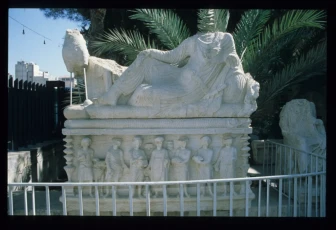
Sarcophagus with relief decoration
[Original: Palmyrenischer Sarkophag. Auf dem Deckel der gelagerte Grabherr in sassanidischer Tracht mit den Rangabzeichen eines einheimischen Karawanenchefs. Auf dem als Kline gestalteten Kasten in der Mitte der Grabinhaber beim Opfer mit den Rangabzeichen eines palmyrenischen Hohenpriesters und zugleich in der römischen Amtstracht eines togatus. Auf ihn schreiten zwei mal drei Gestalten zu, die Opfergaben bzw. Opfergerät bringen. 2. V. 3. Jh.]

Suq Aslan Dada, general view of the reconstruciton of the suq and the eastern facade of Khan as-Sabun

Kafra, in the courtyard behind a huge central hall house

Bab al-Maqam, gate's arch

Al-Matbakh al-ʿAjami, muqarnas squinches of the iwan dome

Khan al-Jumruk, internal facade of the Khan's entrance
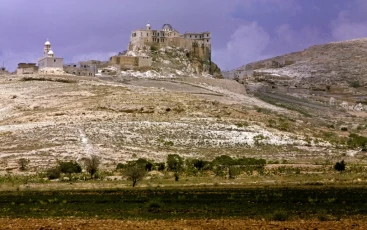
General view of Notre Dame de Saydnaya
[ Description by author: von ~ Südosten. In dem Felssockel rechts befindet sich das Grab mit den Figuren von Bild 0420.- Trotz obiger Zuordnung (nach den wichtigsten Ausbau-Stufen): die Ursprünge der Anlage gehen in byzantinische Zeit zurück und sollen in Zusammenhang mit einem Erlebnis des Kaisers Justinian stehen: eine von ihm verfolgte Gazelle verwandelte sich in ein Marienbild (des Lukas ...), das die Erbauung einer Kirche an dieser Stelle verlangte und seither Wunder tat. ]

Al-Madrasa al-Hallawiyya, detail of Corinthian capital

Jamiʿ Aslan Dada, facade of the hall entrance
[Original: B63 Film-VI]

View from the courtyard towards the northeastern side of the valley, Dayr Mar Musa al-Habashi
[ Description by author: Blick vom Innenhof auf die ~ nordöstliche Talseite mit modernen Bauten für Leute "auf der Suche". Die teil-vermauerten Höhlen könnten die der ursprünglichen Mönche sein. ]

Busra, remains of the Byzantine Cathedral

Ghuta of Damascus, an old irrigation canal, 1963
The farmers of the Ghuta were able to benefit from the Barada and al-'Awaj rivers in the most possible way, through a water distribution system. The Barada River was divided into seven branches, as well as a subnet of canals covering all the lands of the Ghuta. The inhabitants of the Ghuta did not rely only on the water coming from these two rivers for the irrigation of their orchards, but rather they dug dozens of wells to benefit from the groundwater as well.

The historical sulfur spring of Afqa
[ Description by author: ~ Nordwestliche Seite mit einem Altar und Zugängen zu den unterirdischen Bankettsälen. Gesehen von ~ Osten. ]

Lion of goddess Al-Lat, 1st c. AD
[ Description by author: Detail, vom Eingang des Temenos der Allât. Sie symbolisiert den beschützenden Aspekt - siehe die "glückliche" Antilope - der Herrin der Tiere. Die Statue soll um die Zeitenwende entstanden sein. Eine Kopie - oder doch das Original ? - steht im Garten des Nationalmuseums in Damaskus. Vgl. Bild 0752 und 0754 ! ]

Ghuta of Damascus, an alley in one of the villages

al-Lajat region, Roman road

Entrance of the Ayyubid Mosque of Fatima, Busra

The dome hall in the upper floor of Qasr al-ʿAzm (Palace)

Busra, Hammam Manjak, exterior view

al-Burayj, a side of Saint Daniel Monastery

Interior view towards the entrance, Agora
[ Description by author: Ostecke. Das Tor ist das von Bild 0704, aber jetzt von innen. Im Torrahmen sieht man den Mittelteil der Scaenae Frons des Theaters. ]

Burj as-Saʿa, upper part of the entrance

Al-Madrasa al-Ahmadiyya, domes of the prayer niche from the outside

Jamiʿ al-Khayr, ground plan
Size of plan 50 x 20, with ruler (no scale).

Khan al-Hibal, the northern facade from inside

al-Malikiyya - ʿAyn al-Khadra, Basalt Tombs

Damascus, Minaret al-Qalʿi, 15 C.
One of the most important minarets from the Mamluk era in Damascus due to its rich ornamental elements of Muqarnas cells, geometrical panels.

Winding of spools in the textile factory of the Mezannar family

Khan Asʿad Basha al-ʿAzm, 1754
The largest commercial building of Damascus with the distinctive change of basalt and limestone was built by the governor Asʿad Basha al-ʿAzm.
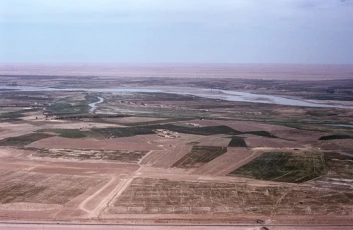
General view of Euphrates valley at Dayr az-Zawr countryside

Habuba Kabira, Mud brick construction - connection of wall, belt arch and dome rounding

Busra - Birkat (pool) al-Hajj

Citadel of Aleppo, main entrance gateway
[Original: Zitadelle, Haupttor, Vortor und Brücke]

Great Mosque of Raqqa-Rafiqa, 8th/12th C.
The main mosque was built in 772 AD and renovated in the 12th century. Monumental witnesses of this history are the 25 m high minaret and the arcade wall.

Remains of arches in Halabiyya-Zalabiyya

Bayt Mustafa al-Jabiri (Bayt cad. VII 2056) before belonging to waqf al-Jabiri
Size of plan 55 x 45. with ruler (no scale)

Euphrates plain near the mouth of the Sajur, limestone massif on the south side ((before the flooding of lake Tishrin)

A local bakery in the old city of Aleppo
A picture of croissants pieces in a local bakery in the historic neighborhood of al-Jallum.

Aerial photo of the Jabal Haramun (Mont Hermon)

Raqqa, Qasr al-Banat, courtyard with southern Iwan

(Dome) Qubbat as-Sayyar on Qasyun mountain
Photos of Qubbat as-Sayyar ['Saiyer'], No. 96[B]

Bayt Dallal, iwan ceiling and canopy

Part of the of the city wall of Damascus

Barada River in a state of drought, near Victoria Bridge

Jisr ash-Shughur, Qalʿat ash-Shugr wa-Bakas, a general view of the the valley around the twin castle

Piece in the courtyard, terrace of the northern riwaq.

Remains of Diocletian Baths
[ Description by author: Links das Peristyl des Beckens (dass es ein Becken ist, erkennt man auf Bild 0693, 0694 !), ganz rechts das Propylon, hinten die Innenseite des Monumentalbogens. Gesehen von ~ Nordwesten. ]

Archaeological finds from Raqqa, exhibited in the Damascus National Museum
Glass pig from ar-Raqqa; National Museum Damascus; Mus.Nr.16024; R.45

Two large reservoirs in the ruins of Kharab Sayyar

Busra, Roman Theater surrounded by the Islamic Citadel

Remains of the Umayyad Qasr al-Hayr al-Gharbi
[Original: "Heir al-Garbi"]

Al-Madrasa al-Kamiliyya, portal gate

Shaykh Shibli shrine - al-Tar mountain, south -east of al-Mayadeen
Near Qa'alat ar-Rahaba, Shrin Shaykh Shibliy. [Original:'Bei QAL'AT ar-RAHABA, Grabbau = SAIH SIBLI']

Luxury summer houses in Bludan

A part from the ruins of Ebla (Tall Mardikh)
shap_import_48455

Details of Qashani tiles: floral and geometric designs, Mausoleum of Salah ad-Din al-Ayyubi
[ Description by author: Dekor der Eck-Pilaster, vgl. Bild 0228 ! (The year of the photo is not sure according to Peter Heiske ) ]

Burj as-Saʿa, general view

Al-Madrasa as-Sultaniyya, entrance - inscriptions surround the iwan and above its arch

Tall al-Biʿa, Ancient city of Tuttul

The prayer niche and the pulpit in the middle of the south wall in the prayer hall of the Great Umayyad Mosque of Aleppo
In the 7th century AH / 13th century AD, after the Mongols under Hulagu Khan had attacked Aleppo and damaged the Great Mosque, the Mamluks extensively rebuilt it, replacing the wooden ceiling of the prayer hall by stone vaults on pillars. The mihrab was replaced by the Mamluk sultan Qalawun; his name is indicated above the present one, together with that of his governor, the Mamluk prince Qarasunqur al-Jukandar, and the date 684 AH / 1285 AD: “In the name of God, the Entirely Merciful, the Especially Merciful. It was commanded to be built after it was burned by Our Master the greatest Sultan, al-Malik al-Mansur Sayf al-Dunya wa l-Din Qalawun, may God enhance his victory. By the high advice of the master, al-Amir Shams al-Din Qarasunqur al-Jukandar al-Maliki al-Mansuri. The governor of the guarded principality of Aleppo, may God reward and guard him, in the month of Rajab of the year six hundred and eighty-four [September 1285 AD]”.

Hammam Bahram Basha, the main facade after the destruction
1

In al-Hayat/Balikh valley, procedure for calcination of gypsum (1st step), fuel is placed on a natural gypsum layer
(See also 2nd and 3rd step of calcination of gypsum)

Jamiʿ al-Khayr, the main entrance from the outside

Archaeological finds from Raqqa, exhibited in the Damascus National Museum
Floral frieze decoration; National Museum Damascus, from ar-Raqqa

Jabla, Remains of the Roman Theater

al-Husn Church, Remains of the basilica after its demolition and turning the site into an agricultural field

The lower part of the lion of goddess Al-Lat, 1st c. AD
The lion was embedded in the outer wall of the Al-Lat temple. As a protector of an antelope it is a symbol of peacefullness. The stone statue was severely damaged by ISIS.

Dayr Zakka (monastery), floor mosaic of the narthex (in situ)
Mosaic from monastery Dayr Zakka, upon Tall Bi'a; 70:16, Raq19900048.tif

Exterior view of the dome and the minaret, Jamiʿ al-Imam Ismaʿil

Western and eastern altars which are fully preserved, al-Karasi
[ Description by author: "Die Sitze". Es sind vier Altäre, die in Form einer Raute aufgestellt sind - der vierte stand hinter zwischen den beiden voll erhaltenen. Die längere Achse - hier vom rechten zwischen den beiden anderen nach links - velief S > N, die voll erhaltenen sind also der westliche und der östliche Altar. Sie tragen Inschriften in Griechisch und Aramäisch (vgl. Bild 0571, 0572 und 0574, 0575 !), die besagen, dass die Altäre im Jahre 144 n. Chr. auf Kosten des Staatsschatzes errichtet wurden. Man vermutet, dass sie dem Schutz einer neuen Obstpflanzung dienten - noch heute, wenn auch auf den Fotos nicht zu sehen, wachsen viele Bäume in der Gegend, weswegen man die Altäre auch nur schwer findet ....... - Der GPS-Tag für diese sieben Bilder ist sehr approximativ ! ]

Remains of Afamiya Theater

Courtyard on the upper floor, Najm Castle (Qalʿat Najm)
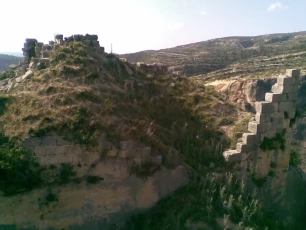
Jisr ash-Shughur, the ruins of Qalʿat ash-Shugr wa-Bakas, a twin crusader castle

Damascus, Glass Blowing Workshop near Bab Sharqi
[Original: LEAD Technologies Inc. V1.01]

An Arabic inscription on the wall of Qal‘at Shayzar

Citadel of Aleppo, Temple of the Weather God, early 1st millennium BC

Qalb Lawza, Basilica of 5th c., South facade, decoration detail of the central doorway

Jamiʿ ash-Shuʿaybiyya, the upper part - a cornice with floral motifs and a Qur'anic text in Kufic script
Decoration in Jami al-Tuta or Jami ash-Shu'aybiyya. [Original: Jâmi' at-Tûta, Halab / Aleppo. "Maulbeerbaum-Moschee": Detail aus dem ayyubidischen Dekor an den Resten des Gebälks, vgl. Bild 1216 !']

Al-Madrasa al-Hallawiyya, northern facade - marble plaque dated 1315 AH and sealed by the Sultan Abd al-Hamid Khan (Tughra)

Popular restaurants on both banks of the Barada River


The space is 02 in general, according to the ground plan. Here secondary spaces 09-13 are seen.

A side of Krak des Chevaliers
[Original: Große Orientreise Nr.63 mit Rotel-Tours: Amman-Bagdad-Uruk-Babylon-Arbil-Mosul-Hatra-Samara-Mari-Dura Europos-Aleppo-Dayr Saman-Ugarit-Palmyra-Jarash]

The historical sulfur spring of Afqa
[ Description by author: Nach Südwesten. Ich vermute, dieser Kanal, an dessen Eingang man hier steht, ist der Zugang zur eigentlichen Quelle. ]

Dome of the mausoleum (turba) and madrasa of Amat al-Latif daughter of the an-Nasih al-Hanbali
[Original: ( mm 84 )]

Courtyard of the Great Mosque, view towards east

Bimaristan an-Nuri, mill stones nade of basalt

Irrigation canal, al-Furat al-Aʿla (the Upper Euphrates Valley)

Al-Madrasa al-ʿUmariyya al-Kubra - southern arcade

The tower tombs, Valley of the Tombs
[ Description by author: Starkes Tele, vielleicht sogar Tele + Konverter. Zum Standort s. Bild 0592, der Blick wäre dann von ~ Ost-Nord-Ost.. ['Zenobia Hotel (?),'] ]

Busra, Hammam Manjak, north wing with hot water reservoir during the restoration
North wing with hot water reservoir

Burj as-Saʿa, general view

Al-Madrasa al-Hallawiyya, wooden prayer niche in the iwan
shap_import_62569

Courtyard with fountain, Qasr As‘ad Basha al-'Azm
1929?

View of the remains of the Nabu Temple showing the podium
[ Description by author: Sein Podium mit dem Aufgang, gesehen von ~ Südosten. Im Hintergrund die Burg des Fakhru d-Dîn al-Ma'ni, links davon der Oberteil des Tetrapylon. In der Mitte hinter dem Tempel die Säulen der Diokletians-Thermen. ]

Great Mosque, courtyard and prayer hall facade
The Phot shows the courtyard and the southern side of the prayer hall facade, west of the porch.

Archaeological finds from Raqqa, exhibited in the Damascus National Museum
Relief decorated Frieze; National Museum Damascus from ar-Raqqa

A side of the architectural remains, Mari (Tall al-Hariri)
![[Institut Français du Proche Orient]](https://syrian-heritage.org/wp-content/plugins/justified-image-grid/timthumb.php?src=https%3A%2F%2Fsyrian-heritage.org%2Fwp-content%2Fuploads%2F2020%2F04%2Fshap_import_74685-1024x699.png&h=230&q=90&f=.png)
[Institut Français du Proche Orient]

Raqqa - the excavations of the site "East of Raqqa", Palace D, stucco decorations

Busra, View into the Cathedral, 6th C.
[Original: Kathedrale (den Märtyrern Sergios und Bacchios und dem Leontios geweiht), 512/13]

Street side of the homestead: a terrace in front of a house of Kurdish family in the Malkiyya-Region

Nahiyat at-Tabqa, Euphrates Dam

As-Sabuniyya Mosque, the main facade with muqarnas and rich decorations

Minaret and dome of al-Imam Ismaʿil Mosque, Salamiyya
Gesehen vermutlich vom Dach des Hauses der Ghâli (Hishâm und Amjad) nach ~ Westen, vgl. Bild 1049 ! - Salamiya ist der (syrische) Hauptort der Ismailiten (Zweig der Shî'a) unter ihrem (derzeitigen) Oberhaupt Karîm Aga Khân. [Original: 'Salamiya (Salamias)']

Bab al-Maqam, general view

At-Takiyya al-Mawlawiyya, the kitchen entrance

Bayt Wakil, courtyard and fountain

At-Takiyya al-Ikhlasiyya (az-Zawiya ar-Rifaʿiyya), general view from the outside
shap_import_65803

Raqqa - Qasr al-Banat, inner courtyard

Jamiʿ Aslan Dada, entrance of the additional prayer hall (al-Hijaziyya)

25 piastres (Commemorative coins: 25th anniversary of al-Baath Party), 20,3 mm, 1972

Jamiʿ Aslan Dada, the hall - octagonal neck of the dome

Aerial photograph of Palmyra mountain ranges

Al-Khubra lake in Jabal Says

Sinaniyya Street: traffic scene with tram in 1918
In the Sinaniyya street traditionally the pilgrimage-caravan to Mecca started. From 1904 to 1967 a tram line ran here.

Bayt Ghazala, ʿajami panels decorating the northern wing ceiling in the main reception hall (qaʿa)

View of the city of Saydnaya with its monastery

Damascus Gate on the south eastern side of the City Wall, Ebla (Tall Mardikh)
~ Ostseite, Abschnitt zur Stadt. Gesehen von der ~ Westseite nach ~ Osten. [Original:Tall Mardîkh (Ebla)']

Shore zone of the Euphrates with tree vegetation of Lake Assad

Tall al-Biʿa at the confluence of Euphrates and Balikh rivers

ar-Raqqa - Qasr al-Banat, the courtyard surrounded by four iwans

View into tent of nomadic family of Tayy-tribe

A photo of the courtyard of Bayt Shaykh Qatana before demolition
Bl.aus dem Liwan ü.d. Bahra

Citadel of Aleppo, prayer hall of the Great Mosque

Takiyyat ash-Shaykh Abu Bakr, the minaret

Qanawat, view of the nymphaeum

Raqqa - "East of Raqqa" site - Tall Aswad, excavation in 1985
Tall Aswad

al-Lajat region, ancient cistern for storing water

10 piastres (silver), 17 mm, 1929 (French Mandate)
shap_import_130398

Jamiʿ Aslan Dada, hall dome - squinch and muqarnas

Bayt Wakil, facade of the reception hall (qaʿa)

Homs, Western entrance, Jamiʿ an-Nuri

Raqqa, Baghdad Gate (Bab) as seen from outside the fence
Raq19820005.tif

Busra - Jamiʿ (mosque) Fatima - exterior view of the minaret

General view of the Orontes valley in the 1960s

View to the pole, Badiyat ash-Sham

Takiyyat ash-Shaykh Abu Bakr, al-Midan entrance

Habuba Kabira, mixture of sifted raw loam, chaff and water to produce clay bricks therefrom

Fresco on the Northern aisle of the church, Monastery of Mar Musa al-Habashi
[ Description by author: Nördliches Seitenschiff, erster Pfeiler: Engel. ]

A view of the main facade, the Convent of Our Lady of Saydnaya

Part of archaeological remains, Tall Mardikh (Ebla)
shap_import_48483

Bimaristan Arghun, inscription

A view of a hill around ٍShahba

Jamiʿ Sharaf, Mamluk rank

View from the Philippeion to the city, Shahba

Qalb Lawza, Basilica of 5th c., Apse and south façade
[Original: Basilika, vor 469, SO-Seite]

Mausoleum Ahmad Basha, general view of the facade
[ Description by author: Erbaut 1316. Zwei Kuppeln auf achteckigem Tambour, Eingangs-"Iwân". Die Nische rechts neben dem "Iwân" ist möglicherweise ein Brunnen. Gesehen wohl von ~ Nordwesten. ]

Madrasat al-Firdaws, a grave on the west of prayer hall

Ar-Raqqa - Islamic coins discovered in the site of al-Jamiʿ al-ʿAtiq
Numairidian Coin; approx. 450 h.; Ra91-GrMo-8146 (B)
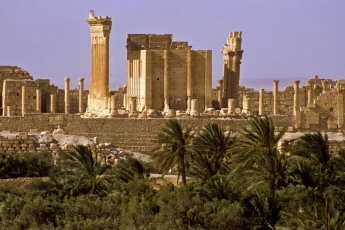
General view from the north, Temple of Bel
[ Description by author: Morgendlicher Fernblick auf die ~ Nordseite. Woher ? Nach der Google-Karte erscheint das Tetrapylon-Hotel als Standort am wahrscheinlichsten: das kenne ich aber von meinen Aufenthalten nicht. In der selben Gegend befinden sich aber das Tower Hotel und auch das Middle East Hotel: in beiden war ich. Vielleicht wurde auch eines der beiden umbenannt ? ['[Tetrapylon Hotel],'] ]

Palmyra, Hadrian’s Arch, , 3rd century A.D., view from south at the entrance to colonnaded street
The triumphal arc was constructed in honour of the Roman emperor Hadrian and linked the colonnaded street to the Temple of Baal. In 2015, ISIS destroyed the arch.

Parts of Qalʿat Shayzar with one of the towers

Jurn Kabir, the traditional type of the double room house, which is divided inside by a transverse wall.

At-Takiyya al-Mawlawiyya, niche and minbar in the prayer hall (Samah Khana)

Fresco on the western wall of the church, Monastery of Mar Musa al-Habashi
[ Description by author: Jüngstes Gericht an der Westwand, Details. Drei Register der linken Seite, in der Mitte vier Mal "Abrahams Schoß". Interessant ist die Figur unten rechts, die etwas "von oben" empfängt: ihre Harartracht erinnert sehr an die von Bild 0483 ! Dort vermutete ich eine Dornenkrone, das trifft hier aber gewiss nicht zu ! ]

Exterior view of Seljuk watermill ''Bab as-Salam watermill'', Damascus

Citadel of Aleppo, main entrance gateway, hawker in foreground

Abdelraouf Baydoun working with the craft of ‘Ajami: Preparation of a wooden dome

Turbat az-Zahir Baybars, mosaic details covering the southern wall of the mausoleum
[ Description by author: Rechter Teil der ~ Westwand. (The date of this photo was not sure as Peter Heiske did [(wohl) 18/10/1998] ]

The altar of Nabu Temple, Palmyra
[ Description by author: in Form eines Naiskos und Propyläen von der Hofseite, gesehen von ~ Norden. ]

Maronite Cathedral, general view of the main entrance

warp threads of dyed silk in the textile factory of the Mezannar family in Damascus

The main facade of al-Bimaristan an-Nuri in Damascus
Main entrance, muqarnas, wall relief

Bimaristan an-Nuri, courtyard

The Seljuk watermill ''Bab as-Salam watermill'' from the inside, Damascus

A Sheikh with his family in traditional clothes. The man is wearing a black Abbaya

Part of the city wall of ar-Raqqa after the restoration

Raqqa - "East of Raqqa" site - Tall Aswad, excavation in 1985
[1985/25/435] = [photo's name as: year/ film no./ photo no.]

Bab as-Salam, the "door of peace" in the north of Old Damascus

Khan Qurdbak, western portico

Turbat Khaʾirbak (mausoleum), western facade - inscription band

Jamiʿ al-Utrush, bevelled wall corner with a Muqarnas console

Byzantine decorated basalt stone reused in the construction of Qal‘at Shayzar

Bayt Ajiqbash, Ground floor plan

An artificial irrigation canal, al-Furat al-Aʿla (the Upper Euphrates Valley)

Khan al-Wazir, northern facade and the internal facade of the khan's entrance

Madrasat al-Firdaws, west wall of iwan opposite the prayer hall

General view of the city of Harim, Muhafazat Idlib

Shops for buying traditional utensils in Raqqa

A robust 4 cm thick felt carpet made of wool in the manufacturing facility for felt carpets in Al-Bab
Photographs of a manufacturing facility for felt carpets in Al Bab as part of the "Aleppo Stadtarchivprojekt" of GIZ (German Corporation for International Cooperation) in 2008

Busra, al-Jami‘ (mosque) al-ʿUmari - the prayer hall

A gathering of people around a rolled out woven Kilim tapestry
The rug consists of strips, that are sewed together

Citadel of Aleppo, Maqam Ibrahim - foundation inscription on the right side of the prayer hall's entrance

Roman grave behind the monastery of Notre Dame de Saydnaya
[ Description by author: aus byzantinischer Zeit im Felssockel der Klosteranlage. Die Figuren erinnern an die der sog. "Hochzeit von Kana" in Qânâ / Libanon. ]

Madrasat al-Firdaws, general view to north - courtyard, eastern arcade and iwan

A farmer in the Badiyya shows the traditional pillows woven by his wife

Dancing on a terrace in the St. Thekla Monastery on the Holy Cross Day in Maʿlula

Raqqa - "East of Raqqa" site - Western Palace - finds
Raqqa VIII; Eastern West Palace, SW-Neg.89/923-924

Application of the relief paste of a ‘Ajami decoration
Workshop of Abdelraouf and Ziad Baydon in Malaysia

Busra - Southern Roman Bath (al-Hammam ar-Rumani al-Janubi)
Exterior view to north, palaestra of the South Baths
![The South-western part of Bayt al-Husainin with the minrat of its mosque. [Original photo name: as-i-محمع قصر الحسيني 3_SYRHER]](https://syrian-heritage.org/wp-content/plugins/justified-image-grid/timthumb.php?src=https%3A%2F%2Fsyrian-heritage.org%2Fwp-content%2Fuploads%2F2020%2F04%2Fshap_import_75456-1024x768.png&h=230&q=90&f=.png)
The South-western part of Bayt al-Husainin with the minrat of its mosque. [Original photo name: as-i-محمع قصر الحسيني 3_SYRHER]

Waqf of Ibshir Mustafa Pasha, Coffeehouse, the hall
The uniquely decorated facade of the hall of the coffeehouse, as well as its first row of vaults, were destroyed. The core of the hall was only partially damaged, while the section of the central dome with its high lantern was, for the most part, destroyed.

Jamiʿ al-Khayr, details from the main entrance

The northern arcade of the inner courtyard (juwwani), Asʿad Basha al-ʿAzm Palace

View of the city of Yabrud adjacent to agricultural fields
Town and irrigated fields

Qalʿat Jaʿbar, vaulted loophole

A modern building and a traditional mud fence in one of the Ghouta fields of Damascus

Maintenance work in the course of the Barada River, Damascus

Fragments of stucco, Kharab Sayyar

View from Harim Castle towards the nearby plains

Drought in the Barada River, Old Damascus

Damascus citadel from the inside, round 1930
An old picture of Damascus Citadel from the inside showing two defensive towers protecting the southern side, where Suq al-Hamidiyya is situated. Note: these photos were taken between the year 1924 - 1939. (photographer unkown)

Safita, view from the Qal'a on at-Tall quarter

Palmyra, general view of the Tetrapylon

Homs, Jamiʿ an-Nuri, the main mihrab
Jamiʿ an-Nuri has a three mihrabs, this is the main one. It has mosaic in its half-dome.

Al-Matbakh al-ʿAjami, the great iwan dome

Arches in a house, the Ghouta of Damascus

Jamiʿ al-ʿAdiliyya, decoration details in the double arcade

Bimaristan Arghun, northern courtyard - open dome

General view of Masyaf Castle

Jaʿbar castle, southern side of the castle
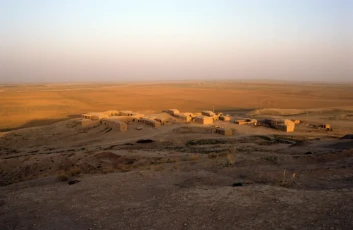
Village of Tall Hamidiyya with excavation house (left)

In the storage and living area of the Bedouin tent in ad-Duwaym
The old woman is wearing a belt of tablet weaving.

Az-Zawiya al-Hilaliyya, wooden cells inside the prayer hall's iwan
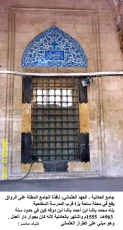
Jamiʿ al-ʿAdiliyya, prayer hall - one of the windows on the northern facade

Tall al-Biʿa, view from afar
[Original: Blick auf Tall al-Biʿa]

View of the Tetrapylon at the sunset
[ Description by author: Abendstimmung. Gesehen von ~ Nordosten - der GPS-Tag ist approximativ ! ]

Topographical map collection "UAR North (Syrian) region, district El Furāt" of 1960
Photographic reproduction of a topographic map of ar-Raqqa area, scale 1:25.000 (Partley corrected by hand into scale 1:20.000). Based on combined contour/ stereo-topographic survey of 1959. Clarke's ellipsoid of 1880. Lambert's coordinates system (Levant's zone). Mediterranean height system (Beirut's)

Great Mosque, view at courtyard in 2018
View of the inner courtyard during the restoration works and the rubble processing, especially the rubble of the destroyed minaret.

Damascus, Khan Asʿad Basha al-ʿAzm, vaulted arcade

A side from the Citadel of Busra
[Originalbeschriftung: HQ-k.K7]

Qanawat, Relief on a rectangular basalt stone

Lower village of Afamiya with the museum in an Ottoman khan and village houses

Kharbaqa Dam: One of the dams that were built to limit seasonal flood waters in the Badiyya

Agricultural terraces in The Anti-Lebanon Mountains

Salkhad, Archaeological remains in a vineyard

Columns with Corinthian capitals- The Great Colonnade at Afamiya

Maps of Aleppo: city center and historical suburban aereas, 1982
Thematic map of Aleppo city-center and historical suburban aeras, showing historical monuments. Scale 1:2000, ruler and legend, [Original in German: Aleppo: Innenstadt und alte Vorstadtquartiere | Karte 1 Westblatt & Ostblatt] Inventory no. stamp: Museum für Islamische Kunst Isl 85/31 /2 Berlin-Dahlem. Part of TAVO Reihe B Nr. 58

Jisr ash-Shughur, Qalʿat ash-Shugr wa-Bakas, a twin crusader castle, stone arch

Suq ad-Dahsha, general view of the suq

Aleppo Great Mosque, Courtyard, 2018
Sorting stones especially the minaret rubble

A side of al-Mudiq castle in Hama shows some of its towers

Harvest of cotton in ar-Ruj plain

Reuse of a Byzantine building as a residence, Sirjilla
[Original: Haus Nr. 17/18. Das höher gelegene Haus Nr. 18 mit einer teilweise noch stehenden doppelgeschossigen Säulenvorhalle ging zeitlich dem Haus Nr. 17 (6. Jh.) voraus.]

Decorated wooden panels of the Aleppo Room, Museum for Islamic Art, Berlin (1601-1603).

Al-Bara, Pyramid Tomb A, 6th century
The Mausoleum A with its pyramid-shaped roof lies in the middle of oil plantations. The wealth of the region was based on the production of olives.

The facade of the church, Ibn Wardan Palace
[Original: Kirche (Kuppelbasilika mit Emporen, Innenraum)]

Jamiʿ at-Tawashi, east facade - one of the two columns which frame a window

At-Takiyya al-Mawlawiyya, prayer hall (old Midan)

Abdelraouf Baydoun working with the craft of ‘Ajami in his workshop in Malaysia

Burj as-Saʿa, general view

Qalʿat Salah ad-Din located in the coastal mountain forests

A view of the Orontes river near Darkush

Burj Alaʾ, general view of the tower

General view of Halabiyya ruins

Jamiʿ al-ʿAdiliyya, prayer hall's entrance - muqarnas details
[Original:'Jâmi' al-'Âdiliya,Halab / Aleppo. "Muqarnas" über dem Eingang. Vgl. Bild 1221.'] !

Raqqa - "East of Raqqa" site - Western Palace - finds
Westpalace; Find Nr.12240

Excavation work inside ad-Daydariyya cave

Monastery of St Simeon Stylites, Narthex of south basilica (south façade of church)

A side of Palmyra Theater, 2nd c. AD

Raqqa - "East of Raqqa" site - Tall Aswad, excavation in 1985
[1985/72/988] = [photo's name as: year/ film no./ photo no.]

Main entrance of Ibn Wardan Palace
mit reicher Verzierung und Inschrift, gesehen von ~ Süden. Noch steckt es etwa zur Hälfte im Sand .......

A view of the Anti-Lebanon Mountains covered with snow

Bimaristan Arghun, octagonal courtyard - fountain

Bab al-Hadid, general view of the gate's tower with its machicolations and parapets

Arch of Triumph (Qaws Hadrian) from the outside
[ Description by author: Unter "Außenseite" ist hier und im Folgenden immer die Südostseite zum 1. Abschnitt der Säulenstraße zu verstehen, unter "Innenseite" die Nordwestseite zum 2. Abschnitt (= Bogen > Tetrapylon) der Säulenstraße.- Der Bogen stammt aus der Zeit des Septimius Severus, also um ca. 200 n. Chr. ]

Orchards in the city of Harim

Bayt Junblat, southern iwan - decoration of faience tiles

Facade of the turbine house of Assad dam of the Euphrates, whose supplies large parts of Northern Syria with electricity

Courtyard of family wing (so called haramlik or jummwani) in Asʿad Basha al-ʿAzm Palace

Mausoleum of ash-Shaykh Khalid an-Naqishbandi
["Nr.A"] (see catalogue-no. A; in: Meinecke, Michael, in: Damaszener Mitteilungen I/1983)

Khan Qurdbak, eastern portico

Madrasat al-Firdaws, the marble prayer niche (mihrab) decorated with floral and geometric motifs

An olive grove in the Ghouta of Damascus
A scenary in the Ghouta of a field filled with perennial olive trees. It seems, from the ladder leaning on a tree, that it is the harvest season.

Khan Qurdbak, southern portico - Mamluk rank

Qal‘at (castle) Shayzar from the inside

A general view of the remains of Shayzar Castle
View at Qalʿat Shayzar with Qalʿat al-Madiq

Raqqa - excavations at the site "East Raqqa" - the northern complex
[ 87/ 59/ 1789] =[ photo's name as: year/ film no./ photo no,]. On the back of the photo: [87/59].. (Naming the area of the photo was done according to the list, although some they are similar but were done in different areas.)

Khan al-Jumruk, doorway

The northern wall of the Damascus Citadel

View from Qalat al-Mudhiq to the lower village and the Ottoman Khan in the Orontes plain

al-Malikiyya - ʿAyn al-Khadra, Basalt Tomb with arabic inscription

A view from the west to Harim Castle

Raqqa - remains of the southern arcade of al-Jamiʿ al-ʿAtiq (Great Mosque)

Aerial view of the desert in Badiyat ash-Sham

Halabiyya, entrance to the Praetorium, which is integrated into the city wall and dates from the time of Justinian.

Bayt Dallal, decorated stone at the iwan stair
[Original: Steingitter d. Kellerfensters v.d. Liwan]

The foothills of Antilibanon- Mountains overlooking the Zabadani plain

Warp threads in a mechanical loom, textile factory of the Mezannar family in Damasus

Al-Madrasa al-Hallawiyya, entrance - Zengid inscription in Naskhi script

The historical centre of Maʿlula with St. Lawandius Church and hillside houses facing the valley

Courtyard and Iwan of al-Quwatli House
Hof mit Bahra u. Liwan

Al-Madrasa al-Hallawiyya, entrance - Ottoman inscription above the gateway

Raqqa - Jar discovered at the site "East Raqqa" - the northern complex
Ra-O-NK. 146, Ceramic. [original: 'Keramik']. [original:' s. unten Nr. 18'].[ 89/54/863] =[ photo's name as: year/ film no./ photo no,].

Waterfall of Zayzun in the Yarmuk valley in 1918
[Original: 'Wasserfall von Zezun im Jarmuktal']. The Bavarian air force division 304b was based in Palestine from 25. October 1917 and was involved in the First World War until the division left the region, over Aleppo, in mid September 1918. During that period, over 3000 glas photographs, mostly aerial, have been made. Those early photographs were important for the archaeological research in the Middle East.

shap_import_64479

An olive and vegetable grove in the Ghouta of Damascus

A part of the ground and upper floor, Khan Asʿad Basha al-ʿAzm

Jamiʿ al-ʿAdiliyya, general view of the prayer hall

Al-Madrasa al-Hallawiyya, Corinthian capital
[Original:'Al-Madrasa al-Halâwiya, Halab / Aleppo. Kapitell von der äußersten Säule rechts des Konchos.'].

Small river in Baniyas

Deserted houses in Jabal al-Hus south of Aleppo
View at a group of abandoned, deserted dome houses appear to be in a poor condition.

Public street life in Raqqa

Hammam al-Bayyada, general plan

Bayt Junblat, northern iwan

Orchards in the Anti-Lebanon Mountains
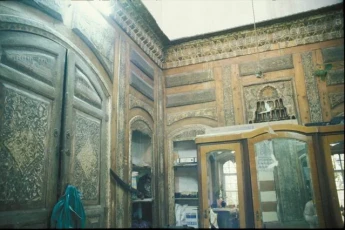
‘Ajami decoration in Bayt Nabulusi in Damascus
shap_import_97590

A seller of diesel fuel, Raqqa

Jamiʿ at-Tawashi, eastern facade

Destructions in Raqqa city center, 2018
The modern city was heavily destroyed by bomb attacks on the "capital" of the IS in 2017.

Al-Madrasa al-Muqaddamiyya, a groin vault in the entrance
shap_import_65983

Vineyard in the Ghuta of Damascus
The farmers in the Ghuta used some techniques and agricultural processes including grafting. The vine was grafted with white, black and red grapes.

Waqf of Ibshir Mustafa Pasha, Coffeehouse, view on the roof
Large central dome, surrounded by small domes and cloister vaults.

Busra - Masjid Yaqut (mosque) - the exterior facade and the entrance

Khan Qurdbak, general view of the courtyard and the porticos

Busra - Madrasat Abu al-Fidaʾ - prayer hall

Az-Zawiya al-Hilaliyya, wooden prayer niche

Sacrophagi decorated with sculptures of the dead

Hammam Bahram Basha, dome of the cold section (barrani)

Bayt Junblat, courtyard and northern iwan

Syriac tombs in Jabal ʿAruda

The barrani (frigidarium) section of Hammam Manjak, Busra
Domed room of the reception wing, view from east

View to the south from ad-dalati street.

At-Takiyya al-Ikhlasiyya (az-Zawiya ar-Rifaʿiyya), entrance of the prayer hall
shap_import_65805

Mosaics covering the tympanum of az-Zahir Baybars Mausoleum
[Original: Zahiriya, Mausoleum des az-Zahir Baibars, 1277, Glasmosaiken im Tympanon]

The stage of Roman Theatre and the Ayyubid Citadel, Busra
[Original: Theater, Bühnengebäude (wahrsch. spätes 2. Jh.)]

Raqqa - "East of Raqqa" site - Western Palace - excavations
[ 87/ 59/ 1772] =[ photo's name as: year/ film no./ photo no,]. On the back of the photo: [87/59].. (Naming the area of the photo was done according to the list, although some they are similar but were done in different areas.)

A view from a high peak of the Anti-Lebanon Mountains


General view of ʿAyn as-Sahib
[ Description by author: Auf dem linken Hang. Zu dem links oben und in der Mitte s. Bild 0408 ! Ob sich unter dem Felsüberhang weiter nach unten und rechts auch ein Grab befindet ? Die Felswand gleich über den Bäumen links wirkt auffallen geglättet, in Petra würde ich sagen "vorbereitet" ....... ]
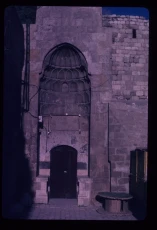
Al-Madrasa al-Kamiliyya, portal gate

Installation of dyed warp threads for weaving in the textile factory of the Mezannar family in Damascus

Women wearing screen-printed headscarfs (Habari)

An orchard in the Ghuta of Damascus

Bab al-Hadid, general view of the gate's entrance from inside

Jabal ʿAruda on the right bank of the Euphrates

Suq ad-Diraʿ, general view of the suq
Souq al-Abba/Souq ad-dra????
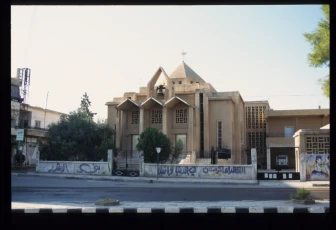
Church of the Armenians in ar-Raqqa

View from west at al-Kilaniyya historic quarter and al-Baz noria (waterwheel)
Rare view of the now vanished quarter (destroyed in 1982) on the right bank of the Orontes. [Original description: Hama quartier Kaylani] Note: these photos were taken between the year 1924 - 1939. The chosen date is to be average. (photographer unkown)

The Mihrab of at-Taynabiyya Mosque
[ Description by author: Der Mihrâb oder ein Mihrâb der Moschee. Vermutlich konnte ich ihn nur sehen, weil sich die Moschee in Restauration befand. ]

Roman bridge in at-Tayyiba over the course of the Wadi az-Zaydi

Al-Madrasa al-Ahmadiyya, capital

Madrasat al-Firdaws, a grave on the east of prayer hall

The Mount Hermon covered by snow
[Original:'Hermon-Gipfel, mit Schnee bedeckt, rechts im Hintergrund der Antilibanon']. The Bavarian air force division 304b was based in Palestine from 25. October 1917 and was involved in the First World War until the division left the region, over Aleppo, in mid September 1918. During that period, over 3000 glas photographs, mostly aerial, have been made. Those early photographs were important for the archaeological research in the Middle East.

Bab Antakiya, inscription above the city gate

At-Takiyya al-Ikhlasiyya (az-Zawiya ar-Rifaʿiyya), courtyard

Al-Madrasa ash-Sharafiyya, the entrance from the interior

Palmyra, Colonnaded axis and Qalʿat Ibn Mʿan in the back

View on the Euphrates river from Dura Europos
Blick von der Abrutsch-Kante nach ~ Osten in die Euphrat-Auen.

View the northeast corner of the Agora
[ Description by author: Blick von ~ Osten auf die Nordost-Ecke der Agora (Forum) und in den ihren Innenhof mit Resten von Säulen der Portikus. Links geht es zum Annex, zum hohen Portal rechts vgl. Bild 0705 ! ]

Citadel of Aleppo, general view of the south bastion facade

In the chruch Saint Simeon Stylites, 5th century AD
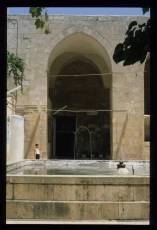
Jamiʿ ar-Rumi, view from the courtyard on the eastern arcade

The inner western facade of ad-Dumayr Temple
[ Description by author: Detail aus Bild 0390: der Durchgang und die beiden "Kammern". ]

Suq az-Zarb, view towards east of the suq after the destruction

Jamiʿ ash-Shuʿaybiyya, zig-zag pattern

Traditional houses in a village, near the Sajur river

Front facade of famous Hotel Zenobia in the ruins of Palmyra

Excavation in the citadel of Damascus

ThMap of the irrigation oasis of Damascus in 1969
The irrigation oasis of Damascus - attempt a summary display. Ledend and ruler. [Original: Die Bewässerungsoase von Damaskus - Versuch einer Überblicksdarstellung]

Al-Madrasa as-Sulaymaniyya, courtyard with fountain, arch arcades and mosque
[ Description by author: Blick über den Innenhof mit dem Wasserbecken von der Moschee nach ~ Nordosten. Vgl. Bild 0128 und 0129 ! ]
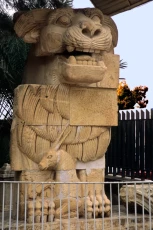
Lion of goddess Al-Lat, 1st c. AD
The lion was embedded in the outer wall of the Al-Lat temple. As a protector of an antelope it is a symbol of peacefullness. The stone statue was severely damaged by ISIS.

Transporting sugar beets in al-Ghab Plain
[Original: Zuckerrübentransport im Ghab]

Habuba Kabira, to make burghul (wheat grits) the wheat is cooked in a huge pot and then carried to a drying place

General view of the town of Maʿlula
[ Description by author: Gesehen vom linken Berg - GPS-Tag approximativ - nach ~ Nordosten auf den Ortskern. Unten links die Masjid Ma'lûlâ, oben links das Kloster Mâr Takla und links davon der Eingang zum Fajj Mâr Takla. Hinter dem Ganzen der "rechte" Berg und das Plateau. ]

Lintel of the entrance of a hall in the roman religious complex, Mnin
[ Description by author: Detail aus dem Türsturz der kleinen Halle. ]

Jabla, Mosque of Sultan Ibrahim, Arabic calligraphy

Bayt Junblat, door in the centre of southern iwan
[Original:'Qasr Jumblât, Halab / Aleppo. Iwân des Süd(?)flügels: die mittlere Tür.].

Part of Qaws Hadrian (Arch of Triumph) from the inside
[ Description by author: Linker Ansatz des großen Bogens der 2. "Scheibe". ]

Aleppo, Khan as-Sabun, view at eastern arcade in the first floor

Weekly market in Maskana, at the end of a sales day

Wedding party in a street in Mukhayyam al-Yarmuk in Damascus
Wedding party

Busra - Jamiʿ (mosque) al-Mabrak from the outside

View of al-Mudiq castle overlooking the plain of al-Ghab

Raqqa - "East of Raqqa" site - Tall Aswad, excavation in 1985
Tall Aswad

A traditionally crafted tapestry weave

Raqqa - Madinat ar-Rafiqa wall - one of the wall tower
[original: Stadtmauer / Innenseite. Turm 80']. [83/72/12] =[ photo's name as: year/ film no./ photo no,]. on the back of the photos: [83/72]

Astrological relief panels on the ʿAyn Diwar bridge

Archaeological objects, ar-Raqqa Museum

Habuba Kabira, building a cantilever dome house - in the foreground clay bricks, which are to be used soon

Al-Madrasa az-Zahiriyya, interior view of eastern facade - Iwan

Ruins of the wall of Qalʿat Shumaymis (castle)

Al-ʿArus minaret of the Umayyad Mosque

½ piastre, 21 mm, 1921 (French Mandate)

Jamiʿ Aslan Dada, interior view of the prayer hall (qibliyya)

Minaret of al-Imam Ismaʿil Mosque, as-Salamiyya
Gesehen von der Sâhat al-Hurriya nach ~ Südosten. Im Vordergrund zwei byzantinische Säulen mit Kapitellen, vermutlich aus einer Kirche. [Original: 'Salamiya (Salamias)']

Decoration of the qaʿa (guest room) in the Quwatli House
Kämpferkonsole in der Qa'a

Maronite Cathedral, one of the cathedral pointed towers

Khan al-Jumruk, general view of the mosque in the center of the Khan's courtyard

The historical sulfur spring of Afqa
[ Description by author: Beim Austritt des Kanals, Blick nach ~ Nordosten. Vorn rechts die "Treppe", links ein Altar, hinten die Säule und links von ihr noch ein Altar. ]

The facade of the church, Ibn Wardan Palace
[Original: Kirche (Kuppelbasilika mit Emporen)]

Tall Bdiri, Abondened house with buttresses in the wall and at the door

Excavation work, Madinat al-Far

Jamiʿ al-Utrush, general view of western facade and minaret

Jamiʿ Aslan Dada, view of the prayer niche

Bayt Wakil, floor tiles

Jabʿadin, the rock wall at Sinnir mountain

Archaeological finds from Raqqa, exhibited in the Damascus National Museum
Pottery from ar-Raqqa; National Museum Damascus

Al-Madrasa al-Ahmadiyya, dome of the prayer hall

Jamiʿ al-Mihmandar, prayer hall entrance

Jabal al-ʿArab, natural landscape of volcanic mountain

Outlining and shadowing of motifs of a contemporary ‘Ajami decoration
Abdelraouf Baydoun in his workshop in Malaysia

Ploughing at a grove in the Ghouta of Damascus

al-Utrush Mosque, general view of western facade and entrance

Takiyyat ash-Shaykh Abu Bakr, the iwan facade and the courtyard

Hammam an-Nahhasin, the warm section (wastani)
The middle part (wastani) in the public baths is a section of moderate temperatures, and consists, in an-Nahhasin bath, of chambers, iwans and niches. In this niche there are three stone basins for washing. The walls are covered with modern ceramics that change many of the features of the Ayyubid bath. The floor is paved with colored marble tiles in the middle that form simple geometric decorations.

Jamiʿ al-ʿAdiliyya, prayer hall entrance - floral motifs decorating a column

Qalb Lawza, Basilica of 5th c., view from nave, facing east to apse

Raqqa, Baghdad Gate, Façade decorations: three-lobed niches and arched frames resting on colonnette

View of an orchard in the Ghuta of Damascus

Raqqa, Qasr al-Banat, courtyard with northern Iwan
[ G 88/ 19/ 240] =[ photo's name as: year/ film no./ photo no,].(ref. http://www.esyria.sy/eraqqa/index.php?p=stories&category=todayimg&filename=201003152100042)

Making falafel sandwiches

Raqqa, Qasr al-Banat, Capital with plant motifs

Az-Zawiya al-Hilaliyya, the entrance
shap_import_63346

Al-Madrasa al-Hallawiyya, domed prayer hall which houses parts of the 5th century cathedral

Hama, general view of the Jisriyya (waterwheel)
Note: these photos were taken between the year 1924 - 1939. The chosen date is to be average. (photographer unkown)

At-Takiyya al-Ikhlasiyya (az-Zawiya ar-Rifaʿiyya), inscription above the prayer hall entrance

East and south side of the cella of Bel Temple

At-Takiyya al-Mawlawiyya, minbar in the prayer hall (Samah Khana)

Baalshamin Temple, view from east

A village on the foothills of the coastal mountains (al-Jibal as-Sahiliyya)

Bayt Ghazala, fountain in the main hall (qaʿa)

Bimaristan Arghun, view of the main courtyard and the portico

A street scene in one of the suqs of Dayr az-Zawr

Ar-Raqqa, city wall, showing an arched gate and two towers

Qalb Lawza, Basilica of 5th c., Apse and south façade
[Original: Basilika, vor 469, SO-Seite]

Maronite Cathedral, a cross shaped window

Children are preparing themselve for a wedding procession. The two small children are still wearing their school uniform

Arch of Triumph (Qaws Hadrian) from the outside
[ Description by author: Der Bogen kaschiert einen Straßenknick von ca. 25° nach links von ~ Nord-Nord-West nach ~ Nordwest. Er besteht aus zwei "Scheiben", jede rechtwinklig zum entsprechenden Straßenabschnitt. Der Grundriss bildet also ein "V" mit der Spitze links. Jede "Scheibe" hat drei Durchgänge, aber nur bei der hinteren ist der höhere mittlere Bogen erhalten. Zwischen den "Scheiben" vertrittt Mauerwerk die Säulen, links (hier verdeckt) mit einer Öffnung, rechts mit zweien. Auf dem Bild sieht man den Knick von außen: die Säulenbasen links vorn gehören zum 1., die Säulen links hinten zum 2. Abschnitt der Säulenstraße. Um die vordere "Scheibe zu rekonstruieren, muss man eine Linie vom Bogen links zum Bogen rechts ziehen und sich darüber den zweiten hohen Mittelbogen vorstellen. Vgl. Bild 0663a ! ]

Maps of Aleppo: "Historical succession of buildings", 1982
Thematic map of Aleppo ancient city-center: Historical succession in current building stock. Scale 1:2000, ruler and legend. [Original in German: Historische Abfolge des Baubestands] Legend: Pre-Mamluk, Early-Mamluk, Late-Mamluk, Early-Ottoman, Late-Ottoman, Post-Ottoman until 1918

An artificial canal in Raʾs al-ʿAyn

Habuba Kabira, construction of a mud brick house before the circular of the domes is started

Bayt Wakil, iwan

Bayt Wakil, section drawing of the hall facade
Size of plan 30 x 26, no scale.

Al-Bab ash-Sharqi (Eastern citygate), the eastern entrance to Old City of Damascus
[ Description by author: [Original: Gesehen von ~ Südwesten. Es bildete das östliche Ende der Geraden Straße, deren ursprüngliche Struktur hier noch gut zu erkennen ist. Alles Drumherum ist modern.- Khâlid Ibn al-Walîd betrat Damaskus bei der Eroberung 634 durch dieses Tor. Vgl. Bild 0324 !] ]

Khan Qurdbak, iwan of the Mamluk palace

Making pickles

Al-Kilaniyya neighborhood in Hama
A general view that shows the historic an-Nuri Mosque and in front of it the set of al-Kilaniyya norias on the left bank of Orontes River.

On september 14th at the Holy Cross Feast in Maʿlula, with the standard of the Holy Cross Youth

Qanawat - Roman nympheum

Bayt Junblat, southern iwan (the great iwan)

The Great Colonnade, Palmyra

Excavation works, Dura Europos (Qalʿat as-Salihiyya)
Side of the Excavation

Minaret and exterior wall of the Great Mosque of ar-Raqqa/ar-Rafiqa, 8th/12th c.

Terrace with portico in the upper floor, Qasr al-ʿAzm

Jamiʿ al-Khayr, the entrance from the inside

Entrance door of the textile factory of the Mezannar family

Jamiʿ al-ʿAdiliyya, one of the flying buttresses supporting the prayer hall dome

Busra, Hammam Manjak, Islamic Museum

Capital of column, courtyard of Bel Temple
[ Description by author: Kapitell. Auch von der Höhe her der ideale Gartentisch ....... ]
![Tall Brak (Nagar), ruins of Naram-Sin Palace, 3rd millennuim BC. [Original photo name: naram sin palace2]](https://syrian-heritage.org/wp-content/plugins/justified-image-grid/timthumb.php?src=https%3A%2F%2Fsyrian-heritage.org%2Fwp-content%2Fuploads%2F2020%2F06%2Fshap_import_44760.webp&h=230&q=90&f=.webp)
Tall Brak (Nagar), ruins of Naram-Sin Palace, 3rd millennuim BC. [Original photo name: naram sin palace2]
shap_import_44760

Busra, general view of the old city.

In the southern part of Tall Abyad, remains of the church made of mud bricks

View of a group of monumental buildings in Palmyra, Theater, Agora
[ Description by author: Hinten Mitte das Theater und die Rundstraße um die Cavea. Davor links die Agora mit ganz links dem Bankettsaal. Rechts der Agora der Annex. Blick nach ~ Nordosten. ]

Plan of The Baths of Diocletian
[ Description by author: Extremer Ausschnitt aus einem Stadtplan. ]

ʿAyn al-Khadra, Village school from mud bricks, not used any more

The Royal Palace G, Ebla (Tall Mardikh)
Mittlerer und oberer Teil. Gesehen nach ~ Südwesten [Original:Tall Mardîkh (Ebla)']

One of the entrances in Qalʿat Salah ad-Din (castle)

Busra - Hammam Manjak - Restoration works
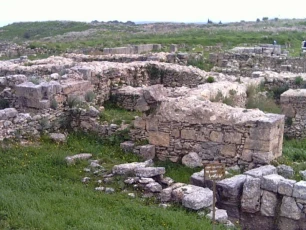
A side of architectural remains, Ugarit
shap_import_74018

Raqqa - the excavations of the site "East of Raqqa" - Eastern Palace
Eastern East Palace, reconstruction
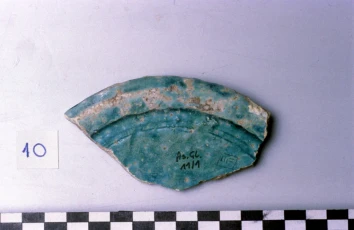
Raqqa - "East of Raqqa" site - Tall Aswad - glazed pottery
Tall Aswad; Glazed Pottery; ROM 10

Turbat Khaʾirbak (mausoleum), section from the interior (the courtyard)
size of plan 21 x 15 . scale 1:100 .

at-Tabqa, Jaʿbar Castle, Towers of western walls

Maʿlula, traditional hillside houses with galleries during the 1960s

Raqqa, Tall Aswad, stucco

Khan al-Jumruk, interior facade of the khan's entrance

Great Mosque, Minaret
The minaret of the Great Mosque was commissioned by the judge (qadi) of Aleppo during the rule of the Seljuk dynasty in Syria. The beginning of its construction is indicated in the inscription at the base and the completion date is found at the top: 483 and 489 AH[11] / 1090 and 1096 AD. It existed until 2013. The minaret is a square shape, its shaft is approximately 45 m high and made of limestone. On its upper edge, there is a cornice formed by two rows of flat arched niches lavishly adorned by floral elements. This is topped by an open wooden gallery for the muezzin (prayer caller) and a short tower with cupola. Between the base and the top, the minaret is divided into four zones of varying height. Those are, except for the second one, decorated with blind arches formed by profiled mouldings each running uninterruptedly around the minaret’s shaft. Each zone is separated by friezes with calligraphic, artistically written, Arabic inscriptions. These exquisitely carved inscriptions are written in floriated Kufi – a script style distinguished by bold letters adorned with floral motifs – and in Naskhi script. At the base of the minaret is the signature of the architect Hasan ibn Mufrih al-Sarmani written inside a cartouche. The inscription from the minaret’s base shows that the local Aleppine judge and the Seljuk governor shared power in the city, as their names are mentioned together: “The mosques of God are only to be maintained by those who believe in God and the Last Day and establish prayer and give zakat [(alm-tax); Quran 9:18]. It was started to be built by the High Judge Ibn al-Khashshab Muhammad ibn Muhammad al-Khashshab, may God have mercy on him. In the days of al-Amin al-ʿAjal al-Muzaffar Qasim al-Dawla wa-Nasir al-Mila Abi Saʿid Aqsunqur Bak, the slave of the Commander of the Faithful, may God enhance his supporters”. The upper inscriptions indicate the names of the then ruling Seljuk sultans Malikshah I and Tutush, and of Barakat ibn Faris, commander of the urban militia.

Modern interpretations of the traditional craft of ‘Ajami (workshop of Aliya Alnuami)

Qal‘at Shayzar ( Citadel), An Arabic inscription on top of the citadel entrance.

Propylaea of Jupiter Temple, Damascus
[ Description by author: des Períbolos des ehemaligen Tempels des Jupiter Damascenus, gesehen von ~ Osten (= Innenseite). Am Tympanon ist rechts zu erkennen, dass es sich um einen "Syrischen Bogen" handelte. Vgl. Bild 0151 und 0152 ! ]

Roman capital in the great mosque (al-Jamiʿ al-Kabir), Maʿarrat an-Nuʿman
Spolie am größeren Bau im Hof. Auch hier zweifle ich - wegen der Assymmetrie - ob es sich ursprünglich um ein Säulenkapitell handelt. Und die "Flachheit" des Dekors - kein Akanthus-"Korb", sondern eher ein "übergezogenes Netz", läßt an frühe arabische Kapitelle (z.B. 'Anjar) denken ....... [Original: Ma'arat an-Nu'mân (Arra)']

Al-Madrasa az-Zahiriyya, general view of the main facade and the entrance

Ceiling ornament, Asʿad Basha al-ʿAzm Palace

Jamiʿ al-Maydani, the minaret

Hammam Bahram Basha, the main northern facade

The back arch belongs to the Great Colonnade
[ Description by author: in der Säulenstraße beim südöstlichen Abgang der Rundstraße ums Theater. Der hintere Bogen gehört zur Kolonnade, der vordere entspricht der Linie der Häuserfronten. Gesehen von ~ Südwesten. ]

Part of the northern wall of the Damascus Citadel

Waqf of Ibshir Mustafa Pasha, Coffeehouse, the hall
The core of the hall was only partially damaged, while the section of the central dome with its high lantern was, for the most part, destroyed.

Habuba Kabira, water reservoir for field-irrigation, in the background motor pump of the well

Al-Madrasa al-Ahmadiyya, column with its capital

Bimaristan an-Nuri, door puller of main wooden entrance door

Remains of Islamic Jaʿbar castle
Note: these photos were taken between the year 1924 - 1939. The chosen date is to be average. (photographer unkown)

Ghouta of Damascus, collecting of hemp in 1970s

Popular restaurants on both banks of the Barada River

Mausoleum az-Zahir Baybars, mosaics covering the southern wall

Graves upon Jabal ʿAruda

Madrasat al-Firdaws, inscription

View from east to the west-north

Temporary title for Image 120244

Fresco above the apse of the church, Monastery of Mar Musa al-Habashi
[ Description by author: Triumphbogen über der Apsis, linker Teil und Mitte (Fortsetzung s. Bild 0488 !). Phase III. ]

Al-Matbakh al-ʿAjami: Qaʿa, section east-west, view to south
Qaʿa of Matbakh al-ʿAjami, size of plan 55 x 45, with ruler (no scale).

General view of Qalʿat Ibn Maʿn
[ Description by author: Tele + Ausschnitt. Blick von ~ Südosten. Der Standort muss nicht der angegebene sein: jeder Punkt auf dieser Linie zwischen Hauptstraße und Stadtmauer ist möglich ....... ['Zenobia Hotel (?),'] ]

Windows above the western entrance of the Cathedral, today Tartus Museum
[Original: "Kathedrale Nôtre-Dame, zwei Fenster über dem Portal und ein krönendes drittes Fenster werden von eingestellten Säulen und Archivolten gerahmt"]

A man weaving textiles with a pit-loom in Hama

Takiyyat ash-Shaykh Abu Bakr, general view from outside
Note: these photos were taken between the year 1924 - 1939. The chosen date is to be average. (photographer unkown)

A side from the ruins of Halabiyya

Arch of Triumph (Qaws Hadrian) from the inside
[ Description by author: Blick zurück aus dem 2. Abschnitt der Säulenstraße nach ~ Südosten. Im Hintergrund der Bel-Tempel. ]

Al-Madrasa az-Zahiriyya, courtyard and arched arcade
shap_import_66073

Great Mosque, prayer hall, Shrine of the Prophet, ceramic tiles Zakariya
shap_import_60397

Roman sarcophagus with decorations, Qanawat

Bimaristan Arghun, southern courtyard - view the dome pendantives and the iwan

Burj Alaʾ, general view of the tower's western facade
shap_import_63412

Part of a decorated wooden door with ‘Ajami decoration from the Damascus Room in the Dresden Museum for Ethnology
Frame of the large wall cupboard door (samandāra) of the Damascus Room in the Dresden Museum of Ethnology, with a flat, white-ground strip for fixing the hinge

Jamiʿ al-Mihmandar, the prayer niche

Habuba Kabira, shell of the dome house made of dried clay bricks with quarry stone base

Hubert Mezannar, son of Antoine Elias Mezannar. In the background is the certificate of a gold medal, the family won in 1936 on an international fair
At the beginning of the 20th century, Antoine Mezannar brought mechanical looms from Lyon with electric motors to Damascus and became one of the first consumers of electricity in Damascus.

This view of al-Madrasa az-Zahiriyya shows the dome with two drums
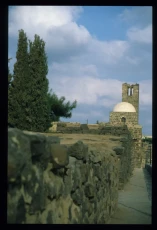
Busra, Madrasat Abu al-Fidaʾ, known as "Jami ad-Dabbagha'

Interior view of the cathedral of Our Lady of Tortosa, Tartus museum today

Khan al-Wazir, decoration and windows on top of the internal facade of the khan's entrance
Exterior view, front

Jurn Kabir, a tawny owl, which occurs there frequently

Northern Palmyrenean chalk heights, lonely Atlantic pistachio in the riverbed of a dried-up wadi

Busra - al-Jami‘ (mosque) al-ʿUmari - courtyard surrounded by arcades

ʿAyn al-Khadra, residential house with a central hall plan of a Kurdish family in the Malkiyya-Region

Al-Madrasa al-Muqaddamiyya, a groin vault in the entrance
Inscription of foundation in 1168, oldest Inscription in Naskhi in Aleppo

Al-Madrasa al-Hallawiyya, courtyard - southern facade

Muzayrib - Ancient mill

Church of the monk Buhayra, Busra
[Original: Bahira-Basilika, paganer Profanbau des 3. Jhs. n.Chr., der später christianisiert wurde -Außenansicht]

Aleppo: multi-colored facade of Mamluk-Ottoman Hammam Yalbugha an-Nasiri
A view of the exterior façade of Yalbugha bath decorated with alternating black and yellow rows. The entrance is high with beautiful ranks on top and many windows on the sides. The large, high dome contains windows for the light to enter inside.

Muzayrib - Ancient mill

The minaret of Jamiʿ (Mosque) ash-Shaykh Muhyi ad-Din Ibn ʿArabi
[ Description by author: Da dieses Bild von der Filmnummer zwischen dem Darwîsch-Kloster (Bild 0356) und der Moschee Shaikh Mûhi d-Dîn al-'Arabi (Bild 0358) steht, dürfte es sich um das MInarett eines der beiden Gebäude handeln. ]

Mausoleum of az-Zahir Baybars, colorful marble niche

Remains of Islamic Jaʿbar castle
Note: these photos were taken between the year 1924 - 1939. The chosen date is to be average. (photographer unkown)

At-Takiyya al-Mawlawiyya, carved decoration on the exterior facade

Aleppo: Citadel, Palace, 13 C.
![Tall Brak, one of the earliest and largest cities in northern Mesopotamia during the 4th millennium BC [Original photo name:eye temple4]](https://syrian-heritage.org/wp-content/plugins/justified-image-grid/timthumb.php?src=https%3A%2F%2Fsyrian-heritage.org%2Fwp-content%2Fuploads%2F2020%2F06%2Fshap_import_44758.png&h=230&q=90&f=.png)
Tall Brak, one of the earliest and largest cities in northern Mesopotamia during the 4th millennium BC [Original photo name:eye temple4]
shap_import_44758

Al-Madrasa as-Sultaniyya, inscription band above the window of al-Malik az-Zahir Ghazi tomb

Raqqa, Tall Aswad, small finds

The window of cella, Baalshamin Temple, 2nd century AD
[ Description by author: Das Cella-Fenster von Bild 0786, gesehen von Nordosten. ]

Khusrawiyya-complex, view of the Mosque in 2010

Port expansion in Tartus
Extension of port, working with cranes

Lateral iwan in the Dada House
Seitenliwan

A circular skylight opening of Khan Asʿad Basha al-ʿAzm's courtyard (collapsed central dome)

Suq al-ʿAttarin, view to west showing the destruction
This lane of the Great Bazar was specialized in spices, herbs, and essential oils. It burnt down in December 2012.

Khan al-Wazir, main entrance and the northern wall after widening the street

The Pigeons, old city of Damascus
A flock of pigeons flies over the old City
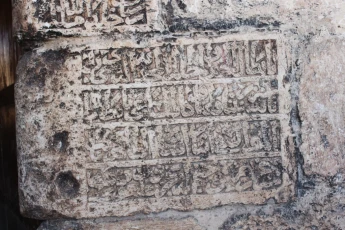
Qal‘at Shayzar ( Citadel), An Arabic inscription.

Waqf of Ibshir Mustafa Pasha, Coffeehouse, interior
The hall has a rectangular ground plan. Based on a square middle room, it is divided by 12 pillars, all spanned by pointed arches, into 20 compartments of two different forms: two narrow oblong ones each on three sides of the central area (see picture 5) and two smaller square ones each in the adjacent corner areas. Between the pillar pairs that frame an oblong compartment stands a column each with octagonal shaft and multifaceted capital, which is formed by small geometric cells (muqarnas). Towards the side of the windowed entrance wall, the hall is only one bay deep. The courtyard side with its second row of pillars functioned as a kind of entrance portico, being once opened by four high pointed arches within the outside wall. The central area is covered by a high dome. Supported by four massive pillars, it rests on muqarnas pendentives – triangular-shaped with tiered rows of geometric cells –, and is topped by a round lantern with small columns plus pointed cupola. The other parts are covered with elongated, flattened vaults and small domes according the respective compartment form

One of the entrances in Qalʿat Salah ad-Din (castle)

Khan Qurdbak, entrance - wooden door covered with iron

Google earth- al-Husn Church 2017

Maronite Cathedral, the altar

Bimaristan Arghun, entry portal detail

Drawings by Estibaliz Sienra Iracheta to illustrate processes of traditional textile manufacturing

The arcade wall of Great Mosque of Raqqa-Rafiqa, 8th/12th C.

Al-Madrasa as-Sultaniyya, view of eastern window of al-Malik az-Zahir Ghazi tomb
The window topped by an inscription panel

Al-Madrasa az-Zahiriyya, prayer niche
shap_import_66087

General view of Shumaymis Castle
Teleausschnitt aus Bild 1038, gesehen entweder von dem dortigen Standort oder von dem hier angezeigten aus ~ Südosten. . [Original: Qal'at ash-Shamîmîs']

The northwest corner of the portico, Temple of Bel
[ Description by author: Die Nordwest-Ecke des Portikus. gesehen von ~ Südosten / Süden. ]

Afamiya, Northern Roman baths

Ruin of a double room house in the village Qalʿat Najm
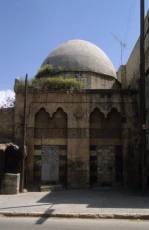
Turbat Khaʾirbak (mausoleum), western facade and dome
Chamber tomb with two chambers, Inscription from 1514

Bimaristan an-Nuri, small iwan

Jamiʿ at-Tawashi, general view of the entrance gate and the minaret room

A view into the main road of Raʾs al-ʿAyn

View of western facade of the Cathedral, today Tartus Museum
[Original: Kathedrale Nôtre-Dame, 1123 beg., von Saladin 1188 weitgehend zerstört, Ende 12. Jahrhundert Neubau, Westfassade]

Raqqa, Aerial photo of Hiraqla vicotry monument

Bimaristan Arghun, inscription

Jaʿbar Castle in at-Tabqa, bastion with loopholes.

Isometrie of the Royal Palace G, Ebla (Tall Mardikh)
[Original: Grabungszeichnung. Hier ist die Rampe (vgl. Bild 1190 !) als Rampe gezeichnet, dafür fehlt bei der Treppe in der Bildmitte die Fortsetzung nach oben]

Khan al-Hibal, general plan

Al-Madrasa as-Sultaniyya, interior view of southern facade - entrance and minaret

Al-Madrasa ash-Sharafiyya, the dome from outside
shap_import_66021

Al-Madrasa al-Hallawiyya, detail of Corinthian capital
[Original:'Al-Madrasa al-Halâwiya, Halab / Aleppo. Das "Windstoß"-Kapitell der Säule rechts der Tür.'].

Al-Madrasa al-Muqaddamiyya, an inscription above the entrance gate

A photo of the courtyard of Bayt Shaykh Qatana before demolition
Blick ü.d. Hof auf den Liwan

Great Mosque of Aleppo, prayer hall, door of the khatib (orator) room

Madrasat al-Firdaws, Decorative details of one of the arcade columns capital

Raqqa - excavations of the site "East of Raqqa" - Eastern Palace
Raqqa VII; Eastern East Palace

A photo showing tomb towers, part of modern city and the oasis

View, from south, at northern overbuilt part of Suq (bazaar) of Khan al-Harir (Picciotto house)

Bimaristan Arghun, view of main courtyard
shap_import_60891

Raqqa - "East of Raqqa" site - Tall Aswad - finds
85-AS-loc. 03. [ 87/ 65/ 1938] =[ photo's name as: year/ film no./ photo no,]. on the back of the photos ['87/65']

A view towards the Euphrates, Jabal ʿAruda

The Great Colonnade

Jamiʿ al-Mihmandar, the entrance half dome

The courtyard of an-Nuri Mosque

Tomb tower of Elahbel in the Valley of the Tombs
[Original: Südwestnekropole, Hypogäum der „Drei Brüder“, Mitte 2. Jh. erbaut, bis 259 belegt]

In the Euphrates valley in Jurn Kabir, shepherd herding the flocks of his village

Ar-Raqqa, view of a side of city wall

Reverse side of the ceiling of Bayt Ḫazīna-Kātibī / Niẓām with ‘Ajami decoration
View from above on the construction of the šīša-ceiling

the damage of the minaret and the west-south part of the mosque.

Inscriptions on a volcanic stone in Jabal Says

Al-Madrasa al-Hallawiyya, entrance - a stone base (spolia) which is the cathedral baptismal font.

The semi-circular towers of ar-Raqqa Wall

A woman spinning with a suspended spindle

Jisr ash-Shughur, Qalʿat ash-Shugr wa-Bakas, a twin crusader castle, general view of the site

Habuba Kabira, construction of a dome house (foreground: room, that will have a flat roof)

Hammam Bahram Basha, the main northern facade

Excavation work inside ad-Daydariyya cave

Salah ad-Din Castle, the massive castle wall with a tower on the vertical rocky edge

Cushions with a self-woven cover

al-Husn Church, remains of basilica's wall, which constitue the boundary of an agricultural field

Jamiʿ al-ʿAdiliyya, general view of the prayer hall

Khan Qurdbak, decoration details above a window in the iwan

Making of burghul in Yabrud during the sixties
A man stirs with a shovel in a large vat during the production of the Burghul (Bulgur). In this process, the wheat grits of durum wheat or common wheat pass through the stages of paraboiling (hydrothermal pre-treatment), subsequent drying, mechanical removal of the exposed bran, cutting of the grain with a grit cutter and subsequent sieving into various grain sizes. Here we see a rural scene of traditional production by precooking the wheat in a large copper vat.

Hanging dyed silk to dry after washing it in cold water

Aleppo, Ajiqbash House, courtyard and iwan damages in 2018
The former courtyard house of a merchant family served as Aleppo’s Museum of Folk Traditions. The house is severely damaged, especially the open living space facing the courtyard (Iwan).

Remains of the mosque of the western enclosure, Qasr al-Hayr al-Sharqi
[Original: Pavillon]

Temporary title for Image 68390

Part of the main façade of Roman South Temple in ʿAtil
Roman temple

Courtyard on the upper floor, Najm Castle (Qalʿat Najm)

Takiyyat ash-Shaykh Abu Bakr, north facade - arcade and courtyard

Dar'a, al-Jamiʿ (mosque) al-ʿUmari- A photo taken from the minaret showing the courtyard and the prayer hall

An old man from Al-Bab demonstrates how felt carpets were traditionally manufactured by using one´s own foot
Photographs of a manufacturing facility for felt carpets in Al Bab as part of the "Aleppo Stadtarchivprojekt" of GIZ (German Corporation for International Cooperation) in 2008

Al-Madrasa as-Sultaniyya, entrance of the prayer hall

Khan al-Jumruk, general view of the khan with the internal facade of the Khan's entrance

Bayt Wakil, dome of the reception hall from the inside

Al-Matbakh al-ʿAjami, southern part, ground floor plan before demolition
Before destruction of southern part in 1950, copy. Size of plan 42 x 30. no scale. [Original on plan: الجبهة بحالتها الراهنة]

Nahiyat Tall Tamir, Street facade of a house in an Assyrian village, that still kept one domed room.

‘ataba ceiling in the main courtyard, north wing of the Qasr al-‘Azm in Damascus, today known as the "Bride´s Room"
shap_import_97595

Motifs in Saz style, Aleppo Room wall frame, early 17th century

Afamiya Theater, remains of the scaenae frons

Habuba Kabira, view into a plastered cantilever dome with openings and decorative layer

Raqqa countyside, shepherd with traditional woolen coat in the village Suwaydiyya Kabira
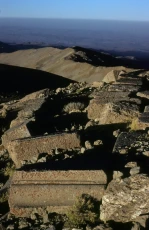
Remaining stones of ancient building on the Jabal Haramun (Mount Hermon)

Khan Qurdbak, southern and eastern porticos

Jamiʿ ash-Shuʿaybiyya, minaret

Horse harness manufacturer in the town of ar-Raqqa

Jamiʿ al-Mihmandar, the entrance half dome

Monastery of St. Simeon Stylites, late 5th-early 6th c., Exterior of sanctuary of east basilica (apse from exterior)

scan 1996 الشعيبية

Khan al-Wazir, interior facade of the khan's entrance

A woman with a screen-printed headscarf called Habari

Bayt Wakil (Aleppo-Zimmer), the middle part of the room
A view of Aleppo room, whose magnificent woodwork was transferred from Wakil House in Aleppo to be re-installed at the Museum of Islamic Art in Berlin. The drawings for this room are the oldest collection from a Syrian house in the Ottoman era. They represent various subjects, including the formations of Islamic art portrayed by various plant and geometric drawings, Christian themes and images of the Virgin Mary with her child, as well as scenes from the court with the ruler on his throne, and mass hunting trips.

Lower basin of the waterfalls of Tall Shihab

Rich decorations in Bayt Shaykh Qatana before demolition
Innenraum

A view from Qalʿat Shayzar towards the Orontes plains

an-Nabi Huri (Cyrrhus), View from inside the Roman mausoleum

Hammam Yalbugha an-Nasiri, general view from the Citadel

Traditional Aleppian house
This Aleppian house was occupied, before the war, by an architectural consultancy office. The courtyard in the picture is the perfect place for the employee’s break.

Al-Madrasa ash-Sharafiyya, prayer niche decorated with geometric patterns

View, from south, at northern overbuilt part of Suq (bazaar) of Khan al-Harir (Picciotto house)

Inside the city wall, excavation work, Qatna
Das alte Qatnâ war in der ersten Hälfte des 2. Jts v. Chr. eine Stadt von einiger Bedeutung und geriet dann in das Spannungsfeld zwischen Ägyptern und Hethitern. Von den letzteren wurde es um 1340 zerstört. . [Original: Al-Mishrifa / Qatnâ']

in the Ghab plain: thatched mud houses, 1963

Al-Madrasa as-Sultaniyya, general view from the Citadel

Pre-drawn pattern of a contemporary ‘Ajami decoration
Abdelraouf Baydoun is working on the underdrawing of a ‘Ajami-Decoration

Afamiya, remains of the Great Colonnade (Cardo Maximus)

Google earth- al-Husn Church 2010

Archaeological excavation in Kharab Sayyar

Mosaic Aphrodite and Ares, Shahba Museum

A small window in the middle of a niche- upper floor, Qal‘at Shayzar

Raqqa - "East of Raqqa" site - Tall Aswad, excavation in 1985
[1985/72/983] = [photo's name as: year/ film no./ photo no.]

Al-Madrasa al-Hallawiyya, detail of the prayer niche (mihrab)

Raqqa - "East of Raqqa" site - Western Palace, Glazed pottery
West Palace; Glazed pottery, waster pottery

Al-Matbakh al-ʿAjami, muqarnas squinches of the iwan dome

Darat ʿAzza, city located along the St. Simeon Monastery road

Artificial pool in the south of Mushannaf Temple

View from south, Qalʿat Ibn Maʿn
[ Description by author: Die Burg des Fakhru d-Dîn al-Ma'ni, gesehen von ~ Süden. ]

In a small village on the Khabur: foreign visitors are welcomed

Qalʿat al-Marqab (Castle), Inscription framed with decorations

Khan Qurdbak, southern part of the khan - iwan of the Mamluk palace

Raqqa, Map draft of ar- Rafiqa and its walls
Overlay drawing with remaining street structure and modern city areas. 84-87% > approx. scale 1:10.000

Prestige facade of the lower northern cardo (colonnaded axis) at Afamiya
"Säulenstraße, 1,8 km lang und 37,5 m breit, nördlicher Abschnitt (glatte Säulenschäfte mit korinthischen Kapitellen) nach 115 n.Chr."

‘Ajami decoration in Qasr al-‘Azm, Damascus
shap_import_97594

Qalʿat al-Marqab, Fresco on the ceiling of chapel sacristy, 12th C.

View from afar, Qalʿat Salah ad-Din (castle)

An old photo in ʿAyn al-Fija, Wadi Barada
[Original:'Militär-Transport im Taurus'].. The Bavarian air force division 304b was based in Palestine from 25. October 1917 and was involved in the First World War until the division left the region, over Aleppo, in mid September 1918. During that period, over 3000 glas photographs, mostly aerial, have been made. Those early photographs were important for the archaeological research in the Middle East.
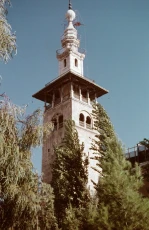
Umayyad Mosque in Damascus - al-ʿArus minaret

Jabal ʿAruda, ruins of a temple from the middle of the 4th millennium BC

View from Masyaf Castle towards the city

Jisr ash-Shughur, the ruins of Qalʿat ash-Shugr wa-Bakas, a twin crusader castle

Sahl Hawran (Hawran Plain), The traditional operation of threshing wheat

Jamiʿ Aslan Dada, prayer hall (qibliyya), window above the prayer niche

Busra, al-ʿUmari Mosque, eastern facade

Hama, The historic alley leading to al-ʿAzm Palace

Busra - al-Jami‘ (mosque) al-ʿUmari - Islamic inscription

Bayt Ghazala, ʿajami wall panels decorating the red hall (qaʿa)

Yabrud: residential houses with central hall floor plans
Street view with central hall house. This building along the street shows a local variation (of the Qalamun Mountains) of the house form known from Lebanon since the middle of the 19th century: shaded entrance hall with an entrance arcade of three arches on round columns on the ground floor, above it on the upper floor the repetition as open seating area with balcony in front. A symmetrical stone façade made of cleanly carved limestone and slender arched windows. These houses were probably built in the first quarter of the twentieth century.

Busra, Interior view of the Roman Theatre and Ayyubid Citadel
Orchestra und Scenae Frons, gesehen von ~ Süden. Das Theater stammt aus dem 2. Jh. und ist eines der größten und besterhaltenen der römischen Welt. Es fasste ca. 15000 Zuschauer. Vgl. Bild 3802 !

View of a hill in the upper Euphrates valley (al-Furat al-Aʿla)

ʿAyn Diwar, The Zengid bridge on the Tigris

Maronite Cathedral, upper pointed part of one of the cathedral towers

Al-Madrasa al-Hallawiyya, the current prayer hall was part of ِAleppo's Byzantine cathedral
The damage of al-Hallawiyya prayer hall that contain an exedra of the Byzantine cathedral of St. Helena (5th CE.). During the war, the monument was damaged and plundered.

A side of Qalʿat Ibn Maʿn

Houses overlooking the Barada River in Old Damascus

Monastery of St Simeon Stylites, Narthex of south basilica (south façade of church)

Tartus, Qalʿat al-Marqab, Crusader castle, a courtyard in the castle.

Entrance towers on the west side, Harim Castle

Afamiya, Northern Roman baths

Interior view of the monastery, northwest of Palmyra, Jazil
[ Description by author: Blick durch die Flucht der Räume. ]

View at ar-Ruj plain from an orchard


Minaret of al-Aqsab Mosque, Damascus

As-Sisi alley: southern entrance with gate
View of the alley seen from the southern end, where the former gate, built in a narrow place, is clearly visible. Such gates were common until the beginning of the twentieth century in many old town streets, and were closed every evening.

Waterwheels of Kilaniyya
Note: these photos were taken between the year 1924 - 1939. The chosen date is to be average. (photographer unkown)

Al-Madrasa al-Ahmadiyya, courtyard and southern portico

Jamiʿ al-ʿAdiliyya, faience tiles decoration above a window
[Original: 'Jâmi' al-'Âdiliya, Halab / Aleppo. Fayence-Dekor, vgl. den aus der Takiya as-Sulaimâniya in Dimashq Bild 0122, 0123 !'].

The northern entrance of the historical city of Dura Europos (Qalʿat as-Salihiyya), end of 4th century BC
[Stadttor]

Raqqa - "East of Raqqa" site - aerial photo of the West Palace

Museum of Arwad - Arwad citadel

Introducing the blue dye in boiling water to the silk threads. This process is repeated several times until the silk absorbs the blue dye effectively

Waqf of Ibshir Mustafa Pasha, damage mapping (Arabic)
The waqf (endowment) complex of Ibshir Mustafa Pasha has suffered serious damage in several areas. This includes the khan on the north side and the eastern and western qaysariyya. Without removing the rubble, no final statement can be made about the extent of damage. Most likely, there was a total loss in the areas affected by the April 2015 tunnel bomb explosion. The western portion of the waqf complex, including its front facade, is still standing but is noticeably damaged. Two of the most important buildings of the waqf complex of Ibshir Mustafa Pasha survived: the mosque and the coffeehouse at the south. The uniquely decorated facade of the hall of the coffeehouse, as well as its first row of vaults, were destroyed. The core of the hall was only partially damaged, while the section of the central dome with its high lantern was, for the most part, destroyed.

Courtyard looking north, Qalʿat Samʿan (Monastery of St Simeon Stylites)
[Original: Oktogon von Süden]

Busra - Birkat (pool) al-Hajj

Interior view with fresco paintings, Tomb of the Three Brothers

Afamiya, The Great colonnade (Cardo Maximus)
shap_import_70670

Palmyra, the cella of Bel Temple
View from south west

Several plans of masuoleums (turba) in Damascus
Plans of Turbas in Damascus: 105 Shibliyya, 106 Rayhan [Hand written: No. 84 Kadastre II/5 1380 (?)], 107 Takritiyya, 108 Zahiriyya, 109 Khatuniyya
![Tall Brak (Nagar), ruins of Naram-Sin Palace, 3rd millennuim BC. [Original photo name: naram sin palace2]](https://syrian-heritage.org/wp-content/plugins/justified-image-grid/timthumb.php?src=https%3A%2F%2Fsyrian-heritage.org%2Fwp-content%2Fuploads%2F2020%2F06%2Fshap_import_44762.webp&h=230&q=90&f=.webp)
Tall Brak (Nagar), ruins of Naram-Sin Palace, 3rd millennuim BC. [Original photo name: naram sin palace2]
shap_import_44762

Al-Khusrawiyya: Explosion crater where the mosque once stood, 2016
The first Ottoman mosque in the city was designed by the famous architect Sinan. An explosion in 2014 destroyed the mosque completely, nothing but a huge crater is left.

Hand carved wood block used for printing fabrics

At-Tabqa, Jaʿbar Castle , one of the Castle's towers.

Raqqa, Qasr al-Banat, Northern Iwan
[G 88/ 24/ 293] =[ photo's name as: year/ film no./ photo no,].

A view of the Mosque of at-Takiyya as-Sulaymaniyya with Qasyun mountain in the background

Az-Zawiya al-Hilaliyya, wooden cells inside the prayer hall's iwan

Citadel of Aleppo, Great Mosque courtyard and arcades

General view of Jamiʿ (mosque) al-Imam Ismaʿil
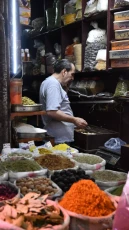
The interior of a shop in Suq al-Buzuriyya

A renovated Aleppine house in al-Jallum neighborhood
The courtyard of one of a traditional Aleppine house on one summer night filled with music.

A view of the iwan of Dada house
Liwan

Function of shafts or heddles
Drawings by Estibaliz Sienra Iracheta to illustrate processes of traditional textile manufacturing

A fountain rich in geometric decorations in the northern arcade of the courtyard, Asʿad Basha al-ʿAzm Palace

Theater, view to proscenium and scenae frons

General view to the lower parts of Jabal Haramun (Mount Hermon)

Propylaea of Jupiter Temple, Damascus

Busra, Hammam Manjak, niche in the hot section

A grove with irrigation canal in the Ghouta of Damascus

Preparation of spools in the textile factory of the Mezannar family

View of the Barada Valley in the 1960s

The tower tombs, Valley of the Tombs
[ Description by author: Links der Turm des Maliku (vvgl. Bild 0576, 0815, 0822 !), rechts der des Jambliqu. Davor in der Mitte das Tempelgrab, links davon der untere Teil eines Turmes der Justinianischen Stadtmauer (Nordseite). Gesehen von ~ Nordosten. ]

Colored mosaic in the western arcade of the Umayyad Mosque
[ Description by author: Decke des mittleren Schiffs, gesehen nach ~ Südwesten. ]

an-Nabi Huri (Cyrrhus), Roman bridge on the Afrin river

Raqqa - "East of Raqqa" site - Western Palace, finds
Eastern West Palace; Arch above Frieze J-i, s.SW-Neg.85/267

Excavation work, Madinat al-Far

Manufacturing of spools in the textile factory of the Mezannar family in Damascus

Mnin, Traditional village houses at the foot of the Qalamun Mountains

A female Kurdish tribe leader wearing a screen-printed headscarf called Habari

Preparing dinner in the courtyard of a mud brick house in the outskirts of Raqqa

Restoration of a part of a decorated wooden panel with ‘Ajami decoration of the Damascus Room in the Dresden Museum for Ethnology

Part of a decorated wooden door with ‘Ajami decoration from the Damascus Room in the Dresden Museum for Ethnology
Painting on the large wall cupboard door (samandāra) of the Damascus Room in the Dresden Museum of Ethnology

Yabrud, Residential house with covered terrace (riwaq)

Habuba Kabira, construction of the corner of a mud brick house

A village with reed thatched roofed houses in al-Ghab Plain
[Original: Dorf mit z.T. traditionellen schilfgedeckten Häusern im Ghab-Gebiet]

General view of ʿAyn al-ʿArus

A building belongs to Qal‘at Shayzar

Madrasat al-Firdaws, view of the southern arcade and the prayer hall entrance

Mari (Tall Hariri), a side of the architectural remains

Palmyra, Grave in Diocletian Camp
[ Description by author: Eingang zu einem Grab in der Nähe des Fahnenheiligtums. Vgl. Bild 0760 ! ['~ kein Datum !] ]

An old photo showing the main western entrance of Jamiʿ an-Nuri (mosque), Homs
The main western entrance to the courtyard.

Ground plan of buildings in southern Suwayqat Ali in Farafira quarter.
Part of Farafira, Cad.district VII-3-1, incl. Matbakh al-Ajami before destruction by street [27]/see book Suwayqat Ali, p. 45. size of plan 55 x 45 .with ruler (55 x 45).

Bimaristan an-Nuri, courtyard- entrances to single rooms

Remains of ar-Raqqa Wall built of mud brick

Hammam an-Nahhasin, the cold section (barrani)
The platforms of the external section (barrani) are divided by wooden barriers with geometric forms, and the walls are also covered with wooden panels. Due to the continuous use of this bathroom, the platforms are upholstered for the convenience of visitors.
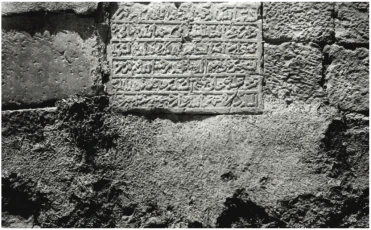
Jamiʿ (mosque) al-Hanabila, inscription

Aghabani table cloth with gold and silver threads

A traditionally crafted tapestry cover (Kilim)

Bayt Ghazala, view of the bathhouse

Qalʿat al-Marqab (Castle), General view - eastern and southeastern side

Jamiʿ Aslan Dada, the hall dome - octogonal tambour on squinches

Corner of a Bedouin tent from goat hair during the desert festival in ar-Rusafa

Habuba Kabira, back side of a room half deepened into the grown soil (in local dialect: debabe)

The Mediterranean coast of Baniyas city in 1960s

A side of the courtyard arches, an-Nuri Mosque
Antike Säule im Innenhof. ['Original: Hamâ (Epiphania),']
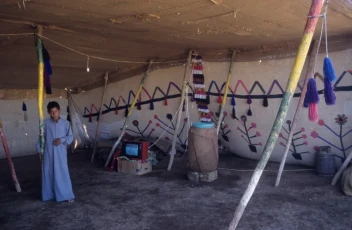
In the living compartment of the tent, which is embroidered in patchwork technique (the same tent is on photo #2850 and #2853.)
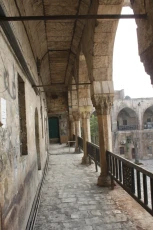
Khan al-Wazir, view of the arcade

Remains of ancient buildings in Shahba, partly inhabited
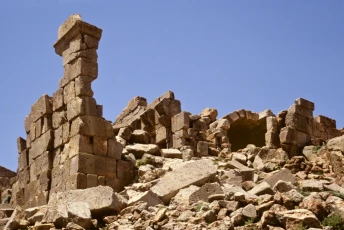
The Byzantine basilica, view from the south, Qalʿat Burqush
[ Description by author: der byzantinischen Basilika, gesehen von ~ Süden. Links ein Stück der Südwestwand, rechts schaut man durch die eingestürzte Südost-Wand in die Gewölbe. Der Stein unter dem Bord links entspricht in seiner Höhe genau dem Stein rechts: der ganze Zwischenraum ist als Mauer zu denken. ]

East part of suq al-Nuri (?)

Tartus, ash-Shaykh Badr, Arched niche in al-Kahf Castle

Damascus, Hammam al-Qaramani
A door - originally a high-lying window? Hammam al-Qaramani

Khan as-Sabun, mamluk ranks decorating the northern facade's gate

Busra - Birkat (pool) al-Hajj and Jamiʿ (mosque) Abu al-Fidaʾ

Bimaristan Arghun, muqarnas vault behind entrance portal

View from boat to Jabal ʿAruda-massif

Archaeological finds from Raqqa, exhibited in the Damascus National Museum
Glass cup and drinking glass from ar-Raqqa ; National Museum Damscus

Stone sarcophagi in the pyramidal mausoleum A, al-Bara

The dome of the treasury, decorated with mosaics in the courtyard of the Umayyad Mosque

Part of Damascus city wall topped by a house balcony
[ Description by author: aus ayyubidischer Zeit mit neuerer Überbauung. Im Hintergrund das Minarett des Bâb Sharqi. ]

Citadel of Aleppo, Barracks of Ibrahim Pasha - the Citadel Museum

Masbanat al-Jubayli, the soap bars are stacked decoratively on top of each other for drying

Busra - Madrasat Abu al-Fidaʾ, view from west

Inner face of the southern walls of Halabiyya, tower 3

Bridge over the Euphrates at Raqqa

Raqqa - "East of Raqqa" site - Tall Aswad, excavation in 1985
Tall Aswad

Habuba Kabira, master builder and his helper constructing the walls of a mud brick house

Part of the remains of Najm Castle (Qalʿat Najm)

Al-Madrasa az-Zahiriyya, general view from the outside

Raqqa, Qasr al-Banat, star-shaped fountain in centre of the courtyard

View at an-Nuri Mosque and the Kilaniyya Norias on the Orontes River, Hama
Gesehen nach ~ Südwesten vom Dach des "Afamia Cham Palace", rechts etwa anschließend an Bild 0978. Vor der Moschee zwei Nawâ'îr, eine weitere links unten. . ['Original: Hamâ (Epiphania),']

A group of doves in the old city of Aleppo
Some of the residents of the old city used to raise pigeons for fun and to enjoy them. Here we see a number of doves resting on the roof of an old building.

Dar'a, al-Jamiʿ (mosque) al-ʿUmari, arcade

Busra, General view of Busra citadel
On the photo it was mentioned: date of creation between 1985-86

Bab al-Hadid, general view of the gate's tower from the outside

Citadel of Aleppo, exterior view of the domes of the Hammam
![Tall Brak (Nagar), ruins of Naram-Sin Palace, 3rd millennuim BC. [Original photo name: naram sin palace2]](https://syrian-heritage.org/wp-content/plugins/justified-image-grid/timthumb.php?src=https%3A%2F%2Fsyrian-heritage.org%2Fwp-content%2Fuploads%2F2020%2F06%2Fshap_import_44759.webp&h=230&q=90&f=.webp)
Tall Brak (Nagar), ruins of Naram-Sin Palace, 3rd millennuim BC. [Original photo name: naram sin palace2]
shap_import_44759

Palmyra, View of the remains of Diocletian's Camp
[ Description by author: Blick vom Hang des Jabal al-Husainiya oberhalb des Fahnenheiligtums nach ~ Südosten. Ganz unten das Fahnenheiligtum, davor der Platz des Präteriums, davor ein Vestibül mit vier (nur eine steht) monolithischen Säulen, dann nach hinten die Via Praetoria, die hinter den Säulen in der Mitte von der Via Principalis geschnitten wird. Daran, links davon, der Allât-Tempel. Außerdem erkennt man ganz hinten gleich rechts der Mitte den Tetrapylon, weiter rechts den Bel-Tempel. ]
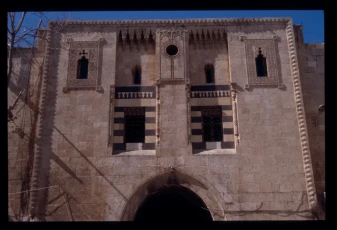
Khan al-Wazir, decorations and windows on top of the entrance's internal facade

Afamiya, Architectural component with showing ionic elements

Nahiyat Tall Tamir, The domes of the houses built in the 1930s were often flattened later.
The Assyrian villages on the Khabur with their domed houses were built by the French Mandate Government for Christian refugees from Turkey and Iraq.

Raqqa, Northeast Complex

Burj Alaʾ, general view of the southern facade of the tower with its machicolations and parapets

Eastern side of Damascus Gate, Ebla (Tall Mardikh)
~ Ostseite, äußerer Abschnitt, gesehen von der Westseite nach ~ Süden. [Original:Tall Mardîkh (Ebla)']

Bridge reaching to Ibn Maʿn Castle

Arch of the remains of Qasr al-Hayr al-Gharbi (Palace)
[ Description by author: Blick nach Osten - vielleicht durch das Westtor ? Oder geht der Blick durch die Ostmauer auf andere Gebäude (z.B. den Khân) ? ]

Maʿarrat an-Nuʿman, domed structure (mashhad) and minaret of the Great Mosque

Kitchen tent with fireplace of a semi-nomadic family from the Maskana region

Raqqa - "East of Raqqa" site - Tall az-Zujaj - excavations
Raqqa X; Glass-Tall
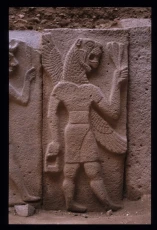
Citadel of Aleppo, Temple of the Storm God Hadad - Detail on platform wall
[Original: Grabung Kohlmeyer]

Bayt Dallal, courtyard and fountain

Suq Aslan Dada, view of the Mamluk coat of arms (rank) at the north entrance after completion of the rebuilding work
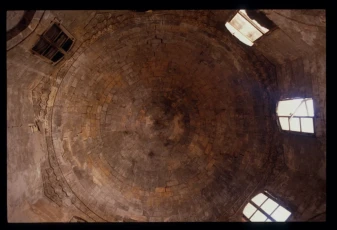
Jamiʿ Aslan Dada, interior view of the hall dome

View of Qaws Hadrian (Arch of Triumph) and the Great Colonnade

Bayt al Haj Musa (cad. no. VII 2060 and 2056)/ Reduced ground plan with ruler
Built structures under a mamluk qa'a that was destroyed before 19th century, Size of plan 28 x 38 . with ruler (no scale).

Al-Madrasa al-Ahmadiyya, inscription and decoration above the entrance of the prayer hall

Interior view to the west showing the courtyard and the entrance of al-Bimaristan an-Nuri
[ Description by author: Innenseite, gesehen über den Innenhof nach ~ Westen. ]

Dayr Zakka (monastery), detail of a mosaic, showing the palm
Raq19930001.tif

Preparation of the design of a felt carpet
Photographs of a manufacturing facility for felt carpets in Al Bab as part of the "Aleppo Stadtarchivprojekt" of GIZ (German Corporation for International Cooperation) in 2008

The northern entrance of the historical city of Dura Europos (Qalʿat as-Salihiyya), end of 4th century BC

A Bedouin woman is weaving with a horizontal loom

Wakil house, Reception hall

View of al-Kilaniyya Norias
Tele-Ausschnitt aus Bild 1007. (original date 03/03/2001 (?)) .['Original: Hamâ (Epiphania),']

Busra Citadel and the railway of the Hijaz line

Palmyra Theater, central part (valva regia) of scaenae frons

Small cistern in the Castle of Harim

Jamiʿ at-Tawashi, minbar (pulpit) - inscription

Busra - Jamiʿ (mosque) al-Mabrak

Al-Madrasa as-Sultaniyya, main entrance and minaret

The damage of the west-southern corner of the mosque.

The gate of the northeastern wall, Agora
[ Description by author: Das hohe Tor der Nordostwand und Blick nach ~ Südwesten ins Innere. ]

Tall Dahab, Bedding pile in the family's living and storage room

Aghabani table cloth

Southwest side of the Byzantine Basilica, Qalʿat Burqush
[ Description by author: der byzantinischen Basilika. Sie dienten zur Erweiterung der Terrasse des römischen Tempels nach Südwesten. Hier zu sehen die Südwest-Seite. Sie ist eingestürzt, so dass man die gegenüberliegende Wand der ersten Halle mit den Ansätzen der Gewölbe-Gurte sieht. Gesehen von ~ Südwesten.- Für alle Burqush-Bilder gilt: die GPS-Tags sind nur approximativ, aber sicher sehr nahe am Punkt. ]

A sample of the handprinted fabric prepared for the women of Douma.

The water of Khabur is near Raʾs al-ʿAyn strongly sulphurous

A typical Friday breakfast table in Damascus

Abdelraouf Baydoun working with the craft of ‘Ajami: Preparation of a wooden dome

General view of Bel Temple among the palm trees
[ Description by author: Morgendlicher Fernblick aus einem der beiden Hotels, also von ~ Nordosten.. ['Hotel Villa Palmyra (Heliopolis ?)'] ]

Plan of (dome) Qubbat as-Sayyar on Qasyun mountain

Raqqa, Qasr al-Banat, mudbrick decoration

Installation of tied and dyed warp threads for weaving in the textile factory of the Mezannar family in Damascus

A self-manufactured fulling machine for the production of felt carpets
Photographs of a manufacturing facility for felt carpets in Al Bab as part of the "Aleppo Stadtarchivprojekt" of GIZ (German Corporation for International Cooperation) in 2008

Maps of Aleppo: Sectoral concentration of trade and craft, 1982
Thematic map of Aleppo ancient city-center: Sectoral concentration of trade and craft in the area of ancient city. Scale 1:2000, ruler and legend. [Original in German: Aleppo: Branchenkonzentration von Handel und Gewerbe im Bereich Altstadt | Karte 4] Inventory no. stamp: Museum für Islamische Kunst Isl 85/31 /2 Berlin-Dahlem. Part of TAVO Reihe B Nr. 58

Bayt Wakil, reception hall

Al-Madrasa al-Hallawiyya, entrance - Zengid inscription in Naskhi script

Khan al-Wazir, main entrance
On the photo was mentioned: date of creation between 1985-86

Jamiʿ al-Khayr, prayer hall - Minbar

Jamiʿ al-Qayqan, southern facade with spolia stones
[Original: Moschee um Bab Antakiya}, on the photo was mentioned: creation date between 1985-86]

A part of at-Takiyya as-Sulaymaniyya, showing a vaulted arcade and the two minarets of the mosque

Bimaristan Arghun, octagonal courtyard - view of dome pendentives
shap_import_60896

General view of of Damascus city with the Umayyad Mosque

Kharab Shams, view from south at church ruin, 4th/6th century CE
The columned basilica, which is very high in relation to its length, lacks the outer walls of the side aisles, which probably once fell victim to an earthquake. The rafters of the lower side roof can be seen above the round arches of the arcade.

Jamiʿ al-Utrush, general view of western facade and minaret

A view towards the Euphrates, Jabal ʿAruda

Aerial photograph of Jibal Lubnan ash-Sharqiyya (Anti-Lebanon Mountains) with Barada valley

Burj Alaʾ, general view of the tower's facade

Jamiʿ al-Utrush, northern entrance

Khan as-Sabun, inner northern facade after widening the street

Busra, Hammam Manjak, iwan in the cold section (barrani)

A side from Qalʿat al-Marqab (Castle)

Burj as-Saʿa, qastal window

A mechanical loom in the textile factory of the Mezannar family

Great Mosque, prayer hall, Shrine of the Prophet Zakariya
The shrine room of the Prophet Zakariya – the father of the Prophet Yahya, or, in the Christian tradition, John the Baptist – lies to the left (east) of the main niche forming the front of the centrally positioned nave of the prayer hall. It is shielded by a copper screen and topped by a small dome. The shrine room of the Prophet Zakariya was renovated and decorated according to the long inscription above it dated 1120 AH / 1708 AD. The shrine room of Zakariya shows a characteristic Ottoman feature. It is covered by several types of ceramic tiles. First, there is a unique type of hexagonal tiles, based on an early Iznik blue and white prototype from the 16th century with plump peony motifs. A second group of tiles are of the ‘Dome of the Rock’ type. Also, there are two types of rectangular border tiles decorated with cruciform ogival medallions amongst scrolling arabesques and foliage and two different colour schemes: one in black on a turquoise ground, the other in apple green outlined in brown on a white ground.

The tower tombs, Valley of the Tombs
[ Description by author: in der rechten Bildhälfte. Ich habe den GPS-Tag nach der Angabe auf der Karteilkarte "vom Südwest-Hügel" (damit könnte der Hang des Jabal al-Mantâr gemeint sein) gesetzt. Eine andere Möglichkeit wäre: aus der Gegend des Turms des Jambliqu, denn auch dieser Hügel (und ist eher ein "Hügel" !) liegt südwestlich in Bezug auf die Stadt. Die Blickrichtung jedenfalls muss nach Nordwesten oder Westen sein. ]

Busra - Hammam Manjak - Restoration works

The men's quarters (Salamlik), Qasr al-ʿAzm
(Offizieller Bereich): Innenhof. ['Original: Hamâ (Epiphania),']

al-Burayj, a side of Saint Daniel Monastery

Monastery of St Simeon Stylites, cross surrounded by decorations

The eastern altar, al-Karasi
[ Description by author: Zwei Seiten ohne Inschrift / Relief. ]

Al-Madrasa al-ʿUmariyya al-Kubra - view from the south
writing on the photo's back ['567. ''Photographie, Francois MARTIN, 19, Bd du Pont d'Aive, 1205 GENEVE'. Foto M. von Oppenheim, reproduziert nach Phototheque M. von Berchem Nr. 567 (1035). (----> Gent, Foundation Max van Berchiem). Org, Catalogue (1975) 50: Madrasa'Umariya. Conv interieure. =Nr. 38.']

Remains of Busra cathedral

A Bedouin family in one of the villages of the Euphrates Valley

Qal‘at Shayzar (citadel), Archery road.

Coffehouse Aslan Dada (vanished)

At-Takiyya al-Mawlawiyya, western facade - al-Midan

Domed house in the village of Shaykh Hilal
A view of one of the village houses, with a front porch and a small garden planted with flowers.

Raqqa - the excavation in the site "East of Raqqa", the Eastern Complex, clay decorations

Citadel of Aleppo, Entrance Gateway
shap_import_62333

al-Madrasa al-Jaqmaqiyya, Decorative details in the eastern facade
[ Description by author: und Schriftband an der Ostwand der Madrasa, vgl. Bild 0235 ! ]

A photo of archaeological remains belonging to the castle of Shayzar

Busra, Hammam Manjak, Restoration works

Approximate

Waqf of Ibshir Mustafa Pasha, Coffeehouse, interior, dome and muqarnas squinches
The central area is covered by a high dome. Supported by four massive pillars, it rests on muqarnas pendentives – triangular-shaped with tiered rows of geometric cells –, and is topped by a round lantern with small columns plus pointed cupola.

Hillside houses of Armanaz on a mountain slope

Al-Matbakh al-ʿAjami, detail of modern and re-used portal (spolia)

The façade of the cathedral of Our Lady of Tortosa, the museum of Tartus today

Architectural remains of Dayr (Monastery) Subat, al-Bara

General view in Suq al-Hamidiyya, Old Damascus

View of the old town from Maʿlula with its traditionally light blue painted facades

Al-Madrasa az-Zahiriyya, general view of the entrance

Remains of arches, Qasr al-Hayr ash-Sharqi

Khan al-Wazir, view of the arcade in the first floor

Raqqa, Qasr al-Banat, decorative niches on the wall of a room
Neg. Nr. 83/5-33A/34
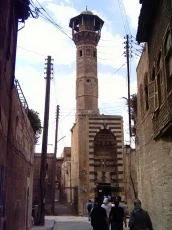
Jamiʿ as-Saffahiyya, minaret and entrance
shap_import_64337

Damascus, Khan Asʿad Basha al-ʿAzm, a wall topped with domes on pendentives

Ruins of Qalʿat ash-Shugr wa-Bakas on the edge of a mountain slope

A view of fields in 'Afrin area



A part from the bath of Harim Castle

Bimaristan Arghun, southern facade of main courtyard
shap_import_60905

An open sky passage in the Castle of Harim

Bab al-Hadid, general view of the gate's entrance from the outside
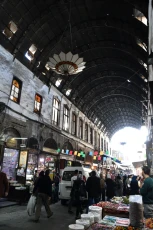
General view Suq al-Buzuriyya

General view of Baalshamin Temple, 2nd century AD
[ Description by author: und nördlicher Säulenhof, gesehen von ~ Ost-Nord-Ost. Die Anlage umfasste auch einen südlichen Säulenhof und erstreckte sich im Nordosten bis unter das heutige Hotel Zenobia. Der Tempel datiert aus der Mitte des 2. Jhs. n. Chr. ]

Great Mosque, Plan of the building parts
The Great Mosque of Aleppo has moderate damage, except for the complete destruction of the minaret in April 2013. The degree of damage is around 30%. The western wing shows two large circular holes in the roof. There are currently no photographs available which clarify the extent of the interior damage. Several fires have affected parts of the main prayer hall causing damage especially to the southern gate and the wooden doors of the northern facade. The northern arcade was burned and its main gate partially damaged. The eastern part of the courtyard floor is torn out.

Preparation of the design of a felt carpet
Photographs of a manufacturing facility for felt carpets in Al Bab as part of the "Aleppo Stadtarchivprojekt" of GIZ (German Corporation for International Cooperation) in 2008

View of a village on the slopes of mountainous hill, al-Furat al-Aʿla (Upper Euphrates Valley)

Brocade in the textile factory of the Mezannar family in Damascus

Maronite Cathedral, lower part of one of the cathedral towers

Suq az-Zarb, view towards west of the suq after the destruction

Tiles of blue Qashani, Mausoleum of Salah ad-Din al-Ayyubi
[ Description by author: Die Inschrift über die Restaurationsarbeiten von Wilhelm II. Eine ähnliche Inschrift befindet sich im Bacchus-Tempel von Ba'labak. (The year of the photo is not sure according to Peter Heiske ) ]

Bayt Ajiqbash, window stone decoration of the courtyard facade

A Kurdish woman spinning with a suspended spindle. She is wearing a traditional overgarment

A hall in the upper floor, Qasr al-ʿAzm (Palace)
Seitensaal des Kuppelsaales mit restaurierter Wandmalerei auf Holz.- Die Bilder 0998 - 1002 haben ein gemeinsames Problem: sie sind mit gepushten High-Speed- Filmen aufgenommen. Das Ergebnis ist beim Dia noch so gerade akzeptabel, führt bemi Scan aber zu starkem Rauschen (der Filmkörnung), zu unnatürlichen Farbverschiebungen oder, wenn man diese korrigieren will, zur Entfärbung. Ich jedenfalls kann's nicht besser .......!. ['Original: Hamâ (Epiphania),']

Entrance and minaret of ad-Darwishiyya Mosque
[ Description by author: Erbaut 1574. Eingang und Minarett, gesehen vermutlich von ~ Osten. ]

Jamiʿ Aslan Dada, interior view of the hall dome

General view of the houses of the village of Shaykh Hilal
The domed houses are of near proximity to each other and interspersed with shrubs that are often planted in the houses’ courtyards.

Suq Aslan Dada, reconstruction of northern entrance, view towards south


The traditional way of filling and weighing the wool, Raʾs al-ʿAyn

Al-Madrasa al-Ahmadiyya, the prayer hall's facade

The mausoleum (turba) of Ibn Salama ar-Raqqi, topped by a dome

Salkhad - historical pond (birket)

Fishermen in the Tartus' harbour
[Original: Fischer in Tartus]

Part of the remains of Shayzar Castle

Bayt Wakil, interior facade of the upper floor

A mechanical loom in the textile factory of the Mezannar family

General view of the Umayyad Mosque, Damascus
Inner courtyard, vault, corridor, minaret, dome

View to the proscenium and scaenae frons, Palmyra Theater, 2nd c. AD

Sculpture of a camel and two persons with Parthian costume
[ Description by author: aus Palmyra in parthischer (Hosen !) Tracht. ]
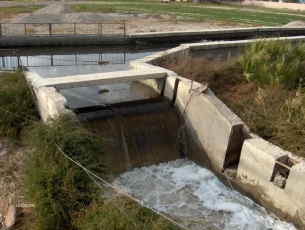
A concrete irrigation canal in the Ghouta of Damascus

Madrasat al-Firdaws, lobed octagonal basin in the centre of courtyard

Application of the relief paste of a ‘Ajami decoration
Workshop of Abdelraouf and Ziad Baydoun in Malaysia

Qasr al-ʿAzm, terrace with portico in the upper floor
Terrasse mit Portikus vor dem Kuppelsaal. ['Original: Hamâ (Epiphania),']

Khan Qurdbak, iwan, ground floor plan
Ground floor with iwan [21], size of plan 70 x 45. with ruler (no scale).

Tartus, in the Chapel of the Templar fortress

Tughra of sultan over the entrance of ash-Shaykh Muhyi ad-Din Ibn ʿArabi Mosque
Separaiting Sheet 82/IX

View towards Notre-Dame de Saydnaya

Modern painted panel with ‘Ajami decoration in Ziad Baydoun´s workshop in Malaysia

View from far to the Monastery of Mar Taqla, Maʿlula

A view of al-Marqab castle located on a high hill

Aleppo, Khan as-Sabun, view of courtyard towards west

Destruction of the northern part of the western entrance. The space is 23 according to the ground plan.

Artificial field irrigation and drinking water supplies, al-Ghab Plain

The suspension bridge over the Euphrates in Dayr az-Zawr

Busra, Hammam Manjak, Restoration works

An alley in one of Damascus's old neighborhoods

Khan Sulayman Basha, view into the courtyard
[ Description by author: Erbaut 1732. Die beiden Kuppeln existieren nicht mehr, aber auch die Bögen mit den riesigen Trompen sind eindrucksvoll. ]

Popular restaurant on Barada River

Masbanat az-Zanabili, view of the courtyard and the northern courtyard facade

Tall Abyad, Historical watermil of ʿAyn al ʿArus

Children from the region, Krak des Chevaliers in the background

Busra - Jamiʿ (msoque) al-Mabrak, the courtyard

Damascus, Muqarnas above the gate of Khan Asʿad Basha al-ʿAzm
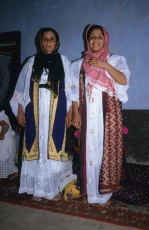
Two Kurdish women. The woman on the right is wearing a traditional woven overgarment

Ad-Dumayr, view of the temple from the inside
[ Description by author: Blick von der Höhe der inneren ~ Ostwand nach ~ Westen. Unten die beiden "Kammern" und die Hofseite des Durchgangs, oben interessant die Verbindung des Giebels mit den beiden Ecktürmen. Vgl. Bild 0391 ! ]

Bayt Ajiqbash, the splendid decorated iwan

Al-Asad artificial lake, view to the Tabqa dam

View of the stage and the scaenae frons, Theater of Palmyra
[ Description by author: und Cavea. Die Bühnenwand soll noch zwei weitere Etagen gehabt haben: wenn man in der Säulenstraße außen an ihr vorbeilief, muss man ziemlich "erschlagen" worden sein ....... Man beachte das Datum, für einen neueren Zustand vgl. Bild 0727 ! Blick nach ~ Nord-Nord-Ost. ]

A side of Ibn Maʿn Castle

Qasr al-Hayr al-Sharqi, Decoration

Main entrance of the church, Ibn Wardan Palace
[Original: Kirche (Kuppelbasilika mit Emporen), Tür der Südseite]

Engraving of Aglibol (god of the moon), Temple of Bel
[ Description by author: Detail aus Bild 0637: Aglibol an seinem Altar, hinter ihm ein Adler mit einem Palmzweig. ]

Shaykh Shibli shrine - al-Tar mountain, south -east of al-Mayadeen - the dome details from the inside
Near Qa'alat ar-Rahaba, Shrin Shaykh Shibliy. [Original:'Bei QAL'AT ar-RAHABA, Grabbau = SAIH SIBLI']

Maronite Cathedral, general view from the outside

Qanawat, Ruins of the Temple of Rabbos

At-Takiyya al-Mawlawiyya, minaret above the main entrance

Panel with flower bouquet, from an unknown house near Bab Saghir, Damascus, presumably first half 18th century

General view of the architectural remains, Sirjilla
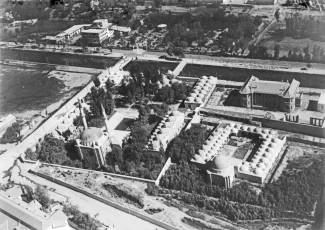
Old aerial photo of at-Takiyya as-Sulaymaniyya, Damascus
[Original:'Damaskus, Großes Derwisch-Kloster (Luftbild)']. The Bavarian air force division 304b was based in Palestine from 25. October 1917 and was involved in the First World War until the division left the region, over Aleppo, in mid September 1918. During that period, over 3000 glas photographs, mostly aerial, have been made. Those early photographs were important for the archaeological research in the Middle East region.

Qalʿat al-Marqab, Fresco in ceiling of chapel sacristy, 12th C.

Bimaristan Arghun, octagonal courtyard - fountain

Jamiʿ Aslan Dada, inscription above the hall entrance
[original: B63 Film-VI]

Valley of Nahr Al-Kabir al-Shamali River

Man with fresh bread

an-Nabi Huri (Cyrrhus), Roman hexagonal mausoleum, 3rd century

Bayt Ghazala, interior view - dome of the main hall (qaʿa)

Inside the city wall, excavation work, Qatna
. [Original: Al-Mishrifa / Qatnâ']

Citadel of Aleppo, general view of the Gate Tower

The general structure of the example dome house in Taanayel (Libanon) before the end of the construction process
The mud bricks composing the walls and the two domes of the house, which are still under construction, are shown. We also see the stone foundations below, and the flat stone blocks integrated in the mud bricks in the domes, that serve for plastering work.

Qanawat, General view of the nymphaeum

Jurn Kabir: in 1998 brooms were still made by hand in some villages

Jamiʿ (mosque) al-Hanabila

Herd of sheep in a grove of trees in the Ghouta
People of Damascus used to praise the delicious taste of sheep’s meat coming from the Ghouta. But the number of sheep has decreased due to the shrinking of the Ghouta area itself and the export of sheep to the Gulf countries.

Jamiʿ at-Tawashi, prayer niche

Bayt Junblat, southern iwan (the Great Iwan)

Archaeological finds from Raqqa, exhibited in the Damascus National Museum
coins from ar-Raqqa, National Museum Damascus; A.16046

Al-Madrasa al-Hallawiyya, the main entrance

Conservation of the Grape Room made in 1835, house Nizam, Damascus

At-Takiyya al-Ikhlasiyya (az-Zawiya ar-Rifaʿiyya), inscription and decoration above the entrance
shap_import_65802

General view in the Limestone Massif, near al-Bara

Khan Qurdbak, western portico from the inside

50 pounds, 25 mm, 2018 (wartime)
50 Pfund, 25 mm, 2018 (Kriegszeit)

View to the south-east of ʿAyn al-ʿArus lake

Busra - al-Jami‘ (mosque) al-ʿUmari - the eastern side facing Hammam Manjak

Al-Bimaristan an-Nuri, Ornaments above the door lintel

The northern entrance of the historical city of Dura Europos (Qalʿat as-Salihiyya), end of 4th century BC
[Original: Große Orientreise Nr.63 mit Rotel-Tours: Amman-Bagdad-Uruk-Babylon-Arbil-Mosul-Hatra-Samara-Mari-Dura Europos-Aleppo-Dayr Saman-Ugarit-Palmyra-Jarash]

View to the village north of Jabal ʿAruda, graves in the foreground

Al-Madrasa al-Hallawiyya, entrance - Zengid inscription in Naskhi script

Bayt Junblat, southern iwan - decoration of marble and faience tiles

Bayt Wakil, iwan

A manufacturing facility for felt carpets in Al-Bab
Photographs of a manufacturing facility for felt carpets in Al Bab as part of the "Aleppo Stadtarchivprojekt" of GIZ (German Corporation for International Cooperation) in 2008

Jamiʿ al-Mihmandar, entrance

Nature in spring, Raʾs al-ʿAyn

Bayt Wakil, iwan

Monastery of St Simeon, baptismal font

Nave and apse, Church of monk Buhayra, Busra
[Original: Bahira-Basilika, paganer Profanbau des 3. Jhs. n.Chr., Innenansicht: Triumphbogen und Apsis]
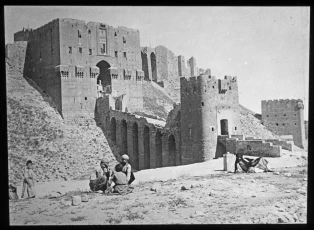
Citadel of Aleppo, entrance gateways and bridge
The Bavarian air force division 304b was based in Palestine from 25. October 1917 and was involved in the First World War until the division left the region, over Aleppo, in mid September 1918. During that period, over 3000 glas photographs, mostly aerial, have been made. Those early photographs were important for the archaeological research in the Middle East.

Raqqa - the excavations of the site "East of Raqqa", the Eastern Complex

Aleppo, view at street life in Quwwatli street in 1963

Raqqa - "East of Raqqa" site - Tall Aswad, excavation in 1985
[1985/24/395] = [photo's name as: year/ film no./ photo no.]. ["s.a. Dias"]

At-Takiyya al-Mawlawiyya, inscription above the prayer niche

The cathedral of Busra from the inside
HQ-k.9 Interior view, Arch,

Umayyad Mosque, the Mamluk Minaret of Qaytbay on the northwestern corner

Maps of Aleppo: historical city and outskirts. 1969 with revisions in 1979 and 1982
Thematic map of Aleppo inner city and outskirts, showing remarkable buildings and main features of land use within the modern city districts. Scale 1:5000, ruler and legend, [Original in German: Aleppo: innenstadt und Außenbezirke: Bemerkenswerte Gebäude und Grundzüge der Flächennutzung in den Neustadtquartieren | Karte 5] Inventory no. /stamp: 4° 629 192-Ktn / Bibliothek Preussischer Kulturbesitz. Part of TAVO Reihe B Nr. 58

Bedouin movement in al-Hawl area with donkeys, camels and a litter

General view of the Monastery of Mar Musa al-Habashi
[ Description by author: und rechts die Unterkünfte für "Suchende". Gesehen von der Anhöhe ~ nördlich des Klosters. Im Vordergrund der "Aufweg" vom Parkplatz am Austritt des Wadi in die Ebene. ]

Remains of a Hexastyle Temple at Shahba
Note: these photos were taken between the year 1924 - 1939. The chosen date is to be average. (photographer unkown)

Hadrian’s Arch, 3rd c. AD
The triumphal arc was constructed in honour of the Roman emperor Hadrian and linked the colonnaded street to the Temple of Baal. In 2015 it was blown up by ISIS.

Jamiʿ al-Khayr, details from the main entrance

The village of Jurn Kabir before the region was flooded by the Tishrin dam

Madrasat al-Firdaws, the marble prayer niche (mihrab) decorated with floral and geometric motifs
[Original:'Madrasa al-Firdaus, Halab / Aleppo. Mihrâb.].

Raqqa - excavations at the site "East Raqqa" - the northern complex
Eastern North Complex; Middle Trench

Qasr al-Hayr al-Sharqi, The western enclosure, view from inside

Church of the monk Buhayra, the oldest church in Busra
{Original: Katdraʾiyyat}

The inner façade of Baghdad Gate, Raqqa

Raqqa, Northeast Complex, coin found during the excavation
Tahir; Coin; approx. 199 h.; Ra-83-NO-06

Barada River in Old city of Damascus

Archaeological finds from Raqqa, exhibited in the Damascus National Museum
Floral frieze decoration; National Museum Damascus, from ar-Raqqa

Raqqa, Exterior view of the Raqqa Museum

The Euphrates River near Tall Sabi Abyad

Excavation works, Dura Europos (Qalʿat as-Salihiyya)
Side of the Excavation

Bab al-Hadid, general view of the entrance

Remain of City Wall, Palmyra
[ Description by author: Blick nach ~ Nordwesten. Vor der Mauer ganz rechts der Annex, zwischen den beiden Mauern liegt die Agora, bei der Säule ist der Eingang zum Bankettsaal, darüber die Burg. Im Verlauf der Mauer erkennt man ganz hinten das Diokletians-Lager.- Die Mauer wird bald als Diokletianisch, bald als Justinianisch bezeichnet: vermutlich unter Diokletian (rund 300 n. Chr.) erbaut und unter Justinian (ca. 550. n. Chr.) erneuert / verstärkt. ]

Raqqa - "East of Raqqa" site - Western Palace - painted glass
Westpalace; Find Nr.14747, painted glass

General view showing the remains of city wall
[ Description by author: Blick vom Gipfel, etwa hinter dem Fahnenheiligtum, nach ~ Südosten. Vorn unten das Fahnenheiligtum, davor das Prätorium und die Treppe. Dann schaut man durch die Via Praetoria nach hinten. Links das Allât-Heiligtum. Zu den Gebäuden im Hintergrund s. Bild 0801 ! ]
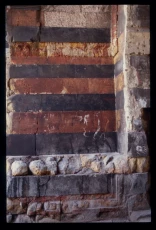
Khan Qurdbak, entrance - stone bench

Masbanat al-Jubayli, the soap cubes after cutting
The arranged and cut-out Aleppo soap in the upper floor of the soap manufactory which is located in a historic building.

Women wearing screen-printed headscarfs (Habari)

Busra - Hammam Manjak - Restoration works

Nahiyat Tall Tamir, Very well preserved domed rooms of a farmstead in an Assyrian village
The Assyrian villages on the Khabur with their domed houses were built by the French Mandate Government for Christian refugees from Turkey and Iraq.

Hand printed table cloth from Hama at Hassan's Shop, Old Damascus

Ghuta of Damascus, olive trees in a grove

Al-Madrasa al-Hallawiyya, wooden prayer niche in the iwan
[Original:'Al-Madrasa al-Halâwiya, Halab / Aleppo. Geschnitzter Mihrâb von 1245, steht heute im Iwân des Hofes. Vgl. Bild 1239 !'].

General view of Husn Sulayman

An artificial canal, al-Furat al-Aʿla (the Upper Euphrates Valley)
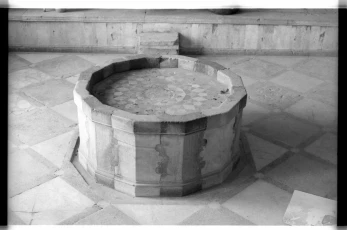
Bayt Ghazala, fountain in the main reception hall (qaʿa)
[Original: B88- Film II]

Jamiʿ al-ʿAdiliyya, muqarnas decorating a niche on the right side of the prayer hall's entrance
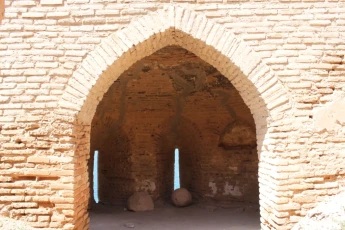
At-Tabqa, Jaʿbar Castle, Entrance of a bastion with loopholes

Al-Matbakh al-ʿAjami, muqarnas squinches of the iwan dome

Baalshamin Temple (2nd c AD), view from north west

Bayt Ghazala, eastern facade - red hall (qaʿa)

An inscription with an decorated frame on the wall of Masyaf Castle

Muqarnas inside the Kahf Castle, ash-Shaykh Badr, Tartus Region

View from the west, courtyard of Umayyad Mosque

Al-Madrasa as-Sulaymaniyya (minor Takiyya), courtyard with fountain, arch arcades and mosque
[ Description by author: mit ähnlicher Grundstruktur, errichtet um 1570 unmittelbar östlich an der Takiya. Blick von ~ Norden über den Innenhof mit Becken auf die Moschee. Die Anlage dient heute für Werkstätten des klassischen Kunsthandwerks: man kauft hier teils Besseres und auf alle Fälle presigünstiger als im Sûq al-Hamadiya. ]

Palmyra, Valley of the tombs

Palmyra / Tadmur, Museum, lion of goddess Al-Lat
[Original: Museum: Löwe als Beschützer einer Gazelle aus dem Heiligtum der Allat, ca. 50 v. Chr.]

Abdelraouf Baydoun working with the craft of ‘Ajami in Qasr al-ʿAzm

Waqf of Ibshir Mustafa Pasha, Coffeehouse, interior, dome and muqarnas squinches

Courtyard of Khan Murad Basha (Museum of Maʿarrat an-Nuʿman)
shap_import_74305

Hammam ʿAbd al-Basit, view from al-Jisr al-Abyad square

Jamiʿ ash-Shuʿaybiyya, entrance portal, building ornaments made of carved stones

Jamiʿ Sharaf, inscription above ad-Darih

Raqqa - the excavations of the site "East of Raqqa" - Eastern Palace
[ 89/45/589] =[ photo's name as: year/ film no./ photo no,].

Interior view of the monastery, northwest of Palmyra, Jazil
[ Description by author: Bestimmung / Zwecke dieses Raumes ??? Vgl. Bild 0903 ! ]

General view over al-Ghab Plain
[Original: Ostabfall des Ansariyengebirges u. Ghab-Niederung]

The village of al-Qirata on the northern slope of the Sajur valley, old lime-washed houses visible.

Damascus, an Arabic inscription on the gateway top of Khan Asʿad Basha al-ʿAzm

A view from a high peak of the Anti-Lebanon Mountains

Al-Matbakh al-ʿAjami, facade of the southern section of the great hall

Aghabani table cloths with gold and silver threads

A view of Shayzar Castle from afar

Habuba Kabira, clay bricks are drying - at the edge of the village, because there is enough space

A robust 4 cm thick felt carpet made of wool in the manufacturing facility for felt carpets in Al-Bab
Photographs of a manufacturing facility for felt carpets in al-Bab as part of the "Aleppo Stadtarchivprojekt" of GIZ (German Corporation for International Cooperation) in 2008

Busra, View into the Cathedral, 6th c. AD

Bimaristan an-Nuri, frame of the entrance door

Hama, The minaret of an-Nuri Mosque

The Khabur river near Raʾs al-ʿAyn, a small cable ferry from empty barrels for crossing the river

An olive grove in the Ghouta of Damascus

Camels in the Great Colonnade, Palmyra
[Original: Kamele in der Säulenstraße]

Excavation of mosaic floor, ʿAyn al-ʿArus
Mosaic floor panel in hexagonal shape

Mushabbak, Byzantine basilica, a side of the church
[Original: Dreischiffige Säulenbasilika, 2. H. 5. Jh., 18,5 x 13,8 m]

Tall Shaykh Hamad (Dur Katlimmu) - Excavations
[Original:'TALL SAIH HAMAD']

Inscription on the wall, Jamiʿ as-Sinaniyya

Al-Madrasa ar-Rukniyya al-Barraniyya - the dome from inside

Remains of the temple, Harran al-ʿAwamid
[ Description by author: die noch verblieben sind. Der Tempel soll aus der Zeit des Kaisers Philippus Arab, also kurz vor 250 n. Chr. stammen. Wikipedia spricht von "Hauranischem Einfluss": dazu würde der Basaltkern der Säulen gut passen - was römisch in Damaskus erhalten ist, ist Kalkstein. Vgl. Bild 0374 und 0375 ! ]

Raqqa - "East of Raqqa"- Eastern Palace, stucco
Raqqa II; Eastern Eastpalace; relief decoration, bunch of grapes

Raqqa, Qasr al-Banat, clay decorations

Dar'a, al-Jamiʿ (mosque) al-ʿUmari - the main entrance from the outside

Hama, General view of al-Madiq castle from the southern side

Burj as-Saʿa, mechanical clock

A warping machine in the textile factory of the Mezannar family in Damascus
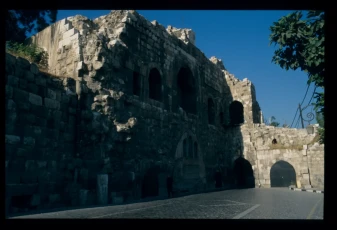
The northern wall of the Damascus Citadel

A Bedouin woman is weaving with a horizontal loom

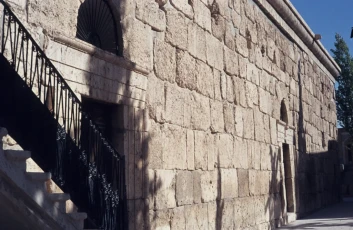
Yabrud: A stone facade of a historic building

Courtyard of the Great Mosque, Hama

A view of the Convent of Our Lady of Saydnaya

Archaeological finds from Raqqa, exhibited in the Damascus National Museum
Capital from ar-Raqq, National Museum Damascus, Nr.13446

Afamiya, a side of ruins

Madrasat al-Firdaws, general view to north - courtyard, eastern arcade and iwan
[Original:'Madrasa al-Firdaus, Halab / Aleppo. Fertiggestellt 1235/36. Hier der Innenhof mit dem großen Iwân.].

Ar-Rusafa, Basilica A
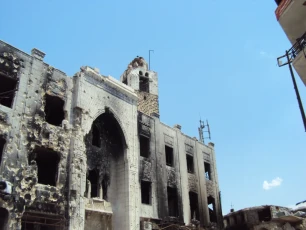
Damage of the outside westrn facade and the minaret. Here in general the west facade of space 02 and the minaret 03 are seen..

Bayt Wakil (Aleppo-Room Berlin), details of the painted wooden panel
The painted wood panel belongs to Wakil house in Aleppo. It represents floral patterns of multiple colours.

Yabrud: residential houses with central hall disposition and three-arcade-motif
Street view with Mittelhallenhaus. This building along the street shows a local variation (of the Qalamun Mountains) of the house form known from Lebanon since the middle of the 19th century: shaded entrance hall with an entrance arcade of three arches on round columns on the ground floor, above it on the upper floor the repetition as open seating area with balcony in front. A symmetrical stone façade made of cleanly carved limestone and slender arched windows. These houses will probably be built in the first quarter of the twentieth century.

Hiraqla victory monument
Hiraqla (near ar-Raqqa), (MM: DAI 93/158)

Al-Madrasa al-Kamiliyya, prayer hall - the muqarnas squinch of the dome

Bab Antakiya, general view of the gate with the city's wall

An arched entrance, Qasr al-Hayr al-Gharbi

The Dome of the Clock, courtyard of the Umayyad Mosque
[Original: Omayyaden-Moschee (705 - 725), Pavillon mit byzant. Kapitellen, im 18./19. Jh. zum „Glockenbaldachin“ zusammengesetzt]

Spools in the textile factory of the Mezannar family

Interior view of Tomb Tower of Elahbel, Valley of the Tombs
[ Description by author: Erdgeschoss, Inneres. Links und rechts zwischen den Pilastern die Loculi für die Toten. Im Hintergrund die Familie des Grabinhabers, vgl. Bild 0836 ! Zur Decke s. Bild 0837 ! ]

Side of the Ruins, Sirjilla

A view at the town of Maʿlula
[Original: Große Orientreise Nr.63 mit Rotel-Tours: Amman-Bagdad-Uruk-Babylon-Arbil-Mosul-Hatra-Samara-Mari-Dura Europos-Aleppo-Dayr Saman-Ugarit-Palmyra-Jarash]

Details of tent-construction, fastening of the side ropes of the Bedouin tent

Busra - Hammam Manjak - Restoration works

A herd of sheep grazing in front of Shayzar Castle

Yabrud: residential buildings as road-accompanying development
Street view with central hall house. This type of house is a local variation (of the Qalamun Mountains) of a house form known since mid of the 19th century, mostly from Lebanon. It has a shaded entrance with an arcade of three arches on round columns on the ground floor, above it on the upper floor a repetition as open seating area. Stone façade is made of cleanly carved limestone and slender arched windows. On the upper floor, a balcony extends over the entire facade. These houses might have been built in the first quarter of the twentieth century.

Balcony above main portal of Khan al-Harir

Citadel of Aleppo, entrance gateways and bridge

Garbage and dirt accumulation in a canal, the Ghouta of Damascus

Capital and remains of the Byzantine cathedral, Qalʿat Burqush
[ Description by author: Es soll bei der Kathedrale fünf Kapitell-Typen geben, hier einer davon, auf Bild 0086 ein anderer. Ich vermute, dass das Kapitell nicht wiederverwendet römisch, sondern original byzantinisch ist. Ist der Stein im Hintergrund Teil einer Türschwelle (Tür zum Betrachter hin öffnend) ? ]

Al-Khusrawiyya, ground floor plan of 1998
shap_import_64425

Making pickles

Hand printed table cloth from Hama at Hassan's Shop, Old Damascus

A basin belonging to the Ummayad Palace ''Qasr Says'' in Jabal Says

Ajiqbash house, view of the courtyard, south-east corner
The former courtyard house of a merchant family served as Aleppo’s Museum of Popular Traditions. The house is severely damaged, especially the open living space facing the courtyard (Iwan).

Maps of Aleppo: functional zoning in the ancient city, 1982
Thematic map of Aleppo ancient city-center: Functional zoning. Scale 1:2000, ruler and legend: - Retail I (higher level, western style), - Retail II (more simple/ traditional), - Retail III (basic level), - Retail IV (for rural customers), - Quarter suq I (rich assortment), - Quarter suq II (simple & handycrafts), - Wholesale I (offices & delivery/higher standard), - Wholesale II (warehouse/ lower standard), - Wholesale III (warehouse for purchase/ agricultural materials), - Warehouse (basic for retail, wholesale and crafts), - Basic usage I (storage, garbage, cattle), - Basic usage II (housing in non-housing buildings), - Crafts I (modern western), - Crafts II (traditional+technolgy), - Crafts III (traditional, basic), - Religious building, - Hammam, Schooll, - Traditional Coffeehouse, - Public authority-health-military use. [Original in German: Aleppo: Funktionale Gliederung | Karte 3] Inventory no. stamp: Museum für Islamische Kunst Isl 85/31 2 Berlin-Dahlem. Part of TAVO Reihe B Nr. 58
![The South-western part of Bayt al-Husainin with the minrat of its mosque. [Original photo name: as-i-مجمع قصر الحسيني 1_SYRHER]](https://syrian-heritage.org/wp-content/plugins/justified-image-grid/timthumb.php?src=https%3A%2F%2Fsyrian-heritage.org%2Fwp-content%2Fuploads%2F2020%2F04%2Fshap_import_75454-1024x768.png&h=230&q=90&f=.png)
The South-western part of Bayt al-Husainin with the minrat of its mosque. [Original photo name: as-i-مجمع قصر الحسيني 1_SYRHER]

Jamiʿ al-ʿAdiliyya, prayer hall - interior view of the dome
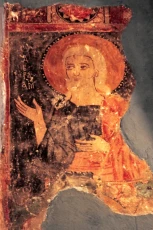
Fresco on the apse, Roman Orthodox St. Elian Church, Homs
[ Description by author: Zumindest Rückwand des Raumes rechts der Apsis: Fresko eines Heiligen, Ich wäre geneigt, die Buchstaben als "Abraham" zu lesen - aber wird der so recht jugendlich mit Heiligenschein dargestellt ? ]

Bayt Ghazala, courtyard and western facade - the main hall facade

General view of Bel Temple with the palm trees
[ Description by author: Areal des Bel-Tempels, gesehen von ~ Westen. ]

Exterior view from the south of the North Gate in ar-Rusafa.

Wadi az-Zaydi, Ancient bridge
near Busra, Bridge

Maronite Cathedral, the altar

Damascus, Khan Asʿad Basha al-ʿAzm, a circular aperture in the roof of courtyard

Jamiʿ ar-Rumi, view of the courtyard and the western arcade

Khan Qurdbak, detail of a window in the iwan

Khusrawiyya Complex, siteplan of the building parts (Arabic)
The Khusrawiyya is severely destroyed. The northern arcade and parts of the western wing of the complex are damaged. There are parts which are still under rubble. The degree of damage is around 80%. The center of the explosion crater, produced in 2014, is located beneath the prayer room, i.e. in the domed hall of the Friday mosque, which doesn’t stand anymore. Most likely, the foundations are lost inside the inner area of the crater, while the rest of the area may contain remains of the building, perhaps sufficient for possible reconstruction. No action regarding the protection or management of the rubble has been done yet.

A suq in Raqqa

Courtyard of the Great Mosque, Hama

Jabla, Mosque of Sultan Ibrahim, The courtyard with vaulted arcades

Jamiʿ (mosque) al-Hanabila - courtyard and ablutions basin

Traditional houses in Halbun

Al-Matbakh al-ʿAjami, small iwan - detail view of archway

Madrasat al-Firdaws, exterior view - northern facade

Hammam Bahram Basha, the dome of the inner part (juwwani)
The dome of the inner part (juwwani) of Bahram Pasha bath was built from clay-brick and is resting directly on the iwan vaults. The dome contains a large number of stained-glass openings, which are formed in various geometric shapes of stars, circles and hexagons.

The wooden pulpit (minbar) in the prayer room of an-Nuri Mosque

Bayt Ghazala, courtyard - northern facade

Monastery of St Simeon Stylites, Corinthian capital

Habuba Kabira, plastering of the domes after completion of the shell

Qalʿat al-Marqab, Decoration on the entrance arch

The suspension bridge over the Euphrates in Dayr az-Zawr
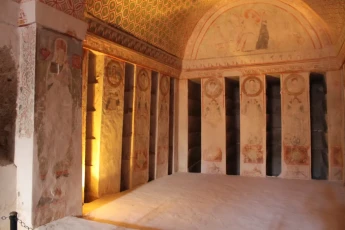
Tomb of the three Brothers, 2nd c.
The colourful fresco of the subterranean burial chamber present mythological creatures. Local and Roman artistic traditions were joined together.

Al-Madrasa al-Hallawiyya, courtyard, portico and basin

Raqqa, Qasr al-Banat, courtyard with southern Iwan
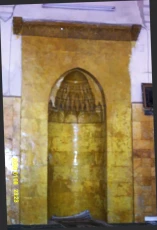
Jamiʿ ash-Shuʿaybiyya, prayer niche (mihrab) in the prayer hall

A side from archaeological city of Dura Europos (Qalʿat as-Salihiyya)
Inside view [Original: "Salihiyyah, Burg, Innenseite, S.H. Taf, LXXXII"]

Umayyad Mosque (al-Jamiʿ al-Umawi), an exterior view of the ʿArus minaret at the northern facade
The lower part dates to the 9th century, and the upper structure is reconstructed from the late 12th century.

Raqqa, Northeast Complex

The northern entrance of the historical city of Dura Europos (Qalʿat as-Salihiyya), end of 4th century BC
[Stadttor]

Raqqa - "East of Raqqa" site - Tall Aswad - shard
Tall Aswad; Pottery Fragment; ROM 17

al-Malikiyya - ʿAyn al-Khadra, Basalt Tomb with arabic inscription

Excavation work, Qasr al-Hayr al-Sharqi

Raqqa, Great Mosque (al-Jamiʿ al-ʿAtiq), the courtyard

Al-Matbakh al-ʿAjami: ensemble of parts, general ground floor plan
Ensemble of conserved parts of palais, size of plan 55 x 45, with ruler (no scale).

Al-Matbakh al-ʿAjami, modern and re-used portal (spolia)

Tall Bdiri, House consisting of a large living room with a small attached kitchen

Khan al-Hibal, the northern facade, upper floor

Ceiling and Reverse side of the ceiling of Bayt Ḫazīna-Kātibī / Niẓām with ‘Ajami decoration
detail of the šīša-ceiling with panels (ṭabaq) painted alternately on green and red ground and view from above on the construction of the šīša-ceiling

Al-Madrasa ash-Sharafiyya, prayer niche decorated with geometric patterns
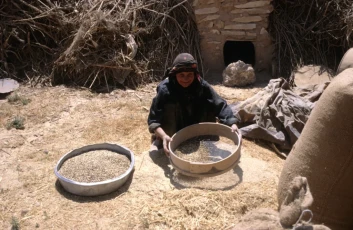
Habuba Kabira, screening of barley as seed by the grandmother

Al-Madrasa az-Zahiriyya, view of the portico and the domes from outside

Shuyukh Tahtani, a kurdish extended family after their dinner

Bayt Junblat, southern iwan - decoration of marble and faience tiles

Busra - Madrasat Abu al-Fidaʾ and (pond) Birkat al-Hajj, filled with rain water

at-Takiyya ar-Rifaʿiyya (az-Zawiyaal-Ikhlasiyya ), inscription above the main entrance
Inscription_Separaiting Sheet. 82/II

Jamiʿ al-Utrush, collapsed roof of prayer hall, eastern part
Hof mit Dikke [Original: Dscham'a el Utrusch]
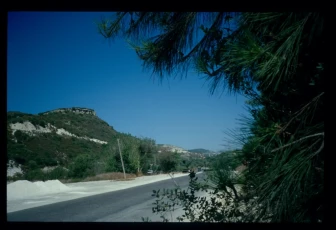
A road in a village in the Syrian coastal mountains (al-Jibal as-Sahiliyya)

Masbanat al-Jubayli, a soap cooking pot
The process of cooking the laurel soap is done in a large container, usually located in the ground floor of traditional soap manufactory.

Engraving at the left of the portal of northern thalamos, cella of Bel Temple
[ Description by author: Cella, Nord-Thalamos, links vom Portal: Ädikula, darüber eine Art Obelisk (oder ein Altar ?). ]

Remains of a ruined building in Jabal Says

Al-Madrasa al-Hallawiyya, main entrance

Khan al-Jumruk, interior facade of the khan's entrance

View of the ablaq-decorated entrance of the Great Mosque of Hama

Jamiʿ al-Maydani, windows with stone lattice screen (Transenna)
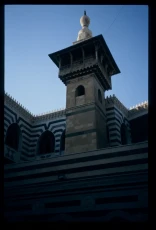
Mamluk square minaret, Jamiʿ Manjak

Busra, Theater and Citadel - Aerial photograph
Citadel al-Qa'la, Aerial view Fl.305, Nr. 194, segment

Fixation of a horizontal loom in the ground

Raqqa - the excavations of the site "East of Raqqa" - Eastern Palace, pottery
Eastern East Palace, SW.Neg. 84/500-501

Jisr ash-Shughur, Qalʿat ash-Shugr wa-Bakas, a twin crusader castle, cave

East and south side of the cella of Bel Temple
[ Description by author: West- und Südseite, gesehen von ~ Südosten. Über dem Gebälk der Peristase "Assyrische Treppenzinnen" - typisch für derartige Gebäude im Nahen Osten in dieser Zeit, s. z.B. Petra ! ]
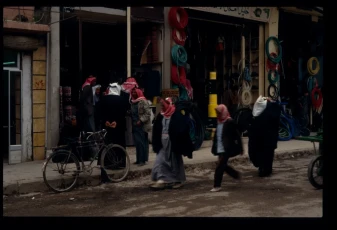
Daily scene in front of some shops in Raqqa

View from a far to the basilica in Kharab Shams
[Original: Säulenbasilika, 4. Jh. von weitem]

Hammam Yalbugha an-Nasiri, the cold section (barrani)
The cold section (barani) is big and composed of four vaulted iwans, each of which has a platform and arched niche to put garments in. The center of this section is an octagonal water basin with a fountain.

Busra - Southern Roman Bath (al-Hammam ar-Rumani al-Janubi)
South-Thermae, Forecourt before Renewal

Near Tall Abyad, view of ʿAyn al-ʿArus lake

General view of ancient house and grave building, al-Bara

Bimaristan Arghun, westward view of main doorway

Jamiʿ al-Qayqan, southern facade with spolia stones and hieroglyphic writing

Remains of the Cathedral, Qalʿat Burqush
[ Description by author: Auch dieses Halbsäulen scheinen mir ursprünglich römisch zu sein: Dekor der inneren (äußeren ?) Cella-Wand. Vgl. Bild 0084 ! ]

Jamiʿ at-Tawashi, east facade - one of the two columns which frame a window
[Original:'Jâmi' at-Tawâshi, Halab / Aleppo. Detail aus Bild 1284: die rechte Säule des Fensters.'].

At-Takiyya al-Ikhlasiyya (az-Zawiya ar-Rifaʿiyya), inscription above the main entrance

Bayt Junblat, southern iwan (the great iwan)

Bayt Wakil, reception hall - western wing

Takiyyat ash-Shaykh Abu Bakr, the outer entrance and the minaret

al-Bara, Pyramidal roofed tomb known locally as As-Sawma‘a,

A view of Arwad citadel

Remains of Diocletian Baths
[ Description by author: mit dem Becken (Stufen !) und seinem Peristyl. Ganz links die Nordwest-Ecke des Peribolos des Bel-Tempels, weiter rechts der Monumentalbogen von innen, im Bogen die arabische Bastion. Ganz rechts das Propylon der Thermen. Gesehen von ~ Nord-Nord-West. ]

Columns belong to the Great Colonnade
[ Description by author: bis zum Monumentalbogen, linke Seite. Gesehen von ~ Südwesten. Alle Zuordnungen sind hypothetisch ! ]

Maronite Cathedral, general view from the outside

Salkhad - The Ayyubid minaret

Zayzun tributary to Yarmuk river: Women washing wool as preparation for matresses as dowry

Al-Matbakh al-ʿAjami, modern and re-used portal (spolia)

Capital, Umayyad Mosque
[Original: Omayyaden-Moschee (705 - 725), Aktanthuskapitell]

General view of the Krak des Chevaliers
[Original: 1150 - 1250 vom Johanniterorden erbaut, Außenansicht]

Preparation of mud for construction in one of Raqqa villages

Tall al-Biʿa - general view

Sirjilla, andron, 5th c.
In some places, buildings were found, that consist only of a huge room and a multifunctional ground-floor space. They were likely community houses (Andron).

Jisr ash-Shughur, Qalʿat ash-Shugr wa-Bakas, a general view of bridge between the two castles

The minaret of Jamiʿ (Mosque) ash-Shaykh Muhyi ad-Din Ibn ʿArabi
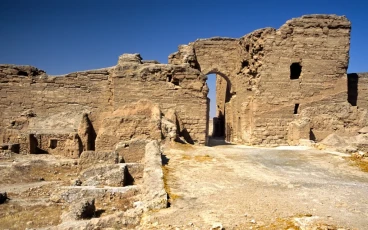
The northern entrance of the historical city of Dura Europos (Qalʿat as-Salihiyya), end of 4th century BC
Innenseite, gesehen von ~ Nordosten. Vgl. Bild 1607 !

Az-Zawiya al-Hilaliyya, the upper part of the entrance

Amrit, Melqart temple (Eshmoun), central shrine

Busra - Madrasat Abu al-Fidaʾ and (pool) Birkat al-Hajj, view from south

Qalb Lawza, Basilica, 5th c., view of main facade from south-west
Here we can see the main façade, the central part of which, with its large round arch, has collapsed, giving a view of the narthex (vestibule). The imposing church has a raised central nave and wide arcades that open onto the side aisles. This basilica suffered relatively little damage.

Ar-Raqqa - Islamic coins discovered in the site of al-Jamiʿ al-ʿAtiq
Numairidian Coin; approx. 450 h.; Ra91-GrMo-8145 (A)

Raqqa - "East of Raqqa" site - Western Palace
Raqqa X; West Palace, aerial photo prob. taken by a crane

Hypogeum of the Three Brothers from the inside - mural paintings
[ Description by author: Linke Wand, Rückwand und Decke der freskierten Halle. In der Lünette Achill auf Skyros, in der Decke die Entführung des Ganymed. ]

Bayt Wakil, qaʿa, front elevation of the hall's facade
Elevation drawing. No scale
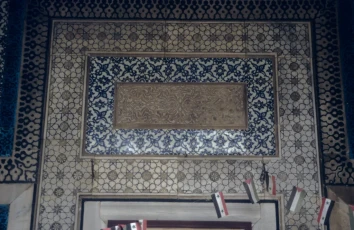
Bayt Junblat, northern iwan - decoration of faience tiles

Jamiʿ Sharaf, inscription above the Sabil

Remains of a building in the Hellenistic city of Afamiya

Exterior view of ʿArbin watermill in Rif Dimashq

Al-Madrasa al-Muqaddamiyya, courtyard

Muzayrib - Ruins of an historical bridge

Khan Dannun - Courtyard

A part of architectural remains in Tall Mardikh (Ebla)
shap_import_48472

Colossal basalt lion, ʿAyn Dara Temple

The Nabataean gate with its main arch, columns and capitals

Sirjilla, two-storeyed andron
[Original: Andron mit doppelgeschossiger Vorhalle, von Konsolenkapitellen getragen, 6. Jh.]

Wooden old door, Madinat Dimashq al-Qadima

Busra - (pool) Birkat al-Hajj

Old rural house, Harran al-ʿAwamid
[ Description by author: mit Dekor, irgendwo im Ort (der GPS-Tag soll nur den Ort angeben). ]

Modern painted panels with ‘Ajami decoration in Ziad Baydoun´s workshop in Malaysia

Terrace of Ishtar or Lions Terrace, Ebla (Tall Mardikh)
Davor ein Teil des Gebäudes PS. Im Hintergrund links das Fort V (vgl. Bild 1194 - 1199 !) und rechts das Gebäude (Palast ?) Z (vgl. Bild 1193 !). Der Blick geht von ~ der Akropolis nach ~ West-Nord-West. [Original:Tall Mardîkh (Ebla)']

Busra - Jamiʿ (mosque) al-Mabrak from the outside

Aghabani table cloth with gold and silver threads

A courtyard of a domed house in the village of Shaykh Hilal
One of the village houses used to welcome tourists. In the middle of the courtyard there is a water fountain, also built with mud. The two domes in the picture are coated with lime to beautify and protect them.

Palmyra / Tadmur, Tetrapylon, 3rd century AD
[Original: Tetrapylon mit Rosengranitsäulen aus Assuan (nur noch eine original)]

Raqqa - remains of the southern arcade of al-Jamiʿ al-ʿAtiq (Great Mosque)

Waqf of Ibshir Mustafa Pasha, damage mapping (English)
The waqf (endowment) complex of Ibshir Mustafa Pasha has suffered serious damage in several areas. This includes the khan on the north side and the eastern and western qaysariyya. Without removing the rubble, no final statement can be made about the extent of damage. Most likely, there was a total loss in the areas affected by the April 2015 tunnel bomb explosion. The western portion of the waqf complex, including its front facade, is still standing but is noticeably damaged. Two of the most important buildings of the waqf complex of Ibshir Mustafa Pasha survived: the mosque and the coffeehouse at the south. The uniquely decorated facade of the hall of the coffeehouse, as well as its first row of vaults, were destroyed. The core of the hall was only partially damaged, while the section of the central dome with its high lantern was, for the most part, destroyed.

ar-Rusafa, Bedouin women cook sheep meat on open fireplaces on the occasion of the desert festival

Busra - Southern Roman Bath (al-Hammam ar-Rumani al-Janubi)
Forecourt before Renewal, view to south

A view from the top of Salah ad-Din Castle overlooking the coastal mountains

Afamiya, Remains of the Great Colonnade

Jamiʿ al-Utrush, view of the western facade and dome of the mausoleum

Romam Gate (Peribolos) at the Straight Street, Old City of Damascus
[ Description by author: von Bild 0321, gesehen von ~ Osten. Der alte Fahrdamm ist heute ein "Park". ]

Al-Madrasa al-Kamiliyya, niche (mihrab) in the prayer hall

ceiling of Bayt Ḫazīna-Kātibī / Niẓām with ‘Ajami decoration
detail of the šīša-ceiling with panels (ṭabaq) painted alternately on green and red ground

A grove in the Ghouta of Damascus

ِAleppo, Khan as-Sabun, partial view from eastern arcade in the first floor

Khan al-Jumruk, in the courtyard view to north showing the interior facade of the Khan's entrance

A part of family wing (so called haramlik oder juwwani) in Asʿad Basha al-ʿAzm Palace

Busra - Hammam Manjak - Restoration works

Madrasat al-Firdaws, general view of the courtyard and the arcades

Khan Qurdbak, ground plan, first floor, reduced copy
First floor, Hotel Balit, iwan (mamluk.) Uzdemir [15]. size of plan 60 x 40. with ruler (no scale) .

View from airplane to the upper reaches of the Sajur (mainly on Turkish territory, border strip of Syria visible at upper right)

Great Mosque of Aleppo, view at courtyard, from 1907
View in eastern direction with the citadel in the background and the pavilions for ritual washing (Abolutionary) visible in the inner courtyard (Sahn). Out of a group of glass-plate photographs from a donation by Prof. Friedrich Sarre to the Museum für Islamische Kunst in Berlin in 1947!

Covered small alley in Halbun with traditional houses

Al-Madrasa al-Muqaddamiyya, the prayer niche
Typical mihrab of a mosque. Maybe the mosque is near Jami al-Tuta. [Original: Mihrâb, Halab / Aleppo. Typischer Mihrâb einer Moschee (vermutlich in der Nähe der Jâmi' at-Tûta)'].

Dura Europos (Qalʿat as-Salihiyya), Roman amphitheater
theater

Gold Dinar of the Kingdom of Syria, 21 mm, 1920

Hammam Bahram Pasha, exterior facade
The street facade of the bathhouse with striped masonry (ablaq).

Jisr ash-Shughur, Qalʿat ash-Shugr wa-Bakas, twin crusader castles, stone arch

Busra - Masjid Yaqut (mosque) - the exterior facade and the entrance

Remains of a building from the extensions of Qasr al-Hayr al-Sharqi

Villages and the fertile floodplain of the Euphrates valley, that were flooded by the Tishrin-Lake
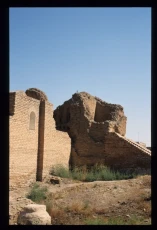
Raqqa, A side of Qasr al-Banat

Side facade of a byzantine church, al-Bara

Badiyat ash-Sham, a small road

Engraving on copper in Suq Midhat Basha

A wall painting from Zimri-Lim’s palace in Mari (Tall al-Hariri), which is known as "The Ordinator of the Sacrifice" (ca. 1780 BC) and hangs in the Louvre.
Section of a wall painting, where a large figure (here not visible) is the king, depicted presiding over a ritual sacrifice. [Original: Malerei aus Mari]

Jamiʿ Aslan Dada, hall dome - squinch and muqarnas

Izraʿ - Kanisat (church) Mar Jirjis - section of the facade and the dome

Interior view of a grave carved in the rocks, Maʿlula
[ Description by author: auf dem Kloster-Plateau: Rückwand und Teil der rechten Seitenwand. Vgl. Bild 0460 ! ]

A herd of sheep in one of the streets in Raqqa

The historic alley leading to al-ʿAzm Palace
[Original: Azem-Palast, von Asad-al-Azem 1740 begonnen, unter seinem Neffen Nasuh Pascha al-Azam Ende des 18. Jahrhunderts erweitert]

Al-Madrasa as-Sultaniyya, facade and entrance of the prayer hall
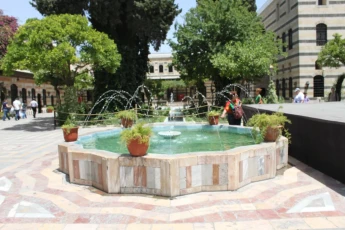
Courtyard with fountain in the family wing (so called haramlik or juwwani), Asʿad Basha al-ʿAzm Palace

Entrance and minaret of as-Sibaʿiyya mosque, Damascus

Salah al-Din Castle, castle walls resting on the grown rock

Nahiyat Tall Tamir, Today empty domed houses in an Assyrian village seen from the street side
The Assyrian villages on the Khabur with their domed houses were built by the French Mandate Government for Christian refugees from Turkey and Iraq.

Qanawat -Roman nympheum

Archaeological find in the Eastern Palace, ar-Raqqa

View to the west. The space is 02 in general, according to the ground plan. Here the minbar 14 and secondary spaces 08-01 are seen.

Burj Alaʾ, general view of the tower's southern facade
shap_import_63415

Damascus, part of the city wall and the eastern tower
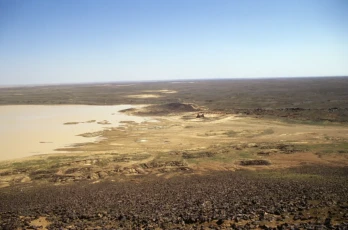
Al-Khubra lake in Jabal Says

Decoration on the Arch of Triumph (Qaws Hadrian)
[ Description by author: - wo genau ? ]

A woman in a rural area with traditional clothes

Suq Aslan Dada, rebuilding of northern entrance, view towards south

Busra, Hammam Manjak, frigidarium or cold room (barrani)

Krak des Chevaliers, Gothic vaults in the loggia

As-Safira area in Aleppo province - clay dome houses

A carpet manufacturer from Al-Bab rolls out a finished felt carpet
Photographs of a manufacturing facility for felt carpets in Al Bab as part of the "Aleppo Stadtarchivprojekt" of GIZ (German Corporation for International Cooperation) in 2008

Bimaristan Arghun, passageway

Busra Theater, one of the main destinations for tourists

Remains of Zeus Temple (Seraya), Qanawat
[Original: Perystlilhof mit einfachen Säulen mit Plattenkapiteller auf hohen Basen]

Burj as-Saʿa, General view

Two-storey villa, Sirjilla

Boats trip on the Euphrates River, near Jabal ʿAruda

A general view of Zawiyat Saʿd ad-Din al-Jibawi showing the two domes of the building

Raqqa - the excavations of the site "East of Raqqa" - Eastern Palace, stucco decorations
Floral frieze decoration, Raqqa II; Eastern East-Palace

Monastery of St Simeon Stylites, view the west basilica

Bouquet of flowers and fruits in bowls on the wall cornice in the reception room (Qaʿa) of the Sadir house

Qanawat, Severan doorway leading to second basilica — from north

Remains of arches belonging to the entrance of Jupiter temple

Archaeological excavation at Balis

General view of the complex constisting of a church and a palace of Qasr Ibn Wardan
[Original: sakraler Zentralbau und Palast, Palast, 564]

A view in the Limestone Massif, near al-Bara

Al-Farnathiyya mausoleum, the dome from the inside
at destrict Damaskus-as-Salihiyya, Ceiling of dome

Kirkbiza in the Dead Cities: A farmer ploughing his field with a metal plough, pulled by a mule and an ox.

Jamiʿ al-ʿAdiliyya, interior view of the prayer hall dome
shap_import_64443

Al-Madrasa ash-Sharafiyya, interior view of lobed dome carried by muqarnas

The nature in spring, Raʾs al-ʿAyn

The western entrance of Maʿbad (temple) ad-Dumayr

Jamiʿ al-ʿAdiliyya, column details in the double arcade

Qalb Lawza, Basilica of 5th c., Apse and south façade
[Original: Basilika, vor 469, SO-Seite]

A view of the main facade, the Convent of Our Lady of Saydnaya

Baking of bread in tannur near to a field of maize in the outskirts of ar-Raqqa

Courtyard of Khan Murad Basha (Museum of Maʿarrat an-Nuʿman)
[Original: Khan Murad Pascha, osman. (heute Mosaiken-Museum)]

Al-Khusrawiyya, Friday Mosque, entrance portal
Close-up of the niche of the entrance portal with its Muqarnas decoration and a panel with its founding inscription. This element is lost today (destroyed since 2015)!

Bayt Wakil, courtyard and fountain

Tourist camels, Palmyra
[Original: Palmyra. Touristenkamele]

Citadel of Aleppo, minaret of the Great Mosque
Note: these photos were taken between the year 1924 - 1939. The chosen date is to be average. (photographer unkown)

Al-Madrasa al-Hallawiyya, entrance of the prayer hall

Street vegetable hawker, ar-Raqqa

The dome house in Taanayel: final touches
A view of the dome house after the process of plastering with lime. In the photo we can see the entrance to one of the rooms and a small window in the other room.

Monastery of St Simeon Stylites, view to the west across the courtyard

One of the towers of Shayzar Castle

Madrasat al-Firdaws, courtyard and arcades

A mechanical loom in the textile factory of the Mezannar family

General view of Maʿlula town
[Original: Malulla bei Damaskus, orientalischer Grundriss]

Jabla, Entrance of the Mosque of Sultan Ibrahim

Shops in Suq al-Hamidiyya, Old Damascus

The Throne Hall in Damascus Citadel
This photo shows Roman columns that support a central dome.

Qal‘at Shayzar (Citadel), the upper part of the entarnce.

Qanawat, Ruins of the Temple of Rabbos

Noria (waterwheel) in Hama
The fine details of the norias are clearly visible. In the background the vaults of the water channel can be seen.

Access to the Castle's interior, Qalʿat Ibn Maʿn
[ Description by author: Der typische abgeknickte Zugang ins Innere der Burg. ['Qal'a, 25/03/2002 (?)'] ]

An irrigation canal in the Eastern Ghouta

At the upper reach of the Khabur near Raʾs al-ʿAyn
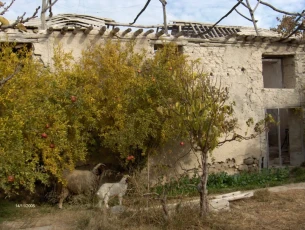
Courtyard of a rural house in the Ghouta of Damascus

Entrance to the Church of St Peter, Saydnaya
[ Description by author: oder kleiner Tempel von Bild 0421: Eingang. Noch gut erhalten ist der Türsturz. Die Portalöffnung selbst ist verkleinert, Vermutung: der / die große(n) Türflügel gingen kaputt, Geld für neue war nicht da (vielleicht wegen des Baues des Marienklosters ?), und so kam man auf die Idee, die Portalöffnung zu verkleinern. Womit ? Der Stein ist ein Monolith, er könnte als Eingang von einem anderen Gebäude stammen - diese Eingänge bestehen aber üblicherweise aus mindestens drei Steinen. War es ein "Trog" (welcher Art auch immer, selbst ein Sarg), aus dem man den Boden herausgemeißelt hat ? ]

Jurn Kabir, construction of a room from quarry stones with clay mortar

Agriculture south of the Monastery of Saint Simeon (geological term for a hollow form closed on all sides in karst areas)
[Original: Polje südl. a. Simeonsklosters]

Ecological and botanical garden near Damascus citadel
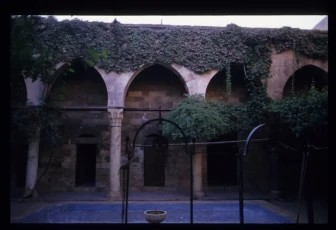
Bimaristan Arghun, view of main courtyard

Raqqa, Qasr al-Banat, courtyard with northern Iwan
[ G 88/ 19/ 236] =[ photo's name as: year/ film no./ photo no,].(ref. http://www.esyria.sy/eraqqa/index.php?p=stories&category=todayimg&filename=201003152100042)

Qanawat, Remains of the Temple of Zeus (Saraya)

al-Malikiyya - ʿAyn al-Khadra, Basalt Tomb with arabic inscription

Courtyard of guest wing (so called selamlik oder barrani), Asʿad Basha al-ʿAzm Palace

Az-Zawiya al-Hilaliyya, northern facade - al-Hijaziyya facade

View of the Mediterranean Sea, Tartus

Al-Madrasa ar-Rukniyya al-Barraniyya - view from the south

Salt flats for salt production west of Jabal Jabisa (Jabisa mountain)

View of Najm Castle (Qalʿat Najm) from the inside

Funerary temple, Palmyra

View on the Euphrates river from Dura Europos
[Original: Ruinen von Dura Europos]

The gate of the citadel seen from the east in the evening light

View from the highest part of Qalʿat Ibn Maʿn towards the Valley of the Tombs
[ Description by author: Blick vom höchsten Teil der Burg genau nach Süden. Ganz links im "Fenster" das Hotel Cham Palace, rechts daneben der Turm des Maliku, der am weitesten rechts in dieser Reihe ist der des Jambliqu. ]

Jamiʿ ar-Rumi, general view of the minaret

View of Mar Taqla Monastery, Maʿlula
[Original: Maalulla- Thekla-Kloster]

Jabal ʿAruda southern foothills

River section of Barada

Hammam al-Bayyada, the main entrance

Palmyra, view from afar of Qalʿat Ibn Mʿan (castle)
seen from the south

Citadel of Aleppo, entrance gateways and bridge

Habuba Kabira, inside the double-dome room with its relief arch

A carpet manufacturer rolls out a finished felt carpet in his workshop in Al-Bab
Photographs of a manufacturing facility for felt carpets in Al Bab as part of the "Aleppo Stadtarchivprojekt" of GIZ (German Corporation for International Cooperation) in 2008

Bab al-Hadid, south-west facade of the gate tower

Turbat Khaʾirbak (mausoleum), western facade and dome

Southwest Tower, Khan al-Hallabat
[ Description by author: (der linke von Bild 0944), gesehen von Südosten. ]

Raqqa, Remains of Qasr al-Banat

Jamiʿ al-Mihmandar, entrance - inscription band

Jamiʿ ar-Rumi, general view of the minaret

Burning and damage inside the rooms of the eastern part of the courtyard. The space is 06 in general, according to the ground plan. The secondary space 02, and most likely space 08 are seen.

Bimaristan Arghun, view of side portico of main courtyard

Al-Madrasa as-Sultaniyya, exterior view of northern facade - entrance and minaret


Al-Madrasa al-Hallawiyya, columns and pillars

Remains of arches of the Najm Castle (Qalʿat Najm)

Jurn Kabir, a hedgehog child

Jamiʿ al-ʿAdiliyya, prayer hall's entrance
Entrance with muqarnas of jami al-'Adiliyya mosque. It was built 1555 in the time of the ottoman time.[Original:' Jâmi' al-'Âdiliya, Halab / Aleppo. Erbaut 1555 unter dem osmanischen Gouverneur Mehmet Pascha. Eingang mit "muqarnas". Vgl. Bild 1222 !'].

A horizontal loom
Drawings by Estibaliz Sienra Iracheta to illustrate processes of traditional textile manufacturing

Jamiʿ(mosque) al-Hanabila - north-south section with the prayer hall, courtyard, and the minaret

Raqqa - "East of Raqqa" site - Western Palace
[1985/50/750] = [photo's name as: year/ film no./ photo no.]

Mosque, interior view with mihrab and minbar.

Bimaristan Arghun, open dome above the octagonal courtyard

At-Takiyya al-Ikhlasiyya (az-Zawiya ar-Rifaʿiyya), hall facade situated on eastern side of the courtyard

Carved giant footprints at the threshold of the entrance of ʿAyn Dara temple

At the peak of Mount Hermon (Jabal Haramun)

Turbat Khaʾirbak (mausoleum), cross section of the facade

Several peaks in the Costal mountains (Jibal as-Sahiliyya)

A view of Royal Palace G, Tall Mardikh (Ebla)
shap_import_48448

Mosaic in the mausoleum of az-Zahir Baybars
[Original: Zahiriya, Mausoleum des az-Zahir Baibars, 1277, Glasmosaiken]

General view of the remains of ʿAyn Dara Temple
shap_import_73075

Jamiʿ al-Utrush, dome and muqarnas squinches of the tomb

Busra - Madrasat Abu al-Fidaʾ, prayer hall
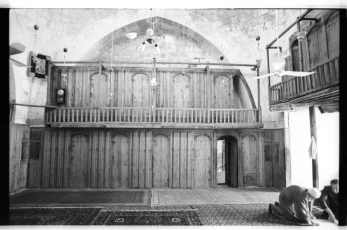
Az-Zawiya al-Hilaliyya, wooden cells inside the prayer hall's iwan

Jamrin - The ancient bridge over Wadi az-Zaydi

Corner pilaster topped by Corinthian capital, Funerary Temple
[Original: Tempelgrab Nr. 86 Weinrankenfries eines Eckpilasters]

An aerial photograph of the village of Shaykh Hilal
The picture shows the distribution of buildings according to a rectilinear plan, and it is possible to identify many of the domed houses and houses with flat roofs that contain gardens.

Fresco paintings on the ceiling of tomb tower of Elahbel
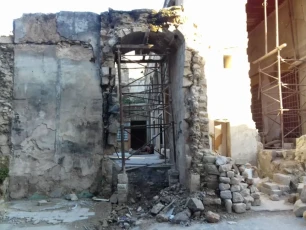
Jamiʿ al-Khayr, main entrance after the war destruction

Suq Aslan Dada, reconstruction of northern entrance and eastern wall of Khan as-Sabun, view towards southwest

Motifs in Hatayi style, Aleppo Room wall frame, early 17th century

Qalʿat al-Marqab (Castle), West door of the Chapel

Qasr al-ʿAzm, decorative niche in the dome hall

Bayt Wakil, facade of the reception hall

Homs, Khalid ibn al-Walid Mosque, an old photo from the 1920/30s
Note: these photos were taken between the year 1924 - 1939. The chosen date is to be average. (photographer unkown)

Jamiʿ Aslan Dada, the hall - octagonal neck of the dome

Part the western gate of the Jupiter Temple and Minaret of Qaytbay
[ Description by author: der Umayaden-Moschee, gesehen durch zwei Säulen des Períbolos des ehemaligen Jupiter-Tempels. Die Bögen links sind arabisch unter Verwendung antiker Säulen und Kapitelle. Gesehen vom Ostende der Haupstraße vom Sûq nach ~ Südosten. ]

Khan al-Jumruk, main door

Kharbaqa Dam: One of the dams that were built to limit seasonal flood waters in the Badia
[ Description by author: Steiler Blick nach oben aus dem Flussbett. ]

A view of the walls and the castle, Halabiyya-Zalabiyya

At-Turn, Double-dome house on the edge of the steppe close to Maskana

Waqf of Ibshir Mustafa Pasha, Coffeehouse, the hall
The core of the hall was only partially damaged, while the section of the central dome with its high lantern was, for the most part, destroyed.

The minaret of the Mosque of Shaykh ʿAqil al-ʿUmari al-Manbiji

Tall Mumbaqa, Feast in a goat-hair tent during the excavation
Man dancing to the tunes of a flute at a party of the excavation


Raqqa - Glass discovered at the site "East Raqqa" - the northern complex
Raqqa VI East; Northern Complex; glass bowl, SW-Neg.87/801-802

View into a room in Palace G, Ebla (Tall Mardikh)
shap_import_48458

Madrasat al-Firdaws, back iwan
Courtyard,

Telegraph column, Sahat (square) al-Marja

Al-Matbakh al-ʿAjami: eastern Qaʿa, section east-west, view to south
Annex building in the north of Matbakh al Ajami, size of plan 25 x 30, with ruler (no scale).

A shop in Suq al-Buzuriyya, Old City of Damascus

Interior view of the Hypogeum of Artaban in the south-eastern cemetery area
[ Description by author: Die Exedra mit dem Grabinhaber auf seiner Totenkline, umgeben von seiner Familie. Außerdem sind in diesem Grab einige der Platten mit den Reliefbüsten der Verstorbenen erhalten, die die Loculi nach vorn abschlossen. ]

Aliya Alnuami

Izraʿ, al-Jamiʿ (Mosque) al-ʿUmari - the courtyard

Tall Halaf with the Khabur-valley, seen from the northeast during the rainy season

Raqqa, Qasr al-Banat, clay decorations
Neg. Nr. 83/5-31A/32

Bayt Ajiqbash, wooden decorated (ʿajami) ceiling in the iwan

Habuba Kabira, View from the inside of the room while constructing the dome

Roman grave behind the Convent of Our Lady of Saydnaya

Khan al-Jumruk, interior facade of the Khan's entrance
Windows of a facade in the courtyard. [Original: Khân al-Jumruk,Halab / Aleppo. Fenster im Innenhof des Gebäudes. Es stammt aus dem 17. Jh.. Vgl. Bild 1220 !. 18/04/2001 (?)']

A passageway in Najm Castle (Qalʿat Najm)
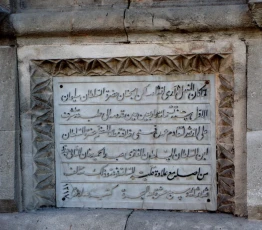
Burj as-Saʿa, inscription

Bab Qinnasrin (city gate), general view from the outside

Kharijat ad-Drisiyat, guest house

Citadel of Aleppo, the Museum - inscription

Jamiʿ Aslan Dada, interior view of the prayer hall (qibliyya) showing the niche (mihrab)

View of the roofs of houses in the old city of Aleppo
One of the poor neighborhoods in the old city of Aleppo, showing modest, informal rooftops filled with satellite receivers.
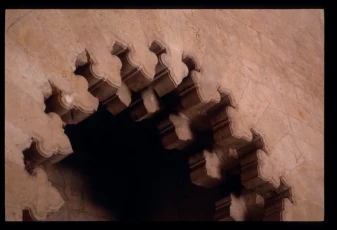
Al-Matbakh al-ʿAjami, small iwan - detail view of archway

Khan Qurdbak, Ground floor plan, reduced copy with ruler
Ground floor, [14]. size of plan 60 x 40 .with ruler (no scale) .

An alley in Halbun town

Damascus, the eastern part of the city wall near to Bab Kisan
Parts of the historic city wall, some with integrated residential buildings, have been preserved to this day. Legend has it that the apostle Paul fled from here, the Bab Kisan gate in the background on the right, to spread the Christian doctrine.

An aerial photograph of the city of Raqqa, showing the wall and the old mosque (original photo: Mohamad Al-Roumi)

A boy in a metal workshop in Raqqa

Habuba Kabira, during the construction of cantilever domes, the mortar is pulled up using a bucket

Dayr Zakka (monastery), mosaic in a destroyed part of the building, showing a palm, a fallow deer and birds
Raq19930002.tif

Ebla (Tall Mardikh), basalt basin was often used for the purposes of worship
(Kult)Wanne. Sie erinnert an die aus Mishrifa, vgl. Bild 0968 ! Der GPS-Tag ist approximativ. [Original:Tall Mardîkh (Ebla)']

The church of St Peter?, Saydnaya
[ Description by author: oder kleiner Tempel, Genaueres war nicht zu finden. Heute eine Kirche, Mar Butrus. Das Gebäude befindet sich in "100 yards" Entfernung vom Marienkloster, ich habe aber auf den Google-Karten nichts entdeckt und darum keinen GPS-Tag gesetzt. Eventuell steht es links an dem Kreisel südöstlich des Klosters, d.h. in der Nähe des Standortes von Bild 0419.- Zum Eingang links vgl. Bild 0422 ! ]

View of the church at Ibn Wardan Palace
[Original: Kirche (Kuppelbasilika mit Emporen), Westfassade (?)]

Drawing of Maria and Jesus on the decorated wooden panels of the Aleppo Room, Museum for Islamic Art, Berlin (1601-1603)

Hinterland of Yabrud in the early sixties: Ploughing with wooden plough, pulled by two horses

Bouquet of flowers and fruits in bowls on the wooden panels of Bayt ad-Dahhan (Funduq Qasr al-Mansuriyya), 18th century
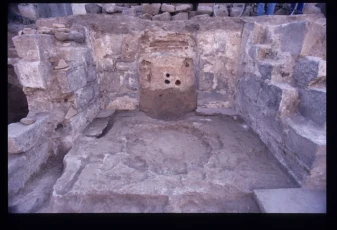
Busra, Hammam Manjak before the restoration work

Bayt Junblat, southern iwan, section east-west
Seize of plan 80 x 38, with ruler (no scale).

Salah ad-Din Castle, massive castle walls above the vertical rock face

Qanawat, Theatron and Orchestra

ar-Rusafa -interior view- North Gate of the basilica

Jamiʿ Aslan Dada, entrance of the additional prayer hall (al-Hijaziyya)

General view of the Valley of Tombs
[Original: Palmyra u. Nekropole]

Coffehouse Aslan Dada (vanished)

Patchwork for textile designs
Drawings by Estibaliz Sienra Iracheta to illustrate processes of traditional textile manufacturing

The remains of the temple of 'Ayn Dara-1

Nahiyat Tall Tamir, Small fledgeling shelters in the form of domes, to be closed by night with stones

Suq Aslan Dada, view of the Mamluk coat of arms (rank) at the north entrance after completion of the rebuilding work

House with mud decoration as door framing in the village of Qalʿat Najm, that was flooded by the Tishrin dam
The house consists of a double-room inside. View from south east.

Qasr (palace) al-Hayr al-Gharbi, view of the ruins

A side from the city, showing the arch of triumph and Ibn Ma'n Citadel

Al-Bara, pyramid tomb A, 6th c.

Sample catalogue for silk fabrics, textile factory of the Mezannar family in Damascus

Decorated door lintel, Valley of the Tombs
[ Description by author: Der Türsturz der Anlage.- Die Farbe ganz rechts ist nachträglich eingesetzt: diese rechte Seite war grellweiß überstrahlt ! ]

Spools in the textile factory of the Mezannar family

Palmyra, Remains of Allat Temple- Camp of Diocletian
[ Description by author: Rückseite, gesehen von ~ Westen. In Bildmitte hinten das Temenos-Tor, ganz hinten rechts der Bel-Tempel. ]

Takiyyat ash-Shaykh Abu Bakr, the iwan facade

Baalshamin temple from the inside, 2nd c. AD
The small temple was consecrated to the Canaanite god of heaven. In 2015 it was blown up by ISIS.
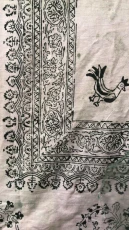
Hand printed fabric combining plant and animal motifs

Al-Madrasa al-Muqaddamiyya, the entrance

Raqqa, Grand Abbasid Mosque - Plan
[original:' Raqqa, Große Moschee']. [84/27/322 a] =[ photo's name as: year/ film no./ photo no,].

Jamiʿ al-Utrush, western facade - decorated window
The upper part of the middle window of the exterior western facade.

View of a road in al-Ghab Plain

Hanging dyed silk to dry after washing it in cold water
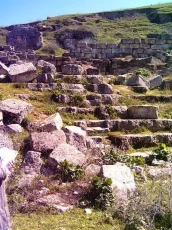
Afamiya Theater, remains of Cavea
shap_import_70740

al-Mihmandar Mosque, general view from south-east

Khan al-Jumruk, internal facade of the Khan's entrance

Basalt sphinx at the main entrance of ʿAyn Dara Temple

Waqf of Ibshir Mustafa Pasha, Coffeehouse, interior
The hall has a rectangular ground plan. Based on a square middle room, it is divided by 12 pillars, all spanned by pointed arches, into 20 compartments of two different forms: two narrow oblong ones each on three sides of the central area (see picture 5) and two smaller square ones each in the adjacent corner areas. Between the pillar pairs that frame an oblong compartment stands a column each with octagonal shaft and multifaceted capital, which is formed by small geometric cells (muqarnas). Towards the side of the windowed entrance wall, the hall is only one bay deep. The courtyard side with its second row of pillars functioned as a kind of entrance portico, being once opened by four high pointed arches within the outside wall. The central area is covered by a high dome. Supported by four massive pillars, it rests on muqarnas pendentives – triangular-shaped with tiered rows of geometric cells –, and is topped by a round lantern with small columns plus pointed cupola. The other parts are covered with elongated, flattened vaults and small domes according the respective compartment form

Yabrud: shops with residential houses on the first floor, houses probably from the beginning of the 20th century

As-Sabuniyya Mosque, ornaments on the facade
[ Description by author: Dekor links bzw. rechts des Eingangs-"Iwâns". ]

Dada House, a view of courtyard seen from the Iwan
Hof vom Liwan aus gesehen

Raqqa, Baghdad Gate, Façade decorations: three-lobed niches and arched frames resting on colonnette

Parts of Najm Castle (Qalʿat Najm), view on the Euphrates River

Bayt Junblat, section drawing of the southern iwan of the inner courtyard (juwwani)

Raqqa - "East of Raqqa" site - Tall Aswad, excavation in 1985
Raqqa IV; Tall Aswad

Jabal ʿAruda, a view towards the Euphrates

Jabla, Sultan Ibrahim Mosque, Interior view of a dome

Restoration of a part of a decorated wooden panel with ‘Ajami decoration of the Damascus Room in the Dresden Museum for Ethnology

The western vaulted arcade of al-Jamiʿ al-Umawi (Umayyad Mosque)

A minaret rises above al-Bab ash-Sharqi

al-Bara, Dayr (monastery) Subat, 6th c.- General view

Qunaytra, A general view shows remnants of destroyed buildings

ʿAyn al ʿArus, Stone arcades

Raqqa - "East of Raqqa" site - Tall Aswad, excavation in 1985
Tall Aswad

Hammam Bahram Basha, the entrance façade

Khan Qurdbak, iwan of the Mamluk palace

Storage vessel made of mud-clay slurry in the niche of a transversal arch house

Motifs of quarter flowers in Kara Memi, Aleppo Room wall frame, early 17th century

Figurine of a lion on the fountain edge, at-Takiyya as-Sulaymaniyya
[ Description by author: Der Löwe von Bild 0124 von der anderen Seite. ]

Euphrates valley south of Qalʿat Najm as it looked before the flooding of lake Tishrin

Great Mosque, top of the minaret
The minaret of the Great Mosque was commissioned by the judge (qadi) of Aleppo during the rule of the Seljuk dynasty in Syria. The beginning of its construction is indicated in the inscription at the base and the completion date is found at the top: 483 and 489 AH / 1090 and 1096 AD. It existed until 2013. The minaret is a square shape, its shaft is approximately 45 m high and made of limestone. On its upper edge, there is a cornice formed by two rows of flat arched niches lavishly adorned by floral elements. This is topped by an open wooden gallery for the muezzin (prayer caller) and a short tower with cupola. Between the base and the top, the minaret is divided into four zones of varying height. Those are, except for the second one, decorated with blind arches formed by profiled mouldings each running uninterruptedly around the minaret’s shaft. Each zone is separated by friezes with calligraphic, artistically written, Arabic inscriptions. These exquisitely carved inscriptions are written in floriated Kufi – a script style distinguished by bold letters adorned with floral motifs – and in Naskhi script. At the base of the minaret is the signature of the architect Hasan ibn Mufrih al-Sarmani written inside a cartouche. The inscription from the minaret’s base shows that the local Aleppine judge and the Seljuk governor shared power in the city, as their names are mentioned together: “The mosques of God are only to be maintained by those who believe in God and the Last Day and establish prayer and give zakat [(alm-tax); Quran 9:18]. It was started to be built by the High Judge Ibn al-Khashshab Muhammad ibn Muhammad al-Khashshab, may God have mercy on him. In the days of al-Amin al-ʿAjal al-Muzaffar Qasim al-Dawla wa-Nasir al-Mila Abi Saʿid Aqsunqur Bak, the slave of the Commander of the Faithful, may God enhance his supporters”. The upper inscriptions indicate the names of the then ruling Seljuk sultans Malikshah I and Tutush, and of Barakat ibn Faris, commander of the urban militia.

Bludan hillside houses with galleries on the foot of Anti-Lebanon Mountains

صورة أقمار صناعية تظهر موقع كنيسة الحصن في البارة، 2021

General view of the monuments of Palmyra
[ Description by author: Der Hintergrund von Bild 0800. Links die Säulenstraße, 3. Abschnitt, dann der Tetrapylon, dahinter der Monumentalbogen. Rechts vom Tetrapylon das Theater, darüber die vier Säulen der Diokletiansthermen. Noch weiter rechts, nach der Kolonnade, die Agora mit ganz rechts dem Bankettsaal. Hinter all dem das Areal des Bel-Tempels, ganz im Hintergrund der Salzsee von Palmyra. ]

View of plastics and metal waste, at-Tabqa

View from Temple of the Standards
[Original: Blick von der Principia auf die Ausgrabungen (Principia = official places of the army officers)]

Shaykh Shibli shrine - al-Tar mountain, south east of al-Mayadeen - plan
Sketch (Skizze), scale approx. 1:50

Mari (Tall Hariri), a side of the architectural remains
[Original: Große Orientreise Nr.63 mit Rotel-Tours: Amman-Bagdad-Uruk-Babylon-Arbil-Mosul-Hatra-Samara-Mari-Dura Europos-Aleppo-Dayr Saman-Ugarit-Palmyra-Jarash]

A capital decorated with wavy acanthus leaves, Monastery of Saint Simeon Stylites
[Original: k.K6/=HQ k.K25]

The ceiling of the guest room (qaʿa), al-Quwatli House
Decke der Ataba in der Qa'a

Busra, cathedral. The remains of the 6th century basilica of the martyrs Sergios, Bacchos and Leontius
Sie wurde 512/13 den Märtyrern Sergios, Bacchus und Liontius geweiht. Hier gesehen von ~ Südwesten: Blick über den Zentral"raum" mit dem Tetrakonchos (vgl. Grundriss Bild 3781 !) auf die Ostwand mit Altarraum und Nebenräumen.

A view of the courtyard of al-Jamiʿ al-Kabir, Maʿarrat an-Nuʿman

Habuba Kabira, maintenance of the house by a further exterior plastering

Burj Alaʾ, southern facade from the inside with the arrow slit
shap_import_63424

The southern tower of Qal‘at Shayzar

The upper part of the minaret, Qashani tiles, as-Sinaniyya Mosque
[ Description by author: Der "Korb" für den Mu'azzin. ]

General view of the Shumaymis Castle
auf ihrem Vulkankegel (oben als Fels und im Mauerwerk Basalt !). Gesehen von entweder Südwesten (so der GPS-Tag) oder von Südosten, von der Straße Hamâ - Salamiya. [Original: Qal'at ash-Shamîmîs']

Raqqa, Qasr al-Banat, courtyard with northern Iwan

Afamiya, Remains of Great Colonnade (Cardo Maximus)
shap_import_70673

Bayt Wakil, reception hall - western wing

Vaulted hall in the old city of Tartus
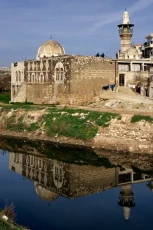
General view of Abu al-Fidaʾ Mosque on the Orontes river
Jami' al-Haiyaya, [Original: 'Jâmi' al-Haiya']. Gesehen von Südosten über den 'Âsi. Unter der rechten, kleineren Kuppel ist der Politiker, Historiker und Geograph Abû l-Fidâ' begraben. ['Original: Hamâ (Epiphania),']

Arches carry the bridge over the Orontes River, which leads to the Shayzar Castle

Monastery of St Simeon Stylites, apse of east basilica

The Theater of Palmyra, upper part of the gateway
[ Description by author: Rückseite des Tores Bild 0721. Gesehen von ~ Nord-Nord-West. ]

Part the western gate, Jupiter Temple
[ Description by author: vom Westportal des Períbolos, Detail aus Bild 0150. ]

Al-Madrasa ash-Sharafiyya, interior view of lobed dome carried by muqarnas

Palmyra, Grave in Diocletian's Camp
[ Description by author: Inneres des Grabes von Bild 0759. ]

Suq al-ʿAttarin, view to east showing the destruction

Fluted column- The Great Colonnade at Afamiya

Living space in the tent of semi-nomadic family from the Maskana region

Bridge over deep ditch reaching the Castle of Ibn Maʿn

Khan as-Sabun, window and decoration above the entrance
shap_import_61539

Takiyyat ash-Shaykh Abu Bakr, al-Midan entrance

A Bedouin woman twisting a hand spun thread spool
The patchwork-cover in the background is separating the living area from the sleeping area

Jurn Kabir, Woman demonstrating the production of a rod mat (arab. zarb) with the help of stone weights

Masbanat aj-Jubayli, the stage of arranging the soap to dry
In the picture, the arched corridors appear on the top floor of the soap manufactory, where the soap bars are arranged in the areas between the arches to dry them out.

Az-Zahir Baybars Mausoleum in al-Madrasa az-Zahiriyya
[ Description by author: ~ Südwand mit dem Mihrâb. Unten links ein Stück des Grabes. (The date of this photo was not sure as Peter Heiske did [(wohl) 18/10/1998] ]

Stone sarcophagi in the pyramidal mausoleum A, al-Bara

Jamiʿ al-ʿAdiliyya, double arcade front of the prayer hall

Palmyra, exterior view of Qalʿat Ibn Maʿn (castle)

Al-Madrasa as-Sultaniyya, interior view of az-Zahir Ghazi tomb

Main entrance of Qasr al-Hayr ash-Sharqi

Jamiʿ Aslan Dada, entrance of the prayer hall

The top floor of a house in Old Damascus

Al-Madrasa al-Hallawiyya, cathedral apse - columns with Corinthian capitals
[Original: Medrese Halawiya (gegenüber dem Westeingang der Großen Moschee): quadrat. Kuppelraum mit östlicher apsidialer Säulenstellung; vermutl. urspr. byz. Tetrakonchos Ostapsis mit korinthischen Kapitellen]

An alley in Halbun

Drawings of an Ikat design
Drawings by Estibaliz Sienra Iracheta to illustrate processes of traditional textile manufacturing

Exterior view of the wall of Najm Castle (Qalʿat Najm)

Vaulted room in the Citadel of Damascus

Qalb Lawza, Basilica of 5th c., south aisle

General view of Najm Castle (Qalʿat Najm)

General view Hama city, showing al-Muhamadiyya waterwheel (noria)
[Original: Blick auf die Stadt und ein Noria (Schöpfrad) am Stadtpark]

Bayt Junblat, door in the centre of southern iwan

Entrance of a house, Qarqabiza
[Original: Tor eines Hauses]

City center of Raqqa with a barber, small suq-shops and mobile traders of vegetables and fruits
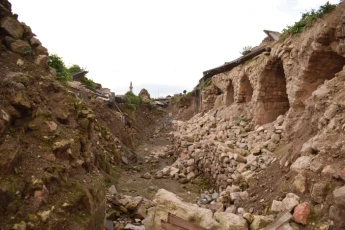
Suq ad-Diraʿ, a general view of the destruction of the suq to the west

Khan al-Jumruk, decorations and windows on the internal facade of the Khan's entrance

Bab al-Hadid, inscription beside the door from outside
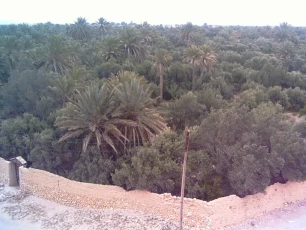
Palm groves


Interior view, courtyard of Jamiʿ al-Imam Ismaʿil

View from the portico towards the entrance of dome hall, al-ʿAzm Palace

Conservation of the Grape Room made in 1835, house Nizam, Damascus

Windows on the monastery's facade, northwest of Palmyra, Jazil
[ Description by author: in der "Fassade" - ein gewisses ästhetisches Bemühen ist unverkennbar, leider haben Felsabbrüche viel vernichtet. ]

Manmade caves in the Euphrates valley near embouchure of Sajur-river close to al-Awshariyya

Izraʿ - Kanisat (church) Mar Jirjis, exterior view

As-Safira, an old thresher for shearing straw (darrasa)

Turbat Khaʾirbak (mausoleum), western facade - tomb chamber

Palmyra / Tadmur, view from afar to Ba‘alshamin Temple
[Original: Baal-Schamin-Tempel, 60 - 150 n.Chr. Im Vordergrund Bad der Zenobia]

Shaykh Anas shrine - al-Tar mountain south-east of al-Mayadeen

Small vaulted passageway, Qalʿat Harim


Qasr al-Hayr al-Gharbi, seen towards the south
[Original: Mo. Nach S.]

Citadel of Aleppo, courtyard of the Palace of al-Malik al-ʿAziz Muhammad

A grave carved in the rock, Maʿlula
[ Description by author: auf dem Kloster-Plateau. Der Guide Bleu "Near East" spricht nur von "ancient tombs", ohne Hinweise auf heidnisch oder christlich. Bei diesem hier wird allerdings gesagt, dass der eine Adler (Bild 0460) und, wenn ich richtig verstehe, die Nische Bild 0458 byzantinisch seien. Ich muss allerdings sagen, dass für mein Laienverständnis eher der "starre" Adler von Bild 0462 als der "schwungvolle" von Bild 0460 byzantinisch wirkt .......- Der GPS-Tag ist apporximativ. ]

Palmyra Theater, view to proscenium and scaenae frons, 2nd c. AD

Engraving of a group of women, Temple of Bel
[ Description by author: LInke Seite oben des Balken Bild 0642, 0643: noch einmal verschleierte Frauen. ]

Bayt Wakil, iwan - decoration above a room's door

Khan Qurdbak, iwan with basement of neighbouring qaʿa
Khan Qurdbak. ground floor plan of iwan with basement of Qaa in Bayt Haj Musa al-Amiri. GW 688, originally part of Khan Hajj Mussa al-Amiri, also on plan: iwan of Khan Qurdbak ([26a] / for description: see book Suwayaqt Ali, p. 33. size of plan 42 x 30. Ruler.

Busra - Jamiʿ (mosque) Fatima - the upper part of the minaret

Burial tombs in the rocks? northwest of Palmyra, Jazil
[ Description by author: Jeweils für mehrere Personen ? ]

Al-Madrasa az-Zahiriyya, prayer hall - historic photo of the collapsed central dome
Muqarnas-Zwickel der Grabkuppel

A group of columns, remains of the southern Roman baths in Busra
A view of part of the southern Roman baths in Bosra dating back to the 2nd century AD. A series of well-preserved columns topped with ionic capitals appear here. This type of capitals appeared in the Greco-Roman Period and is characterized by spiral motifs.

A view of people in traditional dress with a camel in Shahba

Busra, part of the citadel wall

Nahiyat Tall Tamir, The flattened dome roofs have just received new plastering.
The Assyrian villages on the Khabur with their domed houses were built by the French Mandate Government for Christian refugees from Turkey and Iraq.

Raqqa - "East of Raqqa" site - Tall Aswad, excavation in 1985
[1985/24/405] = [photo's name as: year/ film no./ photo no.]. ["s.a. Dias"]

As-Sabuniyya Mosque, the upper part of the minaret

A herd of sheep drinks near the Barada spring

Temple of Bel, 1st c. AD
This center of religious life was dedicated to the Mesopotamian weather god Baal. ISIS bombed he temple in 2015 .

Agricultural fields and industrial complex near Baniyas

Techniques of tapestry weaves
Drawings by Estibaliz Sienra Iracheta to illustrate processes of traditional textile manufacturing

Raqqa - excavations at the site "East Raqqa" - the northern complex
[ 87/ 58/ 1754] =[ photo's name as: year/ film no./ photo no,].. (Naming the area of the photo was done according to the list, although some they are similar but were done in different areas.)

Qasr al-Hayr al-Sharqi, upper part of a tower

Detail of a decorated wooden panel of the Damascus Room in the Dresden Museum for Ethnology

Conservation of the Grape Room made in 1835, house Nizam, Damascus

General view of Baalshamin Temple, 2nd century AD
[Original: Tempel des Baal Schamin (beim Hotel Zenobia)]

View of the artificial pool and the Temple of Mushannaf

Raqqa, Madinat ar-Rafiqa wall - Excavations

A view from Qalʿat Shumaymis towards the surrounding plains

Hama, general view of the "Four Norias", the two Bischriyyat and two Uthmaniyyat
Blick von Südosten auf die vier Wasserräder. . ['Original: Hamâ (Epiphania),']

Citadel der Aleppo, main entrance gateway

Suq al-ʿAttarin, view to east showing the destruction

General view to the lower parts of Jabal Haramun (Mount Hermon)

At-Takiyya al-Mawlawiyya, the kitchen entrance
shap_import_65818

The entrance of Tartus museum, Cathedral of Our Lady of Tortosa

Remains of some columns, the Great Colonnade

Tomb of Jambliku in the Valley of the Tombs, 83 AD
[ Description by author: Fassade, gesehen von ~ Nordwesten. Das Grab stammt aus dem Jahre 83 n. Chr. ]

Natural landscape of the Tigris valley

Tartus, cathedral, interior view of the ruinous nave of the church
Interior view of the cathedral of Tortosa with shepherds in the ruinous nave. Reproduction of an engraving by W. H. Bartlett. Assumed date of origin around 1830. [Original: Christian Church at Tortosa]

Bimaristan Arghun, view of main courtyard
shap_import_60864

Afamiya, Northern Roman baths
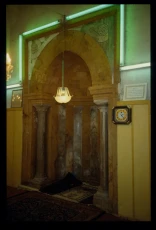
Al-Madrasa al-Muqaddamiyya, the prayer niche

Hama, Waterwheels of Kilaniyya, al-Tawafira and al-Jaʿbariyya

Waqf of Ibshir Mustafa Pasha, Coffeehouse, interior, dome and muqarnas squinches

Qanawat -Roman nympheum

Al-Madrasa ash-Sharafiyya, details of the entrance muqarnas

Hiraqla victory monument
Photo (MM: DAI 93/156)

Raqqa - "East of Raqqa" site - Western Palace
[86/190/1240a] = [photo's name as: year/ film no./ photo no.]. [Original on the back: 'ar-Raqqa, Grabüng Ost (1986), Westpalst'. 'Alt:10/86/39']

Sirjilla, two-storeyed andron
[Original: Andron mit doppelgeschossiger Vorhalle, von Konsolenkapitellen getragen, 6. Jh.]

ʿIsa minaret in the south-eastern corner of the Umayyad Mosque
[ Description by author: gesehen von ~ Norden und römische Reste an der Ostseite der Moschee. Die Tür Bild 0161 befindet sich, wenn ich mich richtig erinnere, hinter dem Betrachter in der rechten Mauer. ]

A staircase and an entrance leading to two halls within the Roman religious complex, Mnin
[ Description by author: Detail aus Bild 0397: Freitreppe zur großen Halle und Eingang der kleinen Halle. ]

Bayt Ghazala, view of the bathhouse

Palmyra, scenery in the valley of the tombs, showing a group of tower tombs

Busra - Madrasat Abu al-Fidaʾ and Birkat (pool) al-Hajj

Monastery of St. Simeon Stylites, late 5th-early 6th c., Exterior of sanctuary of east basilica (apse from exterior)

Threshing in Sahl Hawran (Hawran Plain): farmers are separating wheat from chaff

Madrasat al-Firdaws, the main entrance
shap_import_62841

Interior view of Mar Taqla Monastery, Maʿlula

General view of Ibn Wardan Palace
[Original: sakraler Zentralbau und Palast, Palast]

Traditional dress for men in the villages of at-Tabqa

Jamiʿ al-Khayr, main entrance details from the inside

Bedouin girl with saddle bag, that was weaved by her mother

Jurn Kabir, Girls from Habuba Kabira are preparing the lime milk from local chalk

Rapid Condition/Damage Assessment File
al-Matbakh al-ʿAjami, Rapid Damage Assessment File, suggesting a recommendation class "RC" (acc. to European Norm EN 16096), including a condition assessment and proposed interventions

Hand printed table cloth from Hama at Hassan's Shop, Old Damascus

Remains of Resheph Temple, Ebla (Tall Mardikh)
So nach dem unteren Bild der Schautafel. Hier nach ~ Südosten / Süd-Süd-Ost gesehen. [Original:Tall Mardîkh (Ebla)']

View from Harim Castle towards the nearby plains

Bayt Dallal, the basin and the iwan
[Original:'Judaida-Viertel, Halab / Aleppo. Sofern Bild 1296 tatsächlich die Decke des Iwâns von Bait Sâyigh darstellt, könnte dies hier der Iwân sein.].

Suq ad-Diraʿ, a general view of the destruction of the Suq to the west

VW-"beatle" in the center of the Ghab Plain

Al-Matbakh al-ʿAjami: Qaʿa, plan and four elevations of room
Qaʿa of Matbakh al-ʿAjami, size of plan 55 x 55. Ruler.

General view of ʿAyn Dara temple

Al-Madrasa al-Hallawiyya, detail of Corinthian capital
[Original:'Al-Madrasa al-Halâwiya, Halab / Aleppo. Kapitell einer Säule des Konchos.'].

Courtyard from the northeast, portico - Temple of Bel
[ Description by author: Portikus der Nordostecke, Standort zwischen den Säulen und dem Mauereck, Blick nach Südwesten. Nord- und Ostportikus haben die selbe Höhe. Zwischen den Säulen erkennt man links / Mitte den Tempel, rechts die Propyläen. ]

The prayer hall's arches of the Umayyad Mosque

al-Husn Church, Remains of the basilica after its demolition and turning the site into an agricultural field

Raqqa, Grand Abbasid Mosque - Plan
Ground plan drawing. Scale ruler

Painting on the wall of the iwan, al-ʿAzm Palace
Malerei auf der Rückseite des Iwans. ['Original: Hamâ (Epiphania),']

Manbij, cemetry and new buildings in the background, view from the south

Aliya Alnuami is finalising her ‘Ajami work

Raqqa - "East of Raqqa" site - Tall Aswad, excavation in 1985
Tall Aswad, s.SW-Neg.85/735-6;738

Raqqa, Baghdad gate

In the light of the missing central dome of Khan Asʿad Basha al-ʿAzm

Stonework in the Citadel of Damascus
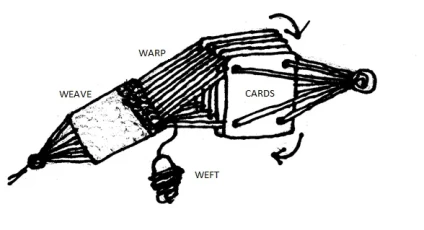
A tablet-loom
Drawings by Estibaliz Sienra Iracheta to illustrate processes of traditional textile manufacturing

The remaining upper part of Shumaymis Castle
Nach dem Licht und dem, was auf dem Satellitenfoto zu erkennen ist, muss dies die Südmauer sein. Man sieht gut, wie ein Stein-Mörtel-Kern mit Basaltquadern verblendet wurde. . [Original: Qal'at ash-Shamîmîs']

Garbage on the edge of an orchard in the Ghouta of Damascus

Qanawat, General view the nymphaeum

Temporary title for Image 91128

Habuba Kabira, preparation of the clay mass for the production of clay bricks

Detail of a decorated wooden panel of the Damascus Room in the Dresden Museum for Ethnology

Busra - Hammam Manjak - bathing niches in the hot section (Juwwani)

Repairing of shoes in Suq Midhat Basha
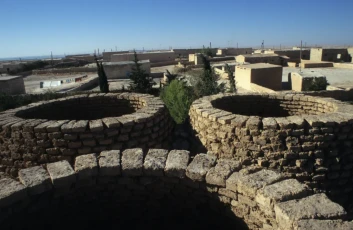
Habuba Kabira, view over cantilever domes during construction

Examples of embroidery stitches
Drawings by Estibaliz Sienra Iracheta to illustrate processes of traditional textile manufacturing

House Wakil, 1976, daily life scene in courtyard
Everyday life in a courtyard of the House Wakil, from which the so-called Aleppo Room of the Museum of Islamic Art in Berlin originates. At times the house served as an orphanage for the Greek Orthodox Church.


Aliya Alnuami

Busra - Jamiʿ (mosque) al-Mabrak

General view of Masyaf Castle

Bab Qinnasrin, general view of the gate's tower with its machicolations and parapets

Pavilion on the left of the Qasr al-Hayr al-Sharqi gate
[Original: Pavillon vorm linken Tor]

General view of Krak des Chevaliers in an-Nasara valley area

Khan al-Wazir, main entrance and the sabil

North-East Syria, the Upper Euphrates

Remains of the pendentifs carrying the dome of the church at Ibn Wardan Palace
[Original: Kirche (Kuppelbasilika mit Emporen)]

Palmyra / Tadmur, General view of Baalshamin Temple
[Original: Baal-Schamin-Tempel, 130 - 150 n. Chr.]

Al-Madrasa as-Sultaniyya, marble prayer niche
The mihrab is another fine example of marble marquetry, with recessed panels bordered by a relief molding in the central half-cylinder, horizontal coursing in the niche head, and a well developed interlace occupying the spandrels. Columns, capitals, and bases are again contemporary. (Allen, Terry. "Madrasah al-Sultaniyah". In Ayyubid Architecture. Occidental, CA: Solipsist Press, 2003. http://www.sonic.net/~tallen/palmtree/ayyarch/ch8.htm#alep.msul)

Madrasat al-Firdaws, inner courtyard with eastern arcade

Traditional production of animal glue
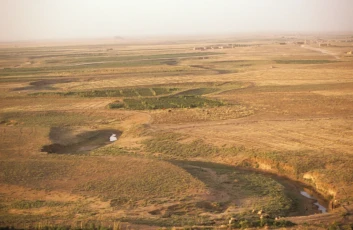
View from Tall Hamidiyya to the plain, Wadi Jaghjagh and fields, © Karin Pütt (CC-BY-NC-ND)

Bayt Wakil, dome of the reception hall (qaʿa) from the inside

Exterior view of Qalʿat Arwad (citadel)

A mechanical loom in the textile factory of the Mezannar family

The place of al-Ashnan watermill on the foot of Qasyun mountain
shap_import_77199

Mosque of as-Sayyida Zaynab, Nahiyat Babbila
[ Description by author: Sayyida Zainab ist eine Tochter von 'Ali und Fatima, somit Schwester von Husain und Hasan und Enkelin des Propheten, außerdem Tante der Sayyida Raqîya, einer Tochter Husains, die ebenfalls in Damaskus begraben ist (vgl. Bild 0251 - 0253 !). laut sunnitischer Tradition ist Sayyida Zainab allerdings in Kairo begraben ....... Die Anlage wurde ab 1990 errichtet, vermutlich weitgend mit Geld aus Iran.- Gesehen von ~ Norden. ]

An abandoned rural noria on the Orontes river
In the rural area of an-Nasiriyya, north of Hama, there are remnants of a noira on the Orontes River, where its stone base and remnants of the aqueduct with its pillars appear.

Terrasses cultivation in the Coastal Mountains (al-Jibal as-Sahiliyya)

Al-Madrasa as-Sultaniyya, general view of al-Malik az-Zahir Ghazi tomb
Tomb of Az-Zahir Ghazi and his family.

Bayt Junblat, western facade of the women hall (Haramlik)

The region of Limestone Massif, where Qal'at Sam'an (monastery of St. Simeon) is situated

Preparation of mud for construction in one of Raqqa villages

Jamiʿ al-Khayr, a wooden internal balcony (sudda) above the prayer hall entrance

A craftsman working on a Jacquard loom in the textile factory of the Mezannar family, Damascus

Jurn Kabir, a rural house, where each room has its own door opening on the courtyard
The house is consisting of a living room (left door) and a family room (right door), where all assets are stored.

A façade of the Shahba baths
The Shahba baths are one of the largest known baths in of the third 3rd century AD, built by Emperor Philip al-the Arabi. The picture shows a façade of one of the bath’s sections. It has a central entrance with a semi-circular arch, with two rectangular niches and on the sides two rectangular niches ending with a semi-circular arch.

Al-Madrasa al-Ahmadiyya, northern portico

Khan al-Wazir, decorations and windows on top of the internal facade of the khan's entrance
[Original:'Khân al-Wazîr, Halab / Aleppo.Ausschnitt auf die Fenster der Innenfassade von Bild 1250.'].

View on the Euphrates river from Dura Europos

Busra, View into the Cathedral, 6th C.
[Original: Kathedrale (den Märtyrern Sergios und Bacchios und dem Leontios geweiht), Chor]

General view of the hillside houses of Maʿlula town
[Original: Maalulla, Ländliche Siedlung]

Qasr al-Hayr al-Sharqi, upper part of one of the towers, flanking the gate
[Original: Turm links]
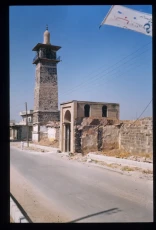
Dar'a, al-Jamiʿ (mosque) al-ʿUmari - The minaret seen from the street

Ar-Rusafa, general view of the remains of Basilica A

Tall Shaykh Hamad (Dur Katlimmu) - Excavations
[Original:'TALL SAIH HAMAD']

A view at the Mediterranean Sea, Baniyas

Halabiyya, remains of fortifications and the praetorium

Raqqa - Madinat ar-Rafiqa wall - Columns discovered during excavation
Raqqa II; capitals (found near city wall or in debris?)

Courtyard with dome houses in Shaykh Hilal
This picture shows one of the daily-life activities of hanging laundry in the courtyard of a domed house.

General view of modern residential buildings in Saydnaya

Al-Madrasa al-Hallawiyya, entrance - Zengid inscription in Naskhi script

Maʿarrat an-Nuʿman, domed structure (mashhad) and minaret of the Great Mosque

Damage of the minaret. Here in general the minaret 03 is seen..

Manbij, Bakery of flat bread with oven

View of a niche inside the Castle of Harim

Habuba Kabira, Milking a goat in the courtyard: Grandmother and granddaughters

Reconstruction of Assyrian town Dur Katlimmu
Reconstruction of Assyrian town Dur Katlimmu in the modern village Tall Shaykh Hamad. Taken on: Exhibition stand "Umwelt und Technik vor 3500 Jahren" on Hannover Messe 1983

Bayt Junblat, southern iwan -faience tiles

Raqqa - Qasr al-Banat - stone decorations
Neg. Nr. 83/54

Bayt Ajiqbash, view of the courtyard interior
shap_import_63540

Camels and camel herder on way home after transporting cotton sacks in the fields of the Euphrates valley
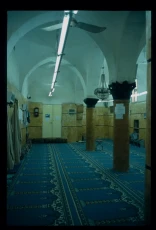
Jamiʿ ash-Shuʿaybiyya, prayer hall

Reception hall in al-ʿAzm Palace
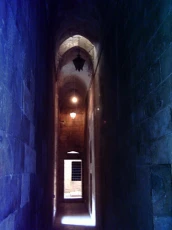
Bimaristan Arghun, passageway
shap_import_60902
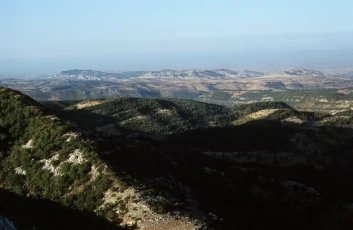
General view of al-Jibal as-Sahiliyya (the coastal mountains) covered by forests

Waqf of Ibshir Mustafa Pasha, Mosque, decoration

Volcanic stones and behind it the Khubra lake, Jabal Says

Qasr al-Hayr al-Sharqi, Remains of Ayyubid arch in the western enclosure

The North West Tower of Damascus Citadel

Sacrophagi in the Hypogeum of the Three Brothers
[ Description by author: Die Sarkophage, als Triclinium angeordnet. ]

Khan Qurdbak, courtyard and iwan

A woman with her children and a spindle in her left hand
In the background lies a self-woven rug

Bayt Ghazala, courtyard, windows of the northern facade

The tower tombs, Valley of the Tombs
[ Description by author: Der hohe hinten ist der des Maliku (vgl. Bild 0820, der ganz rechts der des Jambliqu (vgl. Bild 0823 - 0830 !). Gesehen von ~ Nordwesten. ]

Part of the mihrab decorations, Umayyad Mosque
[ Description by author: Mihrâb: Kapitellchen der kleinen Säulen im unteren Teil der Nische. ]

The suspension bridge over the Euphrates River, Dayr az-Zawr

A side of archaeological remains in Khirbat as-Sarayij
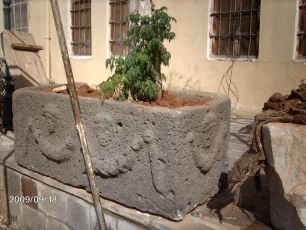

Inside the city wall, excavation work, Qatna
. [Original: Al-Mishrifa / Qatnâ']

Raqqa, A side from al-Banat Palace

Busra, Hammam Manjak, niche in the hot section (juwwani)

Jamiʿ al-ʿAdiliyya, prayer hall's entrance - muqarnas details

Plan of Krak des Chevaliers
[Krak, Plan]

Hama, al-Mudiq castle, A side of al-Mudiq castle shows some of its towers

Great Mosque of Aleppo, prayer hall interior and Shrine of the Prophet Zechariah

Roman mosaic, National Museum of Damascus
[ Description by author: Die Bilder 0113 - 0116 sind eine durchgängige Folge links > rechts aus einem römischen Mosaik. Leider habe ich damals versäumt zu notieren, aus welcher Gegend Syriens es stammt. Hier: ein Bär attakiert Equiden. ]

Jamiʿ as-Saffahiyya, prayer niche

al-Husn Church, Remains of the basilica after its demolition and turning the site into an agricultural field

Bayt Ghazala, courtyard - eastern facade
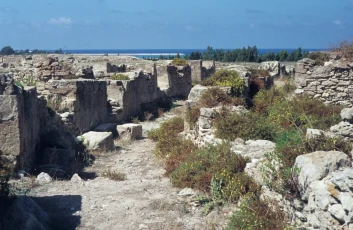
Ras Shamra, Remains of the Ugarit kingdom

Small wadi in the desert of Badiyat ash-Sham

The dome of Maqam Salah ad-Din al-Ayyubi
[ Description by author: Der Bogen rechts und das anschließende Grab sind die einzigen Reste der Madrasa 'Azaziya, gegründet von einem Sohn Salâhu d-Dîns, wo dieser 1195, zwei Jahre nach seinem Tode, beigesetzt wurde.- Gesehen nach ~ Nordwesten. ]

At-Takiyya al-Ikhlasiyya (az-Zawiya ar-Rifaʿiyya), general view of the facade and the entrance

A side of Hiraqla victory monument, built by Harun ar-Rashid, near Raqqa

Exterior view of Krak des chevaliers (Qalʿat al-Husn)

al-Bab ash-Sharqi, a small arched side entrance

Al-Bara, oil mill, 5th-6th c.
The locally grown olives were pressed in oil mills. The well-preserved production site clearly shows the various work areas.

Dead Cities, Kirkbiza: A team of mule and oxen pulling a metal plough.

Exterior view of ad-Daydariyya cave
shap_import_44213

Bludan houses overlooking the Zabadani plain

Hama, View of the courtyard, Great Mosque
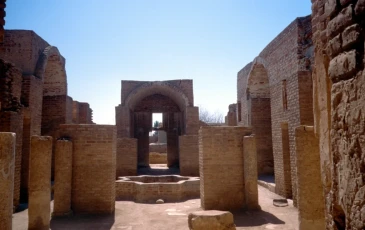
Raqqa, Qasr al-Banat, courtyard with southern Iwan

Raqqa - "East of Raqqa" site - Tall Aswad, excavation in 1985
[1985/72/995] = [photo's name as: year/ film no./ photo no.]

Shop in Suq al-Buzuriyya, currently selling candles for the Palm Sunday procession

General view of the city of Harim, Muhafazat Idlib
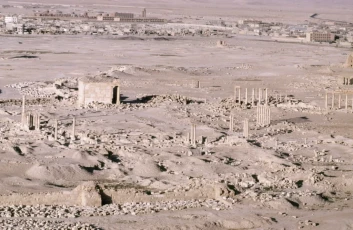
View from Jabal Husainiyya towards Diocletian's camp and Allat-temple
View from above towards north

Twisted column - The Great Colonnade at Afamiya

Part of the noria wheel
['Original: Hamâ (Epiphania),']

Al-Madrasa ash-Sharafiyya, western facade

The tower tombs, Valley of the Tombs
[ Description by author: Blick nach Süden auf Grabtürme: links hinten der des Maliku, rechts der des Jambliqu. ]

Hiraqla victory monument: isometric reconstruction

Interior view of Qadmus Castle

General view of the Mediterranean coast near Baniyas

Archaeological finds from Raqqa, exhibited in the Damascus National Museum
Floral frieze decoration; National Museum Damascus, from ar-Raqqa

Khan al-Hallabat, General view from southeast
[ Description by author: des Forts, gesehen von ~ Südosten. Es liegt an der späteren Strata Diocletiana zum Schutz der Verbindung Palmyra - Damaskus. ]

Khan Qurdbak, entrance- stone bench

Arwad, Ayyubid fort, entrance
[Original: al-Burj al-Ayyubi]

Damaged buildings in Qunaytra

Bayt Dallal, decorated stone of the well

Jamiʿ ash-Shuʿaybiyya, north Facade - a cornice with floral motifs and a Qur'anic text in Kufic script

Porticus post scaenam, Roman Theater - Busra
[Original: Theater, Bühnengebäude (wahrsch. spätes 2. Jh.)]

Nahiyat Tall Tamir, Baking flat breads on the tannur wall (tannur deepened in the ground)
The Assyrian villages on the Khabur with their domed houses were built by the French Mandate Government for Christian refugees from Turkey and Iraq.

In al-Hayat/Balikh valley: procedure of calcination of gypsum is finished and packed into sacks (3rd step): the natural gypsum stone was burned to produce gypsum as building material
(See also 1st and 2nd step of calcination of gypsum)

Qalb Lawza, Basilica of 5th c., decorative door of reliquary room in southern facade (east)
The relics of Symeon were located in the southern apse side room. This martyrion can be recognized from the outside by the third door in the south wall and by a tiny window next to the door through which the pilgrims could be supplied with holy oil. A direct door into the sanctuary suggests that the Symeon relic was also used during the service. The windows are bordered by a particularly elaborately designed cornice band. The façade also has oblique grooves and square depressions, probably from the base of a sloping roof and its purlins.

The shrine of Shaykh ʿAqil al-ʿUmari al-Manbiji

Jamiʿ at-Tawashi, exterior view - eastern facade and domes
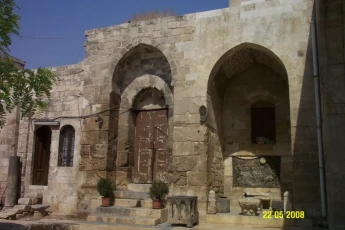
Bimaristan an-Nuri, the courtyards western facade

Jamiʿ al-ʿAdiliyya, corbel with muqarnas supporting an arch in the inner portico

Waqf of Ibshir Mustafa Pasha, Coffeehouse, the hall
The core of the hall was only partially damaged, while the section of the central dome with its high lantern was, for the most part, destroyed.

Wakil House, dome of qaʿa (reception hall)
view at the dome on top of the representative reception hall (Qaʿa). It is standing on a polygonal drum (tambour) with windows for lighting.

Raʾs al-ʿAyn, Piles of wheat before its package in bags

East of the Ghuta, rural houses in the Marj area

The village al-ʿAmarna, with the tall (left) and the Euphrates plain in the back

Jamiʿ Aslan Dada, interior view of the prayer hall (qibliyya) showing the niche (mihrab)

Bab as-Salam, portal with coloured stone layers (ablaq)

Al-Bara, pyramid tomb A, 6th c. AD
The Mausoleum A with its pyramid-shaped roof lies in the middle of oil plantations. The wealth of the region was based on the production of olives.

Palmyra, View from hilltop towards the Valley of the tombs and the palm groves

50 piastres (silver), 24 mm, 1947

The facade of Arwad citadel

Locally produced perfumes displayed for sale in Suq al-Buzuriyya

A view of the Euphrates in Dayr az-Zawr
Jisr Dayr az-Zawr, al-Furat

Krak des Chevaliers, courtyards
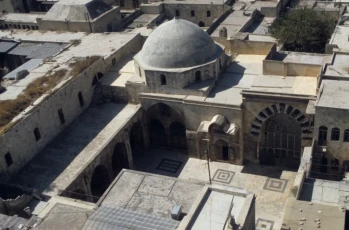
Al-Madrasa al-Hallawiyya, general view of the madrasa from the Great Mosque minaret

The main facade of the Mosque of Sultan Ibrahim, Jabla

Jamiʿ al-Maydani, general view

Ecological and botanical garden near Damascus citadel

A side of Ibn Maʿn Castle

Preparation of spools in the textile factory of the Mezannar family

Excavation work at Tall Afis

Al-Madrasa as-Sultaniyya, marble prayer niche
The mihrab is another fine example of marble marquetry, with recessed panels bordered by a relief molding in the central half-cylinder, horizontal coursing in the niche head, and a well developed interlace occupying the spandrels. Columns, capitals, and bases are again contemporary. (Allen, Terry. "Madrasah al-Sultaniyah". In Ayyubid Architecture. Occidental, CA: Solipsist Press, 2003. http://www.sonic.net/~tallen/palmtree/ayyarch/ch8.htm#alep.msul)

Excavation work at Tall Afis

Khan al-Wazir, the window on top of the khan's entrance facade

Relief with vine tendrils
[Original: Bauornamentik]

Bayt Dallal, ʿajami ceiling of a qaʿa (hall)

South wall of the central shrine (cella), Temple of Bel
[ Description by author: Gesehen von Süden. Zu sehen die Schmalseite der Cella, dekoriert mit zwei Halbsäulen mit jonischen Kapitellen (vgl. Bild 0615 !) und gerahmt von Pilastern mit Kapitellen (vgl. Bild 0616 !) zwischen der West-Peristase mit dem Monumental-Tor und den Säulen der Ost-Peristase. ]

The north western corner of the peribolos wall, Temple of Bel
[ Description by author: Aber welche ? Die Form des Mauerwerks und des Porikus sprechen für die Nordwest-Ecke und nachmittags / abends wäre eine derartige Beleuchtung möglich.- Wenn diese Überlegung stimmt, gesehen von ~ Nordwesten. ]

A side of Kharbaqa Dam, spring

Remains of Afamiya Theater

Noria (water wheel) with aqueduct in ar-Rastan in 1930
An old vintage print (postal card? Labeled Photo ARCHO) of one of the norias of Orontes River near the city of ar-Rastan. The aqueduct, made of stone vaults, receives water from the noria’s buckets.

At-Takiyya al-Mawlawiyya, prayer hall (old Midan)

Jacquard-cartons with holelines for weaving design patterns

Houses of stone and concrete in Mnin

Afamiya, columns of colonnaded axis (Cardo Maximus)
[Original. "Säulenstraße, 1,8 km lang und 37,5 m breit, nördlicher Abschnitt (glatte Säulenschäfte mit korinthischen Kapitellen) nach 115 n.Chr."]

Tartus, museum in the former cathedral, view at western facade

View from the outer northwest edge of the ditch, Shumaymis Castle
Der innere Teil, gesehen nach ~ Südosten vom äußeren Nordwest-Rand des Grabens. . [Original: Qal'at ash-Shamîmîs']

Burj al-Ghanam, tower's southern facade with its machicolation
shap_import_63418

ʿAyn al-ʿArus, view into the ceiling of a village mud bricks house, armenian owners

Minaret of an-Nuri Mosque
1172 erging der Erlass zum Bau dieser Moschee.- Gesehen von ~ West-Nord-West. ['Original: Hamâ (Epiphania),']

Al-Matbakh al-ʿAjami, muqarnas squinches of the iwan dome

Sarcophagus at Maʿarrat an-Nuʿman Museum
[Original: Khan Murad Pascha, Weinspende-Grabreliquar, 6. Jh. (?)]

Natural landscape and agriculture in Sahl Hawran (Hawran plain)

Umayyad Mosque, the famous golden mosaic of the facade of the prayer hall overlooking the courtyard
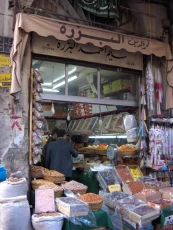
A shop in Suq al-Buzuriyya, Old City of Damascus

Jurn Kabir, a typical old house of the Euphrates valley near Qalʿat Najm with a large log (willow) transverse to the longitudinal axis.
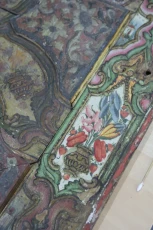
restoration of a part of a decorated wooden panel with ‘Ajami decoration of the Damascus Room in the Dresden Museum for Ethnology
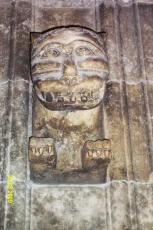
Citadel of Aleppo, Gate of Two Lions - the Smiling Lion

Inside the city wall, excavation work, Qatna
. [Original: Al-Mishrifa / Qatnâ']

Jabal al-ʿArab, Photo of Bedouins in the 1930s
Note: these photos were taken between the year 1924 - 1939. The chosen date is to be average. (photographer unkown)

Fruitful trees and corn in the Ghouta of Damascus

Bayt Junblat, southern iwan - one of the lateral windows

Remains of fortifications in Halabiyya-Zalabiyya

Burj as-Saʿa, general view

A side of Damascus Citadel during the restoration works

A crowd in the 'Afrin, at the time of the cotton harvest

Propylon of Diocletian Baths
[ Description by author: der Anlage, diesmal gesehen von ~ Nordosten längs der Säulenstraße Richtung Monumentalbogen. Gut zu erkennen, dass das Propylon höher ist als die Kolonnade (Halbsäule - Pfeiler) und dass es in die Straße vorspringt (Halbsäule / Pfeiler - Säulen). ]

A chamber in the bath of Harim Castle

A traditionally crafted tapestry cover (Kilim)

Jamiʿ at-Tawashi, entrance

Interior view of the tomb tower of Elahbel

The Valley of Tombs - sculptures of the deads who are buried in a tower tomb
[ Description by author: Detail der Fassade. Im Bogen der Tote auf einer Kline, dahinter seine Familie. Unter der Kline Reste der Inschrift. ]

A room in the family wing (haramlik or juwwani), Asʿad Basha al-ʿAzm Palace
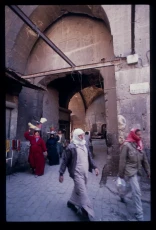
Bab Antakiya, main gate

Mary's girdle in the Saint Mary Church of the Holy Belt, Homs

Excavation work at Tall Afis

Agriculture at the foot of Jibal Lubnan ash-Sharqiyya (Anti-Lebanon Mountains)

Busra - Southern Roman Bath (al-Hammam ar-Rumani al-Janubi)
Exterior view to east

Jamiʿ al-ʿAdiliyya, door of the prayer hall - decoration details and door handles

General view of the Valley of the Tombs

Scaenae Frons, Theatre of Palmyra
[ Description by author: Die Porta Regia mit dem Durchgang zur Säulenstraße, vgl. Bild 0721 ! Gesehen von ~ Südwesten. ]

Pointed arch in the Najm Castle (Qalʿat Najm)

Raqqa, The decorated outer facade of Baghdad Gate

Jamiʿ as-Saffahiyya, minaret

Raqqa, Qasr al-Banat, documentation sheet of courtyard with northern Iwan
The palace called "Girls' Castle" has a courtyard surrounded by four open halls (Iwan). This type of groundplan is known above all from Iran.

Khan al-Jumruk, view of the mosque in the center of the Khan's courtyard

Mushannaf, Small Roman Temple

Spinning with a suspended spindle
Drawings by Estibaliz Sienra Iracheta to illustrate processes of traditional textile manufacturing

Capital of column, portico of Bel Temple
[ Description by author: Ein Kapitell des Portikus, vielleicht aus dem Nordost-Bereich. ]

ʿAyn al-Khadra, in the farm yard behind the house with stables made of basalt stones

Great Mosque, damage mapping
The Great Mosque of Aleppo has moderate damage, except for the complete destruction of the minaret in April 2013. The degree of damage is around 30%. The western wing shows two large circular holes in the roof. There are currently no photographs available which clarify the extent of the interior damage. Several fires have affected parts of the main prayer hall causing damage especially to the southern gate and the wooden doors of the northern facade. The northern arcade was burned and its main gate partially damaged. The eastern part of the courtyard floor is torn out.

Khan at-Tutun, courtyard

Izraʿ - Kanisat (church) Mar Jirjis from the inside

Busra, Hammam Manjak, interior view

Qasr al-ʿAzm, view of the ground floor courtyard

Great Mosque, damage mapping
The Great Mosque of Aleppo has moderate damage, except for the complete destruction of the minaret in April 2013. The degree of damage is around 30%. The western wing shows two large circular holes in the roof. There are currently no photographs available which clarify the extent of the interior damage. Several fires have affected parts of the main prayer hall causing damage especially to the southern gate and the wooden doors of the northern facade. The northern arcade was burned and its main gate partially damaged. The eastern part of the courtyard floor is torn out.

Khan Qurdbak, eastern portico

Bayt Junblat, ground plan
Remarks in german. Size of plan 42 x 30, no scale.

Remains of the facade of an building, Sirjilla

Krak des chevaliers (Qalʿat al-Husn), Gothic vaults

Bimaristan an-Nuri, water reservoir made of basalt

Capital of the corner column, portico of Bel Temple
[ Description by author: Tele-Ausschnitt aus Bild 0609: das Kapitell der Eck"säule". Diese Eck"säule" ist von außen gesehen ein Pfeiler, von innen sind es zwei Halbsäulen in die beiden Richtungen (vgl. Bild 0611 !). Das Ganze hat einen herzförmigen Querschnitt, s. entsprechende Fotos bei den Beirut- und Ba'labak-Bildern ! ]

ar-Rusafa, North-Gate, view into the interior.

A small pathway in the Ghuta of Damascus
The Ghuta consisted of a large number of groves separated from each other by walls or mud fences. There was often a small road between a grove and another, where it was accessed through a gate. The walls were built of rammed earth, an old tradition of rural architecture in the region.

Preparation of the design of a felt carpet in Al-Bab
Photographs of a manufacturing facility for felt carpets in Al Bab as part of the "Aleppo Stadtarchivprojekt" of GIZ (German Corporation for International Cooperation) in 2008

Jurn Kabir, children at the sabil of a private house, where people passing find potable water

General view of the village and castle of Shayzar along the Orontes river

A side of the cavea, Roman Theater at Busra
[Original: Theater, Cavea für 15.000 Zuschauer (Halbkreis von 102 m) und Bühnengebäude]

View from Shumaymis Castle towards the plains

Aleppo: cadastral plots plan of northern quarters of ancient city
Draft plan of cadastral plots of northern quarters of old city: Hayy al-Judayda, Hayy Qastal al-Musht, Hayy al-Almaji and Hayy al-Hazzaza

Agricultural fields, cow and irrigation pipe on the coast of Baniyas

Khan al-Wazir, general view

al-Matbakh al-ʿAjami, ground plan and sectional drawings through the large hall
In the ground plan, the parts demolished in the fifties of the 20th century for a road extension were added. On the right, a north-south section through the large domed hall (above) and another from west to east. The plans have been redrawn as a CAD file by the BTU Cottbus, based on a draft by Jean-Claude David and Thierry Grandin.

View of the Euphrates River, Raqqa
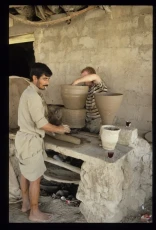
Pottery manufacturing in the Khabur region, probably in al-Busayri

Raqqa, Qasr al-Banat, Capital with plant motifs
Neg. Nr. 83/5-36A/37

A view of the inner courtyard, al-Bimaristan an-Nuri

Jamiʿ al-ʿAdiliyya, prayer hall's entrance - muqarnas details

Exterior view of the dome of Salah ad-Din al-Ayyubi Mausoleum, Damascus
[Ooriginal: Damaskus. Hinter d. Omajadenmoschee]

In the sleeping compartment of the tent of a semi-nomadic family from Maskana-region

General view of the Tetrapylon
[Original: Große Orientreise Nr.63 mit Rotel-Tours: Amman-Bagdad-Uruk-Babylon-Arbil-Mosul-Hatra-Samara-Mari-Dura Europos-Aleppo-Dayr Saman-Ugarit-Palmyra-Jarash]

Main entrance of the south facade of the church, Qarqbiza
[Original: "einschiffige Kirche, Haupttür der Südfassade (Villa des 3. Jhs. kurz vor 313 in Hauskirche umgewandelt - frühester datierbarer Sakralbau Syriens)"]

Remains of Harim Castle

Remains of the Praetorium from east, Balis (Barbalassos)

Barada River, near Victoria Bridge
shap_import_51655

A view of Qalʿat Shayzar along the Orontes river
View at Qalʿat Shayzar

Palmyra, Baal Temple - Temenos wall with propylaeum and view towards the oasis

Raqqa - "East of Raqqa" site - Western Palace - Pottery
Raqqa VIII; Eastern West Palace, SW-Neg.89/658-699

Damascus, Glass Blowing Workshop near Bab Sharqi
[Original: LEAD Technologies Inc. V1.01]


Remains of mills at the waterfalls of Tall Shihab

Raqqa, enclosure wall and arcade of al-Jamiʿ al-ʿAtiq (Great Mosque)

Jurn Kabir, in the center of a traditional double-room house (areas for living, sleeping, supplies, kitchen)

Khan Qurdbak, portico, facade of the northern portal and east-west cross-section
Size of plan 34 x 32. with ruler (no scale).

Nahiyat Tall Tamir, Woman builds a silo for her supplies during the winter
The Assyrian villages on the Khabur with their domed houses were built by the French Mandate Government for Christian refugees from Turkey and Iraq.

Al-Madrasa al-Ahmadiyya, portico along the prayer hall

Raqqa, Qasr al-Banat, Column capitel with plant motifs

Maʿlula, traditional hillside houses with galleries opening to the valley during the 1960s

Telegraph column, topped with a miniature of a mosque, Sahat (square) al-Marja

Altar of Nabu Temple from the northeast corner, Palmyra
[ Description by author: Gebälk-Dekor von der ~ Nordost-Ecke. ]

One of the Basilica aisles, is separated from the central courtyard by a row of arches based on columns, Basilica A, ar-Rusafa
[Original: 1945 Geschenk Prof. Friedrich Sarre]

Busra, View into the Cathedral, 6th C.
[Original: Kathedrale (den Märtyrern Sergios und Bacchios und dem Leontios geweiht), 512/13]

Domes of as-Salamiyya historical bath from the outside
A picture from the outside of a group of domes and vaults belonging to the historical bath in as-Salamiyya. They contain small openings that are arranged within a pattern. In addition to their aesthetics, their main function is to lighten the various interior bathroom sections.

Suq Aslan Dada, rebuilding of northern entrance, view towards south

Qasr al-ʿAzm, view of the ground floor courtyard

Husn Sulayman, Temple of Zeus Baetocaece, inner face of the east gate of the temenos

Aghabani with customized geometric design combining leaves, flowers and branches

A side of the walls of Qalʿat Salah ad-Din

Takiyyat ash-Shaykh Abu Bakr, interior view: courtyard and rooms from outside
Bahra mit Moscheefront 1917?

Roman tower tomb in Sarrin

ash-Shaykh Khalid an-Naqishbandi mausoleum on the foot Qasyon mountain
Turbat ash-Shaykh Khalid an-Naqishbandi written on the photos back ['F 80. Wulzinger-Nachlaß WU F80']
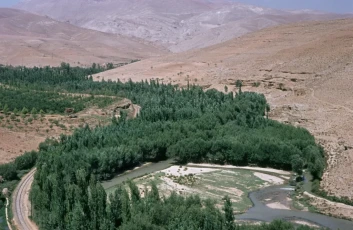
A view of the Barada valley showing the train rail

Relief showing an angel among fruits and pine cones, Temple of Baal
[ Description by author: Relief. In der Mitte ein geflügelter Genius, der mich irgendwie an die assyrischen erinnert. Links von ihm u.a. Pinienzapfen, ein Symbol der Fruchtbarkeit Die Früchte (?) rechts scheinen mir Granatäpfel zu sein, dagegen sprechen aber die Einkerbungen. Die Anordnung gemahnt irgendwie an die "Brüste" der Artemis von Ephesus ....... ]

A Bedouin woman is weaving with a horizontal loom

Olive groves near Harim

Jabal al-ʿArab, Camel

Colossal basalt lion found in 1955 in ʿAyn Dara

Jamiʿ al-ʿAdiliyya, prayer hall's entrance - muqarnas and inscription documenting the date of building accomplishment

Maronite Cathedral, general view from the outside

Archaeological finds from Raqqa, exhibited in the Damascus National Museum
Palace D, ar-Raqqa; Relief Decorated Stone; now in National Museum Damascus

Khan Qurdbak, southern portico

The monastery of Mar Taqla

A view of the inner courtyard showing the Seljuk dome with muqarnas, al-Bimaristan an-Nuri

Al-Bara, oil mill, 5th-6th c.

The northern entrance of the historical city of Dura Europos (Qalʿat as-Salihiyya), end of 4th century BC

Zabadani Plains with trees and agriculture

View to Jabal ʿAruda on the right bank of the Euphrates

Bayt Wakil (Aleppo-Zimmer), Painted wooden panel, Mary and Jesus
One of the most famous Christian themes in the hall of Wakil house is a painting of the Virgin Mary carrying her child, surrounded by plant and blossom drawings.

Jamiʿ Sharaf, Qastal facade

Jurn Kabir, a travelling horse-drawn cart dealer supplied the villages with vegetables and fruit

Raqqa countryside, Men in a traditional tent in Suwaydiyya Kabira village

Mushabbak, byzantine basilica
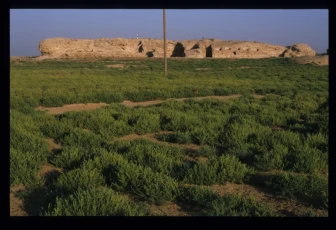
General view of Hiraqla victory monument, near Raqqa

Al-Imam Ismaʿil Mosque, muqarnas on the dome from the inside
Zwickel an der Kuppel. Irgendwo habe ich gelesen, dass diese kleinen Nischen die erste Stufe der Entwicklung der Muqarnas darstellen und dass darin die künstlerische Bedeutung der Moschee bestehe.- S. Beschreibung Bild 1052 gegen Ende ! [Original: 'Salamiya (Salamias)']

Qasr al-Hayr al-Sharqi, Part of the western enclosure

Al Madrasa al-Kamiliyya, courtyard and prayer hall facade

Jamiʿ al-ʿAdiliyya, column details in the double arcade

The Straight Street with Roman Arch and Minaret Al-'Umari

Big stairs lead to the upper floor, Royal Palace G, Ebla (Tall Mardikh)
Die große Rampe im Nordwestteil des Palastes (nach rechts geht es zur großen Treppe). Auf einem Internet-Bild wird sie als (Rampe einer) "Ziggurat" bezeichnet, dann stünden wohl der Rote Tempel / Ishtar-Tempel D auf dieser Ziggurat. Arber: wie passt das mit dem Palast zusammen ? Oder stammt diese Ziggurat aus der zweiten Blütezeit von Ebla und hat den Palast (teilweise) überlagert ? [Original:Tall Mardîkh (Ebla)']

Khan Qurdbak, main entrance

Busra, Hammam Manjak, exterior view

ar-Rusafa, Capital on the interior façade of the North Gate,

View from southwest, Agora
[ Description by author: Blick von ~ Südwesten diagonal über den Platz mit Resten der Portiken. Ganz rechts ein Durchgang zum Annex., vgl. Bild 0711 ! ]

Hiraqla victory monument: glass jar

Citadel of Aleppo, Great Mosque - dome of the prayer hall

Fresco from Dura Europos, 3rd c. National Museum, Damascus

Qalb Lawza, Basilica of 5th c., decorative door of reliquary room in southern facade (east)
The relics of Symeon were located in the southern apse side room. This martyrion can be recognized from the outside by the third door in the south wall and by a tiny window next to the door through which the pilgrims could be supplied with holy oil. A direct door into the sanctuary suggests that the Symeon relic was also used during the service. The windows are bordered by a particularly elaborately designed cornice band. The façade also has oblique grooves and square depressions, probably from the base of a sloping roof and its purlins.

A woman showing how to card wool. She is wearing a silk Habari (head scarf)

View from the Hotel Burj al-Fardous towards Old Damascus showing the Citadel
[ Description by author: Blick vom Hotel Burj al-Farâdîs nach ~ Osten: Al-Qal'a. ]

Damascus citadel, the prison courtyard in the north-east part

An abandoned building in Circassian district, Raqqa
[Original: Tscherkessenviertel]

Fresco on the apse, Roman Orthodox St. Elian Church, Homs
[ Description by author: Fresken der Kalotte. Sie sollen aus dem 12. Jh. stammen. In der Mitte ein thronender Christus, flankiert links von Maria und Maria Magdalena, rechts von Johannes dem Täufer und dem Evangelisten Johannes . Darunter rechts und links in den Medaillons die vier Evangelisten. ]

The main palace of the Caliph Harun ar-Rashid, ar-Raqqa
[Original: Palastareal]

Al-Madrasa az-Zahiriyya, courtyard - lobed angle fountain
shap_import_66077

Busra Citadel - The ditch of the citadel and the bridge leading to the entrance

Ugarit, Entrance gate to the city

Jamiʿ al-Khayr, upper part of the main entrance - foundation inscription

Jamiʿ al-Utrush, western entrance
The gate is inside a decorated niche.

Qalb Lawza Basilica, illustration of the assumed construction method
Drawing of a perspective section of the basilica showing an idea of its former construction.
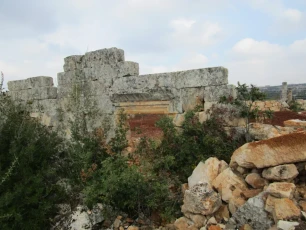
al-Husn Church, remains of basilica's façade, which, after its demolition, was transformed into an agricultural field

© SMB, Museum for Islamic Art, image: G. Niedermeiser

Left volute of the lintel, Damascus Gate, Palmyra
[ Description by author: Die linke Volute des Türsturzes, gesehen von ~ Südwesten. ]

View from the northeast, Temple of Bel
[ Description by author: Tele-Ausschnitt aus Bild 0586.. ['Hotel Villa Palmyra (Heliopolis ?)'] ]

Suq az-Zarb, new beginning after the destruction. View from the entrance to the west

Burj al-Ghanam, general view of the tower's west-south corner
shap_import_63417

Detail of decorations, Agora
[ Description by author: Ausschnitt aus dem Mäander-Dekor. ]

In the Orontes valley below the village of Qalʿat al-Mudiq is situated a 16th c Khan, which has become a Museum

Eastern entrance of Suq al-Hamidiyya, Old Damascus

Temple of Bel behind palm trees

A photo of Masyaf Castle overlooking the city

A view of an-Nuri Mosque and the Kilaniyya Norias (water wheels), Hama
A view from al-Kilaniyya Bridge towards an-Nuri Mosque and a group of three norias from the Kilaniyyat group (Kilaniyya, Tawafira and Jaʿbariyya).

Punch cards for jacquard looms with woven sample for silk fabric in the Mezannar textile factory in Damascus

Monastry St. Sergius on the edge of the mountain plain overlooking Maʿlula

Raqqa, main shopping road with salesman of vegetables

Hammam Bahram Basha, the cold section (barrani)

Bayt Ghazala, courtyard and northern facade

Livestock in a byzantine building, Qarqbiza

Palmyra, Sarcophagus, Camp of Diocletian
[ Description by author: in der Nähe des Fahnenheiligtums. [' 26/03/2002 (?)'] ]

Raqqa - Remains of the southern arcade of al-Jamiʿ al-ʿAtiq (Great Mosque)

Bimaristan Arghun, octagonal courtyard, doors to cells

Al-Madrasa al-Muqaddamiyya, entrance to the prayer hall

Busra - Madrasat Abu al-Fidaʾ, inscription

View to the village al-Awshariyya on the northern shore of the Sajur near the junction with the Euphrates river

Village of ʿAyn al-Khadra, in the living room of the central hall house of a Kurdish family

Bimaristan Arghun, passageway

Vaulted entrance, Qalʿat Harim from the interior
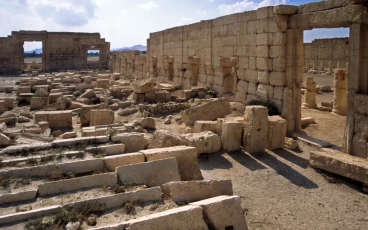
View from northeast, Agora and commercial center
[ Description by author: der Agora, Blick von ~ Nordosten. Durch das Tor ganz rechts (es ist das selbe wie Bild 0704 links) sieht man in die Agora. Dieser Annex ist der eigentliche Handelsplatz von Palmyra und war wegen der Kamele auch nicht gepflastert. Hier wurde auch der berühmte (Zoll)Tarif vom April 137 n. Chr. gefunden. S. auch Bild 0707 ! ]

Waqf of Ibshir Mustafa Pasha, Coffeehouse, exterior facade
The street facade of the coffeehouse is unique for this kind of building regarding its openness, size and large-surface decoration.

Archaeological finds from Raqqa, exhibited in the Damascus National Museum
Glazed pottery vessel; Palace B, ar-Raqqa; now in National Museum Damascus; Mus.Nr.16476

Khan al-Jumruk, general view

Citadel of Aleppo, Entrance Gateway

Hammam Bahram Basha, plant motifs above the main entrance

General view of Jaʿbar castle
Note: these photos were taken between the year 1924 - 1939. The chosen date is to be average. (photographer unkown)

The inner harbor, Jabla

Village houses with courtyards in Mishrifa (ancient Qatna)

The donjon and the corner tower of Yahmur Castle

One of the entrances to Harim Castle

A villa under construction in the Ghuta of Damascus
A view of one of the groves of the Ghouta with a villa or a summer house under construction in the middle. In the last years of the last century, rich people, both residents of the city and the villages, began to build modern residential buildings in the groves of the Ghouta, for recreation and to enjoy the beauty of nature and the freshness of the air.

Jamiʿ at-Tawashi, prayer hall - minbar (pulpit)

Remains of the western entrance to the Temple of Jupiter, behind it the minaret of Qaytbay

View to the east.

A view in Wadi Barada
[Original:' Jarmuktal'].. The Bavarian air force division 304b was based in Palestine from 25. October 1917 and was involved in the First World War until the division left the region, over Aleppo, in mid September 1918. During that period, over 3000 glas photographs, mostly aerial, have been made. Those early photographs were important for the archaeological research in the Middle East region.

Al-Madrasa al-Hallawiyya, dome of the prayer hall

Monastery of St. Simeon Stylites, late 5th-early 6th c., Exterior of sanctuary of east basilica (apse from exterior)
[Original: Apsiden der Ostbasilika von außen]

Harim Castle, view into an entrance


Bouquet of flowers and fruits in bowls on the wooden panels of Bayt ad-Dahhan (Funduq Qasr al-Mansuriyya), 18th century


Palmyra, a photo of some tower tombs

Qalʿat (castle) al-Qadmus, Insciption

Raqqa - "East of Raqqa" site - Western Palace - vegetable stucco ornaments

Statue of a benefactor on a column along the Great Colonnade
[ Description by author: und Würdenträgers. Wie Bild 0658, aber frontal. ]

The peak of Mount Hermon (Jabal Haramun)

A stand selling sandwiches in Damascus

Izraʿ - Kanisat (church) Mar Jirjis from the inside

ʿAbd al-Qadir al-Jazaʿiri cenotaph, beside the Mausoleum of Shaykh Muhyi ad-Din Ibn ʿArabi
[ Description by author: Der Kenotaph für 'Abd al-Qâdir al-Jazâ'iri. ]

General view of the village of Shaykh Hilal
This part of the village is surrounded by domed houses, while flat-roofed houses are very few.

Izraʿ, al-Jamiʿ (Mosque) al-ʿUmari - the courtyard

View to the Qalamun Mountains from Halbun

The façade of al-Hayr al-Gharbi Palace, National Museum of Damascus

Az-Zawiya al-Hilaliyya, the upper part of the wooden prayer niche

Jamiʿ al-Mihmandar, interior of the prayer hall

Bayt Junblat, western facade of the women hall (Haramlik)

Jamiʿ al-Maydani, the minaret

al-Husn Church, remains of basilica's wall, which constitue the boundary of an agricultural field

Corinthian capital of a pillar, Agora
[ Description by author: Kapitell des Pfeilers mit vorgelegter Halbsäule von Bild 0711. ]

Mnin, general view of Qalamun mountain and the houses scattered on its slopes

Model of the original setting of the reception room of Beit Wakil (Aleppo Room in the Museum for Islamic Art, State Museums Berlin)

Mausoleum of az-Zahir Baybars, decorations with colorful marble

General view of Masyaf city

The Great Colonnade behind the palm trees
[ Description by author: Zum Standort s. Bild 0588 ! Zentralabschnitt: links, verdeckt, der Monumental-Bogen, rechts der Tetrapylon. Dahinter in der Mitte zwei Grabtürme, ganz hinten, an der Efqa-Quelle, das Hotel Palmyra Cham Palace. ['[Tetrapylon Hotel],'] ]

A model of Bel Temple
[ Description by author: Modell, gesehen von ~ Nordwesten. Zu sehen der Tempel in seinem Hof und die Peribolos-Mauer mit den Propyläen. Der Tempel wurde um 30 n. Chr. geweiht, die Propyläen im 12. Jh. in eine arabische Bastion umgewandelt (Bauinschrift s. Bild 0599 !). Im linken Teil sieht man den Eingang zum Tunnel der Rampe unter den Peribolos (s. Bild 0606 !): hier wurden die Opfertiere in einer Prozession zum Altar im Hof geführt. Zu erkennen ist auch, dass der Tempel quer orientiert ist - interessanterweise wie die islamische Moschee ! ]

A Waterspout of the ablution fountain in the courtyard of al-Adilliyya Mosque

Mausoleum az-Zahir Baybars, mosaics covering the southern wall

Al-Madrasa al-Ahmadiyya, general view of the entrance

Khan al-Wazir, interior facade of the khan's entrance

Bab Antakiya, main gate

Grazing sheep on the Euphrates
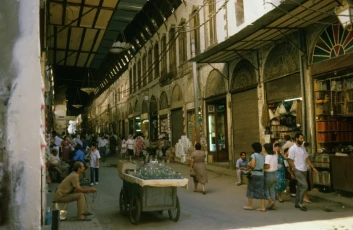
In Suq al-Buzuriyya with its many small spices and remedy shops

Aleppo, Bab al-Maqam city gate, general view from south, ca. 1932 during French mandate
Note: these photos were taken between the year 1924 - 1939. The chosen date is to be average. (photographer unkown)

Jamiʿ at-Tawashi, eastern facade - window within a rectangular niche decorated with muqarnas
[Original:'Jâmi' at-Tawâshi, Halab / Aleppo. Erbaut 1348. Hier ein Fenster - wie es scheint, auf Straßenniveau. Vgl. Bild 1285, 1286 ! - Zum GPS-Tag: allgemein auf das Gebäude gesetzt, da ich nicht angeben kann, auf welcher Seite der Standort war.'].

Jamiʿ al-ʿAdiliyya, capital with muqarnas of a column in the double arcade

Archs: Remains of al-Ashnan watermill on the foot of Qasyun mountain
shap_import_77200

Fresco paintings on the ceiling of tomb tower of Elahbel

Weekly market in Maskana, where the farmers of the region sell their fruit and vegetables

General View of al-Bahramiyya Mosque

Safita, General view of the city showing the Donjon of the Templars

Jamiʿ al-Khayr, arcade along the prayer hall

Raqqa - the excavations of the site "East of Raqqa" - Eastern Palace
The so-called Eastern Palace is part of the Palace City of Caliph Harun al-Rashid. After the excavations it was preserved and made publicly accessible.

Jamiʿ al-ʿAdiliyya, entrance of the prayer hall

Raqqa, Tall az-Zujaj, Block of a semi-vitrified material
Raqqa X; Glass-Tall

Fruit and vegetable growing in the Ghuta of Damascus

Pavilion, Qasr al-Hayr al-Sharqi

Jamiʿ al-ʿAdiliyya, corbel with muqarnas supporting an arch in the inner portico

Citadel of Aleppo, general view of the Gate Tower

Arch bridge over the Orontes River, which leads to the Shayzar Castle

Traditional houses, Ma'lula

Khan al-Wazir, interior facade of the khan's entrance
The Bavarian air force division 304b was based in Palestine from 25. October 1917 and was involved in the First World War until the division left the region, over Aleppo, in mid September 1918. During that period, over 3000 glas photographs, mostly aerial, have been made. Those early photographs were important for the archaeological research in the Middle East region.

Agriculture on a mountain slope in Jabal al-ʿArab

Madrasat al-Firdaws, view to south - courtyard and arcades

Church of Saint Simeon Stylites is composed of four churches forming a cross

Yabrud, irrigated market gardening near the caves of Wadi Iskafta

Bas-relief on an arch in the church of Qalb Lawza

Suq ad-Dahsha, general view of the suq

Khan Qurdbak, southern part of the Khan - iwan of the Mamluk Palace

A favissa or ritual pits east of Ishtar temple, Tall Mardikh (Ebla)
shap_import_48474

Great Mosque, Plan of the building parts
The Great Mosque of Aleppo has moderate damage, except for the complete destruction of the minaret in April 2013. The degree of damage is around 30%. The western wing shows two large circular holes in the roof. There are currently no photographs available which clarify the extent of the interior damage. Several fires have affected parts of the main prayer hall causing damage especially to the southern gate and the wooden doors of the northern facade. The northern arcade was burned and its main gate partially damaged. The eastern part of the courtyard floor is torn out.

Al-Madrasa al-Muqaddamiyya, the entrance
shap_import_65981
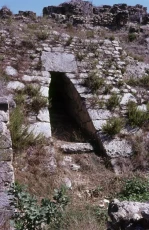
Entrance gate to the city of Ugarit

al-Burayj, General view of the Monastery of Saint Daniel, 6th c. AD

Bayt Wakil, top view of the ʿataba of the reception hall (qaʿa)

Raqqa - "East of Raqqa" site - Western Palace
Raqqa VIII; Eastern West Palace, s.SW-Neg.89/638-643

as-Suwayda', "Mashnaqa Arch" or remains of a Byzantine basilica
Note: these photos were taken between the year 1924 - 1939. The chosen date is to be average. (photographer unkown)

General view of Ithriya Temple
Gesehen von ~ Osten (sofern ich das Satellitenfoto richtig gedeutet habe !).- Zur genaueren Information s. das PDF Nr 1087 ! Die Verzierung links und rechts des Tores erinnert an Nîha im Libanon. Der Tempel soll ein Prostylos gewesen sein und aus dem 3. Jh. stammen. [Original:'Ithriya (Seriana),']

Bel Temple, column with Ionic captial on the south facade of the cella
[ Description by author: Tele-Aussschnitt aus Bild 0614: das jonische Kapitell der linken Halbsäule der Cella-Südwand. ]

Bimaristan Arghun, view of main courtyard

Habuba Kabira, construction of cantilever domes

Raqqa, "East of Raqqa" site - Western Palace, vegetable stucco ornaments

Al-Madrasa al-Ahmadiyya, prayer niche

Tall Shaykh Hamad (Dur Katlimmu) - Excavations
[Original:'TALL SAIH HAMAD']

The Great Colonnade in Palmyra, View to the south east

Stage of the Roman Theater and the adjacent wall of the Islamic Citadel, Busra

Part of the propylaea, Jupiter Temple
[ Description by author: am Tympanon des Westportals des Períbolos. Vgl. Bild 0150 und 0151 ! ]

Qalʿat ash-Shugr wa-Bakas, the connection bridge between the two castles

Courtyard and Iwan, Qasr As‘ad Basha al-'Azm
Liwan und Bahra

One of the towers of Qalʿat (castle) Shayzar

Tomb of Elahbel in the Valley of the Tombs, facade
[ Description by author: Oberer Teil der Fassade. Im Bogen eine Kline für den Toten, dessen Hochrelief allerdings fehlt. Unten in einer Tabula ansata eine zweisprachige Inschrift. Gesehen von ~ Süden. ]

Jamiʿ al-Utrush, northern entrance

Suq Istanbul al-Jadid, view to north of the destroyed market

Al-Madrasa as-Sultaniyya, northern window of al-Malik az-Zahir Ghazi tomb
The window topped by an inscription panel

Jamrin - The ancient bridge over Wadi az-Zaydi

Porticus post scaenam, Roman Theater- Busra
[Original: Theater, Bühnengebäude (wahrsch. spätes 2. Jh.)]

An olive grove in the Ghouta of Damascus

Qalb Lawza, Basilica of 5th c., West and south facades from southwest

Archaeological finds from Raqqa, exhibited in the Damascus National Museum
Pottery vessel from ar-Raqqa; National Museum Damascus; Mus.Nr.16067; R.6

A robust 4 cm thick felt carpet made of wool in the manufacturing facility in Al-Bab
Photographs of a manufacturing facility for felt carpets in Al Bab as part of the "Aleppo Stadtarchivprojekt" of GIZ (German Corporation for International Cooperation) in 2008

General view of the Umayyad Mosque shows the dome and the three minarets of the mosque
[ Description by author: Blick vom Hotel Burj al-Farâdîs nach ~ Osten auf die Umayaden-Moschee. Links (~ Nordseite) das Brautminarett, vorn rechts das Minarett von Qait Bay, hinter der Kuppel das Jesus-Minarett. ]

Building the walls of the example dome house in Taanayel (Libanon)
The picture shows the ready mud bricks and the first stage of building the walls of the traditional Syrian dome house in Taanayel

Bayt Ghazala, courtyard and western facade - main hall's (qaʿa) facade
[Original: B86 /Film XV]

Qalb Lawza, Basilica of 5th c., central view at nave and apse


Wakil house, dome of the reception hall from the inside
The room drew light through a series of windows surrounding the dome's neck, as well as from the colored openings in the dome, which are shaped like circles and stars.

Detail drawing of the relocated portal in al-Matbakh al-ʿAjami
Reusing a portal for the new facade of al-Matbakh al-ʿAjami after demolishing a part during enlargement of the street: detail plan drawings of the relocated portal from a demolished palace/ mansion, registered under 157A, 22A in Syrian monuments list, and originally located in cad. no. VII-1-1 3777. Scale 1:20.

Wakil house, dome of the reception hall
A view of the hall’s dome from the outside, where the rectangular windows appear clearly on the neck of the dome.

Appliqué for the decoration of textiles
Drawings by Estibaliz Sienra Iracheta to illustrate processes of traditional textile manufacturing

Conservation of the Grape Room made in 1835, house Nizam, Damascus

Jamiʿ (mosque) al-Hanabila, courtyard and ablution fountain

The Great Colonnade
[ Description by author: 3. Abschnitt mit dem Tempelgrab als Abschluss. Rechts die Burg des Fakhru d-Dîn al-Ma'ni. Gesehen von ~ Südosten. ]

Al-Madrasa as-Sultaniyya, facade and entrance of the prayer hall

The upper part of the minaret of an-Nuri Mosque

A modern three storeys building in Raqqa

View of towards the city and the monastery of Saydnaya

Palm trees in Palmyra oasis
[Original: Palmen in Palmyra]

Agriculture in the Syrian Jazira

Shahba, Exterior view of the Roman Theatre/ Philippopolis

Az-Zahir Baybars Mausoleum in al-Madrasa az-Zahiriyya
[ Description by author: mit dem Grab des mamlukischen Sultans Baibars, gestorben 1277. Er war ein bedeutender Feldherr und hat den Kreuzrittern den Kraq des Chevaliers (Qal'at al-Husn) entrissen und die Mongolen 1260 besiegt. Rechts die ~ Nordwand mit dem Eingang, links die Westwand. (The date of this photo was not sure as Peter Heiske did [(wohl) 18/10/1998] ]

Great Mosque, prayer hall, wooden pulpit (minbar)
The unique wooden minbar, or pulpit, belongs to the Mamluk era as indicated by the inscribed name of the Sultan al-Nasir Muhammad, son of Qalawun (d. 741 AH / 1341 AD). The carpenter’s name is Muhammad ibn ʿAli al-Mawsili.

Jamiʿ al-Khayr, entrance of prayer hall - arch support

The Great Colonnade towards the Monumental Arch
View to the south east

Preparation of spools in the textile factory of the Mezannar family

A cart dragged by a young horse to transport goods in ar-Raqqa

A distant view of the coastal mountains (al-Jibal as-Sahiliyya)

Jamiʿ al-Mihmandar, prayer hall - minbar (pulpit)

A partially demolished historic building in the historic Midan district

Basalt orthostats on the western side of ʿAyn Dara Temple

A side from the castle showing an entrance, Qalʿat Najm

Courtyard of Khan Murad Basha (Museum of Maʿarrat an-Nuʿman)
[Original: Khan Murad Pascha, osman. (heute Mosaiken-Museum)]

Introducing the blue dye in boiling water to the silk threads. This process is repeated several times until the silk absorbs the blue dye effectively

ar-Rusafa, Basilica C, View towards the apse
[Original: k.K6/=HQ k.K5]

Shaykh Anas shrine - al-Tar mountain south-east of al-Mayadeen - the dome from the inside

Bayt Dallal, courtyard view from the iwan

Jamiʿ as-Saffahiyya, exterior windows

Madrasa al-Hallawiyya: interior view at the former Byzantine apse
Parts of the Byzantine cathedral (5th c.) were integrated into a religious college (Medrese) in the 12th century. During the war, the monument was damaged and plundered.

Madrasat al-Firdaws, courtyard and western arcade

Bimaristan an-Nuri, view of the small Iwan

Busra, Hammam Manjak, the hot section (juwwani)

View of the courtyard, Umayyad Mosque
[ Description by author: Blick aus der Nordost-Ecke nach Südwesten. Vorn links der Uhren-Pavillon, dahinter die Fassade des Transepts und seine Kuppel, rechts daneben das Minarett von Qait Bay. Weiter rechts im Hof der Bau mit dem Becken für die Waschungen, ganz rechts das Schatzhaus. ]

Mushabbak, Byzantine basilica, general view from northeast
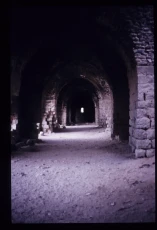
Khan Dannun, arcade

Suq Aslan Dada, general view after completion of the reconstruction, view towards south

Tall Dahab, Central hall house - the width of the hall corresponds to the recess in the facade, the loggia is used for the stay

Madrasat al-Firdaws, inner iwan and courtyard with lobed octagonal basin

Bayt Junblat, the large courtyard and iwan
A view of the large courtyard of Junblat house, and in the center there is a large water basin built from the outside in the style of Ablq, in which stone rows alternates between yellow and black color. The iwan in the picture is one of the highest in traditional Aleppo houses. The iwan is covered with blue and white glazed ceramic tiles.

A Bedouin woman is weaving with a horizontal loom